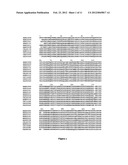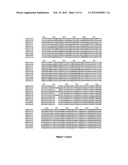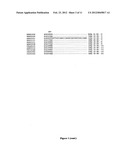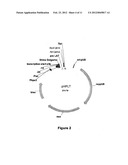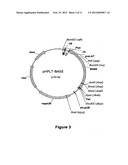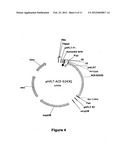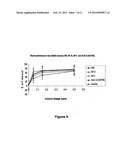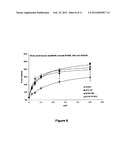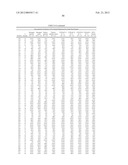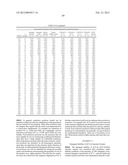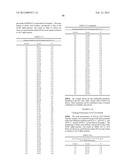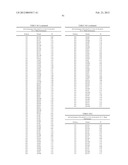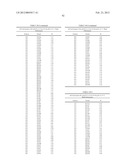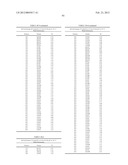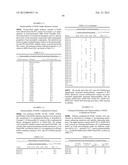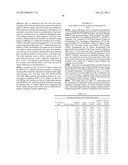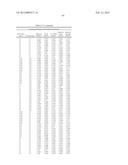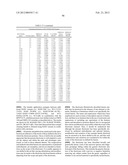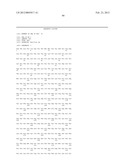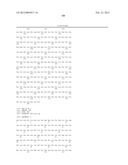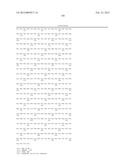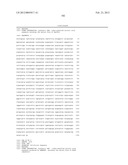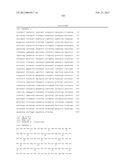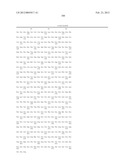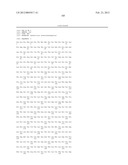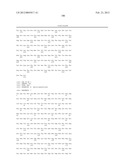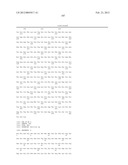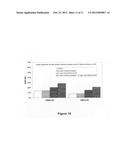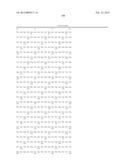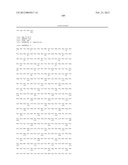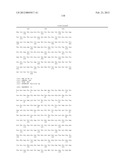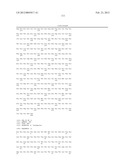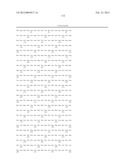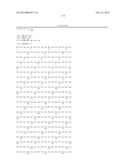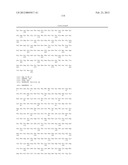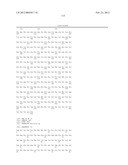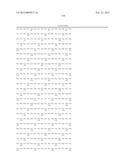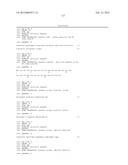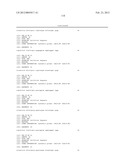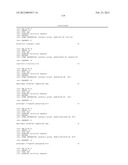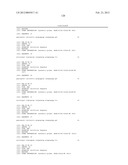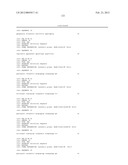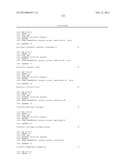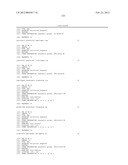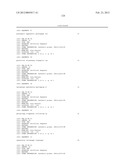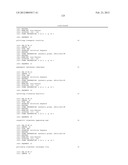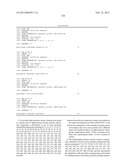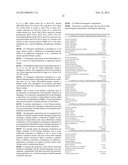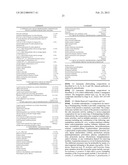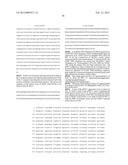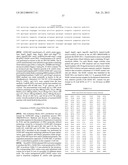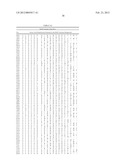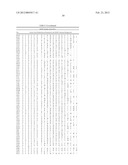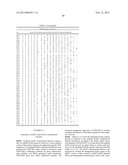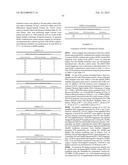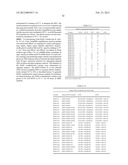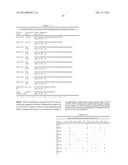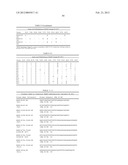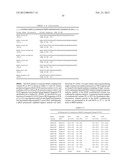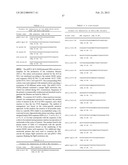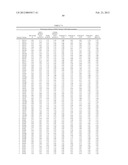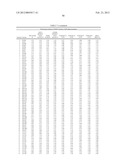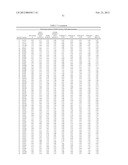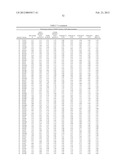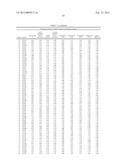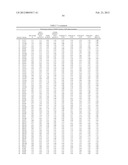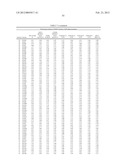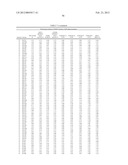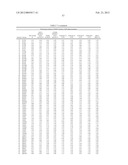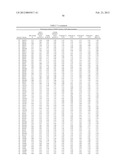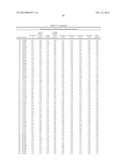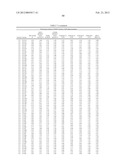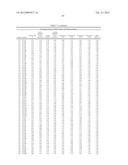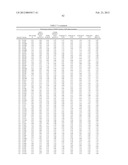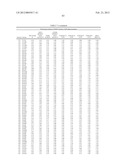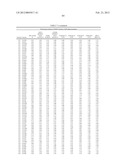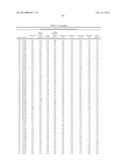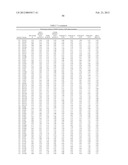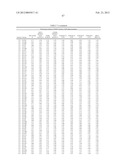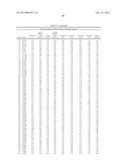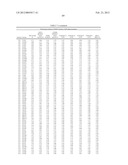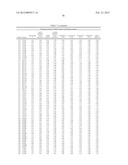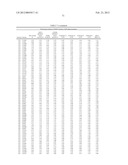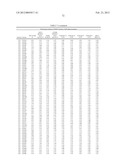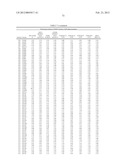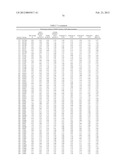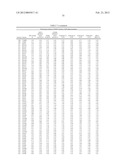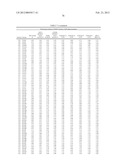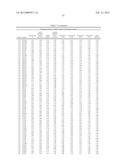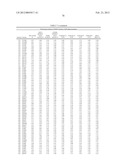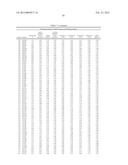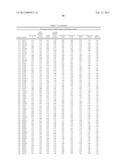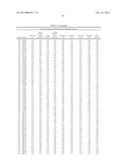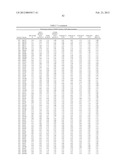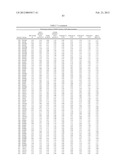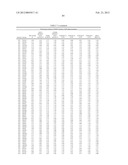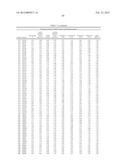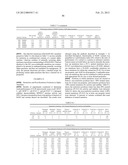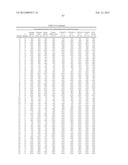Patent application title: Compositions And Methods Comprising Alpha-Amylase Variants With Altered Properties
Inventors:
David A. Estell (San Francisco, CA, US)
Brian E. Jones (Leidschendam, NL)
Brian E. Jones (Leidschendam, NL)
Marc Kolkman (Oegstgeest, NL)
Marc Kolkman (Oegstgeest, NL)
Christian D. Adams (San Francisco, CA, US)
Edward M. Concar (San Francisco, CA, US)
Edward M. Concar (San Francisco, CA, US)
IPC8 Class: AC12N908FI
USPC Class:
435192
Class name: Enzyme (e.g., ligases (6. ), etc.), proenzyme; compositions thereof; process for preparing, activating, inhibiting, separating, or purifying enzymes oxidoreductase (1. ) (e.g., luciferase) acting on hydrogen peroxide as acceptor (1.11)
Publication date: 2012-02-23
Patent application number: 20120045817
Abstract:
Described are compositions and methods relating to variant alpha-amylases
having altered biochemical properties and advantageous performance
characteristics as compared to a reference alpha-amylase. The variants
are suitable for use in various industrial applications such as starch
conversion, ethanol production, laundry, dishwashing, pulp and paper
production, textile desizing, and/or sweetener production.Claims:
1. An isolated alpha-amylase variant, wherein said variant is a mature
form of alpha-amylase having amylase activity, and comprising a
substitution at one or more positions selected from the group consisting
of 1, 2, 3, 4, 5, 7, 15, 16, 17, 18, 19, 22, 25, 26, 28, 29, 30, 32, 35,
36, 37, 50, 51, 52, 53, 54, 55, 56, 59, 60, 70, 71, 72, 73, 75, 78, 83,
87, 90, 91, 93, 94, 95, 104, 105, 107, 108, 110, 112, 113, 116, 118, 125,
126, 128, 129, 130, 131, 134, 136, 138, 142, 144, 147, 149, 150, 152,
154, 156, 158, 160, 161, 162, 165, 166, 168, 169, 170, 172, 174, 177,
178, 182, 183, 185, 189, 192, 195, 197, 201, 202, 203, 207, 210, 214,
217, 221, 228, 234, 236, 237, 246, 250, 254, 255, 257, 264, 267, 269,
270, 272, 275, 279, 283, 284, 298, 301, 303, 305, 306, 310, 311, 314,
318, 319, 320, 322, 323, 336, 337, 338, 339, 340, 344, 359, 374, 375,
376, 377, 379, 381, 382, 393, 394, 399, 401, 407, 408, 419, 433, 436,
438, 444, 447, 448, 451, 453, 459, 465, 470, 475, 476, 483, and 484;
wherein the positions correspond to amino acid residues in the amino acid
sequence set forth in SEQ ID NO: 2; and wherein the substitution of the
naturally-occurring amino acid residue at the one or more positions for a
different amino acid residue produces an alpha-amylase variant having a
performance index >1.0 for a measure of stability, and a performance
index >1.0 for a measure of activity.
2. The isolated alpha-amylase variant of claim 1, comprising a substitution at one or more positions selected from the group consisting of 7, 29, 35, 53, 60, 72, 87, 108, 116, 126, 128, 129, 130, 131, 134, 136, 138, 142, 156, 161, 165, 178, 182, 185, 189, 192, 195, 197, 202, 210, 214, 217, 221, 234, 246, 269, 303, 310, 337, 340, 374, 401, and 438, and wherein the substitution of the naturally-occurring amino acid residue for a different amino acid residue, produces an alpha-amylase variant having a performance index >1.5 for a measure of activity and a performance index >1.0 for a measure of stability.
3. The isolated alpha-amylase variant of claim 1, comprising a substitution at one or more positions selected from the group consisting of 2, 7, 22, 25, 28, 30, 37, 70, 75, 83, 87, 91, 93, 108, 128, 160, 165, 178, 182, 183, 217, 269, 270, 279, 283, 298, 305, 306, 310, 320, 374, 375, 376, 407, 419, 475, and 476, wherein the substitution of the naturally-occurring amino acid residue for a different amino acid residue, produces an alpha-amylase variant having a performance index >1.5 for a measure of stability and a performance index >1.0 for a measure of activity.
4. The isolated alpha-amylase variant of claim 1, comprising a substitution at one or more positions selected from the group consisting of 83, 125, 128, 131, 160, 178, 182, 183, 185, 189, 279, 305, 319, 320, 379, 407, 433, 453, 475, 476, and 483.
5. An isolated alpha-amylase variant, comprising a substitution at one or more positions selected from the group consisting of 83, 125, 128, 131, 160, 178, 182, 183, 185, 189, 279, 305, 319, 320, 379, 407, 433, 453, 475, 476, and 483, wherein the positions correspond to amino acid residues in the amino acid sequence set forth in SEQ ID NO: 2, and wherein the substitution provides at least one beneficial effect selected from the group consisting of improved cleaning performance, improved detergent stability, improved thermostability, and improved protein expression.
6. An isolated alpha-amylase variant, wherein said variant is a mature form of alpha-amylase having amylase activity and comprising a substitution at one or more positions selected from the group consisting of 5, 32, 83, 95, 154, 214, 221, 228, 322, 401, 407, 419, 444, 447, 459, 470, 483, and 484; wherein the positions correspond to amino acid residues in the amino acid sequence set forth in SEQ ID NO: 2; and wherein the substitution of the naturally-occurring amino acid residue for a different amino acid residue, produces an alpha-amylase variant having a performance index value of 0.5 or better for activity at pH 8, activity at pH 10, activity at 16.degree. C., and activity at 32.degree. C., and a performance index value of 0.5 or better for stability in detergent and for thermostability.
7. The isolated alpha-amylase variant of claim 1, wherein the different amino acid residue is selected from the group consisting of A, C, D, E, F, G, H, I, K, L, M. N, P, Q, R, S, T, V, W, and Y, with the proviso that the different amino acid residue is different from the naturally-occurring amino acid residue.
8. The isolated alpha-amylase variant of claim 1, further comprising a substitution at position 243 corresponding to the amino acid sequence set forth in SEQ ID NO: 2.
9. The isolated alpha-amylase variant of claim 1, further comprising a deletion at position 180 and/or position 181, corresponding to the amino acid sequence set forth in SEQ ID NO: 2.
10. The alpha-amylase variant of claim 1, wherein the alpha-amylase variant is derived from a parent alpha-amylase having an amino acid sequence that is at least 75% identical to an amino acid sequence selected from the group consisting of SEQ ID NO: 2, SEQ ID NO: 5, SEQ ID NO: 6, SEQ ID NO: 7, SEQ ID NO: 8, SEQ ID NO: 9, SEQ ID NO: 10, SEQ ID NO: 11, SEQ ID NO: 12, SEQ ID NO: 13, and SEQ ID NO: 14.
11. The isolated alpha-amylase variant of claim 1, wherein the alpha-amylase variant has at least 75% sequence identity with the amino acid sequence set forth in SEQ ID NO: 2.
12. The isolated alpha-amylase variant of claim 1, wherein the alpha-amylase variant has at least 80% sequence identity with the amino acid sequence set forth in SEQ ID NO: 2.
13. The isolated alpha-amylase variant of claim 1, wherein the alpha-amylase variant has at least 90% sequence identity with the amino acid sequence set forth in SEQ ID NO: 2.
14. The alpha-amylase variant of claim 1, wherein the variant comprises a substitution at one or more positions selected from the group consisting of 128, 178, 182, 185, and 189 corresponding to the amino acid sequence set forth in SEQ ID: 2, wherein the substitution provides improved cleaning performance or improved detergent stability.
15. The alpha-amylase variant of claim 1, wherein the alpha-amylase variant comprises: (a) an alanine at position 125, a cysteine at position 128, an isoleucine at position 131, an isoleucine at position 165, a leucine at position 178, a glycine at position 182, a tyrosine at position 202, an arginine at position 305, a threonine at position 319, or an arginine at position 475; (b) the substitutions N128C+K178L+T182G+Y305R+G475K, and at least one additional substitution selected from the group consisting of S125A, T131I, T165I, F202Y, and D319T; or (c) the substitutions N128C+K178L+T182G+F202Y+Y305R+D319T+G475K, S125A+N128C+K178L+T182G+Y305R+G475K, or S125A+N128C+T131I+T165I+K178L+T182G+Y305R+G475K; wherein the variant optionally further comprises a substitution at position 243 and/or a deletion at position 180 and/or position 181; and wherein the positions correspond to the amino acid sequence set forth in SEQ ID NO: 2.
16. The alpha-amylase variant of claim 1, wherein said alpha-amylase variant comprises a substitution at position 475.
17. The alpha-amylase variant of claim 16, wherein said alpha-amylase variant comprises an arginine at position 475.
18. The alpha-amylase variant of claim 16 , further comprising a substitution at position 243 and/or a deletion at position 180 and/or position 181.
19. An isolated alpha-amylase variant, wherein said variant is a mature form having amylase activity and comprising a substitution at one or more positions selected from the group consisting of: 1, 2, 3, 4, 5, 7, 15, 16, 17, 18, 19, 22, 25, 26, 28, 29, 30, 32, 35, 36, 37, 50, 51, 52, 53, 54, 55, 56, 57, 59, 60, 70, 71, 72, 73, 75, 78, 82, 83, 87, 90, 91, 93, 94, 95, 103, 104, 105, 107, 108, 110, 112, 113, 114, 115, 116, 118, 121, 123, 125, 126, 127, 128, 129, 130, 131, 132, 134, 135, 136, 138, 140, 142, 144, 147, 149, 150, 152, 154, 156, 158, 159, 160, 161, 162, 164, 165, 166, 167, 168, 169, 170, 171, 172, 174, 175, 176, 177, 178, 179, 182, 183, 185, 186, 188, 189, 190, 191, 192, 193, 195, 197, 199, 200, 201, 202, 203, 207, 210, 214, 217, 221, 228, 234, 237, 238, 239, 240, 246, 250, 254, 255, 257, 264, 266, 267, 268, 269, 270, 272, 273, 275, 279, 283, 284, 298, 301, 303, 305, 306, 310, 311, 314, 318, 319, 320, 322, 323, 336, 337, 338, 339, 340, 344, 359, 374, 375, 376, 377, 379, 381, 382, 393, 394, 399, 401, 407, 408, 419, 433, 436, 438, 444, 447, 448, 451, 453, 459, 465, 479, 475, 483, and 484; wherein the positions are numbered by correspondence with the amino acid sequence of a reference alpha-amylase set forth as SEQ ID NO: 2.
20. The alpha-amylase variant of claim 1, wherein said substitution at one or more positions is a substitution at 1, 2, 3, 4, 5, 6, 7, 8, 9, or 10 positions.
21. The alpha-amylase variant of claim 1, wherein the alpha-amylase variant is derived from a parent alpha-amylase selected from the group consisting of BASE, ACE, ACE-Q, and ACE-QK.
22. The alpha-amylase variant of claim 19, wherein the alpha-amylase variant is derived from a parent alpha-amylase with the amino acid sequence at least 75% identical to a member of the group consisting of SEQ ID NO: 2, SEQ ID NO: 5, SEQ ID NO: 6, SEQ ID NO: 7, SEQ ID NO: 8, SEQ ID NO: 9, SEQ ID NO: 10, SEQ ID NO: 11, SEQ ID NO: 12, SEQ ID NO: 13, and SEQ ID NO: 14.
23. An isolated nucleic acid encoding the alpha-amylase variant of claim 1.
24. An expression vector comprising the isolated nucleic acid of claim 23, in operable combination with a promoter.
25. A host cell comprising the expression vector of claim 24.
26. A cleaning composition comprising the alpha-amylase variant of claim 1.
27. The cleaning composition of claim 26, further comprising at least one additional enzyme selected from the group consisting of a protease, a lipase, a cutinase, a carbohydrase, a cellulase, a pectinase, a mannanase, an arabinase, a galactanase, a xylanase, an oxidase, a perhydrolase, a pectate lyase, and a peroxidase.
28. The cleaning composition of claim 27, wherein the at least one additional enzyme is a protease.
29. The cleaning composition of claim 28, wherein the at least one additional enzyme is a subtilisin.
30. The cleaning composition of claim 29, wherein the at least one additional enzyme is subtilisin BPN' or a variant, thereof.
31. The cleaning composition of claim 30, wherein the at least one additional enzyme is subtilisin BPN'Y217L or a variant, thereof.
32. A method of cleaning a fabric or hard surface, comprising contacting the fabric or hard surface with the cleaning composition of claim 26.
33. The method of claim 32, wherein the cleaning composition further comprises at least one surfactant.
34. The method of claim 32, wherein the cleaning composition further comprises at least one additional enzyme selected from the group consisting of a protease, a lipase, a cutinase, a carbohydrase, a cellulase, a pectinase, a mannanase, an arabinase, a galactanase, a xylanase, an oxidase, a perhydrolase, a pectate lyase, and a peroxidase.
35. The method of claim 34, wherein the at least one additional enzyme is a protease.
36. The method of claim 35, wherein the at least one additional enzyme is a subtilisin.
37. The method of claim 36, wherein the at least one additional enzyme is BPN'Y217L subtilisin.
38. The method of claim 37, wherein the alpha-amylase variant comprises the substitutions: N128C+K178L+T182G+F202Y+S243Q+Y305R+D319T+G475K; S125A+N128C+K178L+T182G+S243Q+Y305R+G475K; or S125A+N128C+T131I+T165I+K178L+T182G+5243Q+Y305R+G475K.
Description:
PRIORITY
[0001] The present application claims priority to U.S. Provisional Application Ser. No. 61/165,813, filed on Apr. 1, 2009, which is hereby incorporated by reference in its entirety.
TECHNICAL FIELD
[0002] Described are compositions and methods relating to variant alpha-amylases having altered biochemical properties and advantageous performance characteristics as compared to a reference alpha-amylase. The variants are suitable for use in various industrial applications such as starch conversion, ethanol production, laundry, dishwashing, pulp and paper production, textile desizing, and/or sweetener production.
BACKGROUND
[0003] Starch is of a mixture of amylose (15-30% w/w) and amylopectin (70-85% w/w). Amylose consists of linear chains of α-1,4-linked glucose units having a molecular weight (MW) from about 60,000 to about 800,000. Amylopectin is a branched polymer containing α-1,6 branch points every 24-30 glucose units. Its MW may be as high as 100 million.
[0004] Sugars from starch, in the form of concentrated dextrose syrups, are currently produced by an enzyme catalyzed process involving: (1) liquefaction (or thinning) of solid starch with an α-amylase into dextrins having an average degree of polymerization of about 7-10; and (2) saccharification of the resulting liquefied starch (i.e., starch hydrolysate) with amyloglucosidase (also called glucoamylase or GA). The resulting syrup has a high glucose content. Much of the glucose syrup, which is commercially produced, is subsequently enzymatically isomerized to a dextrose/fructose mixture known as isosyrup.
[0005] Alpha (α)-Amylases(α-1,4-glucan-4-glucanohydrolases, E.C. 3.2.1.1) are a group of enzymes that hydrolyze starch, glycogen, and related polysaccharides by cleaving internal α-1,4-glucosidic bonds at random. This enzyme class has a number of important commercial applications in, for example, in the initial stages (liquefaction) of starch processing, in textile desizing, in deinking of recycled paper, in starch modification in the paper and pulp industry, in wet corn milling, in alcohol production, in sweetener (e.g., sugar) manufacture, in the beverage industry, in brewing, in oilfields, in animal feed, and as cleaning agents in detergent matrices. For example, such enzymes can be used to remove starchy stains during dishwashing and laundry washing.
[0006] α-amylases are isolated from a wide variety of bacterial, fungal, plant and animal sources. Industrially, many important α-amylases are those isolated from Bacilli. One characterized α-amylase is that of an alkaliphilic Bacillus sp. strain TS-23 which produces at least five kinds of enzymes exhibiting starch hydrolyzing activity. (Lin et al., Biotechnol Appl Biochem, 28:61-68, 1998). The α-amylase of Bacillus sp. no. TS-23 has a pH optimum of 9 although it is stable over a broad pH range (i.e., pH 4.7 to 10.8). Its temperature optimum is 45° C., although the enzyme has activity at lower temperatures, e.g., 15-20° C.
[0007] There remains a need for variant amylases (e.g., α-amylases) that possess altered biochemical characteristics and offer improved performance in industrial applications.
SUMMARY
[0008] Described are compositions and methods relating to variant alpha-amylases having altered biochemical properties and advantageous performance characteristics as compared to a reference alpha-amylase. The variants are suitable for use in various industrial applications such as starch conversion, ethanol production, laundry, dishwashing, pulp and paper production, textile desizing, and/or sweetener production.
[0009] In one aspect, an isolated alpha-amylase variant is provided, wherein the variant is a mature form of alpha-amylase having amylase activity, and comprising a substitution at one or more positions selected from the group consisting of 1, 2, 3, 4, 5, 7, 15, 16, 17, 18, 19, 22, 25, 26, 28, 29, 30, 32, 35, 36, 37, 50, 51, 52, 53, 54, 55, 56, 59, 60, 70, 71, 72, 73, 75, 78, 83, 87, 90, 91, 93, 94, 95, 104, 105, 107, 108, 110, 112, 113, 116, 118, 125, 126, 128, 129, 130, 131, 134, 136, 138, 142, 144, 147, 149, 150, 152, 154, 156, 158, 160, 161, 162, 165, 166, 168, 169, 170, 172, 174, 177, 178, 182, 183, 185, 189, 192, 195, 197, 201, 202, 203, 207, 210, 214, 217, 221, 228, 234, 236, 237, 246, 250, 254, 255, 257, 264, 267, 269, 270, 272, 275, 279, 283, 284, 298, 301, 303, 305, 306, 310, 311, 314, 318, 319, 320, 322, 323, 336, 337, 338, 339, 340, 344, 359, 374, 375, 376, 377, 379, 381, 382, 393, 394, 399, 401, 407, 408, 419, 433, 436, 438, 444, 447, 448, 451, 453, 459, 465, 470, 475, 476, 483, and 484; wherein the positions correspond to amino acid residues in the amino acid sequence set forth in SEQ ID NO: 2; and wherein the substitution of the naturally-occurring amino acid residue at the one or more positions for a different amino acid residue produces an alpha-amylase variant having a performance index >1.0 for a measure of stability, and a performance index >1.0 for a measure of activity.
[0010] In some embodiments, the alpha-amylase variant comprises a substitution at one or more positions selected from the group consisting of 7, 29, 35, 53, 60, 72, 87, 108, 116, 126, 128, 129, 130, 131, 134, 136, 138, 142, 156, 161, 165, 178, 182, 185, 189, 192, 195, 197, 202, 210, 214, 217, 221, 234, 246, 269, 303, 310, 337, 340, 374, 401, and 438, and wherein the substitution of the naturally-occurring amino acid residue for a different amino acid residue, produces an alpha-amylase variant having a performance index >1.5 for a measure of activity and a performance index >1.0 for a measure of stability.
[0011] In some embodiments, the alpha-amylase variant comprises a substitution at one or More positions selected from the group consisting of 2, 7, 22, 25, 28, 30, 37, 70, 75, 83, 87, 91, 93, 108, 128, 160, 165, 178, 182, 183, 217, 269, 270, 279, 283, 298, 305, 306, 310, 320, 374, 375, 376, 407, 419, 475, and 476, wherein the substitution of the naturally-occurring amino acid residue for a different amino acid residue, produces an alpha-amylase variant having a performance index >1.5 for a measure of stability and a performance index >1.0 for a measure of activity.
[0012] In some embodiments, the alpha-amylase variant comprises a substitution at one or more positions selected from the group consisting of 83, 125, 128, 131, 160, 178, 182, 183, 185, 189, 279, 305, 319, 320, 379, 407, 433, 453, 475, 476, and 483.
[0013] In a related aspect, an isolated alpha-amylase variant is provided, comprising a substitution at one or more positions selected from the group consisting of 83, 125, 128, 131, 160, 178, 182, 183, 185, 189, 279, 305, 319, 320, 379, 407, 433, 453, 475, 476, and 483, wherein the positions correspond to amino acid residues in the amino acid sequence set forth in SEQ ID NO: 2, and wherein the substitution provides at least one beneficial effect selected from the group consisting of improved cleaning performance, improved detergent stability, improved thermostability, and improved protein expression.
[0014] In another related aspect, an isolated alpha-amylase variant is provided, wherein the variant is a mature form of alpha-amylase having amylase activity and comprising a substitution at one or more positions selected from the group consisting of 5, 32, 83, 95, 154, 214, 221, 228, 322, 401, 407, 419, 444, 447, 459, 470, 483, and 484; wherein the positions correspond to amino acid residues in the amino acid sequence set forth in SEQ ID NO: 2; and wherein the substitution of the naturally-occurring amino acid residue for a different amino acid residue, produces an alpha-amylase variant having a performance index value of 0.5 or better for activity at pH 8, activity at pH 10, activity at 16° C., and activity at 32° C., and a performance index value of 0.5 or better for stability in detergent and for thermostability.
[0015] In some embodiments, the different amino acid residue is selected from the group consisting of A, C, D, E, F, G, H, I, K, L, M. N, P, Q, R, S, T, V, W, and Y, with the proviso that the different amino acid residue is different from the naturally-occurring amino acid residue.
[0016] In some embodiments, the alpha-amylase variant further comprises a substitution at position 243 corresponding to the amino acid sequence set forth in SEQ ID NO: 2. In some embodiments, any of the aforementioned alpha-amylase variants further comprise a deletion at position 180 and/or position 181, corresponding to the amino acid sequence set forth in SEQ ID NO: 2.
[0017] In some embodiments, the alpha-amylase variant is derived from a parent alpha-amylase having an amino acid sequence that is at least 75% identical to an amino acid sequence selected from the group consisting of SEQ ID NO: 2, SEQ ID NO: 5, SEQ ID NO: 6, SEQ ID NO: 7, SEQ ID NO: 8, SEQ ID NO: 9, SEQ ID NO: 10, SEQ ID NO: 11, SEQ ID NO: 12, SEQ ID NO: 13, and SEQ ID NO: 14.
[0018] In some embodiments, the alpha-amylase variant has at least 75% sequence identity with the amino acid sequence set forth in SEQ ID NO: 2. In some embodiments, the alpha-amylase variant has at least 80% sequence identity with the amino acid sequence set forth in SEQ ID NO: 2. In some embodiments, the alpha-amylase variant has at least 90% sequence identity with the amino acid sequence set forth in SEQ ID NO: 2.
[0019] In some embodiments, the alpha-amylase variant comprises a substitution at one or more positions selected from the group consisting of 128, 178, 182, 185, and 189 corresponding to the amino acid sequence set forth in SEQ ID: 2, wherein the substitution provides improved cleaning performance or improved detergent stability.
[0020] In some embodiments, the alpha-amylase variant comprises:
[0021] (a) an alanine at position 125, [0022] a cysteine at position 128, [0023] an isoleucine at position 131, [0024] an isoleucine at position 165, [0025] a leucine at position 178, [0026] a glycine at position 182, [0027] a tyrosine at position 202, [0028] an arginine at position 305, [0029] a threonine at position 319, or [0030] an arginine at position 475;
[0031] (b) the substitutions N128C+K178L+T182G+Y305R+G475K, and [0032] at least one additional substitution selected from the group consisting of S125A, T131I, T165I, F202Y, and D319T; or
[0033] (c) the substitutions [0034] N128C+K178L+T182G+F202Y+Y305R+D319T+G475K, [0035] S125A+N128C+K178L+T182G+Y305R+G475K, or [0036] S125A+N128C+T131I+T165I+K178L+T182G+Y305R+G475K;
[0037] wherein the variant optionally further comprises a substitution at position 243 and/or a deletion at position 180 and/or position 181; and
[0038] wherein the positions correspond to the amino acid sequence set forth in SEQ ID NO: 2.
[0039] In some embodiments, the alpha-amylase variant comprises a substitution at position 475. In some embodiments, the alpha-amylase variant comprises an arginine at position 475. In some embodiments, the alpha-amylase variant further comprising a substitution at position 243 and/or a deletion at position 180 and/or position 181.
[0040] In another aspect, an isolated alpha-amylase variant is provided, wherein the variant is a mature form having amylase activity and comprising a substitution at one or more positions selected from the group consisting of: 1, 2, 3, 4, 5, 7, 15, 16, 17, 18, 19, 22, 25, 26, 28, 29, 30, 32, 35, 36, 37, 50, 51, 52, 53, 54, 55, 56, 57, 59, 60, 70, 71, 72, 73, 75, 78, 82, 83, 87, 90, 91, 93, 94, 95, 103, 104, 105, 107, 108, 110, 112, 113, 114, 115, 116, 118, 121, 123, 125, 126, 127, 128, 129, 130, 131, 132, 134, 135, 136, 138, 140, 142, 144, 147, 149, 150, 152, 154, 156, 158, 159, 160, 161, 162, 164, 165, 166, 167, 168, 169, 170, 171, 172, 174, 175, 176, 177, 178, 179, 182, 183, 185, 186, 188, 189, 190, 191, 192, 193, 195, 197, 199, 200, 201, 202, 203, 207, 210, 214, 217, 221, 228, 234, 237, 238, 239, 240, 246, 250, 254, 255, 257, 264, 266, 267, 268, 269, 270, 272, 273, 275, 279, 283, 284, 298, 301, 303, 305, 306, 310, 311, 314, 318, 319, 320, 322, 323, 336, 337, 338, 339, 340, 344, 359, 374, 375, 376, 377, 379, 381, 382, 393, 394, 399, 401, 407, 408, 419, 433, 436, 438, 444, 447, 448, 451, 453, 459, 465, 479, 475, 483, and 484; wherein the positions are numbered by correspondence with the amino acid sequence of a reference alpha-amylase set forth as SEQ ID NO: 2. In some embodiments, the substitution at one or more positions is a substitution at 1, 2, 3, 4, 5, 6, 7, 8, 9, or 10 positions.
[0041] In some embodiments, the alpha-amylase variant is derived from a parent alpha-amylase selected from the group consisting of BASE, ACE, ACE-Q, and ACE-QK. In some embodiments, the alpha-amylase variant is derived from a parent alpha-amylase with the amino acid sequence at least 75% identical to a member of the group consisting of SEQ ID NO: 2, SEQ ID NO: 5, SEQ ID NO: 6, SEQ ID NO: 7, SEQ ID NO: 8, SEQ ID NO: 9, SEQ ID NO: 10, SEQ ID NO: 11, SEQ ID NO: 12, SEQ ID NO: 13, and SEQ ID NO: 14.
[0042] In another aspect, an isolated nucleic acid encoding an alpha-amylase variant is provided. In a related aspect, an expression vector comprising the isolated nucleic acid in operable combination with a promoter is provided. In a further aspect, a host cell comprising the expression vector is provided.
[0043] In another aspect, a cleaning composition comprising the alpha-amylase variant is provided. In some embodiments, the cleaning composition further comprises at least one additional enzyme selected from the group consisting of a protease, a lipase, a cutinase, a carbohydrase, a cellulase, a pectinase, a mannanase, an arabinase, a galactanase, a xylanase, an oxidase, a perhydrolase, a pectate lyase, and a peroxidase. In some embodiments, the at least one additional enzyme is a protease. In some embodiments, the at least one additional enzyme is a subtilisin. In some embodiments, the at least one additional enzyme is subtilisin BPN' or a variant, thereof. In particular embodiments, the at least one additional enzyme is subtilisin BPN'Y217L or a variant, thereof.
[0044] In another aspect, a method of cleaning a fabric or hard surface is provided, comprising contacting the fabric or hard surface with the cleaning composition as described. In some embodiments, the cleaning composition further comprises at least one surfactant. In some embodiments, the cleaning composition further comprises at least one additional enzyme selected from the group consisting of a protease, a lipase, a cutinase, a carbohydrase, a cellulase, a pectinase, a mannanase, an arabinase, a galactanase, a xylanase, an oxidase, a perhydrolase, a pectate lyase, and a peroxidase. In some embodiments, the at least one additional enzyme is a protease. In some embodiments, the at least one additional enzyme is a subtilisin. In some embodiments, the at least one additional enzyme is BPN'Y217L subtilisin.
[0045] In particular embodiments, the alpha-amylase variant comprises the substitutions:
[0046] N128C+K178L+T182G+F202Y+S243Q+Y305R+D319T+G475K;
[0047] S125A+N128C+K178L+T182G+S243Q+Y305R+G475K; or
[0048] S125A+N128C+T131I+T165I+K178L+T182G+S243Q+Y305R+G475K.
[0049] In some related embodiments, the disclosure provides an isolated alpha-amylase variant, wherein the variant is a mature form having amylase activity and comprising a substitution at one or more (preferably 1, 2, 3, 4, 5, 6, 7, 8, 9, 10 or more) positions selected from the group consisting of: 1, 2, 3, 4, 5, 7, 15, 16, 17, 18, 19, 22, 25, 26, 28, 29, 30, 32, 35, 36, 37, 50, 51, 52, 53, 54, 55, 56, 57, 59, 60, 70, 71, 72, 73, 75, 78, 82, 83, 87, 90, 91, 93, 94, 95, 103, 104, 105, 107, 108, 110, 112, 113, 114, 115, 116, 118, 121, 123, 125, 126, 127, 128, 129, 130, 131, 132, 134, 135, 136, 138, 140, 142, 144, 147, 149, 150, 152, 154, 156, 158, 159, 160, 161, 162, 164, 165, 166, 167, 168, 169, 170, 171, 172, 174, 175, 176, 177, 178, 179, 182, 183, 185, 186, 188, 189, 190, 191, 192, 193, 195, 197, 199, 200, 201, 202, 203, 207, 210, 214, 217, 221, 228, 234, 237, 238, 239, 240, 243, 246, 250, 254, 255, 257, 264, 266, 267, 268, 269, 270, 272, 273, 275, 279, 283, 284, 298, 301, 303, 305, 306, 310, 311, 314, 318, 319, 320, 322, 323, 336, 337, 338, 339, 340, 344, 359, 374, 375, 376, 377, 379, 381, 382, 393, 394, 399, 401, 407, 408, 419, 433, 436, 438, 444, 447, 448, 451, 453, 459, 465, 479, 475, 483, and 484, and wherein the positions are numbered by correspondence with the amino acid sequence of a reference alpha-amylase set forth as SEQ ID NO:2. In one embodiment, the alpha-amylase variant is derived from a parent alpha-amylase selected from the group consisting of BASE, ACE, ACE-Q, and ACE-QK. In another embodiment, the alpha-amylase variant is derived from a parent alpha-amylase with the amino acid sequence at least 75% (preferably 80%, 85%, 90%, 91%, 92%, 93%, 94%, 95%, 96%, 97%, 98% or 99%) identical to a member of the group consisting of SEQ ID NO: 2, SEQ ID NO: 5, SEQ ID NO: 6, SEQ ID NO: 7, SEQ ID NO: 8, SEQ ID NO: 9, SEQ ID NO: 10, SEQ ID NO: 11, SEQ ID NO: 12, SEQ ID NO: 13, and SEQ ID NO: 14. In a preferred embodiment, the positions are selected from the group consisting of: 1, 2, 3, 4, 5, 7, 16, 17, 18, 19, 22, 25, 26, 28, 29, 30, 32, 35, 36, 37, 57, 60, 70, 71, 72, 73, 75, 78, 82, 83, 87, 90, 91, 93, 94, 95, 103, 104, 105, 108, 112, 114, 115, 116, 118, 121, 123, 125, 126, 128, 129, 130, 131, 132, 134, 135, 136, 138, 140, 142, 144, 147, 149, 150, 152, 154, 156, 158, 159, 160, 161, 162, 164, 165, 166, 167, 168, 169, 171, 172, 174, 175, 176, 177, 178, 179, 182, 183, 185, 186, 189, 190, 191, 192, 193, 195, 197, 199, 202, 207, 214, 217, 221, 228, 234, 237, 238, 243, 246, 250, 254, 255, 257, 264, 266, 267, 268, 269, 270, 272, 273, 275, 279, 283, 284, 298, 301, 303, 305, 306, 310, 311, 318, 319, 320, 322, 323, 336, 337, 338, 339, 340, 344, 359, 374, 375, 376, 377, 379, 381, 382, 393, 394, 399, 401, 407, 408, 419, 433, 436, 438, 447, 451, 453, 459, 465, 479, 475, and 483, and wherein the positions are numbered by correspondence with the amino acid sequence of a reference alpha-amylase set forth as SEQ ID NO:2. In yet another embodiment, the positions are selected from the group consisting of: 1, 2, 3, 4, 5, 7, 16, 17, 18, 19, 22, 25, 26, 28, 29, 30, 32, 35, 36, 37, 57, 60, 70, 71, 72, 73, 75, 78, 82, 83, 90, 91, 93, 94, 95, 103, 104, 105, 108, 112, 114, 115, 116, 118, 121, 123, 125, 126, 128, 129, 130, 131, 132, 134, 135, 136, 138, 140, 142, 144, 147, 149, 150, 152, 154, 156, 158, 159, 160, 161, 162, 164, 165, 166, 167, 168, 169, 171, 172, 174, 175, 176, 177, 178, 179, 185, 186, 189, 190, 191, 192, 193, 195, 197, 199, 202, 207, 214, 217, 221, 228, 234, 237, 238, 246, 250, 254, 255, 257, 264, 266, 267, 268, 269, 270, 273, 275, 279, 283, 284, 298, 301, 303, 305, 306, 310, 311, 318, 319, 322, 323, 336, 337, 338, 339, 340, 344, 374, 375, 376, 377, 379, 381, 382, 393, 394, 399, 401, 407, 408, 419, 433, 436, 438, 447, 451, 453, 459, 465, 479, 475, and 483, and wherein the positions are numbered by correspondence with the amino acid sequence of a reference alpha-amylase set forth as SEQ ID NO:2. In a preferred embodiment, the alpha-amylase variant comprises a tyrosine at position 58 and an alanine at position 236, and wherein the positions are numbered by correspondence with the amino acid sequence of a reference alpha-amylase set forth as SEQ ID NO:2. In another embodiment, the alpha-amylase variant comprises a glutamine at position 243 and a lysine at position 475, and wherein the positions are numbered by correspondence with the amino acid sequence of a reference alpha-amylase set forth as SEQ ID NO:2.
[0050] The disclosure further provides an isolated alpha-amylase variant, wherein the variant is a mature form having amylase activity and comprising a substitution at from one to eight (e.g., 1, 2, 3, 4, 5, 6, 7, or 8) positions selected from the group consisting of: 182, 183, 305, 320, 379, 407, 419 and 475, and wherein the positions are numbered by correspondence with the amino acid sequence of a reference alpha-amylase set forth as SEQ ID NO:2. In another embodiment, the alpha-amylase variant is derived from a parent alpha-amylase selected from the group consisting of BASE, ACE, ACE-Q, and ACE-QK. In another embodiment, the alpha-amylase variant is derived from a parent alpha-amylase with the amino acid sequence at least 75% (preferably 80%, 85%, 90%, 91%, 92%, 93%, 94%, 95%, 96%, 97%, 98% or 99%) identical to any member of the group consisting of SEQ ID NO: 2, SEQ ID NO: 5, SEQ ID NO: 6, SEQ ID NO: 7, SEQ ID NO: 8, SEQ ID NO: 9, SEQ ID NO: 10, SEQ ID NO: 11, SEQ ID NO: 12, SEQ ID NO: 13, and SEQ ID NO: 14. In a preferred embodiment, the substitution comprises from one to eight of the group consisting of: X182N, X183N, X305Q, X320F, X379A, X407D, X419S and X475T. In a subset of these embodiments, the substitution comprises from one to eight (e.g., 1, 2, 3, 4, 5, 6, 7, or 8) of the group consisting of: T182N, G183N, Y305Q, Q320F, P379A, Q407D, T419S and G475T.
[0051] The disclosure provides an isolated alpha-amylase variant, wherein the variant is a mature form having amylase activity and comprising a substitution at from one to seven (e.g., 1, 2, 3, 4, 5, 6, or 7) positions selected from the group consisting of: 160, 182, 183, 189, 305, 379, and 475, and wherein the positions are numbered by correspondence with the amino acid sequence of a reference alpha-amylase set forth as SEQ ID NO:2. In another embodiment, the alpha-amylase variant is derived from a parent alpha-amylase selected from the group consisting of BASE, ACE, ACE-Q, and ACE-QK. In a preferred embodiment, the alpha-amylase variant is derived from a parent alpha-amylase with the amino acid sequence at least 75% (preferably 80%, 85%, 90%, 91%, 92%, 93%, 94%, 95%, 96%, 97%, 98% or 99%) identical to any member of the group consisting of SEQ ID NO: 2, SEQ ID NO: 5, SEQ ID NO: 6, SEQ ID NO: 7, SEQ ID NO: 8, SEQ ID NO: 9, SEQ ID NO: 10, SEQ ID NO: 11, SEQ ID NO: 12, SEQ ID NO: 13, and SEQ ID NO: 14. In another preferred embodiment, the substitution comprises from one to seven of the group consisting of: X160E, X182G, X183N, X189P, X305G, X379E, and X475T. In a subset of these embodiments, the substitution comprises from one to seven (e.g., 1, 2, 3, 4, 5, 6, or 7) of the group consisting of: Y160E, T182G, G183N, E189P, Y305G, P379E, and G475T.
[0052] The disclosure further provides an isolated alpha-amylase variant, wherein the variant is a mature form having amylase activity and comprising a substitution at from one to eight (e.g., 1, 2, 3, 4, 5, 6, 7, or 8) positions selected from the group consisting of: 125, 182, 214, 279, 305, 319, 320, and 475, and wherein the positions are numbered by correspondence with the amino acid sequence of a reference alpha-amylase set forth as SEQ ID NO:2. In another embodiment, the alpha-amylase variant is derived from a parent alpha-amylase selected from the group consisting of BASE, ACE, ACE-Q, and ACE-QK. In a preferred embodiment, the alpha-amylase variant is derived from a parent alpha-amylase with the amino acid sequence at least 75% (preferably 80%, 85%, 90%, 91%, 92%, 93%, 94%, 95%, 96%, 97%, 98% or 99%) identical to any member of the group consisting of SEQ ID NO: 2, SEQ ID NO: 5, SEQ ID NO: 6, SEQ ID NO: 7, SEQ ID NO: 8, SEQ ID NO: 9, SEQ ID NO: 10, SEQ ID NO: 11, SEQ ID NO: 12, SEQ ID NO: 13, and SEQ ID NO: 14. In another preferred embodiment, the substitution comprises from one to eight of the group consisting of: X125A, X182A, X214Q, X279N, X305R, X319T, X320N, and X475R. In a subset of these embodiments, the substitution comprises from one to eight (e.g., 1, 2, 3, 4, 5, 6, 7, or 8) of the group consisting of: S125A, T182A, T214Q, T279N, Y305R, D319T, Q320N, and G475R.
[0053] The disclosure provides another isolated alpha-amylase variant, wherein the variant is a mature form having amylase activity and comprising a substitution at from one to eight (e.g., 1, 2, 3, 4, 5, 6, 7, or 8) positions selected from the group consisting of: 7, 182, 298, 376, 379, 407, 419, and 453, and wherein the positions are numbered by correspondence with the amino acid sequence of a reference alpha-amylase set forth as SEQ ID NO:2. In another embodiment, the alpha-amylase variant is derived from a parent alpha-amylase selected from the group consisting of BASE, ACE, ACE-Q, and ACE-QK. In a preferred embodiment, the alpha-amylase variant is derived from a parent alpha-amylase with the amino acid sequence at least 75% (preferably 80%, 85%, 90%, 91%, 92%, 93%, 94%, 95%, 96%, 97%, 98% or 99%) identical to any member of the group consisting of SEQ ID NO: 2, SEQ ID NO: 5, SEQ ID NO: 6, SEQ ID NO: 7, SEQ ID NO: 8, SEQ ID NO: 9, SEQ ID NO: 10, SEQ ID NO: 11, SEQ ID NO: 12, SEQ ID NO: 13, and SEQ ID NO: 14. In another preferred embodiment, the substitution comprises from one to eight of the group consisting of: X7H, X182W, X298Q, X376R, X379K, X407W, X419S, and X453W. In a subset of these embodiments, the substitution comprises from one to eight (e.g., 1, 2, 3, 4, 5, 6, 7, or 8) of the group consisting of: E7H, T182W, T298Q, Y376R, P379K, Q407W, T419S, and L453W.
[0054] The disclosure provides an isolated alpha-amylase variant, wherein the variant is a mature form having amylase activity and comprising a substitution at from one to four (e.g., 1, 2, 3, or 4) positions selected from the group consisting of: 128, 178, 182 and 185, and the alpha-amylase variant comprises a serine or a glutamine at position 243, and wherein the positions are numbered by correspondence with the amino acid sequence of a reference alpha-amylase set forth as SEQ ID NO:2. In one embodiment, the alpha-amylase variant is derived from a parent alpha-amylase selected from the group consisting of BASE, ACE, ACE-Q, and ACE-QK. In a preferred embodiment, the alpha-amylase variant is derived from a parent alpha-amylase with the amino acid sequence at least 75% (preferably 80%, 85%, 90%, 91%, 92%, 93%, 94%, 95%, 96%, 97%, 98% or 99%) identical to any member of the group consisting of SEQ ID NO: 2, SEQ ID NO: 5, SEQ ID NO: 6, SEQ ID NO: 7, SEQ ID NO: 8, SEQ ID NO: 9, SEQ ID NO: 10, SEQ ID NO: 11, SEQ ID NO: 12, SEQ ID NO: 13, and SEQ ID NO: 14. In yet another embodiment, the substitution comprises from one to four (e.g., 1, 2, 3, or 4) of the group consisting of: N128C, K178L, T182G, and A185D.
[0055] The disclosure provides another isolated alpha-amylase variant, wherein the variant is a mature form having amylase activity and comprising a substitution at from one to nine (e.g., 1, 2, 3, 4, 5, 6, 7, 8 or 9) positions selected from the group consisting of: 125, 182, 183, 189, 279, 305, 319, 379 and 475, and the alpha-amylase variant comprises a glutamine, a phenylalanine or an asparagine at position 320, and wherein the positions are numbered by correspondence with the amino acid sequence of a reference alpha-amylase set forth as SEQ ID NO:2. In one embodiment, the alpha-amylase variant is derived from a parent alpha-amylase selected from the group consisting of BASE, ACE, ACE-Q, and ACE-QK. In a preferred embodiment, the alpha-amylase variant is derived from a parent alpha-amylase with the amino acid sequence at least 75% (preferably 80%, 85%, 90%, 91%, 92%, 93%, 94%, 95%, 96%, 97%, 98% or 99%) identical to any member of the group consisting of SEQ ID NO: 2, SEQ ID NO: 5, SEQ ID NO: 6, SEQ ID NO: 7, SEQ ID NO: 8, SEQ ID NO: 9, SEQ ID NO: 10, SEQ ID NO: 11, SEQ ID NO: 12, SEQ ID NO: 13, and SEQ ID NO: 14. In another embodiment, the alpha-amylase variant comprises: a serine or alanine at position 125; a threonine, an asparagine, a glycine or an alanine at position 182; a glycine or an asparagine at position 183; a glutamic acid or a proline at position 189; a threonine or an asparagine at position 279; a tyrosine, a glutamine, a glycine or an arginine at position 305; an aspartic acid or a threonine at position 319; a proline or an alanine at position 379; and a glycine, threonine or an arginine at position 475; and wherein the positions are numbered by correspondence with the amino acid sequence of a reference alpha-amylase set forth as SEQ ID NO:2.
[0056] The disclosure further provides an isolated alpha-amylase variant, wherein the variant is a mature form having amylase activity and comprising a substitution at from one to eleven (e.g., 1, 2, 3, 4, 5, 6, 7, 8, 9, 10 or 11) positions selected from the group consisting of: 125, 128, 178, 182, 183, 189, 279, 305, 319, 379 and 475, and the alpha-amylase variant comprises a serine or a glutamine at position 243, and a glutamine, a phenylalanine or an asparagine at position 320, and wherein the positions are numbered by correspondence with the amino acid sequence of a reference alpha-amylase set forth as SEQ ID NO:2. In one embodiment, the alpha-amylase variant is derived from a parent alpha-amylase selected from the group consisting of BASE, ACE, ACE-Q, and ACE-QK. In a preferred embodiment, the alpha-amylase variant is derived from a parent alpha-amylase with the amino acid sequence at least 75% (preferably 80%, 85%, 90%, 91%, 92%, 93%, 94%, 95%, 96%, 97%, 98% or 99%) identical to any member of the group consisting of SEQ ID NO: 2, SEQ ID NO: 5, SEQ ID NO: 6, SEQ ID NO: 7, SEQ ID NO: 8, SEQ ID NO: 9, SEQ ID NO: 10, SEQ ID NO: 11, SEQ ID NO: 12, SEQ ID NO: 13, and SEQ ID NO: 14. In another embodiment, the alpha-amylase variant comprises: a serine or alanine at position 125; an asparagine or a cysteine at position 128; a lysine or a leucine at position 178; a threonine, an asparagine, a glycine or an alanine at position 182; a glycine or an asparagine at position 183; a glutamic acid or a proline at position 189; a threonine or an asparagine at position 279; a tyrosine, a glutamine, a glycine or an arginine at position 305; an aspartic acid or a threonine at position 319; a proline or an alanine at position 379; and a glycine, threonine or an arginine at position 475; and wherein the positions are numbered by correspondence with the amino acid sequence of a reference alpha-amylase set forth as SEQ ID NO:2. In another preferred embodiment, the substitution is selected from the group consisting of: N128C, T131I, T134P, Q138E, Y160I, T165I, T165V, K178L, T182A, T182C, T182D, T182M, T182F, T182N, T182G, T182P, T182Q, A185D, A185E, E189P, S243D, S243E and S243Q.
[0057] The presently described amino acid mutations were made and tested using an exemplary alpha-amylase as a starting point, i.e., a "backbone;" however, it will be appreciated that equivalent amino acid mutations can be made in related alpha-amylases, where they are expected to produce a similar effect and yield similar advantages. Other exemplary alpha-amylases for use as a backbone include but are not limited to those identified, herein.
[0058] The disclosure further provides an isolated nucleic acid encoding an alpha-amylase variant of any of the preceding paragraphs. In one embodiment, an expression vector comprising the isolated nucleic acid in operable combination with a promoter is included. In another embodiment, a host cell comprising the expression vector is included. Another embodiment provides a method for producing an alpha-amylase variant, comprising: transforming a host cell with an expression vector comprising a nucleic acid encoding the alpha-amylase variant; and cultivating the transformed host cell under conditions suitable for the production of the alpha-amylase variant. Another embodiment further comprises the step of harvesting the produced alpha-amylase variant. Yet another embodiment includes as the host cell a Bacillus species, and in yet another embodiment the Bacillus species is B. subtilis.
[0059] The disclosure provides a cleaning composition comprising an alpha-amylase variant of any of the preceding paragraphs, further comprising at least one additional enzyme. In one embodiment, the additional enzyme is selected from the group consisting of a protease (including but not limited to a subtilisin, a neutral metalloprotease, an aspartyl protease, and the like), a lipase, a cutinase, a carbohydrase, a cellulase, a pectinase, a mannanase, an arabinase, a galactanase, a xylanase, an oxidase, a perhydrolase, a pectate lyase, and a peroxidase. In another embodiment, the cleaning composition is a laundry detergent, and in yet another embodiment, the cleaning composition is a dishwashing detergent. In another embodiment, the cleaning composition is a laundry and/or dish detergent with a bleaching agent. In another embodiment, the cleaning composition is a pretreatment for fabrics, e.g., for application prior to washing. In another embodiment, the cleaning composition is a laundry detergent or dishwashing detergent additive. The disclosure further provides a method of cleaning, comprising the step of contacting a surface and/or an article comprising a fabric with a cleaning composition comprising the alpha-amylase variant. In one embodiment, the method is a dishwashing method, comprising the steps of: providing i) the dishwashing composition, and ii) dishware in need of cleaning; and contacting the dishware with the dishwashing composition under conditions effective to provide cleaning of the dishware. In another embodiment, the method is a fabric cleaning method, comprising the steps of: providing i) the fabric cleaning composition, and ii) laundry in need of cleaning; and contacting the laundry with the fabric cleaning composition under conditions effective to provide cleaning of the laundry. In another embodiment, the method involves removing material from the yarns in woven fabrics, as in the case of textile desizing.
[0060] These and other aspects and embodiments of the compositions and methods will be apparent in view of the description.
BRIEF DESCRIPTION OF THE DRAWINGS
[0061] FIG. 1 provides an alignment of the mature form of various reference amylases set forth as SEQ ID NOS: 2 and 5-14 respectively. Sequences were aligned using the MUSCLE 3.7 multiple sequence alignment algorithm (Edgar, Nucleic Acids Research, 32:1792-1797, 2004).
[0062] FIG. 2 provides a map of the pHPLT vector containing the B. licheniformis LAT promoter (Plat) and additional elements from pUB110 (McKenzie et al., Plasmid, 15: 93-103, 1986) including a replicase gene (reppUB), a neomycin/kanamycin resistance gene (neo) and a bleomycin resistance marker (bleo).
[0063] FIG. 3 provides a map of the pHPLT-BASE plasmid.
[0064] FIG. 4 provides a map of the pHPLT-ACE-S243Q plasmid.
[0065] FIG. 5 provides a graph showing the wash performance of multiple alpha-amylases in a laundry detergent application. The enzymes tested were as follows: W9 (BASE-S125A-N128C-K178L-T182G-S243Q-T279N-D319T-Q320N-G475R); W10 (BASE-N128C-K178L-T182G-S243Q-Y305R-D319T-G475R; W11 (BASE-S125A-N128C-K178L-T182G-S243Q-Y305R-G475R; and ACE-S243Q-G475K.
[0066] FIG. 6 provides a graph showing the wash performance of multiple alpha-amylases in a laundry detergent application. The enzymes tested were as follows: BASE-X8C, BASE-W10EK, ACE-QK and control (benchmark commercial enzyme).
[0067] FIG. 7A provides a graph showing the synergy between ACE alpha-amylase and the BPN'Y217L subtilisin protease in laundry applications. FIG. 7B provides a graph showing the synergy between the ACE-S243Q-G475K (ACE-QK) alpha-amylase and the BPN'Y217L subtilisin protease in a laundry applications.
[0068] FIG. 8 provides a graph showing the synergy between BASE-X8C (W11-T131I-T165I) alpha-amylase and the BPN'Y217L subtilisin protease in laundry applications.
[0069] FIG. 9 provides a graph showing the synergy between BASE W 10EK (BASE-N128C-K178L-T182G-S243E-Y305R-D319T-G475K) alpha-amylase and the BPN'Y217L subtilisin protease in laundry applications.
[0070] FIG. 10 provides a graph showing the synergy between ACE-S243Q-G475K (ACE-QK) alpha-amylase and the BPN'Y217L subtilisin protease in laundry applications.
DETAILED DESCRIPTION
[0071] Described are compositions and methods involving amylase variants, and in particular variants of a Bacillus α-amylase. The amylase variants described herein have altered biochemical characteristics and demonstrate high performance in various industrial applications (e.g., laundry and dishwashing). These and other features of the variants, as well as methods for using the variants, are described in detail.
1. Definitions and Nomenclature for α-Amylase Variants
[0072] Unless defined otherwise herein, all technical and scientific terms used herein have the same meaning as commonly understood by one of ordinary skill in the art. Singleton, et al., DICTIONARY OF MICROBIOLOGY AND MOLECULAR BIOLOGY, 2D ED., John Wiley and Sons, New York (1994) and Hale & Markham, THE HARPER COLLINS DICTIONARY OF BIOLOGY, Harper Perennial, NY (1991) provide one of skill with general dictionaries of many of the terms used herein.
[0073] Some aspects of the compostions and methods rely on routine techniques and methods used in the field of genetic engineering and molecular biology. The following resources include descriptions of general methodology useful in accordance with the present compositions and methods: Sambrook et al., MOLECULAR CLONING: A LABORATORY MANUAL (2nd Ed., 1989); Kreigler, GENE TRANSFER AND EXPRESSION; A LABORATORY MANUAL (1990) and Ausubel et al., Eds. CURRENT PROTOCOLS IN MOLECULAR BIOLOGY (1994). These general references provide definitions and methods known to those in the art. However, it is not intended that the present compositions and methods be limited to any particular techniques, protocols, and reagents described, as these may vary. Although any methods and materials similar or equivalent to those described herein can be used in the practice or testing of the present compositions and methods, the preferred methods and materials are described.
[0074] When describing proteins and genes that encode them, the name of the gene is generally italicized and not capitalized, while the name of the protein is generally not italicized and the first letter is capitalized.
[0075] The singular forms "a", "an", and "the" include plural referents unless the context clearly dictates otherwise. Thus, for example, reference to "an enzyme" includes a plurality of such enzymes and reference to "the formulation" includes reference to one or more formulations and equivalents thereof known to those skilled in the art, and so forth.
[0076] All patents and publications referred to herein, including all sequences disclosed within such patents and publications are expressly incorporated by reference.
[0077] 1.1 Definitions
[0078] The following terms are defined for clarity.
[0079] As used herein the term "starch" refers to any material comprised of the complex polysaccharide carbohydrates of plants, comprised of amylose and amylopectin with the formula (C6H10O5)x, wherein X can be any number. In particular, the term refers to any plant-based material including but not limited to grains, grasses, tubers and roots and more specifically wheat, barley, corn, rye, rice, sorghum, brans, cassava, millet, potato, sweet potato, and tapioca.
[0080] As used herein, an "amylase" refers to an enzyme capable of catalyzing the degradation of starch. Generally, α-amylases (EC 3.2.1.1; α-D-(1→4)-glucan glucanohydrolase) are endo-acting enzymes that cleave α-D-(1→4) O-glycosidic linkages within the starch molecule in a random fashion. In contrast, the exo-acting amylolytic enzymes, such as β-amylases (EC 3.2.1.2; α-D-(1→4)-glucan maltohydrolase), and some product-specific amylases like maltogenic α-amylase (EC 3.2.1.133), cleave the starch molecule from the non-reducing end of the substrate. β-amylases, α-glucosidases (EC 3.2.1.20; α-D-glucoside glucohydrolase), glucoamylases (EC 3.2.1.3; α-D-(1→4)-glucan glucohydrolase), and product-specific amylases can produce malto-oligosaccharides of a specific length from starch. As used herein, amylases include any/all amylases, including glucoamylases, α-amylases, β-amylases and wild-type α-amylases, such as those of Bacillus sp., e.g., B. licheniformis and B. subtilis, while α-amylases include the aforementioned subset of these enzymes.
[0081] As used herein, "Bacillus sp. strain TS-23 α-amylase," and similar phrases, refer to an α-amylase derived from Bacillus sp. strain TS-23. The gene encoding the α-amylase can be the wild-type gene or a codon optimized polynucleotide that encodes the α-amylase. The mature α-amylase of Bacillus sp. strain TS-23 is (amino to carboxy orientation) (SEQ ID NO: 1):
TABLE-US-00001 NTAPINETMM QYFEWDLPND GTLWTKVKNE AANLSSLGIT ALWLPPAYKG 50 TSQSDVGYGV YDLYDLGEFN QKGTIRTKYG TKTQYIQAIQ AAKAAGMQVY 100 ADVVFNHKAG ADGTEFVDAV EVDPSNRNQE TSGTYQIQAW TKFDFPGRGN 150 TYSSFKWRWY HFDGTDWDES RKLNRIYKFR STGKAWDWEV DTENGNYDYL 200 MFADLDMDHP EVVTELKNWG TWYVNTTNID GFRLDAVKHI KYSFFPDWLT 250 YVRNQTGKNL FAVGEFWSYD VNKLHNYITK TNGSMSLFDA PLHNNFYTAS 300 KSSGYFDMRY LLNNTLMKDQ PSLAVTLVDN HDTQPGQSLQ SWVEPWFKPL 350 AYAFILTRQE GYPCVFYGDY YGIPKYNIPG LKSKIDPLLI ARRDYAYGTQ 400 RDYIDHQDII GWTREGIDTK PNSGLAALIT DGPGGSKWMY VGKKHAGKVF 450 YDLTGNRSDT VTINADGWGE FKVNGGSVSI WVAKTSNVTF TVNNATTTSG 500 QNVYVVANIP ELGNWNTANA IKMNPSSYPT WKATIALPQG KAIEFKFIKK 550 DQAGNVIWES TSNRTYTVPF SSTGSYTASW NVP 583
[0082] As used herein, "α-amylase variants," and similar phrases, refer to variants/mutants of a reference α-amylase, which includes an amino acid substitution, insertion, and/or deletion with respect to the parent (wild-type; reference) amino acid sequence of the reference α-amylase. The term "variant" is used interchangeably with the term "mutant." The variant α-amylase may include mutations in the signal sequence with respect to parent signal sequence. In addition, the variant α-amylase can be in the form of a fusion protein containing a heterologous α-amylase signal sequence, such as from B. licheniformis (LAT).
[0083] As used herein, the phrases "parent Bacillus sp. strain TS-23 α-amylase," "wild-type Bacillus sp. strain TS-23 α-amylase," "reference Bacillus sp. strain TS-23 α-amylase," and similar phrases, refer to the polypeptide of Bacillus sp. strain TS-23. The term may be abbreviated "parent enzyme," "wild-type enzyme," "parent polypeptide," reference polypeptide," or the like, for convenience. The parent Bacillus sp. strain TS-23 α-amylase may include mutations in the signal sequence of the parent polypeptide. In addition, the parent Bacillus sp. strain TS-23 α-amylase can be in the form of a fusion protein containing a heterologous α-amylase signal sequence, such as from B. licheniformis (LAT).
[0084] As used herein, a "parent nucleic acid/polynucleotide," "wild-type nucleic acid/polynucleotide," or "reference nucleic acid/polynucleotide," refers to a nucleic acid sequence encoding a parent polypeptide, and a nucleic acid complementary thereto.
[0085] As used herein, a "variant nucleic acid/polynucleotide" refers to a nucleic acid sequence encoding a vaiant polypeptide or a nucleic acid complementary thereto, or a polynucleotide sequence having at least one base substitution, insertion, or deletion with respect to a parent polynucleotide sequence or a nucleic acid complementary thereto. Where specified such nucleic acids may include those having a specified degree of homology to a reference sequence, or that are capable of hybridizing to a reference sequence, for example, under stringent conditions [e.g., 50° C. and 0.2×SSC (1×SSC=0.15 M NaCl, 0.015 M Na3citrate, pH 7.0)] or highly stringent conditions [e.g., 65° C. and 0.1×SSC (1×SSC=0.15 M NaCl, 0.015 M Na3 citrate, pH 7.0)]. A variant nucleic acid may be optimized to reflect preferred codon usage for a specified host organisms, such as the methylotrophic yeasts (e.g., Pichia, Hansenula, etc) or filamentous fungi (e.g., Trichoderma (e.g., T. reesei), etc) or other expression hosts (e.g., Bacillus, Streptomyces, etc.).
[0086] As used herein, the term "recombinant," when used in reference to a subject cell, nucleic acid, protein or vector, indicates that the subject has been modified by the introduction of a heterologous nucleic acid or protein or the alteration of a native nucleic acid or protein, or that the cell is derived from a cell so modified. Thus, for example, recombinant cells express genes that are not found within the native (non-recombinant) form of the cell or express native genes that are otherwise abnormally expressed, under expressed or not expressed at all.
[0087] As used herein, the terms "recovered," "isolated," and "separated," refer to a compound, protein, cell, nucleic acid or amino acid that is removed from at least one component with which it is naturally associated and found in nature.
[0088] As used herein, the term "purified" refers to material (e.g., an isolated polypeptide or polynucleotide) that is in a relatively pure state, e.g., at least about 90% pure, at least about 95% pure, at least about 98% pure, or even at least about 99% pure.
[0089] As used herein, the terms, "thermostable" and "thermostability" refer to the ability of an enzyme to retain activity after exposure to an elevated temperature. The thermostability of an enzyme, such as an α-amylase enzymes, is measured by its half-life (t1/2) given in minutes, hours, or days, during which half the enzyme activity is lost under defined conditions. The half-life may be calculated by measuring residual α-amylase activity following exposure to (i.e., challenge by) an elevated temperature.
[0090] As used herein, a "pH range"refers to the range of pH values under which an enzyme exhibits catalytic activity.
[0091] As used herein, the terms "pH stable" and "pH stability" relate to the ability of an enzyme to retain activity over a wide range of pH values for a predetermined period of time (e.g., 15 min., 30 min., 1 hour, and the like).
[0092] As used herein, the term "amino acid sequence" is synonymous with the terms "polypeptide," "protein," and "peptide," and are used interchangeably. Where such amino acid sequence exhibit activity, they may be referred to as an "enzyme." The conventional one-letter or three-letter code for amino acid residues are used herein.
[0093] As used herein, the term "nucleic acid" encompasses DNA, RNA, heteroduplexes, and synthetic molecules capable of encoding a polypeptide. Nucleic acids may be single stranded or double stranded, and may be chemical modifications. The terms "nucleic acid" and "polynucleotide" are used interchangeably. Because the genetic code is degenerate, more than one codon may be used to encode a particular amino acid, and the present compositions and methods encompass nucleotide sequences which encode a particular amino acid sequence. Unless otherwise indicated, nucleic acids are written left to right in 5' to 3' orientation; amino acid sequences are written left to right in amino to carboxy orientation, respectively.
[0094] As used herein, the term "homologue" refers to an amino acid or nucleotide sequence having a certain degree of identity to a reference amino acid or nucleotide sequences, or another specified common structural or functional feature. A homologous sequence is taken to include an amino acid sequence that is at least 75%, 80%, 81%, 82%, 83%, 84%, 85%, 86%, 87%, 88%, 89%, 90%, 91%, 92%, 93%, 94%, 95%, 96%, 97%, 98%, or even 99% identical to the subject sequence, using conventional sequence alignment tools (e.g., Clustal, BLAST, and the like). Typically, homologues will include the same active site residues as the subject amino acid sequence, unless otherwise specified.
[0095] As used herein, "hybridization" refers to the process by which one strand of nucleic acid base pairs with a complementary strand, as occurs during blot hybridization techniques and PCR techniques.
[0096] As used herein, a "synthetic" molecule is produced by in vitro chemical or enzymatic synthesis rather than by an organism.
[0097] As used herein, the terms "transformed," "stably transformed," and "transgenic," used with reference to a cell means that the cell has a non-native (e.g., heterologous) nucleic acid sequence integrated into its genome or carried as an episomal plasmid that is maintained through multiple generations.
[0098] The term "introduced" in the context of inserting a nucleic acid sequence into a cell, means "transfection", "transformation" or "transduction," as known in the art.
[0099] As used herein, the terms "host strain" or "host cell" refer to an organism into which an expression vector, phage, virus, or other DNA construct including a polynucleotide encoding a polypeptide of interest (e.g., a variant α-amylase) has been introduced. Exemplary host strains are bacterial cells. The term "host cell" includes protoplasts created from cells, such as those of a Bacillus sp.
[0100] As used herein, the term "heterologous" with reference to a polynucleotide or protein refers to a polynucleotide or protein that does not naturally occur in a host cell.
[0101] As used herein, the term, "endogenous" with reference to a polynucleotide or protein refers to a polynucleotide or protein that occurs naturally in the host cell.
[0102] As used herein, the term "expression" refers to the process by which a polypeptide is produced based on the nucleic acid sequence of a gene. The process includes both transcription and translation.
[0103] As used herein, a "selective marker" or "selectable marker" refers to a gene capable of being expressed in a host to facilitate selection of host cells carrying the gene. Examples of selectable markers include but are not limited to antimicrobials (e.g., hygromycin, bleomycin, or neomycin) and/or genes that confer a metabolic advantage, such as a nutritional advantage on the host cell.
[0104] As used herein, "culturing" refers to growing a population of microbial cells under suitable conditions in a liquid or solid medium. Culturing includes fermentative bioconversion of a starch substrate containing granular starch to an end-product (typically in a vessel or reactor).
[0105] As used herein, "fermentation" is the enzymatic breakdown of organic substances by microorganisms to produce simpler organic compounds. While fermentation generally occurs under anaerobic conditions it is not intended that the term be solely limited to strict anaerobic conditions, as fermentation also occurs in the presence of oxygen.
[0106] As used herein, a "gene" refers to a DNA segment that is involved in producing a polypeptide, and includes coding regions, regions preceding and following the coding regions, and, intervening sequences (introns) between individual coding segments (exons).
[0107] As used herein, a "vector" refers to a polynucleotide sequence designed to introduce nucleic acids into one or more cell types. Vectors include cloning vectors, expression vectors, shuttle vectors, plasmids, phage particles, cassettes and the like.
[0108] As used herein, an "expression vector" refers to a DNA construct comprising a DNA sequence encoding a polypeptide of interest, which is operably linked to a suitable control sequence capable of effecting expression of the DNA in a suitable host. Such control sequences may include a promoter to effect transcription, an optional operator sequence to control transcription, a sequence encoding suitable ribosome binding sites on the mRNA, enhancers and sequences which control termination of transcription and translation.
[0109] As used herein, a "promoter" is a regulatory sequence that is involved in binding RNA polymerase to initiate transcription of a gene. The promoter may be an inducible promoter or a constitutive promoter. An exemplary promoter is the Bacillus licheniformis α-amylase (AmyL) promoter.
[0110] As used herein, the term "operably linked" means that specified components are in a relationship (including but not limited to juxtaposition) permitting them to function in an intended manner. For example, a regulatory sequence is operably linked to a coding sequence such that expression of the coding sequence is under control of the regulatory sequences.
[0111] As used herein, the term, "under transcriptional control" means that transcription of a polynucleotide sequence, usually a DNA sequence, depends on its being operably linked to an element which contributes to the initiation of, or promotes transcription.
[0112] As used herein, the term, "under translational control" means that translation of a polynucleotide sequence, usually an RNA sequence, into a polypeptide depends on its being operably linked to an element which contributes to the initiation of, or promotes translation.
[0113] As used herein, a "signal sequence" is a sequence of amino acids attached to the N-terminal portion of a protein, which facilitates the secretion of the protein outside the cell. The mature form of an extracellular protein lacks the signal sequence, which is cleaved off during the secretion process.
[0114] As used herein, "biologically active" refer to a sequence having a specified biological activity, such an enzymatic activity. In the case of the present amylases, the activity is α-amylase activity.
[0115] As used herein, "water hardness" is a measure of the minerals (e.g., calcium and magnesium) present in water.
[0116] As used herein, the term, "cold water" refers to water at a temperature below about 25° C. Where specificied, cold water refers to water at a temperature below about 20° C. Exemplary cold water ranges are from about 15° C. to about 25° C. and from about 15° C. to about 20° C.
[0117] As used herein, the term "performance index (PI)" refers to the ratio of performance of a variant to a parent or reference amylase. Measures of performance (i.e., properties) include thermal stability, cleaning ability, expression levels, and the like, and will be apparent from context.
[0118] As used herein, mutations that improve performance are known as "up mutations," and have a PI>1 for a specified property. "Neutral mutations" have a PI>0.5 for a specified property. "Non-deleterious mutations" have a PI>0.05 for a specified property. "Deleterious mutations" have a PI≦0.05 for a specified property. "Combinable mutations" have a PI≧0.5 for at least one property, and >0.05 for all properties. Combinable mutations can be present together in the same variant to produce an enzyme having at least one beneficial property.
[0119] As used herein, the term "measure of activity" refers to a measure of enzymatic acitivity as described here. Such measures of activity include cleaning performance at pH 8, cleaning performance at pH 10, cleaning performance at 16° C., cleaning performance at 32° C., and activity using a synthetic suubstrate.
[0120] As used herein, the term "measure of stability" refers to a measure of enzmatic stability as described here. Such measures of stability include stability in detergents and thermostability.
[0121] As used herein, the term "co-formulation" means that subject ingredients, such as enzymes, are present together in the same liquid, semi-solid, or dry composition.
[0122] As used herein, "saccharification" refers to the enzymatic conversion of starch to glucose.
[0123] As used herein, "gelatinization" refers to solubilization of a starch molecule by cooking to form a viscous suspension.
[0124] As used herein, "liquefaction" refers to the stage in starch conversion in which gelatinized starch is hydrolyzed to give low molecular weight soluble dextrins.
[0125] As used herein, the term "primary liquefaction" refers to a step of liquefaction when the slurry's temperature is raised to or near its gelatinization temperature. Subsequent to the raising of the temperature, the slurry is sent through a heat exchanger or jet to temperatures from 200-300° F., e.g., 220-235° F. Subsequent to application to a heat exchange or jet temperature, the slurry is held for a period of 3-10 minutes at that temperature. This step of holding the slurry at 200-300° F. is primary liquefaction.
[0126] As used herein, the term "secondary liquefaction" refers the liquefaction step subsequent to primary liquefaction (heating to 200-300° F.), when the slurry is allowed to cool to atmospheric temperature. This cooling step can be 30 minutes to 180 minutes (3 hours), e.g. 90 minutes to 120 minutes (2 hours).
[0127] As used herein, the term "minutes of secondary liquefaction" refers to the time that has elapsed from the start of secondary liquefaction, to the time that the DE is measured.
[0128] As used herein, the term "degree of polymerization (DP)" refers to the number (n) of anhydroglucopyranose units in a given saccharide. Examples of DP1 are the monosaccharides, such as glucose and fructose. Examples of DP2 are the disaccharides, such as maltose and sucrose. A DP>3 denotes polymers with a degree of polymerization of greater than 3.
[0129] As used herein with respect to starch conversion, the terms "end-product" or "desired end-product" refer to specified carbon-source-derived molecules, which are enzymatically converted from a starch substrate.
[0130] As used herein, the term "dry solids content (ds)" refers to the total solids in a slurry, expressed in % dry weight.
[0131] As used herein, the term "slurry" refers to an aqueous mixture containing insoluble solids.
[0132] As used herein, the term, "residual starch" refers to the remaining starch (soluble or insoluble) in a composition after fermentation or enzymatic hydrolysis of a starch containing substrate.
[0133] As used herein "a recycling step" refers to the recycling of mash components, which may include residual starch, enzymes and/or microorganisms to ferment substrates comprising starch.
[0134] As used herein, the term "mash" refers to an aqueous mixture including a fermentable carbon source (e.g., carbohydrate), which may be used to produce a fermented product, such as an alcohol. The terms "beer" and "mash" may be used interchangeability.
[0135] As used herein, the term "stillage" refers to a mixture of non-fermented solids and water, which represents the residue following removal of alcohol from a fermented mash.
[0136] As used herein, the terms "distillers dried grain (DDG)" and "distillers dried grain with solubles (DDGS)" refer to a useful by-product of grain fermentation.
[0137] As used herein "ethanologenic microorganism" refers to a microorganism with the ability to convert a sugar or oligosaccharide to ethanol. The ethanologenic microorganisms are ethanologenic by virtue of their ability to express one or more enzymes that individually or together convert sugar to ethanol.
[0138] As used herein the term "ethanol producer" or ethanol producing microorganism" refers to any organism or cell that is capable of producing ethanol from a hexose or pentose. Generally, ethanol-producing cells contain an alcohol dehydrogenase and a pyruvate decarboxylase. Examples of ethanol producing microorganisms include fungal microorganisms such as yeast. A preferred yeast includes strains of Sacchromyces, particularly, S. cerevisiae.
[0139] As used herein with respect to amylase enzymes and their substrates, the term "contacting" refers to the placing of the enzyme in sufficiently close proximity to the substrate to enable the enzyme to convert the substrate to an end-product. Contacting may include mixing.
[0140] As used herein, the term "derived from" means "originated from," "based on," "obtained from," "obtainable from," or "isolated from," depending on context.
[0141] As used herein, the term "enzymatic conversion" generally refers to the modification of a substrate (e.g., starch) by enzyme action (e.g., amylase).
[0142] As used herein, the term "disintegration" refers to the hydrolysis of polysaccharides in a biofilm matrix connecting and binding together individual microbial cells in the biofilm, whereby the microbial cells can be released and removed from the biofilm.
[0143] As used herein, a "swatch" is a piece of material, such as a fabric, to which a stain may be applied for evaluating the cleaing efficiency of a composition.
[0144] As used herein the term "specific activity" refers to the number of moles of substrate converted to product by an enzyme preparation per unit time under specific conditions. Specific activity is expressed as units (U)/mg of protein.
[0145] As used herein, the term "yield" refers to the amount of end-product produced by a process, e.g., expressed in concentration, volume, amount, or a percentage of staring material.
[0146] As used herein, "ATCC" refers to American Type Culture Collection located at Manassas, Va. 20108 (ATCC).
[0147] As used herein, "NRRL" refers to the Agricultural Research Service Culture Collection, National Center for Agricultural Utilization Research (and previously known as USDA Northern Regional Research Laboratory), Peoria, Ill.
[0148] Numeric ranges are inclusive of the numbers defining the range.
[0149] Generally, headings are descriptive and are not intended as limitations.
[0150] 1.2 Nomenclature
[0151] In the present description and claims, the conventional one-letter and three-letter codes for amino acid residues are used. For ease of reference, α-amylase variants of the present compositions and methods are described by use of the following nomenclature:
[0152] Original amino acid(s): position(s): substituted amino acid(s).
[0153] According to this nomenclature, for instance the substitution of serine by an alanine in position 242 is shown as: Ser242Ala or S242A. A deletion of alanine in position 30 is shown as: Ala30* or A30* or ΔA30. An insertion of an additional amino acid residue, such as lysine, is shown as: Ala30AlaLys or A30AK.
[0154] A deletion of a consecutive stretch of amino acid residues, such as amino acid residues 30-33, is indicated as (30-33)* or Δ(A30-N33) or Δ30-33. A deletion of two consecutive amino acids, such as amino acid residues R180-S181, is indicated as ΔRS or Δ180-181.
[0155] Where a specific α-amylase contains a "deletion" in comparison with other α-amylases and an insertion is made in such a position this is indicated as: *36Asp or *36D for insertion of an aspartic acid in position 36.
[0156] Multiple mutations are separated by plus or minus signs: Ala30Asp+Glu34Ser or A30N+E34S, Ala30Asp-Glu34Ser or A30N-E34S, representing mutations in positions 30 and 34 substituting alanine and glutamic acid for asparagine and serine, respectively.
[0157] When one or more alternative amino acid residues may be substituted for a residue in a given position it is indicated as: A30N,E or A30N or A30E.
[0158] Furthermore, when a position suitable for modification is identified herein without any specific modification being suggested, it is to be understood that any amino acid residue may be substituted for the amino acid residue present in the position. Thus, for instance, when a modification of an alanine in position 30 is mentioned, but not specified, it is to be understood that the alanine may be deleted-or substituted for any other amino acid, i.e., any one of: R, N, D, A, C, Q, E, G, H, I, L, K, M, F, P, S, T, W, Y, V.
[0159] Further, "A30X" means any one of the following substitutions: A30R, A30N, A30D, A30C, A30Q, A30E, A30G, A30H, A30I, A30L, A30K, A30M, A30F, A30P, A30S, A30T, A30W, A30Y, or A30 V; or in short: A30R,N,D,C,Q,E,G,H,I,L,K,M,F,P,S,T,W,Y,V.
[0160] The following nomenclature is used to indicated an amino acid residue at a position of an unspecified parent amylase, where the position is numbered by correspondence with the amino acid sequence of a reference alpha-amylase set forth as SEQ ID NO: 2: "X30N" or "X30N,V" in the case where for instance one of N or V is present in the variant amylase in position 30, while one of the twenty standard amino acids is present in the parent amylase (e.g., wild type or variant enzyme)
[0161] 1.3 Characteristics of Amino Acid Residues
[0162] Charged amino acids include: Asp, Glu, Arg, Lys, and His. Negatively charged amino acids (with the most negative residue first) are Asp and Glu. Positively charged amino acids (with the most positive residue first) are Arg, Lys, and His.
[0163] Neutral amino acids include: Gly, Ala, Val, Leu, lie, Phe, Tyr, Tip, Met, Cys, Asn, Gln, Ser, Thr, and Pro.
[0164] Hydrophobic amino acid residues (with the most hydrophobic residue listed last) include: Gly, Ala, Val, Pro, Met, Leu, lie, Tyr, Phe, and Trp.
[0165] Hydrophilic amino acids (with the most hydrophilic residue listed last) include: Thr, Ser, Cys, Gln, and Asn.
[0166] 1.4 Homology (Identity)
[0167] A polynucleotide or a polypeptide having a certain percent (e.g., 75%, 80%, 81%, 82%, 83%, 84%, 85%, 86%, 87%, 88%, 89%, 90%, 91%, 92%, 93%, 94%, 95%, 96%, 97%, 98%, or even 99%) of sequence identity with another sequence means that, when aligned, that percentage of bases or amino acid residues are the same in comparing the two sequences. This alignment and the percent homology or identity can be determined using any suitable software program known in the art, for example those described in CURRENT PROTOCOLS IN MOLECULAR BIOLOGY (F. M. Ausubel et al. (eds) 1987, Supplement 30, section 7.7.18). Preferred programs include the Vector NTI Advance® 9.0 (Invitrogen Corp. Carlsbad, Calif.), GCG Pileup program, FASTA (Pearson et al. (1988) Proc. Natl, Acad. Sci USA 85:2444-2448), and BLAST (BLAST Manual, Altschul et al., Natl Cent. Biotechnol. Inf., Natl Lib. Med. (NCIB NLM NIH), Bethesda, Md., and Altschul et al., (1997) NAR 25:3389-3402). Another preferred alignment program is ALIGN Plus (Scientific and Educational Software, PA), preferably using default parameters. Another sequence software program that finds use is the TFASTA Data Searching Program available in the Sequence Software Package Version 6.0 (Genetics Computer Group, University of Wisconsin, Madison, Wis.).
[0168] The homology may be determined as the degree of identity between the two sequences indicating a derivation of the first sequence from the second. The homology may suitably be determined by means of computer programs known in the art such as GAP provided in the GCG program package (described above). Thus, GAP GCG v8 may be used with the default scoring matrix for identity and the following default parameters: gap creation penalty of 5.0 and gap extension penalty of 0.3, respectively for nucleic acidic sequence comparison, and gap creation penalty of 3.0 and gap extension penalty of 0.1, respectively, for protein sequence comparison. GAP uses the method of Needleman and Wunsch, (1970), J. Mol. Biol. 48:443-453, to make alignments and to calculate the identity.
[0169] A structural alignment between BASE (SEQ ID NO: 2) or a BASE variant and, e.g., another α-amylase may be used to identify equivalent/corresponding positions in other α-amylases having a high degree of homology, e.g., about 75%, 80%, 81%, 82%, 83%, 84%, 85%, 86%, 87%, 88%, 89%, 90%, 91%, 92%, 93%, 94%, 95%, 96%, 97%, 98%, or even 99%, with AmyTS23. One method of obtaining the structural alignment is to use the Pile Up programme from the GCG package using default values of gap penalties, i.e., a gap creation penalty of 3.0 and gap extension penalty of 0.1. Other structural alignment methods include the hydrophobic cluster analysis (Gaboriaud et al., (1987), FEBS LETTERS 224, pp. 149-155) and reverse threading (Huber and Torda, PROTEIN SCIENCE Vol. 7, No. 1 pp. 142-149 (1998).
[0170] An exemplary alignment of the mature form of various reference amylases is provided as FIG. 1. The reference amylases include: a truncated Bacillus sp. TS-23 alpha-amylase referred to herein as AmyTS23t or BASE, SEQ ID NO: 2 (GENBANK Accession No. AAA63900); B. licheniformis alpha-amylase referred to herein as AmyL or LAT, SEQ ID NO: 5 (GENBANK Accession No. AAA22240); Geobacillus (formerly Bacillus) stearothermophilus alpha-amylase AmyS, SEQ ID NO: 6 (GENBANK Accession No. AAA22241), B. amyloliquefaciens alpha-amylase BACAM, SEQ ID NO: 7 (GENBANK Accession No. AAA22191); Bacillus sp. #707 alpha-amylase referred to herein as AmyG6 or Amy#707, SEQ ID NO: 8 (GENBANK Accession No. AAA22231); B. megaterium alpha-amylase AmyG5 or AmyBm, SEQ ID NO: 9 (GENBANK Accession No. AAK00598); Bacillus sp. alpha-amylase ALBA, SEQ ID NO: 10 (GENBANK Accession No. CAL48155 and WO 2006/037484); B. halmapalus amylase AmyBh, SEQ ID NO: 11 (GENBANK Accession No. AAE00432 and U.S. Pat. No. 5,856,164); Bacillus sp. amylase AA560, SEQ ID NO: 12 (GENBANK Accession No. CAC16486 and WO 2000/060060); Bacillus sp. KSM-AP1378 alpha-amylase AmyKSM1378, SEQ ID NO: 13 (GENBANK Accession No. CAD35985 and EP No. 1199356 A); and Bacillus sp. pHSP-K38 amylase AmyK38, SEQ ID NO: 14 (GENBANK Accession No. CAJ00040 and WO 2005/045045). Sequences were aligned using the MUSCLE 3.7 multiple sequence alignment algorithm (Edgar, Nucleic Acids Research, 32:1792-1797, 2004). A matrix showing the percent identity of alpha-amylases of the sequence alignment of FIG. 1 is provided in Table 1.
TABLE-US-00002 TABLE 1 α-Amylase Percent Identity Matrix* Percent_ID 2 5 6 7 8 9 10 11 12 13 14 2 100.0 64.6 88.0 65.2 67.6 66.7 68.2 68.6 67.6 69.5 59.4 5 64.6 100.0 65.5 80.9 68.2 74.2 68.0 70.7 68.4 69.4 62.7 6 88.0 65.5 100.0 65.2 66.5 65.5 67.5 67.3 66.3 67.9 59.0 7 65.2 80.9 65.2 100.0 66.9 71.9 66.7 68.6 66.9 67.1 60.3 8 67.6 68.2 66.5 66.9 100.0 69.4 93.2 86.2 95.5 86.4 64.2 9 66.7 74.2 65.5 71.9 69.4 100.0 70.4 71.1 69.6 70.0 61.5 10 68.2 68.0 67.5 66.7 93.2 70.4 100.0 87.5 95.1 87.7 65.0 11 68.6 70.7 67.3 68.6 86.2 71.1 87.5 100.0 86.8 86.6 66.9 12 67.6 68.4 66.3 66.9 95.5 69.6 95.1 86.8 100.0 86.0 64.4 13 69.5 69.4 67.9 67.1 86.4 70.0 87.7 86.6 86.0 100.0 67.1 14 59.4 62.7 59.0 60.3 64.2 61.5 65.0 66.9 64.4 67.1 100.0 *Numbers in the top row and left column correspond to the SEQ ID NOS of the aligned sequences of FIG. 1.
[0171] 1.5 Hybridisation
[0172] The oligonucleotide probe used in the characterization of AmyTS23, above, may suitably be prepared on the basis of the full or partial nucleotide or amino acid sequence of the α-amylase in question.
[0173] Suitable conditions for testing hybridization involve pre-soaking in 5×SSC and prehybridizing for 1 hour at 40° C. in a solution of 20% formamide, 5× Denhardt's solution, 50 mM sodium phosphate, pH 6.8, and 50 mg of denatured sonicated calf thymus DNA, followed by hybridization in the same solution supplemented with 100 mM ATP for 18 hours at 40° C., followed by three times washing of the filter in 2×SSC, 0.2% SDS at 40° C. for 30 minutes (low stringency), preferred at 50° C. (medium stringency), more preferably at 65° C. (high stringency), even more preferably at 75° C. (very high stringency). More details about the hybridization method can be found in Sambrook et al., Molecular Cloning: A Laboratory Manual, 2nd Ed., Cold Spring Harbor, 1989.
[0174] In the present context, "derived from" is intended not only to indicate an α-amylase produced or producible by a strain of the organism in question, but also an α-amylase encoded by a DNA sequence isolated from such strain and produced in a host organism transformed with the DNA sequence. Finally, the term is intended to indicate an α-amylase, which is encoded by a DNA sequence of synthetic and/or cDNA origin and which has the identifying characteristics of the α-amylase in question. The term is also intended to indicate that the parent α-amylase may be a variant of a naturally occurring α-amylase, i.e., a variant, which is the result of a modification (insertion, substitution, deletion) of one or more amino acid residues of the naturally occurring α-amylase.
[0175] One skilled in the art will recognize that sequences encompassed by the present compositions and methods are also defined by the ability to hybridize under stringent hybridization conditions with the exemplified base sequence (e.g., SEQ ID NO: 4). A nucleic acid is hybridizable to another nucleic acid sequence when a single stranded form of the nucleic acid can anneal to the other nucleic acid under appropriate conditions of temperature and solution ionic strength. Hybridization and washing conditions are well known in the art (See, e.g., Sambrook (1989) supra, particularly chapters 9 and 11). In some embodiments, stringent conditions correspond to a Tm of 65° C. and 0.1×SSC, 0.1% SDS.
[0176] 1.6 Parent α-Amylases
[0177] According to the present disclosure any α-amylase, may be used as the parent (i.e., backbone) α-amylase. In a preferred embodiment the parent α-amylase is BASE (AmyTS23t) having the amino acid sequence shown in SEQ ID NO: 2.
[0178] 1.7 Altered Properties
[0179] The following section describes the relationship between mutations, which are present in the variant amylases described herein, and desirable alterations in properties (relative to those of a parent α-amylase), which may result therefrom. The variants encompassed by the present compositions and methods are described in detail throughout the specification, and merely summarized in the following paragraphs.
[0180] As described, above, as aspect of the compositions and methods relate to α-amylases derived or derivable from a Bacillus sp strain α-amylase, including variants/mutants having altered properties with respect to parent amylases. Parent amylases are the above-mentioned parent α-amylase and hybrid or chimeric amylases that include at least a portion of an α-amylase, such as amino acid sequences of the mature polypeptide.
[0181] While the BASE α-amylase (SEQ ID NO: 2) is used as a starting point for discussing variant amylases, it will be appreciated that other Bacillus α-amylases having a high degree of homology to the BASE α-amylase may serve as a parental amylase without defeating the scope of the compositions and methods. This is particularly true of other naturally-occurring Bacillus α-amylases that include only minor sequence differences in comparison to the BASE α-amylase, not including the substitutions, deletions, or insertions, that are the subject of the present disclosure.
[0182] In the first aspect of the present compositions and methods, a variant of a parent Bacillus sp. α-amylase is provided. In some embodiments, the alpha-amylase variant is a mature form having amylase activity and comprising a substitution at one or more (preferably 1, 2, 3, 4, 5, 6, 7, 8, 9, 10 or more) positions selected from the group consisting of: 1, 2, 3, 4, 5, 7, 15, 16, 17, 18, 19, 22, 25, 26, 28, 29, 30, 32, 35, 36, 37, 50, 51, 52, 53, 54, 55, 56, 57, 59, 60, 70, 71, 72, 73, 75, 78, 82, 83, 87, 90, 91, 93, 94, 95, 103, 104, 105, 107, 108, 110, 112, 113, 114, 115, 116, 118, 121, 123, 125, 126, 127, 128, 129, 130, 131, 132, 134, 135, 136, 138, 140, 142, 144, 147, 149, 150, 152, 154, 156, 158, 159, 160, 161, 162, 164, 165, 166, 167, 168, 169, 170, 171, 172, 174, 175, 176, 177, 178, 179, 182, 183, 185, 186, 188, 189, 190, 191, 192, 193, 195, 197, 199, 200, 201, 202, 203, 207, 210, 214, 217, 221, 228, 234, 237, 238, 239, 240, 243, 246, 250, 254, 255, 257, 264, 266, 267, 268, 269, 270, 272, 273, 275, 279, 283, 284, 298, 301, 303, 305, 306, 310, 311, 314, 318, 319, 320, 322, 323, 336, 337, 338, 339, 340, 344, 359, 374, 375, 376, 377, 379, 381, 382, 393, 394, 399, 401, 407, 408, 419, 433, 436, 438, 444, 447, 448, 451, 453, 459, 465, 479, 475, 483, and 484. Unless otherwise indicated, the positions are numbered by correspondence (e.g., same position in an alignment of alpha-amylase sequences such as that provided in FIG. 1) with the amino acid sequence of a reference alpha-amylase set forth as SEQ ID NO: 2 (BASE). In some preferred embodiments, the alpha-amylase variant is derived from a parent alpha-amylase selected from the group consisting of BASE, ACE, ACE-Q, and ACE-QK. In other preferred embodiments, the alpha-amylase variant is derived from a parent alpha-amylase with the amino acid sequence at least 75% (preferably 80%, 85%, 90%, 91%, 92%, 93%, 94%, 95%, 96%, 97%, 98% or 99%) identical to any member of the group consisting of SEQ ID NO: 2, SEQ ID NO: 5, SEQ ID NO: 6, SEQ ID NO: 7, SEQ ID NO: 8, SEQ ID NO: 9, SEQ ID NO: 10, SEQ ID NO: 11, SEQ ID NO: 12, SEQ ID NO: 13, and SEQ ID NO: 14. In some embodiments, the alpha-amylase variant comprises a tyrosine at position 58 and an alanine at position 236. In some embodiments, the alpha-amylase variant comprises a glutamine at position 243 and a lysine at position 475.
[0183] Also provided is an isolated alpha-amylase variant, wherein the variant is a mature form having amylase activity and comprising a substitution at from one to eight (e.g., 1, 2, 3, 4, 5, 6, 7, or 8) positions selected from the group consisting of: 182, 183, 305, 320, 379, 407, 419 and 475. In some preferred embodiments, the alpha-amylase variant is derived from a parent alpha-amylase selected from the group consisting of BASE, ACE, ACE-Q, and ACE-QK, and/or the substitution comprises from one to eight (e.g., 1, 2, 3, 4, 5, 6, 7, or 8) of the group consisting of: T182N, G183N, Y305Q, Q320F, P379A, Q407D, T419S and G475T (e.g., variants of BASE combinatorial library 1).
[0184] Moreover, the present disclosure provides an isolated alpha-amylase variant, wherein the variant is a mature form having amylase activity and comprising a substitution at from one to seven (e.g., 1, 2, 3, 4, 5, 6, or 7) positions selected from the group consisting of: 160, 182, 183, 189, 305, 379, and 475. In some preferred embodiments, the the alpha-amylase variant is derived from a parent alpha-amylase selected from the group consisting of BASE, ACE, ACE-Q, and ACE-QK, and/or the substitution comprises from one to seven (e.g., 1, 2, 3, 4, 5, 6, or 7) of the group consisting of: Y160E, T182G, G183N, E189P, Y305G, P379E, and G475T (e.g., variants of BASE combinatorial library 2).
[0185] The present disclosure provides an isolated alpha-amylase variant, wherein the variant is a mature form having amylase activity and comprising a substitution at from one to eight (e.g., 1, 2, 3, 4, 5, 6, 7, or 8) positions selected from the group consisting of: 125, 182, 214, 279, 305, 319, 320, and 475. In some preferred embodiments, the alpha-amylase variant is derived from a parent alpha-amylase selected from the group consisting of BASE, ACE, ACE-Q, and ACE-QK, and/or the substitution comprises from one to eight (e.g., 1, 2, 3, 4, 5, 6, 7, or 8) of the group consisting of: S125A, T182A, T214Q, T279N, Y305R, D319T, Q320N, and G475R (e.g., variants of BASE combinatorial library 3).
[0186] In addition, the present disclosure provides an isolated alpha-amylase variant, wherein the variant is a mature form having amylase activity and comprising a substitution at from one to eight (e.g., 1, 2, 3, 4, 5, 6, 7, or 8) positions selected from the group consisting of: 7, 182, 298, 376, 379, 407, 419, and 453. In some preferred embodiments, the alpha-amylase variant is derived from a parent alpha-amylase selected from the group consisting of BASE, ACE, ACE-Q, and ACE-QK, and/or the substitution comprises from one to eight (e.g., 1, 2, 3, 4, 5, 6, 7, or 8) of the group consisting of: E7H, T182W, T298Q, Y376R, P379K, Q407W, T419S, and L453W (e.g., variants of BASE combinatorial library 4).
[0187] The present disclosure provides an an isolated alpha-amylase variant, wherein the variant is a mature form having amylase activity and comprising a substitution at from one to four (e.g., 1, 2, 3, or 4) positions selected from the group consisting of: 128, 178, 182 and 185, and the alpha-amylase variant comprises a serine or a glutamine at position 243. In some preferred embodiments, the alpha-amylase variant is derived from a parent alpha-amylase selected from the group consisting of BASE, ACE, ACE-Q, and ACE-QK, and/or the substitution comprises from one to four (e.g., 1, 2, 3, or 4) of the group consisting of: N128C, K178L, T182G, and A185D (e.g., BASE-S1 to S32 variants).
[0188] In still further embodiments, the present disclosure provides an isolated alpha-amylase variant, wherein the variant is a mature form having amylase activity and comprising a substitution at from one to nine (e.g., 1, 2, 3, 4, 5, 6, 7, 8 or 9) positions selected from the group consisting of: 125, 182, 183, 189, 279, 305, 319, 379 and 475, and the alpha-amylase variant comprises a glutamine, a phenylalanine or an asparagine at position 320. In some preferred embodiments, the alpha-amylase variant is derived from a parent alpha-amylase selected from the group consisting of BASE, ACE, ACE-Q, and ACE-QK. In some preferred embodiments, the alpha-amylase variant comprises: a serine or alanine at position 125; a threonine, an asparagine, a glycine or an alanine at position 182; a glycine or an asparagine at position 183; a glutamic acid or a proline at position 189; a threonine or an asparagine at position 279; a tyrosine, a glutamine, a glycine or an arginine at position 305; an aspartic acid or a threonine at position 319; a proline or an alanine at position 379; and a glycine, threonine or an arginine at position 475; (e.g., BASE-P1 to P12 variants).
[0189] The present disclosure also provides an isolated alpha-amylase variant, wherein the variant is a mature form having amylase activity and comprising a substitution at from one to eleven (e.g., 1, 2, 3, 4, 5, 6, 7, 8, 9, 10 or 11) positions selected from the group consisting of: 125, 128, 178, 182, 183, 189, 279, 305, 319, 379 and 475, and the alpha-amylase variant comprises a serine or a glutamine at position 243, and a glutamine, a phenylalanine or an asparagine at position 320. In some preferred embodiments, the alpha-amylase variant is derived from a parent alpha-amylase selected from the group consisting of BASE, ACE, ACE-Q, and ACE-QK. In some preferred embodiments, the alpha-amylase variant comprises: a serine or alanine at position 125; an asparagine or a cysteine at position 128; a lysine or a leucine at position 178; a threonine, an asparagine, a glycine or an alanine at position 182; a glycine or an asparagine at position 183; a glutamic acid or a proline at position 189; a threonine or an asparagine at position 279; a tyrosine, a glutamine, a glycine or an arginine at position 305; an aspartic acid or a threonine at position 319; a proline or an alanine at position 379; and a glycine, threonine or an arginine at position 475 (e.g., BASE-W1 to W13 variants). Numerous exemplary alpha-amylase variants are disclosed for use in the claimed compositions and methods. The following alpha-amylase variants are exemplary alpha-amylase variants: BASE SEL variants, ACE-Q SEL variants, BASE combinatorial library 1 variants, BASE combinatorial library 2 variants, BASE combinatorial library 3 variants, BASE combinatorial library 4 variants, BASE-S1 to S32 combinatorial variants, BASE-Pi to P12 combinatorial variants, BASE-W1 to W13 combinatorial variants, and ACE-QK variant. The alpha-amylase variants of the present disclosure, however, are not limited to the exemplary variants, and include variants of other Bacillus sp. parent alpha-amylases having substitutions at corresponding positions. Based on the alignment and other data provided herein, it will also be appreciated that corresponding substitutions can be made in other alpha-amylase polypeptides, i.e., in other "backbones," and that the resulting amylase variants are expected to possess similar properties to those exemplified.
[0190] 1.7.1 Stability
[0191] In the context of the variants described herein, mutations (including amino acid substitutions and deletions) of importance with respect to achieving altered stability (i.e., higher or lower), in particular improved stability, at especially high temperatures (i.e., 70-120° C.) and/or extreme pH (i.e., low or high pH, i.e., pH 4-6 or pH 8-11, respectively), in particular at free (i.e., unbound, therefore in solution) calcium concentrations below 60 ppm, include any of the mutations described herein. The stability may be determined as described in the "Methods" section below.
[0192] 1.7.2 Ca2+ Stability
[0193] Altered Ca2+ stability means the stability of the enzyme under Ca2+ depletion has been improved, i.e., higher or lower stability. In the context of the presently described variants, mutations (including amino acid substitutions and deletions) of importance with respect to achieving altered Ca2+ stability, in particular improved Ca2+ stability, i.e., higher or lower stability, at especially high pH (i.e., pH 8-10.5) include any of the mutations described herein.
[0194] 1.7.3 Specific Activity
[0195] In a further aspect, important mutations (including amino acid substitutions and deletions) with respect to obtaining variants exhibiting altered specific activity, in particular increased or decreased specific activity, especially at temperatures from 10-60° C., preferably 20-50° C., especially 30-40° C., include any of the mutations described herein. The specific activity may be determined as described in the "Methods" section below.
[0196] 1.7.4 Oxidation Stability
[0197] The described variants may have altered oxidation stability, in particular higher oxidation stability, in comparison to the parent α-amylase. Increased oxidation stability is advantageous in, e.g., detergent compositions and decreased oxidation stability may be advantageous in composition for starch liquefaction. Oxidation stability may be determined as described in the "Methods" section below.
[0198] 1.7.5 Altered pH Profile
[0199] Important positions and mutations with respect to obtaining variants with altered pH profile, in particular improved activity at especially high pH (i.e., pH 8-10.5) or low pH (i.e., pH 4-6) include mutations of amino residues located close to the active site residues. Preferred mutations are the ones described herein. Suitable assays are described in the "Methods" section below.
[0200] 1.7.6 Wash Performance
[0201] Important positions and mutations with respect to obtaining variants with improved wash performance at especially high pH (i.e., pH 8.5-11) include the specific mutations described herein. The wash performance may be tested as described below in the "Methods" section.
[0202] 2. Methods for Preparing α-Amylase Variants
[0203] One aspect of the present compositions and methods is a method for preparing the present α-amylase variants having specified substitutions, deletions, transversions, insertions, and combinations, thereof. These variants may have possess advantageous features, such as, increased pH stability, increased temperature stability, reduced requirements for Ca2+, increased specific activity, increased dishwashing or washing performance, increased solubility, increased storage stability, or combinations thereof.
[0204] Several methods for introducing mutations into genes and expressing mutated polypeptides encoded by these genes are known in the art. After a brief discussion of the cloning of α-amylase-encoding DNA sequences, methods for generating mutations at specific sites within the α-amylase-encoding sequence will be discussed.
[0205] 2.1 Cloning a DNA Sequence Encoding an α-Amylase
[0206] DNA sequences encoding a parent α-amylase may be isolated from any cell or microorganism producing the α-amylase in question, using various methods well known in the art. First, a genomic DNA and/or cDNA library may be constructed using chromosomal DNA or messenger RNA from the organism that produces the α-amylase to be studied. Then, if the amino acid sequence of the α-amylase is known, homologous, labeled oligonucleotide probes may be synthesized and used to identify α-amylase-encoding clones from a genomic library prepared from the organism in question. Alternatively, a labeled oligonucleotide probe containing sequences homologous to a known α-amylase gene could be used as a probe to identify α-amylase-encoding clones, using hybridization and washing conditions of lower stringency.
[0207] Yet another method for identifying α-amylase-encoding clones involves inserting fragments of genomic DNA into an expression vector, such as a plasmid, transforming α-amylase-negative bacteria with the resulting genomic DNA library, and then plating the transformed bacteria onto agar containing a substrate for α-amylase, thereby allowing clones expressing the α-amylase to be identified.
[0208] Alternatively, the DNA sequence encoding the enzyme may be prepared synthetically by established standard methods, e.g. the phosphoamidite method described by S. L. Beaucage and M. H. Caruthers (1981) or the method described by Matthes et al. (1984). In the phosphoamidite method, oligonucleotides are synthesized, e.g. in an automatic DNA synthesizer, purified, annealed, ligated and cloned in appropriate vectors.
[0209] Finally, the DNA sequence may be of mixed genomic and synthetic origin, mixed synthetic and cDNA origin or mixed genomic and cDNA origin, prepared by ligating fragments of synthetic, genomic or cDNA origin (as appropriate, the fragments corresponding to various parts of the entire DNA sequence), in accordance with standard techniques. The DNA sequence may also be prepared by polymerase chain reaction (PCR) using specific primers, for instance as described in U.S. Pat. No. 4,683,202 or R. K. Saiki et al. (1988).
[0210] 2.2 Site-Directed Mutagenesis
[0211] Once an α-amylase-encoding DNA sequence has been isolated, and desirable sites for mutation identified, mutations may be introduced using synthetic oligonucleotides. These oligonucleotides contain nucleotide sequences flanking the desired mutation sites; mutant nucleotides are inserted during oligonucleotide synthesis. In a specific method, a single-stranded gap of DNA, bridging the α-amylase-encoding sequence, is created in a vector carrying the α-amylase gene. Then the synthetic nucleotide, bearing the desired mutation, is annealed to a homologous portion of the single-stranded DNA. The remaining gap is then filled in with DNA polymerase I (Klenow fragment) and the construct is ligated using T4 ligase. A specific example of this method is described in Morinaga et al. (1984). U.S. Pat. No. 4,760,025 discloses the introduction of oligonucleotides encoding multiple mutations by performing minor alterations of the cassette. However, an even greater variety of mutations can be introduced at any one time by the Morinaga method, because a multitude of oligonucleotides, of various lengths, can be introduced.
[0212] Another method of introducing mutations into α-amylase-encoding DNA sequences is described in Nelson and Long (1989). It involves the 3-step generation of a PCR fragment containing the desired mutation introduced by using a chemically synthesized DNA strand as one of the primers in the PCR reactions. From the PCR-generated fragment, a DNA fragment carrying the mutation may be isolated by cleavage with restriction endonucleases and reinserted into an expression plasmid.
[0213] Alternative methods for providing variants include gene shuffling, e.g., as described in WO 95/22625 (from Affymax Technologies N.V.) or in WO 96/00343 (from Novo Nordisk AJS), or other corresponding techniques resulting in a hybrid enzyme comprising the mutation(s), e.g., substitution(s) and/or deletion(s), in question.
[0214] 2.3 Expression of α-Amylase Variants
[0215] A DNA sequence encoding an α-amylase variant produced by methods described above, or by any alternative methods known in the art, can be use to express a variant α-amylase (i.e., an enzyme) using an expression vector, which typically includes control sequences, such as a promoter, operator, ribosome binding site, translation initiation signal, and, optionally, a repressor gene or various activator genes.
[0216] A recombinant expression vector carrying DNA sequences encoding an α-amylase variant may be any vector, which may conveniently be subjected to recombinant DNA procedures, and the choice of vector will often depend on the host cell into which it is to be introduced. Thus, the vector may be an autonomously replicating vector, i.e., a vector which exists as an extrachromosomal entity, the replication of which is independent of chromosomal replication, e.g., a plasmid, a bacteriophage or an extrachromosomal element, minichromosome or an artificial chromosome. Alternatively, the vector may be one which, when introduced into a host cell, is integrated into the host cell genome and replicated together with the chromosome(s) into which it has been integrated.
[0217] In the vector, the DNA sequence should be operably connected to a suitable promoter sequence. The promoter may be any DNA sequence, which shows transcriptional activity in the host cell of choice and may be derived from genes encoding proteins either homologous or heterologous to the host cell. Examples of suitable promoters for directing the transcription of the DNA sequence encoding an α-amylase variant of the present compositions and methods, especially in a bacterial host, are the promoter of the lac operon of E. coli, the Streptomyces coelicolor agarase gene dagA promoters, the promoters of the Bacillus licheniformis α-amylase gene (amyL), the promoters of the Geobacillus stearothermophilus maltogenic amylase gene (amyM), the promoters of the Bacillus amyloliquefaciens α-amylase (amyQ), the promoters of the Bacillus subtilis xylA and xylB genes etc. For transcription in a fungal host, examples of useful promoters are those derived from the gene encoding A. oryzae TAKA amylase, Rhizomucor miehei aspartic proteinase, A. niger neutral α-amylase, A. niger acid stable α-amylase, A. niger glucoamylase, Rhizomucor miehei lipase, A. oryzae alkaline protease, A. oryzae triose phosphate isomerase or A. nidulans acetamidase.
[0218] The expression vector may also comprise a suitable transcription terminator and, in eukaryotes, polyadenylation sequences operably connected to the DNA sequence encoding the α-amylase variant of the present compositions and methods. Termination and polyadenylation sequences may suitably be derived from the same sources as the promoter.
[0219] The vector may further comprise a DNA sequence enabling the vector to replicate in the host cell in question. Examples of such sequences are the origins of replication of plasmids pUC19, pACYC177, pUB110, pE194, pAMB1 and pU702.
[0220] The vector may also comprise a selectable marker, e.g. a gene the product of which complements a defect in the host cell, such as the dal genes from B. subtilis or B. licheniformis, or one which confers antibiotic resistance such as ampicillin, kanamycin, neomycin or tetracyclin resistance. Furthermore, the vector may comprise Aspergillus selection markers such as amdS, argB, niaD and sC, a marker giving rise to hygromycin resistance, or the selection may be accomplished by co-transformation, e.g., as described in WO 91/17243.
[0221] While intracellular expression may be advantageous in some respects, e.g., when using certain bacteria as host cells, it is generally preferred that the expression is extracellular. In general, the Bacillus α-amylases mentioned herein comprise a preregion or signal sequence permitting secretion of the expressed protease into the culture medium. If desirable, this preregion may be replaced by a different preregion or signal sequence, conveniently accomplished by substitution of the DNA sequences encoding the respective preregions.
[0222] The procedures used to ligate the DNA construct encoding an α-amylase variant, the promoter, terminator and other elements, respectively, and to insert them into suitable vectors containing the information necessary for replication, are well known to persons skilled in the art (cf., for instance, Sambrook et al., Molecular Cloning: A Laboratory Manual, 2nd Ed., Cold Spring Harbor, 1989).
[0223] The cell, either comprising a DNA construct or an expression vector, is advantageously used as a host cell in the recombinant production of an α-amylase variant. The cell may be transformed with the DNA construct of the present compositions and methods encoding the variant, conveniently by integrating the DNA construct (in one or more copies) in the host chromosome. This integration is generally considered to be an advantage as the DNA sequence is more likely to be stably maintained in the cell. Integration of the DNA constructs into the host chromosome may be performed according to conventional methods, e.g., by homologous or heterologous recombination. Alternatively, the cell may be transformed with an expression vector as described above in connection with the different types of host cells. The cell may be a cell of a higher organism such as a mammal or an insect, but is preferably a microbial cell, e.g., a bacterial or a fungal (including yeast) cell.
[0224] Examples of suitable bacteria are Gram-positive bacteria such as Bacillus subtilis, Bacillus licheniformis, Bacillus lentus, Bacillus brevis, Geobacillus stearothermophilus, Bacillus alkalophilus, Bacillus amyloliquefaciens, Bacillus coagulans, Bacillus circulars, Bacillus lautus, Bacillus megaterium, Bacillus thuringiensis, or Streptomyces lividans or Streptomyces murinus, or gram-negative bacteria such as E. coli. The transformation of the bacteria may, for instance, be effected by protoplast transformation or by using competent cells in a manner known per se.
[0225] The yeast organism may favorably be selected from a species of Saccharomyces or Schizosaccharomyces, e.g. Saccharomyces cerevisiae. The filamentous fungus may advantageously belong to a species of Aspergillus, e.g., Aspergillus oryzae or Aspergillus niger. Fungal cells may be transformed by a process involving protoplast formation and transformation of the protoplasts followed by regeneration of the cell wall in a manner known per se. A suitable procedure for transformation of Aspergillus host cells is described in EP 238 023.
[0226] The medium used to cultivate the cells may be any conventional medium suitable for growing the host cell in question and obtaining expression of the α-amylase variant. Suitable media are available from commercial suppliers or may be prepared according to published recipes (e.g., as described in catalogues of the American Type Culture Collection).
[0227] The α-amylase variant secreted from the host cells may conveniently be recovered from the culture medium by well-known procedures, including separating the cells from the medium by centrifugation or filtration, and precipitating proteinaceous components of the medium by means of a salt such as ammonium sulfate, followed by the use of chromatographic procedures such as ion exchange chromatography, affinity chromatography, or the like.
3. Industrial Applications
[0228] The present α-amylase variants possess advantageous properties allowing for a variety of industrial applications. In particular, the enzyme variants are applicable as a component in washing, dishwashing, and hard surface cleaning detergent compositions.
[0229] The variants may also be used for starch processes, in particular starch conversion, especially liquefaction of starch (see, e.g., U.S. Pat. No. 3,912,590, EP patent application nos. 252 730 and 63 909, WO 99/19467, and WO 96/28567 all references hereby incorporated by reference). Also contemplated are compositions for starch conversion purposes, which may beside the variant of the present compositions and methods also comprise a glucoamylase, pullulanase, and other α-amylases.
[0230] The variants may also be used in the production of sweeteners and ethanol (see, e.g., U.S. Pat. No. 5,231,017, hereby incorporated by reference), such as fuel or drinking/industrial ethanol, e.g., from starch or whole grains. One example is in beer making or brewing.
[0231] The variants may also be used for desizing of textiles, fabrics and garments (see, e.g., WO 95/21247, U.S. Pat. No. 4,643,736, EP 119,920, hereby incorporated by reference), in pulp and paper production.
[0232] 3.1 Starch Conversion
[0233] Conventional starch-conversion processes, such as liquefaction and saccharification processes are described, e.g., in U.S. Pat. No. 3,912,590 and EP patent publications Nos. 252,730 and 63,909, hereby incorporated by reference. The starch conversion process, which degrades starch to lower molecular weight carbohydrate components such as sugars or fat replacers, includes a debranching step.
[0234] 3.2 Starch to Sugar Conversion
[0235] In the case of converting starch into a sugar the starch is depolymerized. Such a depolymerization process may consist of a pre-treatment step and two or three consecutive process steps, such as a liquefaction process, a saccharification process and (depending on the desired end product), an optional isomerization process.
[0236] 3.3 Pre-Treatment of Native Starch
[0237] Native starch consists of microscopic granules, which are insoluble in water at room temperature. When an aqueous starch slurry is heated, the granules swell and eventually burst, dispersing the starch molecules into the solution. During this "gelatinization" process there is a dramatic increase in viscosity. As the solids level is 30-40% in a typical industrial process, the starch has to be thinned or "liquefied" so that it can be handled. This reduction in viscosity is today mostly obtained by enzymatic degradation.
[0238] 3.4 Liquefaction
[0239] During the liquefaction step, long-chain starch molecules are degraded into shorter branched and linear molecules (maltodextrins) by α-amylase. The liquefaction process is typically carried out at 105-110° C. for 5 to 10 minutes followed by 1-2 hours at 95° C. at a pH between 5.5 and 6.2. In order to ensure optimal enzyme stability under these conditions, 1 mM of calcium is added (40 ppm free calcium ions) is typically added. After this treatment the liquefied starch will have a "dextrose equivalent" (DE) of about 10-15.
[0240] 3.5 Saccharification
[0241] After the liquefaction process the maltodextrins are converted into dextrose by addition of a glucoamylase (e.g., OPTIDEX® L-400) and a debranching enzyme, such as an isoamylase (U.S. Pat. No. 4,335,208) or a pullulanase. Before this step the pH is reduced to a value below 4.5, while maintaining the high temperature (above 95° C.) to inactivate the liquefying α-amylase, thereby reducing the formation of short oligosaccharides called "panose precursors," which cannot be hydrolyzed properly by the debranching enzyme. The temperature is lowered to 60° C., and glucoamylase and debranching enzyme are added. The saccharification process proceeds for 24-72 hours.
[0242] Normally, when denaturing the α-amylase after the liquefaction step, about 0.2-0.5% of the saccharification product is the branched trisaccharide Glc pα1-6Glc pα1-4Glc (panose), which cannot be degraded by a pullulanase. If active amylase from the liquefaction step is present during saccharification (i.e., no denaturing), this level can be as high as 1-2%, which is highly undesirable as it lowers the saccharification yield significantly.
[0243] 3.6 Isomerization
[0244] When the desired final sugar product is, e.g., high fructose syrup, the dextrose syrup may be converted into fructose. After the saccharification process the pH is increased to a value in the range of 6-8, preferably pH 7.5, and the calcium is removed by ion exchange. The dextrose syrup is then converted into high fructose syrup using, e.g., an immobilized glucose isomerase (such as GENSWEET® IGI-HF).
[0245] 3.7 Ethanol Production
[0246] In general alcohol production (ethanol) from whole grain can be separated into 4 main steps: milling; liquefaction; saccharification; and fermentation.
[0247] 3.7.1 Milling
[0248] The grain is milled in order to open up the structure and allow for further processing. Two processes used are wet or dry milling. In dry milling the whole kernel is milled and used in the remaining part of the process. Wet milling gives a very good separation of germ and meal (starch granules and protein) and is with a few exceptions applied at locations where there is a parallel production of syrups.
[0249] 3.7.2 Liquefaction
[0250] In the liquefaction process the starch granules are solubilized by hydrolysis to maltodextrins mostly of a DP higher than 4. The hydrolysis may be carried out by acid treatment or enzymatically by α-amylase. Acid hydrolysis is used on a limited basis. The raw material can be milled whole grain or a side stream from starch processing.
[0251] Enzymatic liquefaction is typically carried out as a three-step hot slurry process. The slurry is heated to between 60-95° C., preferably 80-85° C., and the enzyme(s) is (are) added. Then the slurry is jet-cooked at between 95-140° C., preferably 105-125° C., cooled to 60-95° C. and more enzyme(s) is (are) added to obtain the final hydrolysis. The liquefaction process is carried out at pH 4.5-6.5, typically at a pH between 5 and 6. Milled and liquefied grain is also known as mash. 3.7.3 Saccharification
[0252] To produce low molecular sugars DP1-3 that can be metabolized by yeast, the maltodextrin from the liquefaction must be further hydrolyzed. The hydrolysis is typically performed enzymatically by glucoamylases, alternatively α-glucosidases or acid α-amylases can be used. A full saccharification step may last up to 72 hours, however, it is common only to do a pre-saccharification of typically 40-90 minutes and then complete saccharification during fermentation (SSF). Saccharification is typically carried out at temperatures from 30-65° C., typically around 60° C., and at pH 4.5.
[0253] 3.7.4 Fermentation
[0254] Yeast typically from Saccharomyces spp. is added to the mash and the fermentation is ongoing for 24-96 hours, such as typically 35-60 hours. The temperature is between 26-34° C., typically at about 32° C., and the pH is from pH 3-6, preferably around pH 4-5.
[0255] Note that the most widely used process is a simultaneous saccharification and fermentation (SSF) process where there is no holding stage for the saccharification, meaning that yeast and enzyme is added together. When doing SSF it is common to introduce a pre-saccharification step at a temperature above 50° C., just prior to the fermentation.
[0256] The saccharification and fermentation steps may be carried out simultaneously or separately.
[0257] 3.8 Distillation
[0258] Following the fermentation the mash is distilled to extract the ethanol. The ethanol obtained according to the process, may be used as, e.g., fuel ethanol; drinking ethanol, i.e., potable neutral spirits; or industrial ethanol.
[0259] 3.9 By-Products
[0260] Left over from the fermentation is the grain, which is typically used for animal feed either in liquid form or dried. Further details on how to carry out liquefaction, saccharification, fermentation, distillation, and recovery of ethanol are well known to the skilled person.
[0261] 3.10 Pulp and Paper Production
[0262] The present α-amylases may also be used in the production of lignocellulosic materials, such as pulp, paper and cardboard, from starch reinforced waste paper and cardboard, especially where repulping occurs at pH above 7 and where amylases facilitate the disintegration of the waste material through degradation of the reinforcing starch. The α-amylases are especially useful in a process for producing a papermaking pulp from starch-coated printed-paper. The process may be performed as described in WO 95/14807, comprising the following steps:
[0263] a) disintegrating the paper to produce a pulp,
[0264] b) treating with a starch-degrading enzyme before, during or after step a), and
[0265] c) separating ink particles from the pulp after steps a) and b).
[0266] The α-amylases may also be used in modifying starch where enzymatically modified starch is used in papermaking together with alkaline fillers such as calcium carbonate, kaolin and clays. With the α-amylases of the present compositions and methods it becomes possible to modify the starch in the presence of the filler thus allowing for a simpler integrated process.
[0267] 3.11 Desizing of Textiles, Fabrics and Garments
[0268] The present α-amylases may also be very useful in textile, fabric or garment desizing. In the textile processing industry, α-amylases are traditionally used as auxiliaries in the desizing process to facilitate the removal of starch-containing size, which has served as a protective coating on weft yarns during weaving. Complete removal of the size coating after weaving is important to ensure optimum results in the subsequent processes, in which the fabric is scoured, bleached and dyed. Enzymatic starch breakdown is preferred because it does not involve any harmful effect on the fiber material. In order to reduce processing cost and increase mill throughput, the desizing processing is sometimes combined with the scouring and bleaching steps. In such cases, non-enzymatic auxiliaries such as alkali or oxidation agents are typically used to break down the starch, because traditional α-amylases are not very compatible with high pH levels and bleaching agents. The non-enzymatic breakdown of the starch size does lead to some fiber damage because of the rather aggressive chemicals used. Accordingly, it would be desirable to use the α-amylases of the present compositions and methods as they have an improved performance in alkaline solutions. The α-amylases may be used alone or in combination with a cellulase when desizing cellulose-containing fabric or textile.
[0269] Desizing and bleaching processes are well known in the art. For instance, such processes are described in WO 95/21247, U.S. Pat. No. 4,643,736, EP 119,920 hereby incorporated by reference, and commercially available products for desizing include OPTISIZE® FLEX from Genencor.
[0270] Also contemplated are compositions and methods of treating fabrics (e.g., to desize a textile) using one or more of the present α-amylase variants. The enzyme can be used in any fabric-treating method known in the art, see, e.g., U.S. Pat. No. 6,077,316. For example, in one aspect, the feel and appearance of a fabric is improved by a method comprising contacting the fabric with an α-amylase in solution. In one aspect, the fabric is treated with the solution under pressure.
[0271] In one aspect, the enzymes are applied during or after the weaving of textiles, or during the desizing stage, or one or more additional fabric processing steps. During the weaving of textiles, the threads are exposed to considerable mechanical strain. Prior to weaving on mechanical looms, warp yarns are often coated with sizing starch or starch derivatives in order to increase their tensile strength and to prevent breaking. The enzymes can be applied to remove these sizing starch or starch derivatives. After the textiles have been woven, a fabric can proceed to a desizing stage. This can be followed by one or more additional fabric processing steps. Desizing is the act of removing size from textiles. After weaving, the size coating must be removed before further processing the fabric in order to ensure a homogeneous and wash-proof result. Also provided is a method of desizing comprising enzymatic hydrolysis of the size by the action of an -amylase.
[0272] The enzymes can be used alone or with other desizing chemical reagents and/or desizing enzymes to desize fabrics, including cotton-containing fabrics, as detergent additives, e.g., in aqueous compositions. An α-amylase can also be used in compositions and methods for producing a stonewashed look on indigo-dyed denim fabric and garments. For the manufacture of clothes, the fabric can be cut and sewn into clothes or garments, which are afterwards finished. In particular, for the manufacture of denim jeans, different enzymatic finishing methods have been developed. The finishing of denim garment normally is initiated with an enzymatic desizing step, during which garments are subjected to the action of amylolytic enzymes in order to provide softness to the fabric and make the cotton more accessible to the subsequent enzymatic finishing steps. The enzymes can be used in methods of finishing denim garments (e.g., a "bio-stoning process"), enzymatic desizing and providing softness to fabrics, and/or finishing process. Dosage of the amylase varies depending on the process type. Smaller dosages would require more time than larger dosages of the same enzyme. However, there is no upper limit on the amount of a desizing amylase present other than that dictated by the physical constraints of the solution. Thus, the limit of the enzyme may be the amount capable of solubilization in the solution. Typically, desizing enzymes, such as α-amylases, are incorporated in to the treating composition in an amount from about 0.00001% to about 2% of enzyme protein by weight of the fabric; or from about 0.0001% to about 1% of enzyme protein by weight of the fabric; or from about 0.001% to about 0.5% of enzyme protein by weight of the fabric; and in another example would be from about 0.01% to about 0.2% of enzyme protein by weight of the fabric.
[0273] 3.12 Beer Making
[0274] As discussed above, the present α-amylases may also be useful in a beer-making process, wherein the enzymes are added during the mashing process.
[0275] 3.13 Detergent Compositions
[0276] The present α-amylases may be added to and thus become a component of a detergent composition. The detergent composition may be formulated as a hand or machine laundry detergent composition, a laundry additive composition suitable for pretreatment of stained fabrics, a rinse added fabric softener composition, a detergent composition for general household hard surface cleaning, or a hand or machine dishwashing composition.
[0277] In one embodiment, there is provided for herein a detergent additive comprising a variant enzyme described herein. The detergent additive as well as the detergent composition may comprise one or more other enzymes such as a protease, a lipase, a peroxidase, another amylolytic enzyme, e.g., another α-amylase, glucoamylase, maltogenic amylase, CGTase and/or a cellulose, mannanase (such as MANNASTAR® from Danisco U.S.A., Inc., Genencor Division), pectinase, pectin lyase, cutinase, and/or laccase.
[0278] In general the properties of the chosen enzyme(s) should be compatible with the selected detergent, (i.e., pH-optimum, compatibility with other enzymatic and non-enzymatic ingredients, etc.), and the enzyme(s) should be present in effective amounts.
[0279] Proteases: Suitable proteases include those of animal, vegetable or microbial origin. Microbial origin is preferred. Chemically modified or protein engineered mutants are included. The protease may be a serine protease or a metallo protease, preferably an alkaline microbial protease or a trypsin-like protease or a chymotrypsin-like protease. Examples of alkaline proteases are subtilisins, especially those derived from Bacillus, e.g., subtilisin lentos, subtilisin amyloliquefaciens, subtilisin Novo, subtilisin Carlsberg, subtilisin 309, subtilisin 147 and subtilisin 168 (described in WO 89/06279). Examples of trypsin-like proteases are trypsin (e.g., of porcine or bovine origin) and the Fusarium protease described in WO 89/06270 and WO 94/25583.
[0280] Examples of useful proteases also include but are not limited to the variants described in U.S. Pat. Nos. RE 34,606, 5,801,039, 5,340,735, 5,500,364, 5,855,625, 5,955,340, 5,700,676, 6,312,936, and 6,482,628, U.S. Pat. Publ. No. 2008/0090747, and International Patent Pub. Nos. WO98/23732, WO99/20770, WO 92/19729, WO 98/20115, WO 98/20116, WO 98/34946, WO95/23221, WO 92/21760, and WO 89/06270, especially variants with substitutions in one or more of the following positions: 27, 36, 57, 76, 87, 97, 101, 104, 120, 123, 167, 170, 194, 206, 218, 222, 224, 235 and 274.
[0281] Exemplary commercially available protease enzymes include ALCALASE®, SAVINASE®, PRIMASE®, DURALASE®, ESPERASE®, DURAZYM®, POLARZYME®, OVOZYME®, LIQUANASE®, NEUTRASE®, RELASE®, and KANNASE® (from Novozymes A/S), MAXATASE®, MAXACAL, MAXAPEM®, PROPERASE®, PURAFECT®, PURAFECT OXP®, FN2®, FN3® and FN4®, OPTICLEAN®, OPTIMASE®, PURAMAX®, EXCELLASE®, and PURAFAST® (from Genencor), and BLAP® (from Henkel Kommanditgesellschaft auf Aktien, Duesseldorf, Germany.
[0282] In some further embodiments, metalloproteases find use in the present invention, including but not limited to the neutral metalloprotease described in WO 07/044993.
[0283] Lipases: Suitable lipases include those of bacterial or fungal origin. Chemically modified or protein engineered mutants are included. Examples of useful lipases include but are not limited to lipases from Humicola (synonym Thermomyces), e.g., from H. lanuginosa (T. lanuginosus) as described in EP 258 068 and EP 305 216 or from H. insolens as described in WO 96/13580, a Pseudomonas lipase, e.g., from P. alcaligenes or P. pseudoalcaligenes (EP 218 272), P. cepacia (EP 331 376), P. stutzeri (GB 1,372,034), P. fluorescens, Pseudomonas sp. strain SD 705 (WO 95/06720 and WO 96/27002), P. wisconsinensis (WO 96/12012), a Bacillus lipase, e.g., from B. subtilis (Dartois et al. (1993), Biochemica et Biophysica Acta, 1131, 253-360), B. stearothermophilus (JP 64/744992) or B. pumilus (WO 91/16422). Additional exemplary lipase variants contemplated for use in the formulations include those described in WO 92/05249, WO 94/01541, EP 407 225, EP 260 105, WO 95/35381, WO 96/00292, WO 95/30744, WO 94/25578, WO 95/14783, WO 95/22615, WO 97/04079 and WO 97/07202. Commercially available lipase enzymes include LIPOLASE® and LIPOLASE ULTRA® (Novozymes A/S).
[0284] Polyesterases: suitable polyesterases can be included in composition. Suitable polyesterases include for example those described in WO 01/34899 and WO 01/14629.
[0285] Amylases: One or more additional amylases (in addition to the variant amylase(s) described herein) may also be included. Suitable amylases (α and/or β) include those of bacterial or fungal origin. Chemically modified or protein engineered mutants are included. Amylases include, for example, α-amylases obtained from Bacillus, e.g., a special strain of B. licheniformis, described in more detail in GB 1,296,839. Examples of useful α-amylases are the variants described in WO 94/18314, WO 96/39528, WO 94/02597, WO 94/18314, WO 96/23873, and WO 97/43424, especially the variants with substitutions in one or more of the following positions: 15, 23, 105, 106, 124, 128, 133, 154, 156, 181, 188, 190, 197, 202, 208, 209, 243, 264, 304, 305, 391, 408, and 444. Commercially available α-amylases are DURAMYL®, LIQUEZYME® TERMAMYL®, NATALASE®, STAINZYME® PLUS, STAINZYME® ULTRA, FUNGAMYL® and BAN® (Novozymes A/S), RAPIDASE® and PURASTAR® (from Genencor).
[0286] Cellulases: Cellulases may be added to the compositions. Suitable cellulases include those of bacterial or fungal origin. Chemically modified or protein engineered mutants are included. Suitable cellulases include but are not limited to cellulases from the genera Bacillus, Pseudomonas, Trichoderma, Humicola, Fusarium, Thielavia, Acremonium, e.g., the fungal cellulases produced from Humicola insolens, Myceliophthora thermophila and Fusarium oxysporum disclosed in U.S. Pat. No. 4,435,307, U.S. Pat. No. 5,648,263, U.S. Pat. No. 5,691,178, U.S. Pat. No. 5,776,757 and WO 89/09259. Exemplary Trichoderma reesei cellulases are disclosed in U.S. Pat. No. 4,689,297, U.S. Pat. No. 5,814,501, U.S. Pat. No. 5,324,649, WO 92/06221 and WO 92/06165. Exemplary Bacillus cellulases are disclosed in U.S. Pat. No. 6,562,612. Commercially available cellulases include CELLUZYME®, and CAREZYME® (Novozymes A/S), CLAZINASE®, and PURADAX HA® (Genencor International Inc.), and KAC-500(B)® (Kao Corporation).
[0287] Peroxidases/Oxidases: Suitable peroxidases/oxidases include those of plant, bacterial or fungal origin. Chemically modified or protein engineered mutants are included. Examples of useful peroxidases include peroxidases from Coprinus, e.g., from C. cinereus, and variants thereof as those described in WO 93/24618, WO 95/10602, and WO 98/15257. Commercially available peroxidases include GUARDZYME® (Novozymes A/S).
[0288] The detergent enzyme(s) may be included in a detergent composition by adding separate additives containing one or more enzymes, or by adding a combined additive comprising all of these enzymes. A detergent additive of the present compositions and methods, i.e., a separate additive or a combined additive, can be formulated, e.g., granulate, a liquid, a slurry, etc. Preferred detergent additive formulations are granulates, in particular non-dusting granulates, liquids, in particular stabilized liquids, or slurries.
[0289] Non-dusting granulates may be produced, e.g., as disclosed in U.S. Pat. Nos. 4,106,991 and 4,661,452 and may optionally be coated by methods known in the art. Examples of waxy coating materials are poly(ethylene oxide) products (polyethyleneglycol, PEG) with mean molar weights of 1000 to 20000; ethoxylated nonyl-phenols having from 16 to 50 ethylene oxide units; ethoxylated fatty alcohols in which the alcohol contains from 12 to 20 carbon atoms and in which there are 15 to 80 ethylene oxide units; fatty alcohols; fatty acids; and mono- and di- and triglycerides of fatty acids. Examples of film-forming coating materials suitable for application by fluid bed techniques are given in GB 1483591. Liquid enzyme preparations may, for instance, be stabilized by adding a polyol such as propylene glycol, a sugar or sugar alcohol, lactic acid or boric acid according to established methods. Protected enzymes may be prepared according to the method disclosed in EP 238,216.
[0290] Generally, the detergent composition may be in any convenient form, e.g., a bar, a tablet, a powder, a granule, a paste, or a liquid. A liquid detergent may be aqueous, typically containing up to about 70% water, and 0% to about 30% organic solvent. Compact detergent gels contained for example about 30% water or less.
[0291] Persil, TIDE® 2X coldwater, and Ariel detergents are exemplary detergents used herein to test exemplary alpha-amylase variants. The present alpha-amylase variants are not restricted to the exemplary compositions, as they are contemplated to be functional in the presence of a broad range of commonly used cleaning compositions.
[0292] The detergent composition comprises one or more surfactants, which may be non-ionic including semi-polar and/or anionic and/or cationic and/or zwitterionic. The surfactants are typically present at a level of from 0.1% to 60% by weight. Exemplary alpha-amylase variants were tested in detergent compositions containing anionic and nonionic surfactants. The alpha-amylase variants described herein are contemplated to be active in compositions containing other surfactants that are commonly used in detergents.
[0293] When included therein the detergent will usually contain from about 1% to about 40% of an anionic surfactant such as linear alkylbenzenesulfonate, α-olefinsulfonate, alkyl sulfate (fatty alcohol sulfate), alcohol ethoxysulfate, secondary alkanesulfonate, α-sulfo fatty acid methyl ester, alkyl- or alkenylsuccinic acid or soap.
[0294] When included therein the detergent will usually contain from about 0.2% to about 40% of a non-ionic surfactant such as alcohol ethoxylate, nonyl-phenol ethoxylate, alkylpolyglycoside, alkyldimethylamine-oxide, ethoxylated fatty acid monoethanol-amide, fatty acid monoethanolamide, polyhydroxy alkyl fatty acid amide, or N-acyl N-alkyl derivatives of glucosamine ("glucamides").
[0295] The detergent may contain 0-65% of a detergent builder or complexing agent such as zeolite, diphosphate, triphosphate, phosphonate, carbonate, citrate, nitrilotriacetic acid, ethylenediaminetetraacetic acid, diethylenetriaminepentaacetic acid, alkyl- or alkenylsuccinic acid, soluble silicates or layered silicates (e.g. SKS-6 from Hoechst).
[0296] The detergent may comprise one or more polymers. Examples are carboxymethylcellulose, poly(vinyl-pyrrolidone), poly(ethylene glycol), poly(vinyl alcohol), poly(vinylpyridine-N-oxide), poly(vinylimidazole), polycarboxylates such as polyacrylates, maleic/acrylic acid copolymers and lauryl methacrylate/acrylic acid co-polymers.
[0297] The detergent may contain a bleaching system that may comprise a H2O2 source, such as perborate or percarbonate, which may be combined with a peracid-forming bleach activator (e.g., tetraacetylethylenediamine or nonanoyloxybenzenesulfonate). Alternatively, the bleaching system may comprise peroxyacids (e.g. the amide, imide, or sulfone type peroxyacids). The bleaching system can also be an enzymatic bleaching system. See, for example, WO 05/056782.
[0298] The enzyme(s) of the detergent composition of the present compositions and methods may be stabilized using conventional stabilizing agents, e.g., a polyol such as propylene glycol or glycerol, a sugar or sugar alcohol, lactic acid, boric acid, or a boric acid derivative, e.g., an aromatic borate ester, or a phenyl boronic acid derivative such as 4-formylphenyl boronic acid, and the composition may be formulated as described in, e.g., WO 92/19709 and WO 92/19708.
[0299] The detergent may also contain other conventional detergent ingredients such as e.g. fabric conditioners including clays, foam boosters, suds suppressors, anti-corrosion agents, soil-suspending agents, anti-soil re-deposition agents, dyes, bactericides, optical brighteners, hydrotropes, tarnish inhibitors, or perfumes.
[0300] The present α-amylases may be added in an amount corresponding to about 0.01 to about 100 mg of enzyme protein per liter of wash liquor, for example about 0.05 to about 5.0 mg of enzyme protein per liter of wash liquor, or about 0.1 to about 1.0 mg of enzyme protein per liter of wash liquor.
[0301] The present α-amylases may additionally be incorporated in the detergent formulations disclosed in WO 97/07202, which is hereby incorporated as reference.
4. Compositions and Use
[0302] The present α-amylases may also be used in methods relating to detergent compositions and cleaning, in particular laundry detergent compositions, dishwashing detergent compositions, hard surface cleaning compositions, composition for desizing of textiles, fabrics or garments, compositions for production of pulp and paper, beer making, ethanol production, and starch conversion , and the like. 4.1 Laundry Detergent Compositions and Use
[0303] One embodiment, of the present α-amylases compositions and method is a laundry detergent composition and method of use, thereof. The detergent composition may be in the form of a non-dusting granulate, a stabilized liquid, or a protected enzyme. The dry formulations may be in the form of a granulate or a microgranulate. Non-dusting granulates may be produced, e.g. as disclosed in U.S. Pat. Nos. 4,106,991 and 4,661,452 and may optionally be coated by methods known in the art. Examples of waxy coating materials are poly(ethylene oxide) products (polyethyleneglycol, PEG) with mean molar weights of 1,000 to 20,000; ethoxylated nonylphenols having from 16 to 50 ethylene oxide units; ethoxylated fatty alcohols in which the alcohol contains from 12 to 20 carbon atoms and in which there are 15 to 80 ethylene oxide units; fatty alcohols; fatty acids; and mono- and di- and triglycerides of fatty acids. Examples of film-forming coating materials suitable for application by fluid bed techniques are given in, for example, GB Patent No. 1483591. Liquid enzyme preparations may, for instance, be stabilized by adding a polyol such as propylene glycol, a sugar or sugar alcohol, lactic acid or boric acid according to established methods. Other enzyme stabilizers are well known in the art. Protected enzymes may be prepared according to the method disclosed in for example EP Appln. No. 238,216. Polyols have long been recognized as stabilizers of proteins as well as improving solubility of proteins. See, e.g., J. K. Kaushik et al. J. Biol. Chem. 278: 26458-65 (2003) and the references cited therein; and Monica Conti et al. J. Chromatography 757: 237-245 (1997).
[0304] The composition may comprise one or more of the present amylases as the major enzymatic component, e.g., a mono-component composition. Alternatively, the composition may comprise multiple enzymatic activities, such as an aminopeptidase, amylase, carbohydrase, carboxypeptidase, catalase, cellulase, chitinase, cutinase, cyclodextrin glycosyltransferase, deoxyribonuclease, esterase, α-galactosidase, β-galactosidase, glucoamylase, α-glucosidase, β-glucosidase, haloperoxidase, invertase, laccase, lipase, mannosidase, oxidase, pectinolytic enzyme, peptidoglutaminase, peroxidase, phytase, polyphenoloxidase, proteolytic enzyme, ribonuclease, transglutaminase, or xylanase, as well as other enzymes discussed below. The additional enzyme(s) may be producible by means of a microorganism belonging to the genera Aspergillus, Trichoderma, Humicola (e.g., H. insolens), and Fusarium. Exemplary members of the Aspergillus genus include Aspergillus aculeatus, Aspergillus awamori, Aspergillus niger, or Aspergillus oryzae. Exemplary members of the genus Fusarium include Fusarium bactridioides, Fusarium cerealis, Fusarium crookwellense, Fusarium culmorum, Fusarium graminearum, Fusarium graminum, Fusarium heterosporum, Fusarium negundinis, Fusarium oxysporum, Fusarium reticulatum, Fusarium roseum, Fusarium sambucinum, Fusarium sarcochroum, Fusarium sulphureum, Fusarium torulosum, Fusarium trichothecioides, and Fusarium venenatum.
[0305] The detergent composition may be in any useful form, e.g., powders, granules, pastes, or liquids. A liquid detergent may be aqueous, typically containing up to about 70% of water, and 0% to about 30% of organic solvent. It can also be a in the form of a compact gel type containing only about 30% water. Enzymes may be used in any detergent composition compatible with the stability of the enzyme. Enzymes can be protected against generally deleterious components by known forms of encapsulation as for example by granulation or sequestration in hydro gels. Enzymes and specifically α-amylases are not limited to laundry and dishwashing applications, but can also be used in surface cleaners, ethanol production from starch or biomass.
[0306] The detergent composition comprises one or more surfactants, each of which may be anionic, nonionic, cationic, or zwitterionic. The detergent will usually contain 0% to about 50% of anionic surfactant, such as linear alkylbenzenesulfonate (LAS); α-olefinsulfonate (AOS); alkyl sulfate (fatty alcohol sulfate) (AS); alcohol ethoxysulfate (AEOS or AES); secondary alkanesulfonates (SAS); α-sulfo fatty acid methyl esters; alkyl- or alkenylsuccinic acid; or soap. The composition may also contain 0% to about 40% of nonionic surfactant such as alcohol ethoxylate (AEO or AE), carboxylated alcohol ethoxylates, nonylphenol ethoxylate, alkylpolyglycoside, alkyldimethylamineoxide, ethoxylated fatty acid monoethanolamide, fatty acid monoethanolamide, or polyhydroxy alkyl fatty acid amide (as described for example in WO 92/06154).
[0307] The detergent composition may additionally comprise one or more other enzymes, such as lipase, cutinase, protease, cellulase, peroxidase, and/or laccase in any combination. See supra.
[0308] The detergent may optionally contain about 1% to about 65% of a detergent builder or complexing agent such as zeolite, diphosphate, triphosphate, phosphonate, citrate, nitrilotriacetic acid (NTA), ethylenediaminetetraacetic acid (EDTA), diethylenetriaminepentaacetic acid (DTMPA), alkyl- or alkenylsuccinic acid, soluble silicates or layered silicates (e.g. SKS-6 from Hoechst). The detergent may also be unbuilt, i.e., essentially free of detergent builder.
[0309] The detergent may optionally comprise one or more polymers. Examples include carboxymethylcellulose (CMC), polyvinylpyrrolidone) (PVP), polyethyleneglycol (PEG), poly(vinyl alcohol) (PVA), polycarboxylates such as polyacrylates, maleic/acrylic acid copolymers and lauryl methacrylate/acrylic acid copolymers.
[0310] The detergent may optionally contain a bleaching system, which may comprise a H2O2 source such as perborate or percarbonate, which may be combined with a peracid-forming bleach activator such as tetraacetylethylenediamine (TAED) or nonanoyloxybenzenesulfonate (NOBS). Alternatively, the bleaching system may comprise peroxy acids of e.g. the amide, imide, or sulfone type. The bleaching system can also be an enzymatic bleaching system, where a perhydrolase activates peroxide, as described in for example WO 2005/056783.
[0311] The enzymes of the detergent composition may be stabilized using conventional stabilizing agents, e.g., a polyol such as propylene glycol or glycerol; a sugar or sugar alcohol; lactic acid; boric acid or a boric acid derivative such as, e.g., an aromatic borate ester; and the composition may be formulated as described in, e.g., WO 92/19709 and WO 92/19708.
[0312] The detergent may also contain other conventional detergent ingredients such as, e.g., fabric conditioners including clays, foam boosters, suds suppressors, anti-corrosion agents, soil-suspending agents, anti-soil redeposition agents, dyes, bactericides, optical brighteners, or perfume.
[0313] The pH (measured in aqueous solution at use concentration) is usually neutral or alkaline, e.g., pH about 7.0 to about 11.0.
[0314] Particular forms of detergent compositions comprising a the α-amylase variants can be formulated to include:
[0315] 1) A detergent composition formulated as a granulate having a bulk density of at least 600 g/L comprising linear alkylbenzenesulfonate (calculated as acid) about 7% to about 12%; alcohol ethoxysulfate (e.g., C12-18 alcohol, 1-2 ethylene oxide (EO)) or alkyl sulfate (e.g., C16-18) about 1% to about 4%; alcohol ethoxylate (e.g., C14-15 alcohol, 7 EO) about 5% to about 9%; sodium carbonate (e.g., Na2CO3) about 14% to about 20%; soluble silicate (e.g., Na2O, 2SiO2) about 2 to about 6%; zeolite (e.g., NaAlSiO4) about 15% to about 22%; sodium sulfate (e.g., Na2SO4) 0% to about 6%; sodium citrate/citric acid (e.g., C6H5Na3O7/C6H8O7) about 0% to about 15%; sodium perborate (e.g., NaBO3H2O) about 11% to about 18%; TAED about 2% to about 6%; carboxymethylcellulose (CMC) and 0% to about 2%; polymers (e.g., maleic/acrylic acid, copolymer, PVP, PEG) 0-3%; enzymes (calculated as pure enzyme) 0.0001-0.1% protein; and minor ingredients (e.g., suds suppressors, perfumes, optical brightener, photobleach) 0-5%.
[0316] 2) A detergent composition formulated as a granulate having a bulk density of at least 600 g/L comprising linear alkylbenzenesulfonate (calculated as acid) about 6% to about 11%; alcohol ethoxysulfate (e.g., C12-18 alcohol, 1-2 EO) or alkyl sulfate (e.g., C16-18) about 1% to about 3%; alcohol ethoxylate (e.g., C14-15 alcohol, 7 EO) about 5% to about 9%; sodium carbonate (e.g., Na2CO3) about 15% to about 21%; soluble silicate (e.g., Na2O, 2SiO2) about 1% to about 4%; zeolite (e.g., NaAlSiO4) about 24% to about 34%; sodium sulfate (e.g., Na2SO4) about 4% to about 10%; sodium citrate/citric acid (e.g., C6H5Na3O7/C6H8O7) 0% to about 15%; carboxymethylcellulose (CMC) 0% to about 2%; polymers (e.g., maleic/acrylic acid copolymer, PVP, PEG) 1-6%; enzymes (calculated as pure enzyme protein) 0.0001-0.1%; minor ingredients (e.g., suds suppressors, perfume) 0-5%.
[0317] 3) A detergent composition formulated as a granulate having a bulk density of at least 600 g/L comprising linear alkylbenzenesulfonate (calculated as acid) about 5% to about 9%; alcohol ethoxylate (e.g., C12-15 alcohol, 7 EO) about 7% to about 14%; Soap as fatty acid (e.g., C16-22 fatty acid) about 1 to about 3%; sodium carbonate (as Na2CO3) about 10% to about 17%; soluble silicate (e.g., Na2O, 2SiO2) about 3% to about 9%; zeolite (as NaAlSiO4) about 23% to about 33%; sodium sulfate (e.g., Na2SO4) 0% to about 4%; sodium perborate (e.g., NaBO3H2O) about 8% to about 16%; TAED about 2% to about 8%; phosphonate (e.g., EDTMPA) 0% to about 1%; carboxymethylcellulose (CMC) 0% to about 2%; polymers (e.g., maleic/acrylic acid copolymer, PVP, PEG) 0-3%; enzymes (calculated as pure enzyme protein) 0.0001-0.1%; minor ingredients (e.g., suds suppressors, perfume, optical brightener) 0-5%.
[0318] 4) A detergent composition formulated as a granulate having a bulk density of at least 600 g/L comprising linear alkylbenzenesulfonate (calculated as acid) about 8% to about 12%; alcohol ethoxylate (e.g., C12-15 alcohol, 7 EO) about 10% to about 25%; sodium carbonate (as Na2CO3) about 14% to about 22%; soluble silicate (e.g., Na2O, 2SiO2) about 1% to about 5%; zeolite (e.g., NaAlSiO4) about 25% to about 35%; sodium sulfate (e.g., Na2SO4) 0% to about 10%; carboxymethylcellulose (CMC) 0% to about 2%; polymers (e.g., maleic/acrylic acid copolymer, PVP, PEG) 1-3%; enzymes (calculated as pure enzyme protein) 0.0001-0.1%; and minor ingredients (e.g., suds suppressors, perfume) 0-5%.
[0319] 5) An aqueous liquid detergent composition comprising linear alkylbenzenesulfonate (calculated as acid) about 15% to about 21%; alcohol ethoxylate (e.g., C12-15 alcohol, 7 EO or C12-15 alcohol, 5 EO) about 12% to about 18%; soap as fatty acid (e.g., oleic acid) about 3% to about 13%; alkenylsuccinic acid (C12-14) 0% to about 13%; aminoethanol about 8% to about 18%; citric acid about 2% to about 8%; phosphonate 0% to about 3%; polymers (e.g., PVP, PEG) 0% to about 3%; borate (e.g., B4O7) 0% to about 2%; ethanol 0% to about 3%; propylene glycol about 8% to about 14%; enzymes (calculated as pure enzyme protein) 0.0001-0.1%; and minor ingredients (e.g., dispersants, suds suppressors, perfume, optical brightener) 0-5%.
[0320] 6) An aqueous structured liquid detergent composition comprising linear alkylbenzenesulfonate (calculated as acid) about 15% to about 21%; alcohol ethoxylate (e.g., C12-15 alcohol, 7 EO, or C12-15 alcohol, 5 EO) 3-9%; soap as fatty acid (e.g., oleic acid) about 3% to about 10%; zeolite (as NaAlSiO4) about 14% to about 22%; potassium citrate about 9% to about 18%; borate (e.g., B4O7) 0% to about 2%; carboxymethylcellulose (CMC) 0% to about 2%; polymers (e.g., PEG, PVP) 0% to about 3%; anchoring polymers such as, e.g., lauryl methacrylate/acrylic acid copolymer; molar ratio 25:1, MW 3800) 0% to about 3%; glycerol 0% to about 5%; enzymes (calculated as pure enzyme protein) 0.0001-0.1%; and minor ingredients (e.g., dispersants, suds suppressors, perfume, optical brighteners) 0-5%.
[0321] 7) A detergent composition formulated as a granulate having a bulk density of at least 600 g/L comprising fatty alcohol sulfate about 5% to about 10%; ethoxylated fatty acid monoethanolamide about 3% to about 9%; soap as fatty acid 0-3%; sodium carbonate (e.g., Na2CO3) about 5% to about 10%; Soluble silicate (e.g., Na2O, 2SiO2) about 1% to about 4%; zeolite (e.g., NaAlSiO4) about 20% to about 40%; Sodium sulfate (e.g., Na2SO4) about 2% to about 8%; sodium perborate (e.g., NaBO3H2O) about 12% to about 18%; TAED about 2% to about 7%; polymers (e.g., maleic/acrylic acid copolymer, PEG) about 1% to about 5%; enzymes (calculated as pure enzyme protein) 0.0001-0.1%; and minor ingredients (e.g., optical brightener, suds suppressors, perfume) 0-5%.
[0322] 8) A detergent composition formulated as a granulate comprising linear alkylbenzenesulfonate (calculated as acid) about 8% to about 14%; ethoxylated fatty acid monoethanolamide about 5% to about 11%; soap as fatty acid 0% to about 3%; sodium carbonate (e.g., Na2CO3) about 4% to about 10%; soluble silicate (Na2O, 2SiO2) about 1% to about 4%; zeolite (e.g., NaAlSiO4) about 30% to about 50%; sodium sulfate (e.g., Na2SO4) about 3% to about 11%; sodium citrate (e.g., C6H5Na3O7) about 5% to about 12%; polymers (e.g., PVP, maleic/acrylic acid copolymer, PEG) about 1% to about 5%; enzymes (calculated as pure enzyme protein) 0.0001-0.1%; and minor ingredients (e.g., suds suppressors, perfume) 0-5%.
[0323] 9) A detergent composition formulated as a granulate comprising linear alkylbenzenesulfonate (calculated as acid) about 6% to about 12%; nonionic surfactant about 1% to about 4%; soap as fatty acid about 2% to about 6%; sodium carbonate (e.g., Na2CO3) about 14% to about 22%; zeolite (e.g., NaAlSiO4) about 18% to about 32%; sodium sulfate (e.g., Na2SO4) about 5% to about 20%; sodium citrate (e.g., C6H5Na3O7) about 3% to about 8%; sodium perborate (e.g., NaBO3H2O) about 4% to about 9%; bleach activator (e.g., NOBS or TAED) about 1% to about 5%; carboxymethylcellulose (CMC) 0% to about 2%; polymers (e.g., polycarboxylate or PEG) about 1% to about 5%; enzymes (calculated as pure enzyme protein) 0.0001-0.1%; and minor ingredients (e.g., optical brightener, perfume) 0-5%.
[0324] 10) An aqueous liquid detergent composition comprising linear alkylbenzenesulfonate (calculated as acid) about 15% to about 23%; alcohol ethoxysulfate (e.g., C12-15 alcohol, 2-3 EO) about 8% to about 15%; alcohol ethoxylate (e.g., C12-15 alcohol, 7 EO, or C12-15 alcohol, 5 EO) about 3% to about 9%; soap as fatty acid (e.g., lauric acid) 0% to about 3%; aminoethanol about 1% to about 5%; sodium citrate about 5% to about 10%; hydrotrope (e.g., sodium toluensulfonate) about 2% to about 6%; borate (e.g., B4O7) 0% to about 2%; carboxymethylcellulose 0% to about 1%; ethanol about 1% to about 3%; propylene glycol about 2% to about 5%; enzymes (calculated as pure enzyme protein) 0.0001-0.1%; and minor ingredients (e.g., polymers, dispersants, perfume, optical brighteners) 0-5%.
[0325] 11) An aqueous liquid detergent composition comprising linear alkylbenzenesulfonate (calculated as acid) about 20% to about 32%; alcohol ethoxylate (e.g., C12-15 alcohol, 7 EO, or C12-15 alcohol, 5 EO) 6-12%; aminoethanol about 2% to about 6%; citric acid about 8% to about 14%; borate (e.g., B4O7) about 1% to about 3%; polymer (e.g., maleic/acrylic acid copolymer, anchoring polymer such as, e.g., lauryl methacrylate/acrylic acid copolymer) 0% to about 3%; glycerol about 3% to about 8%; enzymes (calculated as pure enzyme protein) 0.0001-0.1%; and minor ingredients (e.g., hydrotropes, dispersants, perfume, optical brighteners) 0-5%.
[0326] 12) A detergent composition formulated as a granulate having a bulk density of at least 600 g/L comprising anionic surfactant (linear alkylbenzenesulfonate, alkyl sulfate, α-olefinsulfonate, α-sulfo fatty acid methyl esters, alkanesulfonates, soap) about 25% to about 40%; nonionic surfactant (e.g., alcohol ethoxylate) about 1% to about 10%; sodium carbonate (e.g., Na2CO3) about 8% to about 25%; soluble silicates (e.g., Na2O, 2SiO2) about 5% to about 15%; sodium sulfate (e.g., Na2SO4) 0% to about 5%; zeolite (NaAlSiO4) about 15% to about 28%; sodium perborate (e.g., NaBO3.4H2O) 0% to about 20%; bleach activator (TAED or NOBS) about 0% to about 5%; enzymes (calculated as pure enzyme protein) 0.0001-0.1%; minor ingredients (e.g., perfume, optical brighteners) 0-3%.
[0327] 13) Detergent compositions as described in compositions 1)-12) supra, wherein all or part of the linear alkylbenzenesulfonate is replaced by (C12-C18) alkyl sulfate.
[0328] 14) A detergent composition formulated as a granulate having a bulk density of at least 600 g/L comprising (C12-C18) alkyl sulfate about 9% to about 15%; alcohol ethoxylate about 3% to about 6%; polyhydroxy alkyl fatty acid amide about 1% to about 5%; zeolite (e.g., NaAlSiO4) about 10% to about 20%; layered disilicate (e.g., SK56 from Hoechst) about 10% to about 20%; sodium carbonate (e.g., Na2CO3) about 3% to about 12%; soluble silicate (e.g., Na2O, 2SiO2) 0% to about 6%; sodium citrate about 4% to about 8%; sodium percarbonate about 13% to about 22%; TAED about 3% to about 8%; polymers (e.g., polycarboxylates and PVP) 0% to about 5%; enzymes (calculated as pure enzyme protein) 0.0001-0.1%; and minor ingredients (e.g., optical brightener, photobleach, perfume, suds suppressors) 0-5%.
[0329] 15) A detergent composition formulated as a granulate having a bulk density of at least 600 g/L comprising (C12-C18) alkyl sulfate about 4% to about 8%; alcohol ethoxylate about 11% to about 15%; soap about 1% to about 4%; zeolite MAP or zeolite A about 35% to about 45%; sodium carbonate (as Na2CO3) about 2% to about 8%; soluble silicate (e.g., Na2O, 2SiO2) 0% to about 4%; sodium percarbonate about 13% to about 22%; TAED 1-8%; carboxymethylcellulose (CMC) 0% to about 3%; polymers (e.g., polycarboxylates and PVP) 0% to about 3%; enzymes (calculated as pure enzyme protein) 0.0001-0.1%; and minor ingredients (e.g., optical brightener, phosphonate, perfume) 0-3%.
[0330] 16) Detergent formulations as described in 1)-15) supra, which contain a stabilized or encapsulated peracid, either as an additional component or as a substitute for already specified bleach systems.
[0331] 17) Detergent compositions as described supra in 1), 3), 7), 9), and 12), wherein perborate is replaced by percarbonate.
[0332] 18) Detergent compositions as described supra in 1), 3), 7), 9), 12), 14), and 15), which additionally contain a manganese catalyst. The manganese catalyst for example is one of the compounds described in Hage et al., Nature 369: 637-639 (1994).
[0333] 19) Detergent composition formulated as a non-aqueous detergent liquid comprising a liquid nonionic surfactant such as, e.g., linear alkoxylated primary alcohol, a builder system (e.g., phosphate), an enzyme(s), and alkali. The detergent may also comprise anionic surfactant and/or a bleach system.
[0334] One or more of the present α-amylases may be incorporated in concentrations conventionally employed in detergents. It is at present contemplated that, in the detergent composition, an α-amylase or variant thereof, may be added in an amount corresponding to 0.00001-1.0 mg (calculated as pure enzyme protein) of enzyme per liter of wash liquor.
[0335] In another embodiment, a 2,6-β-D-fructan hydrolase can be incorporated in detergent compositions and used for removal/cleaning of biofilm present on household and/or industrial textile/laundry.
[0336] The detergent composition may for example be formulated as a hand or machine laundry detergent composition, including a laundry additive composition suitable for pre-treatment of stained fabrics and a rinse added fabric softener composition, or be formulated as a detergent composition for use in general household hard surface cleaning operations, or be formulated for manual or machine laundry operations.
[0337] In a specific aspect, the detergent composition can further comprise 2,6-β-D-fructan hydrolase, one or more additional α-amylases in addition to one or more of the present α-amylase variants, and one or more other cleaning enzymes, such as a protease, a lipase, a cutinase, a carbohydrase, a cellulase, a pectinase, a mannanase, an arabinase, a galactanase, a xylanase, an oxidase, a laccase, and/or a peroxidase, and/or combinations thereof.
[0338] In general the properties of the chosen enzyme(s) should be compatible with the selected detergent, (e.g., pH-optimum, compatibility with other enzymatic and non-enzymatic ingredients, etc.), and the enzyme(s) should be present in effective amounts.
[0339] 4.2 Dishwash Detergent Compositions
[0340] The present α-amylases may also be used in dishwash detergent compositions, including the following:
TABLE-US-00003 1) POWDER AUTOMATIC DISHWASHING COMPOSITION Nonionic surfactant 0.4-2.5% Sodium metasilicate 0-20% Sodium disilicate 3-20% Sodium triphosphate 20-40% Sodium carbonate 0-20% Sodium perborate 2-9% Tetraacetyl ethylene diamine (TAED) 1-4% Sodium sulphate 5-33% Enzymes 0.0001-0.1% 2) POWDER AUTOMATIC DISHWASHING COMPOSITION Nonionic surfactant 1-2% (e.g. alcohol ethoxylate) Sodium disilicate 2-30% Sodium carbonate 10-50% Sodium phosphonate 0-5% Trisodium citrate dihydrate 9-30% Nitrilotrisodium acetate (NTA) 0-20% Sodium perborate monohydrate 5-10% Tetraacetyl ethylene diamine (TAED) 1-2% Polyacrylate polymer 6-25% (e.g. maleic acid/acrylic acid copolymer) Enzymes 0.0001-0.1% Perfume 0.1-0.5% Water 5-10% 3) POWDER AUTOMATIC DISHWASHING COMPOSITION Nonionic surfactant 0.5-2.0% Sodium disilicate 25-40% Sodium citrate 30-55% Sodium carbonate 0-29% Sodium bicarbonate 0-20% Sodium perborate monohydrate 0-15% Tetraacetyl ethylene diamine (TAED) 0-6% Maleic acid/acrylic acid copolymer 0-5% Clay 1-3% Polyamino acids 0-20% Sodium polyacrylate 0-8% Enzymes 0.0001-0.1% 4) POWDER AUTOMATIC DISHWASHING COMPOSITION Nonionic surfactant 1-2% Zeolite MAP 15-42% Sodium disilicate 30-34% Sodium citrate 0-12% Sodium carbonate 0-20% Sodium perborate monohydrate 7-15% Tetraacetyl ethylene 0-3% diamine (TAED) Polymer 0-4% Maleic acid/acrylic acid copolymer 0-5% Organic phosphonate 0-4% Clay 1-2% Enzymes 0.0001-0.1% Sodium sulphate Balance 5) POWDER AUTOMATIC DISHWASHING COMPOSITION Nonionic surfactant 1-7% Sodium disilicate 18-30% Trisodium citrate 10-24% Sodium carbonate 12-20% Monopersulphate 15-21% (2 KHSO5•KHSO4•K2SO4) Bleach stabilizer 0.1-2% Maleic acid/acrylic acid copolymer 0-6% Diethylene triamine pentaacetate, 0-2.5% pentasodium salt Enzymes 0.0001-0.1% Sodium sulphate, water Balance 6) POWDER AND LIQUID DISHWASHING COMPOSITION WITH CLEANING SURFACTANT SYSTEM Nonionic surfactant 0-1.5% Octadecyl dimethylamine N-oxide dihydrate 0-5% 80:20 wt. C18/C16 blend of octadecyl dimethylamine 0-4% N-oxide dihydrate and hexadecyldimethyl amine N- oxide dihydrate 70:30 wt. C18/C16 blend of octadecyl bis 0-5% (hydroxyethyl)amine N-oxide anhydrous and hexadecyl bis (hydroxyethyl)amine N-oxide anhydrous C13-C15 alkyl ethoxysulfate with an average degree 0-10% of ethoxylation of 3 C12-C15 alkyl ethoxysulfate with an average degree 0-5% of ethoxylation of 3 C13-C15 ethoxylated alcohol with an average 0-5% degree of ethoxylation of 12 A blend of C12-C15 ethoxylated alcohols with an 0-6.5% average degree of ethoxylation of 9 A blend of C13-C15 ethoxylated alcohols with an 0-4% average degree of ethoxylation of 30 Sodium disilicate 0-33% Sodium tripolyphosphate 0-46% Sodium citrate 0-28% Citric acid 0-29% Sodium carbonate 0-20% Sodium perborate monohydrate 0-11.5% Tetraacetyl ethylene diamine (TAED) 0-4% Maleic acid/acrylic acid copolymer 0-7.5% Sodium sulphate 0-12.5% Enzymes 0.0001-0.1% 7) NON-AQUEOUS LIQUID AUTOMATIC DISHWASHING COMPOSITION Liquid nonionic surfactant (e.g. alcohol ethoxylates) 2.0-10.0% Alkali metal silicate 3.0-15.0% Alkali metal phosphate 20.0-40.0% Liquid carrier selected from higher 25.0-45.0% glycols, polyglycols, polyoxides, glycolethers Stabilizer (e.g. a partial ester of phosphoric acid and 0.5-7.0% a C16-C18 alkanol) Foam suppressor (e.g. silicone) 0-1.5% Enzymes 0.0001-0.1% 8) NON-AQUEOUS LIQUID DISHWASHING COMPOSITION Liquid nonionic surfactant (e.g. alcohol ethoxylates) 2.0-10.0% Sodium silicate 3.0-15.0% Alkali metal carbonate 7.0-20.0% Sodium citrate 0.0-1.5% Stabilizing system (e.g. mixtures of finely divided 0.5-7.0% silicone and low molecular weight dialkyl polyglycol ethers) Low molecule weight polyacrylate polymer 5.0-15.0% Clay gel thickener (e.g. bentonite) 0.0-10.0% Hydroxypropyl cellulose polymer 0.0-0.6% Enzymes 0.0001-0.1% Liquid carrier selected from higher lycols, Balance polyglycols, polyoxides and glycol ethers 9) THIXOTROPIC LIQUID AUTOMATIC DISHWASHING COMPOSITION C12-C14 fatty acid 0-0.5% Block co-polymer surfactant 1.5-15.0% Sodium citrate 0-12% Sodium tripolyphosphate 0-15% Sodium carbonate 0-8% Aluminium tristearate 0-0.1% Sodium cumene sulphonate 0-1.7% Polyacrylate thickener 1.32-2.5% Sodium polyacrylate 2.4-6.0% Boric acid 0-4.0% Sodium formate 0-0.45% Calcium formate 0-0.2% Sodium n-decydiphenyl oxide disulphonate 0-4.0% Monoethanol amine (MEA) 0-1.86% Sodium hydroxide (50%) 1.9-9.3% 1,2-Propanediol 0-9.4% Enzymes 0.0001-0.1% Suds suppressor, dye, perfumes, water Balance 10) LIQUID AUTOMATIC DISHWASHING COMPOSITION Alcohol ethoxylate 0-20% Fatty acid ester sulphonate 0-30% Sodium dodecyl sulphate 0-20% Alkyl polyglycoside 0-21% Oleic acid 0-10% Sodium disilicate monohydrate 18-33% Sodium citrate dihydrate 18-33% Sodium stearate 0-2.5% Sodium perborate monohydrate 0-13% Tetraacetyl ethylene diamine (TAED) 0-8% Maleic acid/acrylic acid copolymer 4-8% Enzymes 0.0001-0.1% Water Balance 11) LIQUID AUTOMATIC DISHWASHING COMPOSITION CONTAINING PROTECTED BLEACH PARTICLES Sodium silicate 5-10% Tetrapotassium pyrophosphate 15-25% Sodium triphosphate 0-2% Potassium carbonate 4-8% Protected bleach particles, e.g. chlorine 5-10% Polymeric thickener 0.7-1.5% Potassium hydroxide 0-2% Enzymes 0.0001-0.1% Water Balance
[0341] 11) Automatic dishwashing compositions as described in 1), 2), 3), 4), 6) and 10), wherein perborate is replaced by percarbonate.
[0342] 12) Automatic dishwashing compositions as described in 1)-6) which additionally contain a manganese catalyst. The manganese catalyst may, e.g., be one of the compounds described in Hage et al., Nature 369: 637-639 (1994).
[0343] 4.3. Mailm Removal Compositions and Use
[0344] In another embodiment, a composition for removing or disintegrating a biofilm is provided, comprising a one or more of the present α-amylases, is provided. The composition may include one or more of the present α-amylases as the only enzymatic activity, making it a mono-component composition for use in removing of disintegrating biofilms. Alternatively, the composition may comprise multiple enzymatic activities, such as multiple amylases, or a cocktail of enzymes including any combination of the following: aminopeptidase, amylase (β-, or α-, or gluco-amylase), carbohydrase, carboxypeptidase, catalase, cellulase, chitinase, cutinase, cyclodextrin glycosyltransferase, deoxyribonuclease, esterase, α-galactosidase, β-galactosidase, glucoamylase, α-glucosidase, β-glucosidase, haloperoxidase, invertase, laccase, lipase, mannosidase, oxidase, pectinolytic enzyme, peptidoglutaminase, peroxidase, phytase, polyphenoloxidase, proteolytic enzyme, ribonuclease, transglutaminase, and/or xylanase, or any combination thereof for removing biofilms. A particular enzyme is a 2,6-β-D-fructan hydrolase. The additional enzyme(s) may be producible by means of a microorganism belonging to the genera Aspergillus, Trichoderma, Humicola (e.g., H. insolens), and Fusarium. Exemplary members from the Aspergillus genus include Aspergillus aculeatus, A. awamori, A. niger, and A. oryzae. Exemplary members of the Fusarium genus include F. bactridioides, F. cerealis, F. crookwellense, F. culmorum, F. graminearum, F. graminum, F. heterosporum, F. negundinis, F. oxysporum, F. reticulatum, F. roseum, F. sambucinum, F. sarcochroum, F. sulphureum, F. torulosum, F. trichothecioides, and F. venenatum.
[0345] The biofilm removal or disintergration composition may be in the form of a liquid or a dry composition. For instance, the α-amylase may be in the form of a granulate or a microgranulate or may be stabilized in accordance with methods known in the art. The biofilm is typically present at a surface and the disintegration of the biofilm can be achieved by bringing the surface in contact, e.g., by immersing, covering or splashing the surface with an aqueous medium comprising one or more of the present α-amylases. The composition can be used to hydrolyse slime, e.g., in white waters in the pulping and paper industry.
[0346] The α-amylases may be present in the amount of 0.0001 to 10000 mg/L; 0.001-1000 mg/L; 0.01-100 mg/L; or 0.1-10 mg/L. Additional enzymes and enzyme variants may be present in similar amounts or less.
[0347] The process may suitably be performed at temperatures from about ambient temperature to about 70° C. Exemplary temperature ranges include from about 30° C. to about 60° C., e.g., about 40° C. to about 50° C.
[0348] A suitable pH for the hydrolyzing biofilms lies within from about 3.5 to about 8.5. Exemplary pH ranges include from about 5.5 to about 8, e.g. from about 6.5 to about 7.5. The contact time or reaction time for the enzyme to effectively removing a biofilm may vary considerably, depending on the biofilm properties and the frequency of which a surface is treated with the enzyme alone or in combination with other biofilm degrading enzymes. Exemplary reaction times include within about 0.25 to about 25 hours, and from about 1 to about 10 hours, e.g. about 2 hours.
[0349] The α-amylase can further be combined with antimicrobial agents such as enzymatic or non-enzymatic biocides. An enzymatic biocide may, e.g., be a composition comprising an oxidoreductase, e.g. a laccase or a peroxidase, especially haloperoxidase, and optionally an enhancing agent, such as an alkyl syringate, as described for example in International PCT applications WO 97/42825 and DK 97/1273.
[0350] The surface from which a biofilm for example can be removed and/or cleaned off is a hard surface, which by definition relates to any surface that is essentially non-permeable to microorganisms. Examples of surfaces are surfaces made from metal, e.g. stainless steel alloys, plastics/synthetic polymers, rubber, board, glass, wood, paper, textile, concrete, rock, marble, gypsum and ceramic materials which optionally may be coated, e.g. with paint, enamel, polymers and the like. Accordingly, the surface may be a member of a system holding, transporting, processing, or in contact with aqueous solutions such as water supply systems, food processing systems, cooling systems, chemical processing systems or pharmaceutical processing systems. The compositions and methods of using the compositions for removing biofilm in the wood processing industry, such as the pulp and/or paper industry. Accordingly, the enzyme and compositions containing the enzyme are useful in a conventional cleaning-in-place (C-I-P) system. The surface may a member of a system unit such as pipes, tanks, pumps, membranes, filters, heat exchangers, centrifuges, evaporators, mixers, spray towers, valves and reactors. The surface may also be or be a part of utensils used in the medical science and industry such as contaminated endoscopes, prosthetic devices or medical implants.
[0351] The compositions for biofilm removal is also contemplated for preventing so-called bio-corrosion occurring when a metal surface, e.g. a pipeline, is attacked by a microbial biofilm, that is by disintegrating the biofilm thereby preventing the microbial cells of the biofilm from creating a biofilm environment, which corrodes the metal surface to which it is attached.
[0352] Another application for anti-biofilm compositions is for oral care. The surface may however also be of biological origin, such as mucous membranes, skin, teeth, hair, nails etc.
[0353] Teeth with dental plaque, e.g., by incorporating the enzymes into toothpaste, and contaminated contact lenses are encompassed as surfaces. Accordingly, one or more of the present α-amylases can be used for compositions and processes for making a medicament for disintegration of plaque present on a human or animal tooth. A further use is disintegration of biofilm from mucous membranes, such as biofilm in lungs in patients suffering from cystic fibrosis.
[0354] Accordingly, in a still further aspect relates to an oral care composition comprising a recombinant enzyme, such as a purified enzyme that is essentially free of any active contaminants. An oral care composition may suitably comprise an amount of a recombinant enzyme.
[0355] Other biofilm degrading enzymes for use in oral care compositions include but are not limited to 2,6-β-D-fructan hydrolase activity in the oral care composition. Contemplated enzyme activities include activities from the group of enzymes comprising dextranase; mutanases; oxidases, such as glucose oxidase, L-amino acid oxidase, peroxidases, such as e.g. the Coprinus sp. peroxidases described in WO 95/10602, or lactoperoxidase, haloperoxidases, especially haloperoxidase derivable from Curvularia sp., in particular C. verruculosa and C. inaequalis; laccases; proteases such as papain, acidic protease (e.g. the acidic proteases described in WO 95/02044, endoglucosidases, lipases, amylases, including amyloglucosidases, such as AMG (Novo Nordisk A/S); anti-microbial enzymes, and mixtures thereof.
[0356] The oral care composition may have any suitable physical form (i.e., powder, paste, gel, liquid, ointment, tablet etc.). An "oral care composition" includes a composition, which can be used for maintaining or improving the oral hygiene in the mouth of humans and animals, by preventing dental caries, preventing the formation of dental plaque and tartar, removing dental plaque and tartar, preventing and/or treating dental diseases etc. At least in the context oral care compositions do also encompass products for cleaning dentures, artificial teeth and the like. Examples of such oral care compositions includes toothpaste, dental cream, gel or tooth powder, odontic mouth washes, pre- or post brushing rinse formulations, chewing gum, lozenges, and candy. Toothpastes and tooth gels typically include abrasive polishing materials, foaming agents, flavoring agents, humectants, binders, thickeners, sweetening agents, whitening/bleaching/stain removing agents, water, and optionally additional enzymes and enzyme combinations.
[0357] Mouthwashes, including plaque-removing liquids, typically comprise a water/alcohol solution, flavor, humectant, sweetener, foaming agent, colorant, and optionally additional enzymes or enzyme combinations.
[0358] Abrasive polishing material might also be incorporated into the oral care composition such as a dentifrice. Abrasive polishing materials include alumina and hydrates thereof, such as a alumina trihydrate; magnesium trisilicate; magnesium carbonate; kaolin; aluminosilicates, such as calcined aluminum silicate and aluminum silicate; calcium carbonate; zirconium silicate; and also powdered plastics, such as polyvinyl chloride; polyamides; polymethyl methacrylate; polystyrene; phenol-formaldehyde resins; melamine-formaldehyde resins; urea-formaldehyde resins; epoxy resins; powdered polyethylene; silica xerogels; hydrogels and aerogels and the like. Also suitable as abrasive agents are calcium pyrophosphate; water-insoluble alkali metaphosphates; dicalcium phosphate and/or its dihydrate, dicalcium orthophosphate; tricalcium phosphate; particulate hydroxyapatite and the like. It is also possible to employ mixtures of these substances.
[0359] Dependent on the oral care composition, the abrasive product may be present in from about 0% to about 70% by weight, or from about 1% to about 70%. For toothpastes, the abrasive material content typically lies in the range of from 10% to 70% by weight of the final toothpaste.
[0360] Humectants are employed to prevent loss of water from e.g. tooth pastes. Suitable humectants for use in oral care compositions include the following compounds and mixtures thereof: glycerol; polyol; sorbitol; polyethylene glycols (PEG); propylene glycol; 1,3-propanediol; 1,4-butanediol; hydrogenated partially hydrolyzed polysaccharides and the like. Humectants are in general present in from 0% to about 80%, or from about 5% to about 70% by weight in toothpaste.
[0361] Silica, starch, tragacanth gum, xanthan gum, extracts of Irish moss, alginates, pectin, cellulose derivatives, such as hydroxyethyl cellulose, sodium carboxymethyl cellulose and hydroxypropyl cellulose, polyacrylic acid and its salts, polyvinylpyrrolidone, can be mentioned as examples of suitable thickeners and binders, which helps stabilizing a dentifrice product. Thickeners may be present in toothpaste creams and gels in an amount of from about 0.1% to about 20% by weight, and binders to the extent of from about 0.01 to about 10% by weight of the final product.
[0362] As foaming agent soap, anionic, cationic, non-ionic, amphoteric and/or zwitterionic surfactants can be used. These may be present at levels of from 0% to about 15%, from about 0.1% to about 13%, or from about 0.25% to about 10% by weight of the final product.
[0363] Surfactants are suitable to the extent that they do not exert an inactivation effect on the α-amylase. Surfactants include fatty alcohol sulfates, salts of sulfonated mono-glycerides or fatty acids having 10 to 20 carbon atoms, fatty acid-albumen condensation products, salts of fatty acids amides and taurines and/or salts of fatty acid esters of isethionic acid.
[0364] Suitable sweeteners include saccharin for use in the formulations. Flavors, such as spearmint, are usually present in low amounts, such as from about 0.01% to about 5% by weight, especially from about 0.1% to about 5%. Whitening/bleaching agents include H2O2 and may be added in amounts less that about 5%, or from about 0.25% to about 4%, calculated by the weight of the final product. The whitening/bleaching agents may be an enzyme, such as an oxidoreductase. Examples of suitable teeth bleaching enzymes, such as those described in WO 97/06775.
[0365] Water is usually added in an amount giving e.g. toothpaste a flowable form. Further water-soluble anti-bacterial agents, such as chlorohexidine digluconate, hexetidine, alexidine, Triclosan®, quaternary ammonium anti-bacterial compounds and water-soluble sources of certain metal ions such as zinc, copper, silver and stannous (e.g., zinc, copper and stannous chloride, and silver nitrate) may also be included.
[0366] Also contemplated is the addition of compounds that can be used as fluoride source, dyes/colorants, preservatives, vitamins, pH-adjusting agents, anti-caries agents, desensitizing agents, etc.
[0367] Biofilm degrading enzymes provide several benefits when used for cleansing of the oral cavity. Proteases break down salivary proteins, which are adsorbed onto the tooth surface and form the pellicle, the first layer of resulting plaque. Proteases along with lipases destroy bacteria by lysing proteins and lipids, which form the structural components of bacterial cell walls and membranes.
[0368] Dextranase and other carbohydrases, such as the 2,6-β-D-fructan hydrolase, break down the organic skeletal structure produced by bacteria that forms a matrix for bacterial adhesion. Proteases and amylases, not only prevent plaque formation, but also prevent the development of calculus by breaking-up the carbohydrate-protein complex that binds calcium, preventing mineralization.
[0369] A toothpaste may typically comprise the following ingredients (in weight % of the final toothpaste composition): abrasive material to about 70%; humectant: 0% to about 80%; thickener: about 0.1% to about 20%; binder: about 0.01% to about 10%; sweetener: about 0.1% to about 5%; foaming agent: 0% to about 15%; whitener: 0% to about 5%; and enzymes: about 0.0001% to about 20%.
[0370] In a specific embodiment, a toothpaste has a pH in the range from about 6.0 to about 8.0, and comprises: a) about 10% to about 70% abrasive material; b) 0% to about 80% humectant; c) 0.1% to about 20% thickener; d) 0.01% to about 10% binder; e) about 0.1% to about 5% sweetener; f) 0% to about 15% foaming agent; g) 0% to about 5% whitener; i) about 0.0001% to about 20% enzymes.
[0371] The enzymes referred to under i) include an α-amylase variants alone, or in combination with other biofilm degrading enzymes, such as 2,6-β-D-fructan hydrolase, and optionally other types of enzymes mentioned above known to be used in toothpastes and the like.
[0372] A mouth wash may typically comprise the following ingredients (in weight % of the final mouth wash composition): 0% to about 20% humectant; 0% to about 2% surfactant; 0% to about 5% enzymes; 0% to about 20% ethanol; 0% to about 2% other ingredients (e.g. flavor, sweetener active ingredients such as fluorides). The composition can also contain from about 0% to about 70% water.
[0373] The mouth wash composition may be buffered with an appropriate buffer e.g. sodium citrate or phosphate in the pH-range of about 6.0 to about 7.5. The mouth wash may be in non-diluted form (i.e., must be diluted before use).
[0374] The oral care compositions may be produced using any conventional method known to the art of oral care.
[0375] 4.4 Starch Processing Compositions and Use
[0376] In another aspect, compositions comprising the present α-amylases can be utilized for starch liquefaction or saccharification.
[0377] In one embodiment, the compositions are used to produce sweeteners from starch. A "traditional" process for conversion of starch to fructose syrups normally consists of three consecutive enzymatic processes, viz. a liquefaction process followed by a saccharification process, and an isomerization process. During the liquefaction process, starch is degraded to dextrins by an α-amylase, at pH values between about 5.5 and about 6.2, and at temperatures of about 95° C. to about 160° C. for a period of approximately 2 hours. In order to ensure optimal enzyme stability under these conditions, 1 mM of calcium is added (40 ppm free calcium ions). Starch processing is useful for producing alcohol (e.g., cereal liquefaction for fuel and potable alcohol, alcohol brewing), starch liquefaction for sweetener production, cane sugar processing, and other food related starch processing goals. Other conditions can be used for different α-amylase or variants thereof.
[0378] After the liquefaction process, the dextrins are converted into dextrose by addition of a glucoamylase (e.g., AMG®) and a debranching enzyme, such as an isoamylase or a pullulanase (e.g., PROMOZYME®). Before this step, the pH is reduced to a value below about 4.5, maintaining the high temperature (above 95° C.), and the liquefying α-amylase activity is denatured. The temperature is lowered to 60° C., and a glucoamylase and a debranching enzyme can be added. The saccharification process proceeds typically for about 24 to about 72 hours.
[0379] After the saccharification process, the pH is increased to a value in the range of about 6.0 to about 8.0, e.g., pH 7.5, and the calcium is removed by ion exchange. The dextrose syrup is then converted into high fructose syrup using, e.g., an immobilized glucose isomerase (such as Sweetzyme®).
[0380] In some embodiments, the compositions and methods involve reduced calcium dependency of the liquefying α-amylase. Addition of free calcium is required to ensure adequately stability of the α-amylase but free calcium strongly inhibits the activity of the glucose isomerase and needs to be removed, by means of an expensive unit operation, to an extent that reduces the level of free calcium to below 3-5 ppm. Cost savings can be obtained if such an operation could be avoided, and the liquefaction process could be performed without addition of free calcium ions.
[0381] α-Amylases having reduced calcium-dependence, and which are stable and active at low concentrations of free calcium (<40 ppm), can be utilized in the composition and procedures. Such an α-amylase or variant thereof should have a pH optimum at a pH in the range of about 4.5 to about 6.5, or in the range of about 4.5 to about 5.5.
[0382] One of more of the present α-amylases can be used in laboratory and in industrial settings to hydrolyze starch or any maltodextrine-comprising compound for a variety of purposes. The α-amylases can be used alone to provide specific hydrolysis or can be combined with other amylases to provide a "cocktail" with a broad spectrum of activity. Exemplary uses include the removal or partial or complete hydrolysis of starch or any maltodextrine-comprising compound from biological, food, animal feed, pharmaceutical, or industrial samples.
[0383] One of more of the present α-amylases can be used in a fermentation process, wherein a starch substrate is liquefied and/or saccharified to produce glucose and/or maltose suitable for conversion into a fermentation product by a fermenting organism, such as a yeast. Such fermentation processes include a process for producing ethanol for fuel or drinking ethanol (potable alcohol), a process for producing a beverage, a process for producing desired organic compounds (e.g., such as citric acid, itaconic acid, lactic acid, gluconic acid, sodium gluconate, calcium gluconate, potassium gluconate, glucono delta lactone, or sodium erythorbate), ketones, amino acids (such as glutamic acid, sodium monoglutaminate), but also more complex compounds (e.g., antibiotics, such as penicillin, tetracyclin), enzymes, vitamins (e.g., riboflavin, vitamin B12, β-carotene), and hormones, which are difficult to produce synthetically.
[0384] The starch to be processed may be a highly refined starch quality, such as at least 90%, at least 95%, at least 97%, or at least 99.5% pure. Alternatively, the starch can be a more crude starch containing material comprising milled whole grain including non-starch fractions such as germ residues and fibers. The raw material, such as whole grain, is milled in order to open up the structure and allowing for further processing. Two milling processes can be used: wet and dry milling. Also, corn grits such as milled corn grits may be applied.
[0385] Dry milled grain will, in addition to starch, comprise significant amounts of non-starch carbohydrate compounds. When such a heterogeneous material is processed by jet cooking only a partial gelatinization of the starch is achieved. As the present α-amylases have high activity towards ungelatinized starch, they may be advantageously applied in a process involving the liquefaction and/or saccharification of jet-cooked, dry-milled starch.
[0386] Furthermore, due to the superior hydrolysis activity of the present α-amylases, the need for glucoamylase during the saccharification step is greatly reduced, allowing saccharification to be performed at very low levels of glucoamylase activity. Glucoamylase activity is either absent or present in an amount of no more than or even less than 0.5 AGU/g DS, or no more than or even less than 0.4 AGU/g DS, or no more than or even less than about 0.3 AGU/g DS, or less than 0.1 AGU, such as no more than or even less than about 0.05 AGU/g DS of starch substrate. "DS" is the unit of enzyme added per gram of dry solid substrate. Expressed in mg enzyme protein, the enzyme having glucoamylase activity is either absent or present in an in an amount of no more than or even less than about 0.5 mg EP/g DS, or no more than or even less than about 0.4 mg EP/g DS, or no more than or even less than about 0.3 mg EP/g DS, or no more than or even less than about 0.1 mg EP/g DS (e.g., no more than or even less than about 0.05 mg EP/g DS or no more than or even less than 0.02 mg EP/g DS of starch substrate). The glucoamylase may be derived from an Aspergillus spp., a Talaromyces spp., a Pachykytospora spp., or a Trametes spp., with exemplary examples being Aspergillus niger, Talaromyces emersonii, Trametes cingulata, and Pachykytospora papyracea.
[0387] The process may comprise a) contacting a starch substrate with one or more of the present α-amylases comprising a catalytic module having α-amylase activity and a carbohydrate-binding module, e.g., the polypeptide of the first aspect; b) incubating the starch substrate with the enzyme for a time and at a temperature sufficient to achieve conversion of at least 90%, at least 91%, at least 92%, at least 93%, at least 94%, at least 95%, at least 96%, at least 97%, at least 98%, at least 99%, or even at least 99.5% w/w of the starch substrate into fermentable sugars; c) fermenting to produce a fermentation product; and d) optionally recovering the fermentation product. During the process steps b) and/or c), an enzyme having glucoamylase activity is either absent or present in an amount from 0.001 to 2.0 AGU/g DS, from 0.01 to 1.5 AGU/g DS, from 0.05 to 1.0 AGU/g DS, from 0.01 to 0.5 AGU/g DS. The enzyme having glucoamylase activity can either absent or present in an amount of no more than or even less than 0.5 AGU/g DS, or no more than or even less than 0.4 AGU/g DS, or no more than or even less than 0.3 AGU/g DS, or no more than or even less than 0.1 AGU/g DS (e.g., no more than or even less than 0.05 AGU/g DS of starch substrate). Expressed in mg enzyme protein, the enzyme having glucoamylase activity is either absent or present in an in an amount of no more than or even less than 0.5 mg EP/g DS, or no more than or even less than 0.4 mg EP/g DS, or no more than or even less than 0.3 mg EP/g DS, or no more than or even less than 0.1 mg EP/g DS (e.g., no more than or even less than 0.05 mg EP/g DS or no more than or even less than 0.02 mg EP/g DS of starch substrate). In the process steps a), b), c), and/or d) may be performed separately or simultaneously.
[0388] In some embodiuments, the process comprises: a) contacting a starch substrate with a yeast cell transformed to express one or more of the present α-amylases comprising a catalytic module having α-amylase activity and a carbohydrate-binding module; b) incubating the starch substrate with the yeast for a time and at a temperature sufficient to achieve conversion of at least 90% w/w of the starch substrate into fermentable sugars; c) fermenting to produce ethanol; d) optionally recovering ethanol. The steps a), b), and c) may performed separately or simultaneously.
[0389] In some embodiuments, the process comprising hydrolysis of a slurry of gelatinized or granular starch, in particular hydrolysis of granular starch into a soluble starch hydrolysate at a temperature below the initial gelatinization temperature of the granular starch. In addition to being contacted with a polypeptide comprising a catalytic module having α-amylase activity and a carbohydrate-binding module. The starch can be contacted with any one or more of the following a fungal α-amylase (EC 3.2.1.1) and one or more of the following: a β-amylase (EC 3.2.1.2), and a glucoamylase (EC 3.2.1.3). In a further aspect, another amylolytic enzyme or a debranching enzyme, such as an isoamylase (EC 3.2.1.68), or a pullulanases (EC 3.2.1.41) may be combined with the present α-amylase(s).
[0390] In some embodiments, the process is conducted at a temperature below the initial gelatinization temperature. Such processes are oftentimes conducted at least at 30° C., at least 31° C., at least 32° C., at least 33° C., at least 34° C., at least 35° C., at least 36° C., at least 37° C., at least 38° C., at least 39° C., at least 40° C., at least 41° C., at least 42° C., at least 43° C., at least 44° C., at least 45° C., at least 46° C., at least 47° C., at least 48° C., at least 49° C., at least 50° C., at least 51° C., at least 52° C., at least 53° C., at least 54° C., at least 55° C., at least 56° C., at least 57° C., at least 58° C., at least 59° C., or at least 60° C. The pH at which the process is conducted may in be in the range of about 3.0 to about 7.0, or from about 3.5 to about 6.0, or from about 4.0 to about 5.0. One aspect contemplates a process comprising fermentation, e.g. with a yeast to produce ethanol, e.g., at a temperature around 32° C., such as from 30° C. to 35° C.
[0391] In another aspect, the process comprises simultaneous saccharification and fermentation, e.g., with a yeast to produce ethanol, or another suitable fermentation organism to produce a desired organic compound, such as at a temperature from 30° C. to 35° C., e.g., at around 32° C.
[0392] In the above fermentation processes, the ethanol content reaches at least about 7%, at least about 8%, at least about 9%, at least about 10%, at least about 11%, at least about 12%, at least about 13%, at least about 14%, at least about 15% such as at least about 16% ethanol.
[0393] The starch slurry to be used in any of the above aspects may have about 20% to about 55% dry solids granular starch, about 25% to about 40% dry solids granular starch, or from about 30% to about 35% dry solids granular starch. After being contacted with an α-amylase, the enzyme converts the soluble starch into a soluble starch hydrolysate of the granular starch in the amount of at least 85%, at least 86%, at least 87%, at least 88%, at least 89%, at least 90%, at least 91%, at least 92%, at least 93%, at least 94%, at least 95%, at least 96%, at least 97%, at least 98%, or at least 99%.
[0394] In another embodiment, an α-amylase comprises a catalytic module having α-amylase activity and a carbohydrate-binding module is used in a process for liquefaction, saccharification of a gelatinized starch, e.g., but not limited to gelatinization by jet cooking. The process may comprise fermentation to produce a fermentation product, e.g., ethanol. Such a process for producing ethanol from starch-containing material by fermentation comprises: (i) liquefying the starch-containing material with a polypeptide comprising a catalytic module having α-amylase activity and a carbohydrate-binding module, e.g., the polypeptide of the first aspect; (ii) saccharifying the liquefied mash obtained; and (iii) fermenting the material obtained in step (ii) in the presence of a fermenting organism. Optionally the process further comprises recovery of the ethanol. The saccharification and fermentation processes may be carried out as a simultaneous saccharification and fermentation process (SSF process). During the fermentation, the ethanol content reaches at least about 7%, at least about 8%, at least about 9%, at least about 10% such as at least about 11%, at least about 12%, at least about 13%, at least about 14%, at least 15% such as at least 16% ethanol.
[0395] The starch to be processed in the processes of the above aspects may in particular be obtained from tubers, roots, stems, legumes, cereals or whole grain. More specifically, the granular starch may be obtained from corns, cobs, wheat, barley, rye, milo, sago, cassava, tapioca, sorghum, rice, peas, bean, banana, or potatoes. Also contemplated are both waxy and non-waxy types of corn and barley.
[0396] The composition described above may be used for liquefying and/or saccharifying a gelatinized or a granular starch, and a partly gelatinized starch. A partly gelatinized starch is a starch that to some extent is gelatinized, i.e., wherein part of the starch has irreversibly swelled and gelatinized and part of the starch is still present in a granular state.
[0397] The composition described above may comprise an acid α-amylase variant present in an amount of 0.01 to 10.0 AFAU/g DS, or 0.1 to 5.0 AFAU/g DS, or 0.5 to 3.0 AFAU/AGU, or 0.3 to 2.0 AFAU/g DS. The composition may be applied in any of the starch processes described above.
[0398] A β-amylase (EC 3.2.1.2), i.e., an exo-acting maltogenic amylase, may be added to catalyze the hydrolysis of 1,4-α-glucosidic linkages in amylose, amylopectin, and related glucose polymers, thereby releasing maltose. β-amylases have been isolated from various plants and microorganisms (W. M. Fogarty and C. T. Kelly, PROGRESS IN INDUSTRIAL MICROBIOLOGY, vol. 15, pp. 112-115, 1979). These β-amylases are characterized by having optimum temperatures in the range from 40° C. to 65° C., and optimum pH in the range from about 4.5 to about 7.0. Contemplated β-amylases include, but are not limited to, β-amylases from barley SPEZYME® BBA 1500, SPEZYME® DBA, OPTIMALT® ME, OPTIMALT® BBA (Genencor International Inc.) and NOVOZYM® WBA (Novozymes A/S).
[0399] A glucoamylase (EC 3.2.1.3) may also be included in the compositions. The glucoamylases may be derived from a microorganism or a plant. Exemplary glucoamylases are of fungal or bacterial origin. Exemplary fungal glucoamylases are Aspergillus glucoamylases, in particular A. niger G1 or G2 glucoamylase (Boel et al., EMBO J. 3(5): 1097-1102 (1984), or variants thereof, such as disclosed in WO 92/00381; and WO 00/04136; the A. awamori glucoamylase (WO 84/02921); A. oryzae (Agric. Biol. Chem., 55(4): 941-949 (1991)), or variants or fragments thereof.
[0400] Other Aspergillus glucoamylase variants include variants to enhance the thermal stability: G137A and G139A (Chen et al., Prot. Eng. 9: 499-505 (1996)); D257E and D293E/Q (Chen et al., Prot. Eng. 8: 575-582 (1995)); N182 (Chen et al., Biochem. J. 301: 275-281 (1994)); disulfide bonds, A246C (Fierobe et al., Biochemistry, 35: 8698-8704 (1996)); and introduction of Pro residues in positions A435 and S436 (Li et al., Protein Eng. 10: 1199-1204 (1997)). Other contemplated glucoamylases include and Talaromyces glucoamylases, in particular derived from Talaromyces emersonii (WO 99/28448), Talaromyces leycettanus (U.S. Pat. No. RE 32,153), Talaromyces duponti, Talaromyces thermophilus (U.S. Pat. No. 4,587,215).
[0401] Bacterial glucoamylases include glucoamylases from the genus Clostridium, in particular C. thermoamylolyticum (EP 135138) and C. thermohydrosulfuricum (WO 86/01831). Also contemplated are the commercial glucoamylases such as AMG 200L; AMG 300 L; SAN® SUPER and AMG® E (Novozymes); OPTIDEX®300 (from Genencor International, Inc.); AMIGASE® and AMIGASE® PLUS (DSM); G-ZYME® G900 (Enzyme Bio-Systems); G-ZYME® G990 ZR (A. niger glucoamylase and low protease content).
[0402] In some embodiments, glucoamylases may be added in an amount of 0.02-2.0 AGU/g DS, or 0.1-1.0 AGU/g DS, such as 0.2 AGU/g DS.
[0403] Another enzyme that can optionally be added is a debranching enzyme, such as an isoamylase (EC 3.2.1.68) or a pullulanase (EC 3.2.1.41). Isoamylase hydrolyses α-1,6-D-glucosidic branch linkages in amylopectin and β-limit dextrins and can be distinguished from pullulanases by the inability of isoamylase to attack pullulan, and by the limited action on α-limit dextrins. Debranching enzymes may be added in effective amounts well known to the person skilled in the art.
[0404] The exact composition of the products of the process depends on the combination of enzymes applied as well as the type of granular starch processed. For example, the soluble hydrolysate can be maltose with a purity of at least about 85%, at least about 90%, at least about 95.0%, at least about 95.5%, at least about 96.0%, at least about 96.5%, at least about 97.0%, at least about 97.5%, at least about 98.0%, at least about 98.5, at least about 99.0% or at least about 99.5%. Alternatively, the soluble starch hydrolysate can be glucose or the starch hydrolysate has a DX (glucose percent of total solubilized dry solids) of at least 94.5%, at least 95.0%, at least 95.5%, at least 96.0%, at least 96.5%, at least 97.0%, at least 97.5%, at least 98.0%, at least 98.5, at least 99.0% or at least 99.5%. The process can include a product which is a specialty syrup, such as a specialty syrup containing a mixture of glucose, maltose, DP3 and DPn for use in the manufacture of ice creams, cakes, candies, canned fruit.
[0405] Two milling processes are: wet and dry milling. In dry milling, the whole kernel is milled and used. Wet milling gives a good separation of germ and meal (starch granules and protein), and is with a few exceptions, applied at locations where the starch hydrolysate is used in production of syrups. Both dry and wet milling are well known in the art of starch processing and are equally contemplated for use with the compositions and methods disclosed. The process may be conducted in an ultrafiltration system where the retentate is held under recirculation in presence of enzymes, raw starch and water and where the permeate is the soluble starch hydrolysate. Equally contemplated is the process conducted in a continuous membrane reactor with ultrafiltration membranes and where the retentate is held under recirculation in presence of enzymes, raw starch and water, and where the permeate is the soluble starch hydrolysate. Also contemplated is the process conducted in a continuous membrane reactor with microfiltration membranes and where the retentate is held under recirculation in presence of enzymes, raw starch and water, and where the permeate is the soluble starch hydrolysate.
[0406] In some embodiments, the soluble starch hydrolysate of the process is subjected to conversion into high fructose starch-based syrup (HFSS), such as high fructose corn syrup (HFCS). This conversion can be achieved using a glucose isomerase, and by an immobilized glucose isomerase supported on a solid support. Exemplary isomerases include the commercial products Sweetzyme®, IT (Novozymes A/S); G-ZYME® IMGI, and G-ZYME® G993, KETOMAX®, G-ZYME® G993 (Rhodia); G-ZYME® G993 liquid, GENSWEET® IGI (Genencor International, Inc.).
[0407] In other embodiments, the soluble starch hydrolysate produced by these methods can be used in the production of fuel or potable ethanol. Fermentation may be carried out simultaneously or separately/sequential with respect to hydrolysis. When the fermentation is performed simultaneous to hydrolysis, the temperature is between 30° C. and 35° C., or between 31° C. and 34° C. The process may be conducted in an ultrafiltration system where the retentate is held under recirculation in presence of enzymes, raw starch, yeast, yeast nutrients and water and where the permeate is an ethanol containing liquid. The process may also be conducted in a continuous membrane reactor with ultrafiltration membranes and where the retentate is held under recirculation in presence of enzymes, raw starch, yeast, yeast nutrients and water and where the permeate is an ethanol containing liquid.
[0408] The soluble starch hydrolysate of the process may also be used for production of a fermentation product comprising fermenting the treated starch into a fermentation product, such as citric acid, monosodium glutamate, gluconic acid, sodium gluconate, calcium gluconate, potassium gluconate, glucono delta lactone, or sodium erythorbate.
[0409] The amylolytic activity of one of more of the present α-amylases may be determined using potato starch as substrate. This method is based on the break-down of modified potato starch by the enzyme, and the reaction is followed by mixing samples of the starch/enzyme solution with an iodine solution. Initially, a blackish-blue color is formed, but during the break-down of the starch, the blue color gets weaker and gradually turns into a reddish-brown, which is compared to a colored glass standard.
5. Methods
[0410] 5.1 Filter Screening Assays
[0411] The assays discussed below may be used in the screening of the present α-amylases to identify variants having altered stability at high or low pH and/or under Ca2+ depleted conditions compared to a parent or reference α-amylase.
[0412] 5.2 High pH Filter Assay
[0413] Bacillus libraries are plated on a sandwich of cellulose acetate (OE 67, Schleicher & Schuell, Dassel, Germany) and nitrocellulose filters (Protran-Ba 85, Schleicher & Schuell, Dassel, Germany) on TY agar plates with 10 μg/ml kanamycin at 37° C. for at least 21 hours. The cellulose acetate layer is located on the TY agar plate.
[0414] Each filter sandwich is specifically marked with a needle after plating, but before incubation in order to be able to localize positive variants on the filter and the nitrocellulose filter with bound variants is transferred to a container with glycin-NaOH buffer, pH 8.6-10.6 and incubated at room temperature (can be altered from 10-60° C.) for 15 min. The cellulose acetate filters with colonies are stored on the TY-plates at room temperature until use. After incubation, residual activity is detected on plates containing 1% agarose, 0.2% starch in glycin-NaOH buffer, pH 8.6-10.6. The assay plates with nitrocellulose filters are marked the same way as the filter sandwich and incubated for 2 hours at room temperature. After removal of the filters the assay plates are stained with 10% Lugol solution. Starch degrading variants are detected as white spots on dark blue background and then identified on the storage plates. Positive variants are rescreened twice under the same conditions as the first screen.
[0415] 5.3 Low Calcium Filter Assay
[0416] Bacillus libraries are plated on a sandwich of cellulose acetate (OE 67, Schleicher & Schuell, Dassel, Germany) and nitrocellulose filters (Protran-Ba 85, Schleicher & Schuell, Dassel, Germany) on TY agar plates with a relevant antibiotic, e.g., kanamycin or neomycin, at 37° C. for at least 21 hours. The cellulose-acetate layer is located on the TY agar plate.
[0417] Each filter sandwich is specifically marked with a needle after plating, but before incubation in order to be able to localize positive variants on the filter and the nitrocellulose filter with bound variants is transferred to a container with carbonate/bicarbonate buffer pH 8.5-10 and with different EDTA concentrations (0.001 mM-100 mM). The filters are incubated at room temperature for 1 hour. The cellulose acetate filters with colonies are stored on the TY-plates at room temperature until use. After incubation, residual activity is detected on plates containing 1% agarose, 0.2% starch in carbonate/bicarbonate buffer pH 8.5-10. The assay plates with nitrocellulose filters are marked the same way as the filter sandwich and incubated for 2 hours at room temperature. After removal of the filters the assay plates are stained with 10% Lugol solution. Starch degrading variants are detected as white spots on dark blue background and then identified on the storage plates. Positive variants are rescreened twice under the same conditions as the first screen.
[0418] 5.4 Low pH Filter Assay
[0419] Bacillus libraries are plated on a sandwich of cellulose acetate (OE 67, Schleicher & Schuell, Dassel, Germany) and nitrocellulose filters (Protran-Ba 85, Schleicher & Schuell, Dasseli Germany) on TY agar plates with 10 micro g/ml neomycin at 37° C. for at least 21 hours. The cellulose acetate layer is located on the TY agar plate.
[0420] Each filter sandwich is specifically marked with a needle after plating, but before incubation in order to be able to localize positive variants on the filter, and the nitrocellulose filter with bound variants is transferred to a container with citrate buffer, pH 4.5 and incubated at 80° C. for 20 minutes (when screening for variants in the wild type backbone) or 85° C. for 60 minutes (when screening for variants of the parent α-amylase). The cellulose acetate filters with colonies are stored on the TY-plates at room temperature until use. After incubation, residual activity is detected on assay plates containing 1% agarose, 0.2% starch in citrate buffer, pH 6.0. The assay plates with nitrocellulose filters are marked the same way as the filter sandwich and incubated for 2 hours at 50° C. After removal of the filters the assay plates are stained with 10% Lugol solution. Starch degrading variants are detected as white spots on dark blue background and then identified on the storage plates. Positive variants are re-screened twice under the same conditions as the first screen.
[0421] 5.5 Secondary Screening
[0422] Positive transformants after rescreening are picked from the storage plate and tested in a secondary plate assay. Positive transformants are grown for 22 hours at 37° C. in 5 ml LB+neomycin. The Bacillus culture of each positive transformant and as a control a clone expressing the corresponding backbone are incubated in citrate buffer, pH 4.5 at 90° C. and samples are taken at 0, 10, 20, 30, 40, 60 and 80 minutes. A 3 micro liter sample is spotted on an assay plate. The assay plate is stained with 10% Lugol solution. Improved variants are seen as variants with higher residual activity (detected as halos on the assay plate) than the backbone. The improved variants are determined by nucleotide sequencing.
[0423] 5.6 Stability Assay of Unpurified Variants
[0424] The stability of the variants may be assayed as follows: Bacillus cultures expressing the variants to be analyzed are grown for 21 hours at 37° C. in 10 ml LB+neomycin. 800 micro liter culture is mixed with 200 μL citrate buffer, pH 4.5. A number of 70 μL aliquots corresponding to the number of sample time points are made in PCR tubes and incubated at 70° C. or 90° C. for various time points (typically 5, 10, 15, 20, 25 and 30 minutes) in a PCR machine. The 0 min sample is not incubated at high temperature. Activity in the sample is measured by transferring 20 μL to 200 μL of the α-amylase PNP-G7 substrate MPR3 ((Boehringer Mannheim Cat. no. 1660730) as described below under "Assays for Alpha-amylase Activity". Results are plotted as percentage activity (relative to the 0 time point) versus time, or stated as percentage residual activity after incubation for a certain period of time.
[0425] 5.7 Fermentation and Purification of α-Amylase Variants
[0426] A B. subtilis strain harboring the relevant expression plasmid may be fermented and purified as follows: The strain is streaked on a LB-agar plate with 10 μg/ml kanamycin from -80° C. stock, and grown overnight at 37° C. The colonies are transferred to 100 ml PS-1 media supplemented with 10 μg/ml neomycin in a 500 ml shaking flask.
TABLE-US-00004 Composition of PS-1 medium: Pearl sugar 100 g/l Soy Bean Meal 40 g/l Na2HPO4, 12H2O 10 g/l Pluronic ® PE 6100 0.1 g/l CaCO3 5 g/l
[0427] The culture is shaken at 37° C. at 270 rpm for 5 days. Cells and cell debris are removed from the fermentation broth by centrifugation at 4500 rpm in 20-25 minutes. Afterwards the supematant is filtered to obtain a completely clear solution. The filtrate is concentrated and washed on a UF-filter (10,000 MW cut off membrane) and the buffer is changed to 20 mM Acetate pH 5.5. The UF-filtrate is applied on a S-sepharose F.F. and elution is carried out by step elution with 0.2M NaCl in the same buffer. The eluate is dialysed against 10 mM Tris, pH 9.0 and applied on a Q-sepharose F.F. and eluted with a linear gradient from 0-0.3 M NaCl over 6 column volumes. The fractions that contain the activity (measured by the Phadebas assay) are pooled, pH was adjusted to pH 7.5 and remaining color was removed by a treatment with 0.5% W/vol. active charcoal in 5 minutes.
[0428] 5.8 Specific Activity Determination
[0429] The specific activity is determined using the PHADEBAS® assay (Pharmacia) as activity/mg enzyme. The manufacturer's instructions are followed (see also below under "Assay for Alpha-amylase Activity").
[0430] 5.9 Determination of Isoelectric Point
[0431] The pI is determined by isoelectric focusing (ex: Pharmacia, Ampholine, pH 3.5-9.3).
[0432] 5.10 Accelerated Stability Assay
[0433] In 50 ml Propylene tubes, 10 ml of detergent of interest was added. Appropriate dilutions were made so that 180 ppm of each α-amylase was measured with a pipette into separate tubes containing the detergent. The detergent with each α-amylase was vortex for 30 sec and then placed on a RotaMix (ATR RKVS Model) for 10 minutes. 100 μL of the detergent with the mutant enzyme were measured with a pipette and diluted 1:651. The initial activity of the mutants was assayed using Blocked P-Nitro-Phenyl-Maltoheptaose (Blocked PBNPG7) substrate on a Konelab, Model 20XT. The detergent samples were then incubated in a constant temperature incubator set at 37° C. Samples were removed at 1, 2, 4, 7 and 17 days and the enzyme activity assayed.
[0434] 5.11 Assays for α-Amylase Activity
[0435] 5.11.1 Phadebas Assay
[0436] α-Amylase activity is determined by a method employing PHADEBAS® tablets as substrate. Phadebas tablets (PHADEB AS® Amylase Test, supplied by Pharmacia Diagnostic) contain a cross-linked insoluble blue-colored starch polymer, which has been mixed with bovine serum albumin and a buffer substance and tabletted.
[0437] For every single measurement one tablet is suspended in a tube containing 5 ml 50 mM Britton-Robinson buffer (50 mM acetic acid, 50 mM phosphoric add, 50 mM boric acid, 0.1 mM CaCl2, pH adjusted to the value of interest with NaOH). The test is performed in a water bath at the temperature of interest. The α-amylase to be tested is diluted in x ml of 50 mM Britton-Robinson buffer. 1 ml of this α-amylase solution is added to the 5 ml 50 mM Britton-Robinson buffer. The starch is hydrolyzed by the α-amylase giving soluble blue fragments. The absorbance of the resulting blue solution, measured spectrophotometrically at 620 nm, is a function of the α-amylase activity.
[0438] It is important that the measured 620 nm absorbance after 10 or 15 minutes of incubation (testing time) is in the range of 0.2 to 2.0 absorbance units at 620 nm. In this absorbance range there is linearity between activity and absorbance (Lambert-Beer law). The dilution of the enzyme must therefore be adjusted to fit this criterion. Under a specified set of conditions (temp., pH, reaction time, buffer conditions) 1 mg of a given α-amylase will hydrolyze a certain amount of substrate and a blue color will be produced. The color intensity is measured at 620 nm. The measured absorbance is directly proportional to the specific activity (activity/mg of pure α-amylase protein) of the α-amylase in question under the given set of conditions.
[0439] 5.11.2 Alternative Method
[0440] α-Amylase activity is determined by a method employing p-nitrophenyl-α-D-maltoheptaoside (PNP-G7) substrate, which is a blocked oligosaccharide that can be cleaved by an endo-amylase. Following the cleavage, the α-glucosidase included in the kit digests the substrate to liberate a free PNP molecule which has a yellow color and thus can be measured by visible spectophometry at λ=405 nm (400-420 nm). Kits containing PNP-G7 substrate and α-glucosidase are manufactured by Boehringer-Mannheim (cat. No. 1054635).
[0441] To prepare the reagent solution 10 ml of substrate/buffer solution is added to 50 ml enzyme/buffer solution as recommended by the manufacturer. The assay is performed by transferring a 20 μL sample to a 96 well microtitre plate and incubating at 25° C. 200 μL reagent solution pre-equilibrated to 25° C. is added. The solution is mixed and pre-incubated 1 minute and absorption is measured every 30 seconds over 4 minutes at OD 405 nm in an ELISA reader.
[0442] The slope of the time dependent absorption-curve is directly proportional to the activity of the α-amylase in question under the given set of conditions.
[0443] 5.12 Determination of Enzyme Performance in Detergent Compositions
[0444] 5.12.1 US Conditions
[0445] A Terg-o-tometer (United States Testing, Hoboken, N.J.) was used to simulate washing conditions typical in the U.S. A dose efficiency curve (DEC) was conducted at 20° C. using standard detergents such as Liquid AATCC 2003 Without Optical Brightener and/or Powder AATCC 1993 (American Association of Textile Chemists and Colorists). A corresponding DEC of a comparative α-amylase was then conducted to compare the stain removal performance of the inventive mutant enzyme. This process was repeated at 40° C. Typically, 4 swatches of CS-28 Rice Starch stain (CFT of Holland) were placed in a steel container of the Terg-o-tometer, which was filled with 1 Liter of DI water and 1.5 g of Liquid AATCC. When Powder AATCC was used, 1.5 g of the detergent powder was weighed out on an analytical balance (Model PM4800, Mettler Instrument Corp., Highstown, N.J. 08520 and added to the Terg-o-tometer. Two replicates were run at the same time. Unless otherwise stated, the tests were carried out for 12 minutes and rinsed for 3 minutes. After washing, the swatches were air-dried and the reflectance of the test swatches was measured with a Chroma Meter Model CR-410 manufactured by Konica Minolta. The data collected were treated with appropriate statistical analysis.
[0446] 5.12.2 European Conditions
[0447] A Launder-O-meter (Atlas Company, Atlanta, Ga.) was used to simulate washing conditions typical in Europe. A dose efficiency curve (DEC) of the mutant enzyme of interest was conducted at 40° C. using standard European testing detergents, IEC A and IEC A with Bleach (TAED-Tetra-Acetyl-ethylene-diamine acetate) and Sodium Perborate. A corresponding DEC curve of a comparative mutant enzyme was then conducted to compare the stain removal performance of the inventive mutant enzyme. This process was repeated at higher wash temperature if desirable. Typically, 4 swatches of EMPA 161, Maize starch (EMPA, Switzerland) were placed in a steel container with 250 ml of DI water containing 6.8 g/L of the IEC A detergent or 8.0 g/L of the IEC A with Bleach detergent. Two replicates were run at the same time. Unless otherwise stated the tests were carried out for 45 minutes and rinsed for 5 minutes. After washing, the swatches were air-dried and the reflectance of the test swatches was measured with a Chroma Meter Model CR-410. The data collected were treated with appropriate statistical analysis.
[0448] 5.12.3 Microswatch Method of Assessing Detergent Compositions
[0449] Numerous α-amylase cleaning assays are known in the art. Exemplary cleaning assays involve swatches, which are pieces of material, such as a fabric, to which a stain may be applied. The material can be, for example, fabrics made of cotton, polyester or mixtures of natural and synthetic fibers. The swatch can further be paper, such as filter paper or nitrocellulose, or a piece of a hard material such as ceramic, metal, or glass. For amylases, the stain is starch based, but can include blood, milk, ink, grass, tea, wine, spinach, gravy, chocolate, egg, cheese, clay, pigment, oil, or mixtures of these compounds.
[0450] Some assays may utilize a smaller portion of a larger swatch that has been cut with a single-hole punch device, or has been cut with a custom manufactured 96-hole punch device, where the pattern of the multi-hole punch is matched to standard 96-well microtiter plates, or the section has been otherwise removed from the swatch. The swatch can be of textile, paper, metal, or other suitable material. The smaller swatch can have the stain affixed either before or after it is placed into the well of a 24-, 48- or 96-well microtiter plate. Smaller swatches can also be made by applying a stain to a small piece of material. For example, a smaller swatch can be a stained piece of fabric 5/8'' or 0.25'' in diameter. The custom manufactured punch is designed in such a manner that it delivers 96 swatches simultaneously to all wells of a 96-well plate. The device allows delivery of more than one swatch per well by simply loading the same 96-well plate multiple times. Multi-hole punch devices can be conceived of to deliver simultaneously swatches to any format plate, including but not limited to 24-well, 48-well, and 96-well plates. In another conceivable method, the soiled test platform can be a bead made of either metal, plastic, glass, ceramic, or other suitable material that is coated with the soil substrate for use in testing cleaning compositions for materials other than textiles. The one or more coated beads are then placed into wells of 96-, 48-, or 24-well plates or larger formats, containing suitable buffer and enzyme. In this case, supernatant can be examined for released soil either by direct absorbance measurement or after a secondary color development reaction. Analysis of the released soil might also be taken by mass spectral analysis. A further microscreening assay can be to deliver and secure a swatch, for example an indigo dyed denim, to a well of a multi-well plate, and add particles such as sand or larger particles such as for example garnet sieved to include particle 6 to 8, or 9 gauge, and agitate the plate so as to cause abrasion of the swatch by the added particles. This assay has found use in the assessment of cellulases in stone washing applications. The effectiveness of the enzyme can be judged by either color release (e.g., released indigo is dissolved in dimethylsulfoxide and absorbance at A600 nm is measured) to the reaction buffer or by reflectance measurements of the abraded swatch.
[0451] When, for example, untreated BMI (blood/milk/ink) swatches are washed in detergent without bleach, a large portion of the ink is released even without the help of a protease. Adding a protease leads to a small increase in ink release, which can be hard to quantify over the large background. One aspect provides a treatment protocol that allows one to control the degree of fixation of a stain. As a result, it is possible to produce swatches that, for example, release varying amounts of stain when washed in the absence of the enzyme being tested. The use of fixed swatches leads to a dramatic improvement of the signal-to-noise ratio in the wash assays. Furthermore, by varying the degree of fixation, one can generate stains that give optimum results under the various cleaning conditions.
[0452] Swatches having stains of known "strength" on various types of material are commercially available (EMPA, St. Gallen, Switzerland; wfk-Testgewebe GmbH, Krefeld Germany; or Center for Test Materials, Vlaardingen, The Netherlands) and/or can be made by the practitioner (Morris and Prato, Textile Research Journal 52(4): 280 286 (1982)). Other test swatches include but are not limited to blood/milk/ink (BMI) stain(s) on a cotton-containing fabric, a spinach stain on a cotton-containing fabric, or grass on a cotton-containing fabric, and chocolate/milk/soot on a cotton-containing fabric.
[0453] A BMI stain can be fixed to cotton with 0.0003% to 0.3% hydrogen peroxide. Other combinations include grass or spinach fixed with 0.001% to 1% glutaraldehyde, gelatin and Coomassie Brilliant Blue stain fixed with 0.001% to 1% glutaraldehyde, or chocolate, milk and soot fixed with 0.001% to 1% glutaraldehyde.
[0454] The swatch can also be agitated during incubation with the enzyme and/or detergent formulation. Wash performance data is dependent on the orientation of the swatches in the wells (horizontal versus vertical), particularly in the 96-well plate. This would indicate that mixing was insufficient during the incubation period. Although there are a number of ways to ensure sufficient agitation during incubation, a plate holder in which the microtiter plate is sandwiched between two plates of aluminum can be constructed. This can be as simple as placing, for example, an adhesive plate sealer over the wells then clamping the two aluminum plates to the 96-well plate with any type of appropriate, commercially available clamps. It can then be mounted in a commercial incubator shaker. Setting the shaker to about 400 rpm results in very efficient mixing, while leakage or cross-contamination is efficiently prevented by the holder.
[0455] Trinitrobenzenesulfonic acid (TNBS) can be used to quantify the concentration of amino groups in the wash liquor. This can serve as a measure of the amount of protein that was removed from the swatch (see e.g., Cayot and Tainturier, Anal. Biochem. 249: 184-200 (1997)). However, if a detergent or an enzyme sample leads to the formation of unusually small peptide fragments (for example, from the presence of peptidases in the sample), then one will obtain a larger TNBS signal, i.e., more "noise".
[0456] Another means of measuring wash performance of blood/milk/ink or other stain that is based on ink release. Proteolysis of protein on the swatches leads to the release of ink particles that can be quantified by measuring the absorbance of the wash liquor. The absorbance can be measured at any wavelength between 350 and 800 nm. The wavelength is measured at 410 nm or 620 nm. The wash liquor can also be examined to determine the wash performance on stains containing grass, spinach, gelatin or Coomassie Brilliant Blue stain. Exemplary wavelengths for these stains include and 670 nm for spinach or grass and 620 nm for gelatin or Coomassie Brilliant Blue. For example, an aliquot of the wash liquor (typically 100 to 150 μL from a 96-well microplate, for example) is removed and placed in a cuvette or multiwell microplate. This is then placed in a spectrophotometer and the absorbance is read at an appropriate wavelength.
[0457] The system can also be used to determine an enhanced enzyme and/or detergent composition for dishwashing, for example, using a blood/milk/ink stain on a suitable substrate such as cloth, plastic or ceramic.
[0458] In one aspect, the a BMI stain is fixed to cotton by applying 0.3% hydrogen peroxide to the BMI/cotton swatch for 30 minutes at 25° C. or by applying 0.03% hydrogen peroxide to the BMI/cotton swatch for 30 minutes at 60° C. Smaller swatches of approximately 0.25'' are cut from the BMI/cotton swatch and placed in the wells of a 96-well microtiter plate. Into each well, a known mixture of a detergent composition and an enzyme such as a variant protein is placed. After placing an adhesive plate sealer onto the top of the microtiter plate, the microtiter plate is clamped to an aluminum plate and agitated on an orbital shaker at approximately 250 rpm for about 10 to 60 minutes. At the end of this time, the supematants are transferred to wells in a new microtiter plate and the absorbance of the ink at 620 nm is measured. This can be similarly tested with spinach stains or grass stains fixed to cotton by applying 0.01% glutaraldehyde to the spinach/cotton swatch or grass/cotton swatch for 30 minutes at 25° C. The same can be performed with chocolate, milk, and/or soot stains. Additional blood/milk/ink assays and conditions are provided in U.S. Pat. No. 7,122,334 (Genencor International, Inc.).
[0459] 5.13 Determination of LAS Sensitivity
[0460] The variant is incubated with different concentrations of LAS (linear alkyl benzene sulphonate; Nansa 1169/P) for 10 minutes at 40° C. The residual activity is determined using the Phadebas® assay method or the alternative method employing the PNP-G7 substrate. LAS is diluted in 0.1 M phosphate buffer pH 7.5. The following concentrations are used: 500 ppm, 250 ppm, 100 ppm, 50 ppm, 25 ppm, and 10 ppm or no LAS.
[0461] The variant is diluted in the different LAS buffers to concentration of 0.01-5 mg/l in a total volume of 10 ml and incubated for 10 minutes in a temperature controlled water bath. The incubation is stopped by transferring a small aliquot into cold assay buffer. It is important that during activity measurement the LAS concentration is below 1 ppm, in order not to affect the activity measurement.
[0462] Then the residual activity is determined in duplicate using the above mentioned PHADEBAS® assay or alternative method. The activity is measured after subtraction of the blank. The activity with no LAS is 100%.
[0463] The present application is organized into a number of sections for ease of reading; however, the reader will appreciate that statements made in one section may apply to other sections. In this manner, the headings used for different scctions of the disclosure should not be construed as limiting.
[0464] In order to further illustrate the present compositions and methods and advantages thereof, the following specific examples are given with the understanding that they are being offered to illustrate the present compositions and methods and should not be construed in any way as limiting its scope.
Experimental
[0465] The present disclosure is described in further detail in the following examples, which are not in any way intended to limit the scope of the disclosure as claimed.
[0466] The following abbreviations apply throughout the disclosure: AE (alcohol ethoxylate); AEO (alcohol ethoxylate); AEOS (alcohol ethoxysulfate); AES (alcohol ethoxysulfate); AFAU (acid fungal α-amylase units); AGU (glucoamylase activity unit); AOS (α-olefinsulfonate); AS (alcohol sulfate); BAA (Bacillus amyloliquefaciens α-amylase); BLA (Bacillus licheniformis or LAT); BPNPG7 (p-nitrophenyl maltoheptaoside); BSA (bovine serum albumin); cDNA (complementary DNA); CMC (carboxymethylcellulose): DNA (deoxyribonucleic acid); DP3 (degree of polymerization with three subunits); DPn (degree of polymerization with n subunits); DTMPA (diethyltriaminepentaacetic acid); EC (enzyme commission for enzyme classification); EDTA (ethylenediaminetetraacetic acid); EO (ethylene oxide); F&HC (fabric and household care); FAU (fungal amylase unit); GA (glucoamylase); gpg (grains per gallon); HFCS (high fructose corn syrup); HFSS (high fructose starch based syrup); IPTG (isopropyl β-D-1-thiogalactopyranoside0; LAS (linear alkylbenezenesulfonate); LOM (Launder-O-meter); LU (Liquiphon unit); MTP (microtiter plate); MW (molecular weight); MWU (modified Wohlgemuth unit); NOBS (nonanoyloxybenzenesulfonate); NTA (nitrilotriacetic acid); PCR (polymerase chain reaction); PEG (polyethyleneglycol); PI (performance index); PVA (poly(vinyl alcohol); PVP (poly(vinylpyrrolidone)); RNA (ribonucleic acid); SAS (secondary alkane sulfonates); SEL (site evaluation library); TAED (tetraacetylethylenediamine); TCA (trichloroacetic acid); TSB (tryptic soy broth); UFC (ultrafiltration concentrate); ° C. (degrees Centigrade); H2O (water); dH2O or DI (deionized water); dIH2O (deionized water, Milli-Q filtration); ETOH (ethanol); eq (equivalents); N (normal); DS (dry solids); g or gm (grams); μg (micrograms); mg (milligrams); kg (kilograms); μL and μl (microliters); mL and ml (milliliters); mm (millimeters); μm (micrometer); M (molar); mM (millimolar); μM (micromolar); U (units); sec (seconds); min(s) (minute/minutes); hr(s) (hour/hours); DO (dissolved oxygen); WT % (weight percent); W/V (weight to volume); W/W (weight to weight); V/V (volume to volume); GENEART (GENEART GmbH, Regensburg, Germany); and Genencor (Danisco US Inc, Genencor Division, Palo Alto, Calif.).
EXAMPLE 1
Assays
[0467] In the following examples, various assays were used as set forth below for ease in reading. Any deviations from the protocols provided below are indicated. In these experiments, a spectrophotometer was used to measure the absorbance of the products formed after the completion of the reactions.
A. Protein Content Assay
[0468] This assay was performed using filtered culture supernatant from microtiter plates (MTPs) grown 3 days at 37° C. with shaking at 300 rpm and 80% humidity. A fresh 96-well flat bottom MTP containing 50 μl supernatant per well was used for the protein assay by a High Performance Liquid Chromatography method. Supernatants were diluted three fold into 10 mM potassium phosphate buffer pH 7.25 containing 5% acetonitrile and 10% sodium chloride and 100 of each diluted sample was analzyed. An Agilent 1100 (Hewlet Packard) HPLC equipped with a Swift® RP-all PN 68-1030-041 (Teledyne Isco, Inc.) column was used. The solvent system consisted of 0.1% trifluoroacetic acid in aqueous phase and 0.07% trifluoroacetic acid in acetonitrile. Absorbance was read at 222 nm and protein concentration of samples was determined based on a standard curve of purified BASE (AmyTS23t) protein.
B. Ceralpha Amylase Assay
[0469] The principle of this α-amylase assay is based on the hydrolysis of a defined oligosaccharide (BPNPG7) in the presence of excess levels of a thermostable α-glucosidase to glucose and free p-nitrophenol. The absorbance at 400 nm is measured and this relates directly to the level of active amylase in the sample analysed.
[0470] The equipment used was a Biomek FX Robot (Beckman Coulter); a SpectraMAX MTP Reader (type 340-Molecular Devices) and iEMS incubator/shaker (Thermo/Labsystems). In this assay system, the reagent and solutions used were: [0471] 1) p-nitrophenyl maltoheptaoside (BPNPG7) substrate (Megazyme HR kit); [0472] 2) 50 mM MOPS, 50 mM NaCl, 0.1 mM CaCl2, 0.005% TWEEN® 80 buffer, pH 7.15; and [0473] 3) 200 mM Boric acid/NaOH buffer, pH 10.2 (STOP buffer).
[0474] A vial containing 54.5 mg BPNPG7 substrate was dissolved in 10 ml of milliQ water. The amylase samples (fermentation supernatant) were diluted in MOPS buffer. The assay was performed by adding 25 μl of diluted amylase solution into the wells of a MTP followed by the addition of 25 μl 5.45 mg/ml BPNPG7 substrate solution. The solutions were mixed and the microtiter plate was sealed with a plate seal and placed in an incubator/shaker (iEMS-Thermo/Labsystems) for 30 minutes at 25° C. and 900 rpm. The reaction was terminated by adding 50 μl STOP buffer and the absorbance was read at wavelength 400 nm in an MTP-Reader. A non-enzyme control was used to correct for background absorbance values.
C. CS-28 Rice Starch Microswatch Assay
[0475] The principle of this α-amylase assay is based on the liberation of an orange-dye due to the hydrolysis of rice starch incorporated in a microswatch. The absorbance at 488 nm is measured and this relates to the level of amylase activity in the sample analysed, at the desired conditions (pH, temperature, and buffer).
[0476] The equipment used was a Biomek FX Robot (Beckman Coulter), a SpectraMAX MTP Reader (type 340-Molecular Devices) and iEMS incubator/shaker (Thermo/Labsystems). In this assay system the reagent and solutions used were: [0477] 1) CS-28 Microswatches (rice starch, colored); [0478] 2) 25 mM HEPES, 2 mM CaCl2, 0.005% TWEEN 80 buffer, pH 8.0; [0479] 3) 25 mM CAPS, 2 mM CaCl2, 0.005% TWEEN 80 buffer, pH 10.0; and [0480] 4) 10 mM NaCl, 0.1 mM CaCl2, 0.005% TWEEN 80 (Dilution buffer).
[0481] CS-28 Microswatches of 1/4'' circular diameter were delivered by the Center for Testmaterials (CFT, Vlaardingen, The Netherlands). Two microswatches were placed in each well of a 96-well microtiter plate vertically to expose the whole surface area (e.g., not flat on the bottom of the well). The amylase samples (fermentation supernatant) were tested at appropriate concentrations in several conditions, pre-diluted in 10 mM NaCl, 0.1 mM CaCl2, 0.005% TWEEN®80 solution: [0482] 1) pH 8 (25 mM HEPES buffer) and 16° C.; final amylase conc. in assay <0.025 μg/ml; [0483] 2) pH 8 (25 mM HEPES buffer) and 32° C.; final amylase conc. in assay <0.012 μg/ml; [0484] 3) pH 10 (25 mM CAPS buffer) and 32° C.; final amylase conc. in assay <0.025 μg/ml; and [0485] 4) pH 10 (25 mM CAPS buffer) and 50° C.; final amylase conc. in assay <0.012 μg/ml.
[0486] The incubator/shaker was set at the desired temperature, 16° C. (cold storage chamber or refrigerator), 32° C. or 50° C. The microswatches were placed into the wells of a 96-well MTP. The culture supernatant samples were diluted in 10 mM NaCl, 0.1 mM CaCl2, 0.005% TWEEN® 80 to 20× the desired final concentration. 190 μl of either HEPES or CAPS buffer was added to each well of a microswatch-MTP and subsequently 10 μl of enzyme solution was added to each well resulting in a total volume of 200 μl/well. The MTP was sealed with a plate seal and placed in the incubator/shaker and incubated for 60 minutes at 1150 rpm at the desired temperature (16°, 32° or 50° C.). Following incubation under the appropriate conditions, 100 μl of solution from each well was transferred to a new MTP, and the absorbance at 488 mn was measured using a MTP-spectrophotometer. Controls containing two microswatches and buffer but no enzyme were included for background subtraction.
[0487] The obtained absorbance value was corrected for the blank value (obtained after incubation of microswatches in the absence of enzyme), and the resulting absorbance is a measure of hydrolytic activity. For each sample (variants) the performance index (PI) was calculated. The performance index compares the performance of the variant (actual value) and the reference enzyme (theoretical value) at the same protein concentration. The theoretical values can be calculated, using the parameters of the Langmuir equation of the reference enzyme. A PI that is greater than 1 (PI>1) identifies a better variant (as compared to the reference or standard enzyme [e.g., wild-type]), while a PI of 1 (PI=1) identifies a variant that performs the same as the standard, and a PI that is less than 1 (PI<1) identifies a variant that performs worse than the standard. Thus, the PI identifies winners, as well as variants that are less desirable for use under certain circumstances.
D. Thermostability Assay--Determination of Initial and Residual Activities
[0488] The thermostability of the amylase variant in relation to a reference amylase was determined by incubating the amylase samples under defined conditions in MOPS buffer, pH 7.15. The temperature of the incubation was chosen such that approximately 70% of the initial reference amylase activity was lost. The initial and residual amylase activities were determined using the Ceralpha method.
[0489] The equipment used was a Biomek FX Robot (Beckman Coulter); a SpectraMAX MTP Reader (type 340-Molecular Devices) and iEMS incubator/shaker (Thermo/Labsystems). In this assay system, the reagent solutions used were: [0490] 1) p-nitrophenyl maltoheptaoside (BPNPG7) substrate (Megazyme HR kit); [0491] 2) 10 mM NaCl, 10 mM CaCl2, 0.005% TWEEN® 80 buffer (Dilution buffer); [0492] 3) 50 mM MOPS, 50 mM NaCl, 0.1 mM CaCl2, 0.005% TWEEN®80 buffer, pH 7.15; [0493] 4) 200 mM Boric acid/NaOH buffer, pH 10.2 (STOP buffer); and [0494] 5) amylase culture supernatants, containing 50-150 μg/ml protein.
[0495] A "master dilution" plate was prepared by diluting the culture supernatant 20× in 10 mM NaCl, 0.1 mM CaCl2, 0.005% TWEEN®80 buffer, followed by a 42× dilution step in MOPS buffer. From the master dilution 25 μl was used to determine the initial amylase activity and 100 μl was used for heat incubation. The 100 μl sample was put in a MTP (Greiner 655.101) that was sealed with aluminum tape and incubated at 65.5° C. for 60 minutes with agitation at 900 rpm in an iEMS incubator. After incubation the MTP was cooled on ice water before determining the residual amylase activity. To determine the initial (t00) and residual (t60) activity, a 25 μl sample was transferred into a new MTP, containing 25 μl BPNPG7 solution per well and incubated at 25° C. for 30 minutes. The Ceralpha amylase assay was performed as described above in Section B.
[0496] The ratio of the residual and initial amylase activities was used to calculate thermostability as follows: Thermostability=[t60 value]/[t00 value]. For each variant the performance index, which compares the thermostability of the variant to the reference (standard) enzyme, was also calculated. A performance index (PI) that is greater than 1 (PI>1) identifies a better variant (as compared to the reference or standard [e.g., wild-type or backbone]), while a PI of 1 (PI=1) identifies a variant that is as stable as the standard, and a PI that is less than 1 (PI<1) identifies a variant that is less stable than the standard. Thus, the PI identifies winners, as well as variants that are less stable for use under certain circumstances.
E. Thermostability Assay--Determination of T50 Values
[0497] The thermostability assay described in Section D above, can only rank variants that lose activity under given conditions. Variants that are 100% stable at the given condition cannot be distinguished from one another. Thus, determination of the T50 value, the incubation temperature by which 50% of the initial activity is lost, is a more suitable assay to rank variants with significantly increased thermostability.
[0498] The equipment used was a Biomek FX Robot (Beckman Coulter); a SpectraMAX MTP Reader (type 340-Molecular Devices) and Eppendorf Mastercycler. Culture supernatant containing the amylase variant was diluted 1000× in MOPS buffer and the initial amylase activity was determined using the Ceralpha amylase assay described above in Section B. Using the diluted amylase sample, PCR plates were prepared containing 100 μl/well. The plates were incubated for 60 min on a Eppendorf Mastercycler on temperature gradient spanning 60° C-80° C. (single site mutants) or 60° C.-100° C. (combinatorial mutants). After incubation the MTPs were cooled down to 4° C. before determining the residual amylase activity.
[0499] The ratio of the residual and initial amylase activities was plotted against the incubation temperature, and the data was fitted using the following equation: y=a0+a1/(1+(x/a2)a3). Subsequently, the T50-value for each amylase variant was calculated (e.g., temperature at which the residual activity is 50%). Thus the T50 value is a measure for the thermostability of the variant, and can rank the variants in relation to the reference amylase and to one another.
F. 10% Detergent Stability Assay
[0500] The stability of the reference amylase and variants thereof was measured after incubation under defined conditions in the presence of 10% detergent (commercial detergent; heat inactivated), and the initial and residual amylase activities were determined using the Ceralpha amylase assay.
[0501] The equipment used was a Biomek FX Robot (Beckman Coulter); a SpectraMAX MTP Reader (type 340-Molecular Devices) and iEMS incubator/shaker (Thermo/Labsystems). In this assay system, the reagent solutions used were: [0502] 1) p-nitrophenyl maltoheptaoside (BPNPG7) substrate (Megazyme HR kit): [0503] 2) liquid detergent (HDL commercial product, enzyme-inactivated, 2 hrs at 95° C.); [0504] 3) 10.5% detergent in 25 mM HEPES buffer, pH 8.0; [0505] 4) 50 mM MOPS, 50 mM NaCl, 0.1 mM CaCl2, 0.005% TWEEN®80 buffer, pH 7.15; [0506] 5) 200 mM Boric acid/NaOH buffer, pH 10.2 (STOP buffer); and [0507] 6) amylase culture supernatants containing 50-150 μg/ml protein.
[0508] Briefly, 95 μl of a 10.5% detergent solution was transferred to a microtiter plate (MTP) and mixed with 5 μl of culture supernatant. A 3 μl aliquot was removed for determination of the initial amylase activity. The MTP was incubated in an iEMS incubator at 40° (or 50° C. in the case of BASE combinatorial variants with higher stability) for 30 minutes with 900 rpm agitation. After incubation the residual amylase activity was measured using 3 μl of the detergent-enzyme mixture. Initial (t0) and residual (t30) amylase activity: 3 μl `detergent-enzyme` mix was diluted in 122 μl MOPS buffer and subsequently 25 μl was used to determine the amylase activity using the Ceralpha amylase assay described above.
[0509] The ratio of the residual and initial amylase activities was used to calculate the `10% Detergent` Stability as follows: Stability=[t30 value]/[t0 value]. For each variant the performance index was also calculated. The performance index compares the 10% Detergent stability of the amylase variants to a reference amylase. A performance index (PI) that is greater than 1 (PI>1) identifies a more stable variant (as compared to the reference or standard [e.g., wild-type]), while a PI of 1 (PI=1) identifies a variant that is as stable as the standard, and a PI that is less than 1 (PI<1) identifies a variant that is less stable than the standard. Thus, the PI identifies winners, as well as variants that are less stable for use under certain circumstances.
G. 100% Detergent Stability Assay--Temperature Gradient Curve
[0510] The HDL Detergent stability of BASE-backbone and BASE-variants were measured after incubation under defined conditions in the presence of 100% detergent (commercial detergent; enzyme-inactivated), and the initial and residual amylase activity were determined using the Ceralpha amylase assay.
[0511] The equipment used was a Biomek FX Robot (Beckman Coulter); a SpectraMAX MTP Reader (type 340-Molecular Devices); Eppendorf PCR Mastercycler and iEMS incubator/shaker (Thermo/Labsystems). In this assay system, the reagent solutions used were: [0512] 1) p-nitrophenyl maltoheptaoside (BPNPG7) substrate (Megazyme HR kit); [0513] 2) Liquid Detergent (HDL commercial product--inactivated by heating at 95° C. for 2 hrs); [0514] 3) 50 mM MOPS, 50 mM NaCl, 0.1 mM CaCl2, 0.005% TWEEN®80 buffer, pH 7.15; [0515] 4) 200 mM Boric acid/NaOH buffer, pH 10.2 (STOP buffer); and [0516] 5) amylase culture supernatants containing 50-150 μg/ml protein.
[0517] Amylase culture supernatants were diluted 20× in HDL Detergent and mixed thoroughly. The initial amylase activity was determined using the Ceralpha amylase assay described above in Section B. Using the diluted amylase-HDL sample, PCR plates were prepared containing 100 μl/well. The plates were incubated for 30 min on an Eppendorf Master cycler on a temperature gradient spanning 30° C.-70° C. After incubation the MTPs were cooled down to 4° C. before determining the residual amylase activity as described above.
[0518] To calculate the HDL T50 value, the ratio of the residual and initial amylase activities was plotted against the incubation temperature, and the data was fitted using the following equation: y=a0+a1/(1+(x/a2)a3). Subsequently, the T50-value for each BASE-variant was calculated (e.g., temperature at which the residual activity is 50%). Thus the T50-value is a measure of the thermostability of the variant, and can rank the variants with regards to the reference amylase as well as to each other.
H. AAPF Protease
[0519] In order to determine the protease activity of the subtilisin proteases of the present disclosure, the hydrolysis of N-succinyl-L-alanyl-L-alanyl-L-prolyl-L-phenyl-p-nitroanilide (AAPF) was measured. The reagent solutions used were: [0520] 1) 100 mM Tris/HCl, pH 8.6, containing 0.005% TWEEN®-80 (Tris dilution buffer); [0521] 2) 100 mM Tris buffer, pH 8.6, containing 10 mM CaCl2 and 0.005% TWEEN®-80 (Tris/Ca buffer); and [0522] 3) 160 mM suc-AAPF-pNA in DMSO (suc-AAPF-pNA stock solution) (Sigma: S-7388).
[0523] To prepare a suc-AAPF-pNA working solution, 1 ml AAPF stock was added to 100 ml Tris/Ca buffer and mixed well for at least 10 seconds. The assay was performed by adding 10 μl of diluted protease solution to each well, immediately followed by the addition of 190 μl 1 mg/ml AAPF-working solution. The solutions were mixed for 5 sec., and the absorbance change in kinetic mode (20 readings in 5 minutes) was read at 410 nm in an MTP reader, at 25° C. The protease activity was expressed as AU (activity=ODmin-1 ml-1).
EXAMPLE 2
Generation of B. subtilis Strains Expressing BASE (AmyTS23t) and Variants Thereof
[0524] In this example, the construction of Bacillus subtilis strains expressing BASE (a truncated form of Bacillus sp. TS-23 alpha-amylase or AmyTS23t) and variants thereof are described. BASE, the mature form of a truncated amylase originated from the TS-23 alpha-amylase (AmyTS23) of an alkaliphilic and thermophilic Bacillus sp. strain TS-23 (Lin et al., J Appl Microbiol, 82:325-334, 1997).
[0525] The amino acid sequence of the mature form of AmyTS23 is set forth as SEQ ID NO:1:
TABLE-US-00005 NTAPINETMMQYFEWDLPNDGTLWTKVKNEAANLSSLGITALWLPPAYKG TSQSDVGYGVYDLYDLGEFNQKGTIRTKYGTKTQYIQAIQAAKAAGMQVY ADVVFNHKAGADGTEFVDAVEVDPSNRNQETSGTYQIQAWTKFDFPGRGN TYSSFKWRWYHFDGTDWDESRKLNRIYKFRSTGKAWDWEVDTENGNYDYL MFADLDMDHPEVVTELKNWGTWYVNTTNIDGFRLDAVKHIKYSFFPDWLT YVRNQTGKNLFAVGEFWSYDVNKLHNYITKTNGSMSLFDAPLHNNFYTAS KSSGYFDMRYLLNNTLMKDQPSLAVTLVDNHDTQPGQSLQSWVEPWFKPL AYAFILTRQEGYPCVFYGDYYGIPKYNIPGLKSKIDPLLIARRDYAYGTQ RDYIDHQDIIGWTREGIDTKPNSGLAALITDGPGGSKWMYVGKKHAGKVF YDLTGNRSDTVTINADGWGEFKVNGGSVSIWVAKTSNVTFTVNNATTTSG QNVYVVANIPELGNWNTANAIKMNPSSYPTWKATIALPQGKAIEFKFIKK DQAGNVIWESTSNRTYTVPFSSTGSYTASWNVP.
[0526] A codon-modified nucleic acid sequence encoding the mature form of AmyTS23 is set forth as SEQ ID NO:3:
TABLE-US-00006 aatacggcgccgatcaacgaaacgatgatgcagtattttgaatgggatct gccgaatgatggaacgctgtggacgaaagtcaaaaacgaagcggcgaatc ttagcagcctgggaatcacagcactttggcttccgccggcatataaagga acgagccaaagcgatgtcggctatggcgtctatgatctgtatgacctggg cgaatttaaccaaaaaggcacgatccggacgaaatatggcacgaaaacac agtatatccaagcgatccaggcagcaaaagcagcaggcatgcaagtctat gccgacgtcgtctttaatcataaagcgggagcggatggcacagaatttgt cgatgccgtcgaagttgatccgagcaacagaaaccaagaaacgagcggca cgtatcaaatccaagcgtggacgaaatttgattttccgggcagaggcaat acgtatagcagctttaaatggcgctggtatcattttgacggcacggattg ggatgaaagcagaaaactgaaccggatctataaatttcggagcacgggca aagcatgggattgggaagtcgatacggaaaacggcaactatgactatctg atgtttgccgatctggatatggatcatccggaagtcgtcacggaactgaa aaattggggcacgtggtatgttaatacgacgaacatcgatggctttagac tggatgccgtcaaacatatcaaatatagcttttttccggactggctgacg tatgtcagaaaccagacgggcaaaaacctttttgccgtcggcgaattttg gagctatgacgtcaacaaacttcataactatatcacgaaaacgaacggca gcatgagcctttttgatgccccgcttcataacaacttttatacggcgagc aaaagctcaggctattttgatatgagatatctgctgaacaacacgctgat gaaagatcaaccgagcctggcagtcacactggtcgataaccatgatacac aaccgggccaaagccttcaaagctgggtcgaaccgtggtttaaaccgctg gcgtatgcctttatcctgacgagacaagaagggtatccttgcgtctttta tggcgactattatggcatcccgaaatataatatcccgggcctgaaaagca aaatcgatccgctgctgatcgccagacgggattatgcctatggcacacag cgggattatatcgaccatcaggacatcatcggctggacaagagaaggcat cgatacgaaaccgaatagcggactggcagcactgattacagatggaccgg gcggaagcaaatggatgtatgtcggcaaaaaacatgccggcaaagtcttt tatgatctgacgggcaacagaagcgatacggtcacgatcaatgctgatgg ctggggagaatttaaagtcaatggcggcagcgtttcaatctgggtcgcca aaacgagcaatgtcacgtttaCggtcaacaatgccacgacaacgagcggc caaaatgtctatgtcgtcgccaatatcccggaactgggcaattggaatac ggcgaacgcaatcaaaatgaacccgagcagctatccgacatggaaagcga caatcgctctgccgcaaggaaaagcgatcgaatttaaatttatcaaaaaa gaccaggcgggcaatgttatttgggaaagcacgagcaatagaacgtatac ggtcccgtttagcagcacaggaagctatacagcgagctggaatgttccgt ga.
[0527] BASE was created by deleting both the first 90 bp of the 5'-sequence region encoding the signal peptide and 297 bp of the 3'-sequence encoding the carboxyl-terminal end of the enzyme, yielding a truncated alpha-amylase. The amino acid sequence of the mature form of BASE (AmyTS23t) is set forth as SEQ ID NO:2:
TABLE-US-00007 NTAPINETMMQYFEWDLPNDGTLWTKVKNEAANLSSLGITALWLPPAYKG TSQSDVGYGVYDLYDLGEFNQKGTIRTKYGTKTQYIQAIQAAKAAGMQVY ADVVFNHKAGADGTEFVDAVEVDPSNRNQETSGTYQIQAWTKFDFPGRGN TYSSFKWRWYHFDGTDWDESRKLNRIYKFRSTGKAWDWEVDTENGNYDYL MFADLDMDHPEVVTELKNWGTWYVNTTNIDGFRLDAVKHIKYSFFPDWLT YVRNQTGKNLFAVGEFWSYDVNKLHNYITKTNGSMSLFDAPLHNNFYTAS KSSGYFDMRYLLNNTLMKDQPSLAVTLVDNHDTQPGQSLQSWVEPWFKPL AYAFILTRQEGYPCVFYGDYYGIPKYNIPGLKSKIDPLLIARRDYAYGTQ RDYIDHQDIIGWTREGIDTKPNSGLAALITDGPGGSKWMYVGKKHAGKVF YDLTGNRSDTVTINADGWGEFKVNGGSVSIWVAK.
[0528] A synthetic DNA fragment (0723013) produced by GENEART and containing a codon-modified BASE gene for expression in B. subtilis served as template DNA (SEQ ID NO: 4) for the construction of Bacillus subtilis strains expressing BASE and variants thereof. To express BASE, the BASE DNA fragment was cloned into the pHPLT vector (Solingen et al., Extremophiles 5:333-341, 2001) by GENEART using the unique PstI and HpaI restriction sites. The pHPLT expression vector contains the B. licheniformis LAT promoter (Plat) and additional elements from pUB110 (McKenzie et al., Plasmid, 15: 93-103, 1986) including a replicase gene (reppUB), a neomycin/kanamycin resistance gene (neo) and a bleomycin resistance marker (bleo).
[0529] The coding region for the LAT signal peptide is set forth as SEQ ID NO: 15: atgaaacaacaaaaacggattacgcccgattgctgacgctgttatttgcgctcatcttcttgctg- cctcattctgcagatcagca.
[0530] The amino acid sequence of the LAT signal peptide is set forth as SEQ ID NO: 16: MKQQKRLYARLLTLLFALIFLLPHSAASA.
[0531] A map of the pHPLT expression vector is shown in FIG. 2, while a map of the pHPLT vector containing the BASE gene is shown in FIG. 3. The codon-modified nucleic acid sequence produced by GENEART, encoding the mature form of BASE (AmyTS23t), is set forth as SEQ ID NO: 4, with the N001 N-terminal codon and the K484 C-terminal codon shown in bold:
TABLE-US-00008 1 tctgcagct tcagcaaac accgcgccg attaacgaa accatgatg cagtatttc gaatgggat ctgccgaac 73 gatggcacc ctgtggacc aaagtgaaa aacgaagcg gcgaacctg agcagcctg ggcattacc gcgctgtgg 145 ctgccgccg gcatataaa ggcaccagc cagagcgat gtgggctat ggcgtgtat gatctgtac gatctgggc 217 gaatttaac cagaaaggc accattcgt accaaatat ggcaccaaa acccagtat attcaggcg atccaggcg 289 gcgaaagcg gcgggtatg caggtgtat gcggatgtg gtgtttaac cataaagcg ggtgcggat ggcaccgaa 361 tttgtggat gcggtggaa gtggatccg agcaaccgt aaccaggaa accagcggc acctatcag attcaggcg 433 tggaccaaa tttgatttt cccggccgt ggcaacacc tatagcagc tttaaatgg cgctggtat cattttgat 505 ggcaccgat tgggatgaa agccgtaaa ctgaaccgc atctataaa tttcgtagc accggcaaa gcgtgggat 577 tgggaagtg gataccgaa aacggcaac tatgattac ctgatgttc gcagacctg gatatggat catccggaa 649 gtggtgacc gaactgaaa aactggggc acctggtat gtgaacacc accaacatt gatggcttt cgtctggat 721 gcggtgaaa cacatcaaa tacagcttt tttccggat tggctgacc tatgtgcgt aaccagacc ggcaaaaac 793 ctgtttgcg gtgggcgaa ttttggagc tatgatgtg aacaaactg cacaactac atcaccaaa accaacggc 865 agcatgagc ctgtttgat gcgccgctg cataacaac ttttatacc gcgagcaaa agcagcggc tattttgat 937 atgcgttat ctgctgaac aacaccctg atgaaagat cagccgagc ctggccgtg accctggtg gataaccat 1009 gatacccag ccgggccag agcctgcaa agctgggtg gaaccgtgg tttaaaccg ctggcctac gcgtttatt 1081 ctgacccgt caagagggc tatccgtgc gttttttat ggcgattat tacggcatc ccgaaatat aacattccg 1153 ggcctgaaa agcaaaatt gatccgctg ctgattgcg cgtcgtgat tatgcgtat ggcacccag cgtgattat 1225 attgatcac caggatatt attggctgg acccgtgaa ggcattgat accaaaccg aacagcggc ctggccgcg 1297 ctgattacc gatggcccg ggtggcagc aaatggatg tatgtgggc aaaaaacat gcgggcaaa gtgttttat 1369 gatctgacc ggcaaccgt agcgatacc gtgaccatt aacgcggat ggctggggt gagtttaaa gtgaacggc 1441 ggcagcgtg agcatttgg gtggcgaaa taagttaac aga.
[0532] GENEART transformed a B. subtilis strain (genotype: ΔaprE, ΔnprE, Δepr, ΔispA, Δbpr) and (degU.sup.Hy32, oppA, ΔspoIIE3501, amyE::xylRPxylAcomK-ermC), using the pHPLT-BASE vector DNA. Transformation of B. subtilis was performed as known in the art (WO 02/14490). The B. subtilis transformants were selected on agar plates containing Heart infusion agar (Difco, Catalog No. 244400) and 10 mg/L neomycin sulfate (Sigma, Catalog No. N-1876; contains 732 μs neomycin per mg). Selective growth of B. subtilis transformants harboring the pHPLT-BASE GENEART vector was performed in shake flasks containing MBD medium (a MOPS based defined medium), 5 mM CaCl2 and 10 mg/L neomycin. MBD medium was made essentially as known in the art (Neidhardt et al., J Bacteriol, 119: 736-747, 1974), except that NH4Cl2, FeSO4, and CaCl2 were omitted from the base medium, 3 mM K2HPO4 was used, and the base medium was supplemented with 60 mM urea, 75 g/L glucose, and 1% soytone. The micronutrients were made up as a 100× stock solution containing in one liter, 400 mg FeSO4 7H2O, 100 mg MnSO4.H2O, 100 mg ZnSO4 7H2O, 50 mg CuCl2 2H2O, 100 mg CoCl2 6H2O, 100 mg NaMoO4 2H2O, 100 mg Na2B4O7 10H2O, 10 ml of 1M CaCl2, and 10 ml of 0.5 M sodium citrate. Growth resulted in the production of secreted BASE amylase with starch hydrolyzing activity.
EXAMPLE 3
Generation of BASE (AmyTS23t) Site Evaluation Libraries
[0533] Site evaluation library (SEL) production was performed by GENEART using a proprietary process (WO 2004/059556A3). Methods and devices for optimizing a nucleotide sequence for the purpose of expression of a protein by PCR, and the manufacture of DNA molecules utilized technology owned by or licensed to GENEART (European Patent Nos. 0 200 362 and 0 201 184; and U.S. Pat. Nos. 4,683,195, 4,683,202 and 6,472,184). The construction of BASE SELs described in this example was performed by GENEART using their technology platform for gene optimization, gene synthesis and library generation under proprietary GENEART know how and/or intellectual property. The sequential permutation approach of GENEART, to produce SELs, is described in general on the company's web site.
[0534] The pHPLT-BASE plasmid DNA served as template to produce the SELs. BASE SELs were produced by GENEART at positions (Table 3-1) pre-selected by the inventors. The corresponding DNA codons were each substituted with codons for at least 16 (out of a possible 19) different amino acids. The codon mutagenized pHPLT-BASE mixes were used to transform competent B. subtilis cells (genotype: ΔaprE, ΔnprE, oppA, ΔspoIIE, degUHy32, ΔamyE:[xylR,pxylA-comK]) as known in the art (WO 2002/014490) to generate the BASE SELs. Transformation mixes were plated on HI-agar plates (Heart Infusion agar) containing 10 mg/L neomycin sulfate. For each library, single colonies were picked and grown in TSB (tryptone and soy based broth) liquid medium with 10 mg/ml neomycin selection for subsequent DNA isolation and gene sequence analysis. Sequence analysis data revealed a maximum of 19 BASE mature variants per library. The BASE variants that identified in the BASE SELs are listed in Table 3-2. To generate BASE and BASE variant enzyme samples for biochemical characterization, selective growth of the BASE SEL variants was performed in 96 well MTPs at 37° C. for 68 hours in MBD medium.
TABLE-US-00009 TABLE 3-1 BASE (AmyTS23t) Site Evaluation Library Positions N001 G057 F116 H161 Y197 Y269 P374 T002 Y058 D118 F162 Y199 D270 K375 A003 G059 E121 G164 L200 N272 Y376 P004 V060 D123 T165 M201 K273 N377 I005 N070 S125 D166 F202 H275 P379 E007 Q071 N126 W167 A203 T279 L381 W015 K072 R127 D168 M207 G283 K382 D016 G073 N128 E169 P210 S284 R393 L017 I075 Q129 S170 T214 T298 D394 P018 K078 E130 R171 K217 K301 T399 N019 K082 T131 K172 T221 S303 R401 T022 T083 S132 N174 N228 Y305 Q407 T025 Q087 T134 R175 L234 F306 D408 K026 Q090 Y135 I176 A236 Y310 T419 K028 A091 Q136 Y177 V237 L311 P433 N029 K093 Q138 K178 K238 N314 S436 E030 A094 W140 F179 H239 K318 W438 A032 A095 K142 T182 Q243 D319 K444 S035 V103 D144 G183 I240 Q320 G447 S036 V104 G147 A185 P246 S322 K448 L037 F105 G149 W186 T250 L323 Y451 G050 H107 N150 W188 N254 G336 L453 T051 K108 Y152 E189 Q255 Q337 D459 S052 G110 S154 V190 G257 S338 A465 Q053 D112 K156 D191 G264 L339 E470 S054 G113 R158 T192 F266 Q340 G475 D055 T114 W159 E193 W267 E344 A483 V056 E115 Y160 G195 S268 Q359 K484
TABLE-US-00010 TABLE 3-2 BASE Variants of the SELs Pos. Amino Acid Substitutions Generated in the BASE Amylase Background N001 A C D E F G H I K L M P Q R S T V W Y T002 A D E F H I K L M N P Q R S Y -- -- -- -- A003 C D E F G H I K L M N P Q R S T V W Y P004 A C D E G H I K L M N Q R S V Y -- -- -- I005 C D E F G H K L M N R S T V W Y -- -- -- E007 A C D F G H I K L M N P Q R S T V W Y W015 A C D E F G H I K L M P Q R S T V Y -- D016 A C E F G H I K L M N P Q R T V W Y -- L017 A C D E F G H I K M N P Q R S T V W Y P018 A C D E F G H I K L M N Q R S T V Y -- N019 A C D E F G H I K L M P Q R S T V W Y T022 A C D E F G H I K L M N P Q S V W Y -- T025 A C D E F G H I K L M N P Q S V W Y -- K026 A C D E F G H I L M N P Q R S T V W Y K028 A C D E G H I L M N P Q R S T V W Y -- N029 A C D E G H I K L M P Q R S T V W Y -- E030 A C D G H I K L N P Q R S T V W Y -- -- A032 E F G H K L M N P Q R S T V W Y -- -- -- S035 A C D E F G H K L N P Q R T V W Y -- -- S036 A C D E F G I K L M N P Q R T V W Y -- L037 C D E F G H I K M N P Q R S T V W Y -- G050 A C D E F H I K L M N P Q R S T V W Y T051 A C D E F G H K M N P Q R S V W Y -- -- S052 A C D E F G H I K L M N P Q R T V W Y Q053 A C D E F G H I K L M N P R S T V W -- S054 A C D E F G H I K L M N P Q R T V W Y D055 A C E F G H I K M N P R S T V W Y -- -- V056 A C D E F G H I K L M N P Q R S T W Y G057 A C D E F I L M N P Q R S T W Y -- -- -- Y058 A C D E F G H I K L M N P Q R S T V W G059 A C D E F I K L M N P Q R S T V W Y -- V060 A C D E F G H I K L M N P Q R S T W Y N070 A C D E F G H I K L M P Q R S T V W Y Q071 A C D E F G H I K L M N P R S T V W Y K072 A C D E G I L M P Q R S T V W Y -- -- -- G073 A C D E F H I K L M N P Q R S T V W Y I075 A C E F G H K L M N P Q R S T V W Y -- K078 A C D E F G H I L M N P Q R S T V W Y K082 A C D E F G H I L M N P Q S T V W Y -- T083 A C D E F G H I K L M N P Q R S V W Y Q087 A C D E F G H I K L M N P R S T V W Y Q090 A C D E F G H I K L M N P R S T V W Y A091 C D E F G H I K L M N Q R S T V W Y -- K093 A C D E F G I M N Q R S T V W Y -- -- -- A094 C D E F G H I K L M N P Q R S T V W Y A095 C D E F G H I K L M N P Q R S T V W Y V103 A C D E F G H I K L M N P R S W Y -- -- V104 A C D E F G H I K L M N P Q R S T W Y F105 C D E G H I K L M N P Q R S T V W Y -- H107 A C D E F G I K L M N P Q R S T V W Y K108 A C E F G I L M N R S V W Y -- -- -- -- -- G110 A C D E F H I K L M P Q R S V W Y -- -- D112 A C E F G H K L M N P R S T V W Y -- -- G113 A C D E F H I K L M N P Q R S T V W Y T114 A C D E F G H I K L M N P Q R S V W Y E115 A C D G I K L M N Q R S T V W Y -- -- -- F116 A C D E G H I K L M N P Q R S T V W Y D118 A C E F G H I K L M N P Q R S T V W Y E121 A C D F G H I K L M N P Q S T V Y -- -- D123 A C E F G H I K L M P Q R S T V W Y -- S125 A C D E F G H I K L M N P Q R T V W Y N126 A C D E G H I K L M Q R S T V W Y -- -- R127 A C E F G I K L M N P Q T V -- -- -- -- -- N128 A C D E F G H K L M P Q R S T V W Y -- Q129 A C D E F G H I K L M N P R S T V W -- E130 A C D F G H I K L M N P Q R S T V W Y T131 A C D E F G H I K M N P Q R S V W Y -- S132 A C D E F G H I K L M N Q R T V W Y -- T134 A C D E G H I K L M N P Q R S W Y -- -- Y135 A C D E F G H I K L M N P Q R S T V W Q136 A C D E F G H I K L M N P R S T V W Y Q138 A C D E G H K L M N P R S T V W Y -- -- W140 A C D E F G H I K M N P Q R S T V Y -- K142 A C D E F G H I L M N P Q R S T V W Y D144 A C E F G H I K L M N P R S T V W Y -- G147 A C D E F H K L M N P Q R S T V W Y -- G149 A C D E F H I K L M N P Q R S T V W Y N150 A C D E F G H I K L M P Q S T V W -- -- Y152 A D E G H I K L M N P Q R S T V W -- -- S154 A C D E F G H I K L M N Q R T V W Y -- K156 A C D E F G H I L M N P Q R V W Y -- -- R158 A C D E G H I K L M Q S T V W Y -- -- -- W159 A D E F H I K L M N P Q R S T V -- -- -- Y160 A D E F I K L M N P Q R S T V W -- -- -- H161 A C D E F G I K L M N Q R S T V Y -- -- F162 A C D E G H I K M N Q S T W Y -- -- -- -- G164 A C N S T -- -- -- -- -- -- -- -- -- -- -- -- -- -- T165 A C D E F G H I L M N P Q R S V W Y -- D166 A C F G H K L M N P Q R S T V W -- -- -- W167 A C D E F G I K L N P Q R S T V Y -- -- D168 A C E F H K L M N P Q R S T V W Y -- -- E169 A C D F G H I K L M N P Q R S T V W Y S170 A C D E F G H I K L M N P Q R T V W Y R171 A C D E F G H K L M N P Q S T W Y -- -- K172 A C D E F G H I L N P Q R S T V W Y -- N174 A C D E F H I L M Q R S T V W Y -- -- -- R175 A C D E F G H I K L M N P Q S T V W Y I176 A C D E F G H K L M N P Q R S T V W Y Y177 A C E F G H I L M N Q R S V W -- -- -- -- K178 A C E F G H I L M N P Q R S T V W Y -- F179 A C E G H I K L M N P T V W Y -- -- -- -- T182 A C D E F G H I K L M N P Q R V W Y -- G183 A C E F I K L M N P Q R S T V W -- -- -- A185 C D E F G I K L M N Q R S T V W Y -- -- W186 D F G H I K L M N Q R S T V Y -- -- -- -- W188 A C D E F G H I K L M N P Q R S T V -- E189 C D F G H I K L M N P Q R S T V W Y -- V190 A C D E F G H L M N P Q S T W Y -- -- -- D191 A C F G H I L M N P Q S T V W Y -- -- -- T192 A C D E F G H I K L M N P Q R S V W Y E193 A C D F I K L M N P Q R S T V W Y -- -- G195 A C D F H I L M N P Q R S T V W Y -- -- Y197 A C D E F G H K M N P Q R S T V W -- -- Y199 A C D E F G H I K L M N P Q R S T V W L200 A C D E F G H K M N Q R T V Y -- -- -- -- M201 A C D E F G H I K L N P Q R S T V W Y F202 A C D E G H I K L M N P Q R S T V W Y A203 C D E F G H I K L M N P Q R S T V W Y M207 A C E F H I K L N Q S T V W Y -- -- -- -- P210 C D E F G H I K L M N Q R S T V W -- -- T214 A C D E F G I K L P Q R S V W Y -- -- -- K217 A C D E G F G H L M N P Q R S T V W Y T221 A C D E F G H K M N P Q R S V W Y -- -- N228 A C D E F G H I L M P Q R S T V W Y -- L234 A C D G H I M N P Q S T V W Y -- -- -- -- A236 C E F G H I K L M N P Q R S T V W Y -- V237 A C D E F G H I K L M N P Q R S T W Y K238 A C D E F G H I M N Q R S T V W Y -- -- H239 A C D F G I K L M N Q R S T V W Y -- -- I240 A C E F G H K L M N Q S T W Y -- -- -- -- S243 A C D E F G H I K L M P Q R T V -- -- -- P246 A C D E F G H I K L M N Q R S T V W Y T250 A C D E F G H I K L P Q R W Y -- -- -- -- N254 A C D E F G H I K L M P Q R S T V W Y Q255 A C D E F I K L M N P R S T V W Y -- -- G257 C D E F H I K L M N P R S T V W Y -- -- N259 A C D E G H K P Q R S T Y -- -- -- -- -- -- G264 D E F H I K L M N P Q R S T V W Y -- -- F266 A C D E G H I K L M N P Q R S T V W Y W267 F I M V -- -- -- -- -- -- -- -- -- -- -- -- -- -- -- S268 A C D E F G H I K L M N P Q R T V W Y Y269 A C D E F G H I K L M N P Q R S T V W D270 A C E G H K N R S T -- -- -- -- -- -- -- -- -- N272 A C D E F H I K L M P Q R S T V W Y -- K273 A D E F G H I L M N Q R T V Y -- -- -- -- H275 A C D E F G I K L M N Q R S T V W Y -- T279 A C D E H I K L M N Q R S V W Y -- -- -- G283 A C D E F H K M N P Q R S T V Y -- -- -- S284 C D E F G H I K L M N P Q R T V W Y -- T298 C D E F G H I K L M N Q R S V W Y -- -- K301 C D E F G H I L M N Q R S T V W Y -- -- S303 A C D E F G H I K L M N P Q R T V Y -- Y305 A C D E F G H I K L M N P Q R S T V W F306 A C D E G H I K L M N Q R S T V W -- -- Y310 A C D E F GH I K L M N P Q R S T V W -- L311 C F G I M Q S T V -- -- -- -- -- -- -- -- -- -- N314 A C D E F G H I K L M P Q R S T V W Y K318 A C D E G H I L M N P Q R S T Y -- -- -- D319 A C E F H I K M N P Q R S T V W Y -- -- Q320 A C D E F G H I K L M N R S T V W Y -- S322 A D E F G H I L M N P Q R T V W Y -- -- L323 A C D E F G H K M N P Q R S T V W -- -- G336 A C E F H I K M N P Q R S T W Y -- -- -- Q337 A D E F G H L M N P R S T V W Y -- -- -- S338 A C D E F G H K L M N P Q R T V Y -- -- L339 A C D E F G H I K M N Q R S T V W Y -- Q340 A C D E F G H I K L M N P R S T V W Y E344 A C D F G H K L M N P Q R S T V -- -- -- Q359 A C D E F G I M N S T V W Y -- -- -- -- -- P374 A D E F H I K L M N Q R S T V W Y -- -- K375 A C D E F G H I L M N P Q R S T V W Y Y376 A C D E F G H I K M N P Q R S T V W -- N377 A C D E F G H K L M P Q R S T V W Y -- P379 A C E F G H I K L M Q R T V W Y -- -- -- L381 A C D E F G H I K M N P Q R S T V W Y K382 A C D E F G H I L M N P Q R S T V W Y R393 A C D E F G H I K L M N P Q T V W -- -- D394 A C E F G H K L M N Q R S T V W -- -- -- T399 A C D E F G H I K L M P Q R S W Y -- -- R401 A C D E G H I K L M N Q S T W Y -- -- -- Q407 A C D E F G I K M N P R S T V W -- -- -- D408 A C F G H I K M N Q R S T -- -- -- -- -- -- T419 A C D E F G H I K L M N P Q R S V W Y P433 A C D E H I K L M N Q R S T V W -- -- -- S436 A C D E F G H I K L M N P Q R T V W Y W438 C F G H I K L M N P Q R S T V Y -- -- -- K444 C D F G H I L M N P Q R S T V W Y -- -- G447 A C D F H I K L M N P Q R S T V W Y -- K448 A C D E F G H L N P Q R S T V W -- -- -- Y451 A C D E F G K L M N P Q R S T V -- -- -- L453 A C D E F G H I K M N P Q R S T V W Y D459 A C E F G H I K L M N P Q R S T V W Y A465 C F G H I K L M N P Q S T V W Y -- -- -- E470 A C D F G H I K L N P Q R S T W Y -- -- G475 A C D E F H I K L N P Q R S T V W -- -- G476 A C D E H I K L M N P Q T V W Y -- -- A483 C D E F G H I K M N P Q R S T V W Y -- K484 A C D E F G H I L M N -- -- -- -- -- -- -- --
EXAMPLE 4
Generation of BASE (AmyTS23t) Combinatorial Libraries
[0535] Synthetic BASE combinatorial libraries contain a mix of synthetic BASE genes in which two or more selected codons of the mature sequence are replaced by specific DNA sequences. Four synthetic BASE combinatorial libraries were produced by GENEART under contract to Genencor, using GENEART's technology platform for gene optimization, gene synthesis and library generation under proprietary GENEART know how and/or intellectual property. The advanced mutagenesis approach of GENEART to produce combinatorial libraries is described in general on the company's web site.
[0536] Tables 4-1 to 4-4 list the substitutions that could be present in members of the synthetic BASE combinatorial libraries (numbered according to the BASE mature amino acid sequence of SEQ ID NO: 2). In each library the targeted BASE positions have an equal chance to remain wild type (wt) or to be substituted with the specific amino acid listed in Tables 4-1 to 4-4. The BASE combinatorial libraries were produced by cloning the mutagenized BASE genes in the pHPLT vector to create variants of pHPLT-BASE plasmid DNA, and subsequently transforming B. subtilis cells. Transformation mixes were plated on HI-agar plates (Heart Infusion agar) containing 10 mg/L neomycin sulfate and 0.5% RBB-starch (Sigma-Aldrich Product No. S7629, Potato starch covalently linked with Remazol Brilliant Blue R). For each library, clear zone producing single colonies were picked and grown in TSB (tryptone and soy based broth) liquid medium containing 10 mg/ml neomycin. To generate BASE combinatorial variant enzyme samples for biochemical characterization, selective growth of the BASE combinatorial libraries members was performed in 96 well MTPs at 37° C. for 68 hours in MBD medium.
TABLE-US-00011 TABLE 4-1 BASE (AmyTS23t) Combinatorial Library 1 Targeted Position Wild Type Residue Substitution 182 T N 183 G N 305 Y Q 320 Q F 379 P A 407 Q D 419 T S 475 G T
TABLE-US-00012 TABLE 4-2 BASE (AmyTS23t) Combinatorial Library 2 Targeted Position Wild Type Residue Substitution 160 Y E 182 T G 183 G N 189 E P 305 Y G 379 P E 475 G T
TABLE-US-00013 TABLE 4-3 BASE (AmyTS23t) Combinatorial Library 3 Targeted Position Wild Type Residue Substitution 125 S A 182 T A 214 T Q 279 T N 305 Y R 319 D T 320 Q N 475 G R
TABLE-US-00014 TABLE 4-4 BASE (AmyTS23t) Combinatorial Library 4 Targeted Position Wild Type Residue Substitution 7 E H 182 T W 298 T Q 376 Y R 379 P K 407 Q W 419 T S 453 L W
EXAMPLE 5
Generation of BASE Combinatorial Variants
[0537] In this example, the construction of Bacillus subtilis strains expressing BASE combinatorial variants is described. To express BASE combinatorial variants, BASE variant DNA fragments were cloned in the pHPLT vector, by using the unique PstI and HindIII restriction sites, and subsequently introduced into a Bacillus subtilis strain. The BASE DNA variant fragments were constructed as described below. For each BASE combinatorial variant listed in Table 5-1 (S1 to S32), PCR reactions were performed using the primers listed in Table 5-2 and Table 5-3.
[0538] For the PCR reactions described below, final concentrations of 0.2 μM DNA primers and 0.1-10 ng of plasmid DNA template were used. Table 5-2 lists the specific pDNA template and primer pairs used to construct each of the variants. In addition, all PCR reactions were completed in a volume of 50 μL, using Finnzymes (Finnzymes O Y, Espoo, Finland) Phusion High-Fidelity DNA Polymerase (Catalog No. F-530L). All PCR reaction mixes contained 10 μL of 5× Phusion HF buffer, 1 μL of 10 mM dNTP mixture, 0.75 μL of Phusion DNA polymerase (2 units/μL), 1 μL of 100% DMSO and de-ionised, autoclaved water for a total volume of 50 μL. The PCR programs were run using a MJ Research PTC-200 Peltier thermal cycler (MJ Research, Waltham, Mass.) as follows: 30 sec at 98° C., 25× (10 sec at 98° C., 20 sec at 55° C., 25 sec at 72° C.), and finally 5 min at 72° C.
[0539] For BASE combinatorial variants S1 to S16, the amplified DNA fragments generated by PCR 1 and 2 were fused by a third PCR. A 0.5 μL aliguot of the amplified DNA fragments of both PCR1 and PCR 2 were added to the third reaction mixture containing primers PstI-FW and HindIII-RV. The amplified linear 1.5 kb DNA fragments were purified (Qiagen® Qiaquick PCR purification kit, Catalog No. 28106) and digested with PstI and HindIII restriction enzymes. Subsequently, the BASE combinatorial variant DNA fragments S1 to S16 and pHPLT pDNA (50 ng/μL digested with PstI and HindIII restriction enzymes) were purified (Qiagen® Qiaquick PCR purification kit, Catalog No. 28106) and ligated. The reaction conditions were as follows: 4 μL of purified, PstI and HpaI digested BASE variant fragment, 2 μL of purified, PstI and HindIII digested pHPLT DNA fragment, 8 μL T4 DNA Ligase buffer (Invitrogen® Catalog No. 46300-018), 25 μL de-ionised, autoclaved water and 1 μL T4 DNA Ligase, 1 unit/μL (Invitrogen® Catalog No. 15224-017). The ligation reaction was performed for 16-20 hours at 20° C.
[0540] To transform the ligation reaction mix directly into B. subtilis cells, the ligated pHPLT-BASE variant DNA was amplified using the TempliPhi kit (Amersham Catalog No. 25-6400). For this purpose 1 μL of the ligation reaction mix was mixed with 5 μL of sample buffer from the TempliPhi kit and heated for 3 minutes at 95° C. to denature the DNA. The reaction mixture was placed on ice to cool for 2 minutes and then spun down briefly. Next, 5 μL of reaction buffer and 0.2 μL of phi29 polymerase from the TempliPhi kit were added, and the reactions were incubated at 30° C. in an MJ Research PCR machine for 4 hours. The phi29 enzyme was heat inactivated by incubation at 65° C. for 10 min.
[0541] For introducing of the BASE variants into B. subtilis, 0.1 μL of the TempliPhi amplification reaction product was mixed with 500 μL of competent B. subtilis cells [(genotype: ΔaprE, ΔnprE, oppA, ΔspoIIE, degUHy32, ΔamyE::(xylR,prxylA-comK)] followed by vigorous shaking at 37° C. for 1 hour and 100 μL and 500 μL was plated on Heart infusion agar (Difco, Cat. no 244400) plates containing 10 mg/L neomycin sulfate and 0.5% RBB-starch. For each variant, clearing zone producing single colonies were picked and grown in TSB (tryptone and soy based broth) liquid medium with 10 mg/L neomycin selection for subsequent plasmid DNA isolation and gene sequence analysis. The identities of the BASE combinatorial variants were determined by sequence analysis. The pHPLT-BASE S1 to S16 plasmid DNA served as template DNA to construct BASE combinatorial variants S17 to S32 as described herein. To generate BASE combinatorial variant enzyme samples for biochemical characterization, the BASE combinatorial variants were grown in 96 well MTPs at 37° C. for 68 hours in MBD medium.
TABLE-US-00015 TABLE 5-1 BASE Combinatorial Variants S1-S32* Variants N128 K178 T182 A185 S243 BASE-S1 -- -- G D -- BASE-S3 -- L G D -- BASE-S4 -- L G -- -- BASE-S8 -- L -- D -- BASE-S9 -- -- G D Q BASE-S10 -- -- G -- Q BASE-S11 -- L G D Q BASE-S12 -- L G -- Q BASE-S14 -- -- -- D Q BASE-S15 -- L -- -- Q BASE-S16 -- L -- D Q BASE-S17 C -- G D -- BASE-S18 C -- G -- -- BASE-S19 C L G D -- BASE-S20 C L G -- -- BASE-S21 C -- -- D -- BASE-S23 C L -- -- -- BASE-S24 C L -- D -- BASE-S25 C -- G D Q BASE-S26 C -- G -- Q BASE-S27 C L G D Q BASE-S28 C L G -- Q BASE-S29 C -- -- -- Q BASE-S31 C L -- -- Q BASE-S32 C L -- D Q *minus sign = wild type residue
TABLE-US-00016 TABLE 5-2 Plasmid DNA Templates and Primer Pairs Variants Plasmid DNA Template PCR1 PCR2 BASE-S1 pHPLT-BASE KGA/D-FW + HindIII-Rv KGA/D-RV + PstI-Fw BASE-S3 pHPLT-BASE LGA/D-FW + HindIII-Rv LGA/D-RV + PstI-Fw BASE-S4 pHPLT-BASE LGA/D-FW + HindIII-Rv LGA/D-RV + PstI-Fw BASE-S8 pHPLT-BASE LTA/D-FW + HindIII-Rv LTA/D-RV + PstI-Fw BASE-S9 pHPLT-BASE-S243Q KGA/D-FW + HindIII-Rv KGA/D-RV + PstI-Fw BASE-S10 pHPLT-BASE-S243Q KGA/D-FW + HindIII-Rv KGA/D-RV + PstI-Fw BASE-S11 pHPLT-BASE-S243Q LGA/D-FW + HindIII-Rv LGA/D-RV + PstI-Fw BASE-S12 pHPLT-BASE-S243Q LGA/D-FW + HindIII-Rv LGA/D-RV + PstI-Fw BASE-S14 pHPLT-BASE-S243Q KTA/D-FW + HindIII-Rv KTA/D-RV + PstI-Fw BASE-S15 pHPLT-BASE-S243Q LTA/D-FW + HindIII-Rv LTA/D-RV + PstI-Fw BASE-S16 pHPLT-BASE-S243Q LTA/D-FW + HindIII-Rv LTA/D-RV + PstI-Fw BASE-S17 pHPLT-BASE-S1 128-FW + HindIII-Rv 128-RV + PstI-Fw BASE-S18 pHPLT-BASE-T182G 128-FW + HindIII-Rv 128-RV + PstI-Fw BASE-S19 pHPLT-BASE-S3 128-FW + HindIII-Rv 128-RV + PstI-Fw BASE-S20 pHPLT-BASE-S4 128-FW + HindIII-Rv 128-RV + PstI-Fw BASE-S21 pHPLT-BASE-A185D 128-FW + HindIII-Rv 128-RV + PstI-Fw BASE-S23 pHPLT-BASE-K178L 128-FW + HindIII-Rv 128-RV + PstI-Fw BASE-S24 pHPLT-BASE-S8 128-FW + HindIII-Rv 128-RV + PstI-Fw BASE-S25 pHPLT-BASE-S9 128-FW + HindIII-Rv 128-RV + PstI-Fw BASE-S26 pHPLT-BASE-S10 128-FW + HindIII-Rv 128-RV + PstI-Fw BASE-S27 pHPLT-BASE-S11 128-FW + HindIII-Rv 128-RV + PstI-Fw BASE-S28 pHPLT-BASE-S12 128-FW + HindIII-Rv 128-RV + PstI-Fw BASE-S29 pHPLT-BASE-S243Q 128-FW + HindIII-Rv 128-RV + PstI-Fw BASE-S31 pHPLT-BASE-S15 128-FW + HindIII-Rv 128-RV + PstI-Fw BASE-S32 pHPLT-BASE-S16 128-FW + HindIII-Rv 128-RV + PstI-Fw
TABLE-US-00017 TABLE 5-3 Primers Used to Construct BASE Combinatorial Variants S1-S32* Primer Alternate Primer Sequence Name Name (SEQ ID NO) N128C_FW 128-FW GATCCGAGCAACCGTTGCCAGGAAACCAGCGGC (SEQ ID NO: 17) N128C_RV 128-RV GCCGCTGGTTTCCTGGCAACGGTTGCTCGGATC (SEQ ID NO: 18) KGA/D_FW KGA/ CCGCATCTATAAATTTCGTAGCGGAGGCAAAGMYTGGGATTGGG D-FW (SEQ ID NO: 19) KGA/D_RV KGA/ CCCAATCCCARKCTTTGCCTCCGCTACGAAATTTATAGATGCGG D-RV (SEQ ID NO: 20) LGA/D_FW LGA/ CCGCATCTATTTATTTCGTAGCGGAGGCAAAGMYTGGGATTGGG D-FW (SEQ ID NO: 21) LGA/D_RV LGA/ CCCAATCCCARKCTTTGCCTCCGCTACGAAATAAATAGATGCGG D-RV (SEQ ID NO: 22) KTA/D_FW KTA/ CCGCATCTATAAATTTCGTAGCACCGGCAAAGMYTGGGATTGGG D-FW (SEQ ID NO: 23) KTA/D_RV KTA/ CCCAATCCCARKCTTTGCCGGTGCTACGAAATTTATAGATGCGG D-RV (SEQ ID NO: 24) LTA/D_FW LTA/ CCGCATCTATTTATTTCGTAGCACCGGCAAAGMYTGGGATTGGG D-FW (SEQ ID NO: 25) LTA/D_RV LTA/ CCCAATCCCARKCTTTGCCGGTGCTACGAAATAAATAGATGCGG D-RV (SEQ ID NO: 26) BASE-PstI- PstI-Fw GCTGCCTCATTCTGCAGCTTCAGCA FW (SEQ ID NO: 27) BASE- HindIII- CTGTTTTATCCTTTACCTTGTCTC HindIII-RV Rv (SEQ ID NO: 28) *M = DNA A or C; Y = DNA C or T; R = DNA G or A; and K = DNA G or T.
[0542] BASE combinatorial variants W1 to W13 were constructed by making use of BASE combinatorial variants P1 to P12. The P1-P12 variants of Table 5-4 were selected from the BASE combinatorial libraries 1-4 described in Example 4. For each BASE combinatorial variant listed in Table 5-5 (W1 to W32), PCR reactions were performed using the primers listed in Table 5-6. All PCR reaction conditions were similar to the protocol used for generating BASE combinatorial variants S1 to S32, set forth above.
TABLE-US-00018 TABLE 5-4 Amino Acid Substitutions of BASE Variants P1-P12* Variant S125 T182 G183 E189 T279 Y305 D319 Q320 P379 G475 BASE-P1 -- -- -- -- -- Q -- -- A -- (9) BASE-P2 -- N -- -- -- Q -- F A -- (3) BASE-P3 -- N -- -- -- -- -- -- A T (17) BASE-P4 -- N N -- -- Q -- F -- T (18) BASE-P5 -- G -- -- -- G -- -- -- -- (29) BASE-P6 -- G -- P -- G -- -- -- -- (23) BASE-P7 -- G -- -- -- -- -- -- -- T (33) BASE-P8 A -- -- -- N -- T N -- R (41) BASE-P9 -- -- -- -- -- R T -- -- R (51) BASE-P10 A -- -- -- -- R -- -- -- R (45) BASE-P11 -- A -- -- N R -- N -- -- (59) BASE-P12 -- -- -- -- -- R T N -- -- (62) *BASE Performance Variant No. is shown in parenthesis. BASE P1-P12 variants have wild type residues at positions Y160, T214, Q407 and T149.
TABLE-US-00019 TABLE 5-5 Amino Acid Substitutions of BASE Variants W1-W13 Variant S125 N128 K178 T182 G183 E189 S243 T279 Y305 D319 Q320 P379 G475 W1 -- C L G -- -- Q -- Q -- -- A -- W2 -- C L G -- -- Q -- Q -- F A -- W3 -- C -- N -- -- Q -- Q -- F A -- W4 -- C L G -- -- Q -- -- -- -- A T W5 -- C L G N -- Q -- Q -- F -- T W6 -- C L G -- -- Q -- G -- -- -- -- W7 -- C L G -- P Q -- G -- -- -- -- W8 -- C L G -- -- Q -- -- -- -- -- T W9 A C L G -- -- Q N -- T N -- R W10 -- C L G -- -- Q -- R T -- -- R W11 A C L G -- -- Q -- R -- -- -- R W12 -- C L A -- -- Q N R -- N -- -- W13 -- C L G -- -- Q -- R T N -- --
TABLE-US-00020 TABLE 5-6 Primers Used to Construct BASE Combinatorial Variants W1-W13 Primer Name (Alternate) Primer Sequence (SEQ ID NO) BASE-N128C-FW GGATCCGAGCAACCGTTGCCAGGAAACCAGCGGC (Pr1) (SEQ ID NO: 29) BASE-N128C-RV GCCGCTGGTTTCCTGGCAACGGTTGCTCGGATCC (Pr2) (SEQ ID NO: 30) BASE-S125A-N128C-FW GGATCCGGCCAACCGTTGCCAGGAAACCAGCGGC (Pr3) (SEQ ID NO: 31) BASE-S125A-N128C-RV GCCGCTGGTTTCCTGGCAACGGTTGGCCGGATCC (Pr4) (SEQ ID NO: 32) BASE-K178L-T182G-FW GAACCGCATCTATCTATTTCGTAGCGGCGGCAAAGCGTGGGAT (Pr5) (SEQ ID NO: 33) BASE-K178L-T182G-RV ATCCCACGCTTTGCCGCCGCTACGAAATAGATAGATGCGGTTC (Pr6) (SEQ ID NO: 34) BASE-K178L-T182G- GAACCGCATCTATCTATTTCGTAGCGGCAACAAAGCGTGGGAT G183N-FW (Pr7) (SEQ ID NO: 35) BASE-K178L-T182G- ATCCCACGCTTTGTTGCCGCTACGAAATAGATAGATGCGGTTC G183N-RV (Pr8) (SEQ ID NO: 36) BASE-K178L-T182A-FW GAACCGCATCTATCTATTTCGTAGCGCCGGCAAAGCGTGGGAT (Pr9) (SEQ ID NO: 37) BASE-K178L-T182A-RV ATCCCACGCTTTGCCGGCGCTACGAAATAGATAGATGCGGTTC (Pr10) (SEQ ID NO: 38) BASE-S243Q-FW GGTGAAACACATCAAATACCAATTTTTTCCGGATTGGCTG (Pr11) (SEQ ID NO: 39) BASE-S243Q-RV CAGCCAATCCGGAAAAAATTGGTATTTGATGTGTTTCACC (Pr12) (SEQ ID NO: 40) BASE-T182G-FW GAACCGCATCTATAAATTTCGTAGCGGCGGCAAAGCGTGGGAT (Pr13) (SEQ ID NO: 41) BASE-T182G-RV ATCCCACGCTTTGCCGCCGCTACGAAATTTATAGATGCGGTTC (Pr14) (SEQ ID NO: 42) BASE-T182G-G182N-FW GAACCGCATCTATAAATTTCGTAGCGGCAACAAAGCGTGGGAT (Pr15) (SEQ ID NO: 43) BASE-T182G-G182N-RV ATCCCACGCITTGTTGCCGCTACGAAATTTATAGATGCGGTTC (Pr16) (SEQ ID NO: 44) BASE-T182A-FW GAACCGCATCTATAAATTTCGTAGCGCCGGCAAAGCGTGGGAT (Pr17) (SEQ ID NO: 45) BASE-T182A-RV ATCCCACGCTTTGCCGGCGCIACGAAATTTATAGATGCGGTTC (Pr18) (SEQ ID NO: 46) BASE-PstI-FW GCTGCCTCATTCTGCAGCTTCAGCA (Pr19) (SEQ ID NO: 47) BASE-HindIII-RV GCTGTTTTATCCTTTACCTTGTCTC (Pr20) (SEQ ID NO: 48)
[0543] The PCR scheme to construct BASE combinatorial variants W1 to W13 is shown in Tables 5-7 and 5-8. Variant production begins with five PCR reactions (series A to E), and continues with two fusion PCR reactions (series F and G). All PCR fragments were purified using Qiagen® Qiaquick PCR purification kit (Catalog No. 28106). As described for construction of variants S1 to S32, fusion DNA fragments of PCR G1 to G13 were digested with PstI and HindIII and ligated to PstI and HindIII-digested pHPLT vector DNA. Subsequently, a phi29 polymerase amplified ligation mixture was introduced into B. subtilis. For each variant, clear zone producing single colonies were picked and grown in TSB (tryptone and soy based broth) liquid medium containing 10 mg/L neomycin for subsequent plasmid DNA isolation and gene sequence analysis. Identity of the BASE combinatorial variants was confirmed by sequence analysis. To generate enzyme samples of combinatorial variants W1 to W13 for biochemical characterization, selective growth of the BASE combinatorial variants was performed in 96 well MTPs at 37° C. for 68 hours in MBD medium.
TABLE-US-00021 TABLE 5-7 PCR Reactions For Construction of BASE Combinatorial Variants W1-W13 BASE Template PCR PCR PCR PCR PCR Variants DNA A1 to A13 B1 to B12 C13 D1 to D12 E1 to E13 BASE-W1 BASE-P1 Pr19 + Pr2 Pr1 + Pr6 -- Pr5 + Pr12 Pr11 + Pr20 BASE-W2 BASE-P2 Pr19 + Pr2 Pr1 + Pr6 -- Pr5 + Pr12 Pr11 + Pr20 BASE-W3 BASE-P3 Pr19 + Pr2 Pr1 + Pr6 -- Pr5 + Pr12 Pr11 + Pr20 BASE-W4 BASE-P4 Pr19 + Pr2 Pr1 + Pr8 -- Pr7 + Pr12 Pr11 + Pr20 BASE-W5 BASE-P5 Pr19 + Pr2 Pr1 + Pr6 -- Pr5 + Pr12 Pr11 + Pr20 BASE-W6 BASE-P6 Pr19 + Pr2 Pr1 + Pr6 -- Pr5 + Pr12 Pr11 + Pr20 BASE-W7 BASE-P7 Pr19 + Pr2 Pr1 + Pr6 -- Pr5 + Pr12 Pr11 + Pr20 BASE-W8 BASE-P8 Pr19 + Pr4 Pr3 + Pr6 -- Pr5 + Pr12 Pr11 + Pr20 BASE-W9 BASE-P9 Pr19 + Pr2 Pr1 + Pr6 -- Pr5 + Pr12 Pr11 + Pr20 BASE-W10 BASE-P10 Pr19 + Pr4 Pr3 + Pr6 -- Pr5 + Pr12 Pr11 + Pr20 BASE-W11 BASE-P11 Pr19 + Pr2 Pr1 + Pr10 -- Pr9 + Pr12 Pr11 + Pr20 BASE-W12 BASE-P12 Pr19 + Pr2 Pr1 + Pr6 -- Pr5 + Pr12 Pr11 + Pr20 BASE-W13 BASE-P2 Pr19 + Pr2 -- Pr1 + Pr2 -- Pr11 + Pr20 Size 424 bp 196 bp 382 bp 229 bp 826 bp
TABLE-US-00022 TABLE 5-8 Series 1 (F) and Series 2 (G) Fusion Reactions For BASE Variants W1-W13 BASE Template PCR Template PCR Variants DNA F1 to F12 DNA G1 to G12 BASE-W1 B1 + D1 Pr1 + Pr6 A1 + F1 + E1 Pr19 + Pr20 BASE-W2 B2 + D2 Pr1 + Pr6 A2 + F2 + E2 Pr19 + Pr20 BASE-W3 B3 + D3 Pr1 + Pr6 A3 + F3 + E3 Pr19 + Pr20 BASE-W4 B4 + D4 Pr1 + Pr8 A4 + F4 + E4 Pr19 + Pr20 BASE-W5 B5 + D5 Pr1 + Pr6 A5 + F5 + E5 Pr19 + Pr20 BASE-W6 B6 + D6 Pr1 + Pr6 A6 + F6 + E6 Pr19 + Pr20 BASE-W7 B7 + D7 Pr1 + Pr6 A7 + F7 + E7 Pr19 + Pr20 BASE-W8 B8 + D8 Pr3 + Pr6 A8 + F8 + E8 Pr19 + Pr20 BASE-W9 B9 + D9 Pr1 + Pr6 A9 + F9 + E9 Pr19 + Pr20 BASE-W10 B10 + D10 Pr3 + Pr6 A10 + F10 + E10 Pr19 + Pr20 BASE-W11 B11 + D11 Pr1 + A11 + F11 + E11 Pr19 + Pr20 Pr10 BASE-W12 B12 + D12 Pr1 + Pr6 A12 + F12 + E12 Pr19 + Pr20 BASE-W13 -- -- A13 + F13 + E13 Pr19 + Pr20 size 382 bp Size 382 bp
EXAMPLE 6
Generation of ACE (AmyTS23tΔRS) Site Evaluation Libraries
[0544] In this example, the construction of Bacillus subtilis strains expressing the BASE variants: BASE-ΔR180-ΔS181 (also known as AmyTS23tΔRS or ACE); and BASE-ΔR180-ΔS181-S243Q (also known as AmyTS23tΔRS-S243Q, named ACE-S243Q or ACE-Q) are described. In addition, the generation of ACE-Q site evaluation libraries (SELs) is described.
[0545] Synthetic DNA fragment 056426 (produced by Geneart, Regensburg, Germany) containing a DNA codon-modified BASE gene served as template DNA. This BASE DNA fragment was cloned into the pHPLT vector (Solingen et al., Extremophiles, 5:333-341, 2001) using the unique PstI and HpaI restriction sites. The pHPLT expression vector contains the B. licheniformis LAT promoter (Plat) followed by PstI and HpaI restriction sites for cloning BASE, and additional elements from pUB110 (McKenzie et al., Plasmid, 15: 93-103, 1986) including a replicase gene (reppUB), a neomycin/kanamycin resistance gene (neo) and a bleomycin resistance marker (bleo). A map of the pHPLT-BASE plasmid is shown in FIG. 3. BASE DNA with codons 180 (CGG) and 181 (AGC) deleted (BASE-ΔR180-ΔS181, also named ACE) was generated using pHPLT-BASE as template DNA and the DNA primers listed in Table 6-1. The DNA primers were synthesized and desalted by Sigma (Sigma-Aldrich Chemie B. V., Zwijndrecht, The Netherlands).
[0546] Two PCR reactions were performed using pHPLT-BASE template DNA using primer pairs TS-delRS-FW/pHPLT-HpaI-RV and TS-de1RS-RV/pHPLT-PstI-FW. In order to fuse the two PCR generated fragments, 1 μl unpurified PCR mix from both reactions was added to a third PCR reaction in which primers pHPLT-PstI-FW and pHPLT-HpaI-RV were added. The amplified linear 1.5 kb DNA fragment was purified (using Qiagen® Qiaquick PCR purification kit Cat. no. 28106) and digested with PstI and HpaI restriction enzymes.
[0547] For all the PCR reactions described, final concentrations of 0.2 μM DNA primer were used, and 0.1-10 ng of DNA template was used. In addition, all PCR reactions were completed in a volume of 50 using Finnzymes (Finnzymes O Y, Espoo, Finland) Phusion High-Fidelity DNA Polymerase (Cat. no. F-530L). Also, all PCR reaction mixes contained 10 μL of 5× Phusion HF buffer, 1 μL of 10 mM dNTP mixture, 0.75 μL of Phusion DNA polymerase (2 units/μL), 1 μL of 100% DMSO and de-ionised, autoclaved water to give a final volume of 50 μL. The PCR programs, using a MJ Research PTC-200 Peltier thermal cycler (MJ Research, Waltham, Mass.) were performed as described by Finnzymes (30 sec at 98° C., 30×[10 sec at 98° C., 20 sec at 55° C., 22 sec/kb at 72° C.] with a final step of 5 min at 72° C.).
[0548] Subsequently, the BASE-ΔR180-ΔS181 DNA fragment and pHPLT plasmid DNA (50 ng/μL, digested with PstI and HpaI restriction enzymes) were both purified (using Qiagen® Qiaquick PCR purification kit Cat. no. 28106) and then ligated at the PstI and HpaI ends using the following reaction conditions: 4 μL of purified, PstI and HpaI digested BASE-ΔR180-ΔS181 DNA fragment, 2 μL of purified, PstI and HpaI digested pHPLT DNA fragment, 8 μL T4 DNA Ligase buffer (Invitrogen® Cat. no. 46300-018), 25 μl di-ionised, autoclaved water and 1 μL T4 DNA Ligase, 1 unit/μL (Invitrogen® Cat. no. 15224-017). The ligation reaction was performed for 16-20 hours at 20° C.
[0549] The ligation mixture was transformed into a B. subtilis strain (genotype: ΔaprE, ΔnprE, Δepr, ΔispA, Δbpr) and (degUHy32, oppA, ΔspoIIE350I, amyE::xylRPxylAcomK-ermC, (Δvpr, ΔwprA, Δmpr-ybfJ, ΔnprB)) as described in WO 02/14490, incorporated herein by reference for the teaching of bacterial transformation. The B. subtilis transformants were selected on agar plates containing Heart infusion agar (Difco, Cat. no 244400) and 10 mg/L neomycin. Selective growth of B. subtilis transformants harboring the pHPLT-BASE-ΔR180-ΔS181 plasmid was performed in shake flasks containing 25 ml MBD medium (MOPS based defined medium) and 10 mg/L neomycin. This resulted in the production of secreted BASE-ΔR180-ΔS181 amylase with starch hydrolyzing activity. The pHPLT-BASE-ΔR180-ΔS181 plasmid is also referred to herein as pHPLT-ACE.
[0550] For the generation of a Bacillus subtilis strain expressing the BASE-ΔR180-ΔS181-S243Q amylase, a similar protocol was used. The first two PCR reactions were performed using primers ACE-S243Q-FW and pHPLT-HpaI-RV, and primers ACE-S243Q-RV and pHPLT-PstI-FW, pHPLT-ACE template DNA. Primer sequences are listed in Table 6-1. The B. subtilis transformants harboring the pHPLT-BASE-ΔR180-ΔS181-S243Q produced and secreted BASE ΔR180-ΔS181-S234Q amylase with starch hydrolyzing activity. A map of the pHPLT-BASE-ΔR180-ΔS181-S243Q plasmid, also termed pHPLT-ACE-S243Q, is shown in FIG. 4.
TABLE-US-00023 TABLE 6-1 Primers for Generation of the BASE-ΔR180-ΔS181 (ACE) and ACE-Q Amylases Primer name DNA sequence (SEQ ID NO) pHPLT-PstI-FW CTCATTCTGCAGCTTCAGCAAATACGGCG (SEQ ID NO: 49) pHPLT-HpaI-RV CTCTGTTAACTCATTTGGCGACCCAGATTGAAACG (SEQ ID NO: 50) TS-delRS-FW CTATAAATTTACGGGCAAAGCATGGGATTGG (SEQ ID NO: 51) TS-delRS-RV TGCTTTGCCCGTAAATTTATAGATCCGGTTCAG (SEQ ID NO: 52) ACE-S243Q-FW CAAACATATCAAATATCAATTTTTTCCGGACTG (SEQ ID NO: 53) ACE-S243Q-RV CAGTCCGGAAAAAATTGATATTTGATATGTTTG (SEQ ID NO: 54)
[0551] The pHPLT-ACE-S243Q plasmid DNA served as a template for the production of site evaluation libraries (SELs). The amino acid positions selected for the ACE-Q SELs are numbered according to the mature BASE amino acid sequence (SEQ ID NO: 2) and include: R127, Y305, Q320, P379, T419, L453 and G475. The corresponding DNA codons were each replaced with mutated codons encoding a maximum of 20 different amino acids. This pHPLT-ACE-S243Q plasmid contained a unique BglII restriction site, which was utilized during SEL construction. Sequences of the primers (commercially synthesized and desalted) used to generate the libraries are listed in Table 6-2.
[0552] To construct ACE-Q SELs, three reactions were performed: two mutagenesis reactions to introduce the mutated codon of interest in the ACE-Q DNA sequence, and a third reaction to fuse the two PCR fragments. The method of mutagenesis was based on the codon-specific mutation approach. In this method, the creation of all possible mutations in a specific DNA triplet is accomplished using a forward and reverse oligonucleotide primer encoding a specific designed triplet DNA sequence NNS ((A, C, T or G), (A, C, T or G), (C or G)) that corresponds with the sequence of the codon to be mutated and guarantees random incorporation of nucleotides at the codon of interest. The number listed in the primer names of Table 6-2 corresponds with the specific ACE-Q codon position (based on the numbering of the mature BASE amino acid sequence). Two additional oligonucleotide primers that were used to construct the SEL encode the unique BglII restriction site and pHPLT DNA sequence flanking the BglII restriction site.
TABLE-US-00024 TABLE 6-2 Primers for Generation of ACE-Q SEL Variants Primer name DNA sequence (SEQ ID NO) ACE-Q-R127-FW GTTGATCCGAGCAACNNSAACCAAGAAACGAG (SEQ ID NO: 55) ACE-Q-R127-RV CTCGTTTCTTGGTTSNNGTTGCTCGGATCAAC (SEQ ID NO: 56) ACE-Q-Y305-FW GCAAAAGCTCAGGCNNSTTTGATATGAGATATC (SEQ ID NO: 57) ACE-Q-Y305-RV GATATCTCATATCAAASNNGCCTGAGCTTTTGC (SEQ ID NO: 58) ACE-Q-Q320-FW CGCTGATGAAAGATNNSCCGAGCCTGGCAGTC (SEQ ID NO: 59) ACE-Q-Q320-RV GACTGCCAGGCTCGGSNNATCTTTCATCAGCG (SEQ ID NO: 60) ACE-Q-P379-FW CGAAATATAATATCNNSGGCCTGAAAAGC (SEQ ID NO: 61) ACE-Q-P379-RV GCTTTTCAGGCCSNNGATATTATATTTCG (SEQ ID NO: 62) ACE-Q-T419-FW GAGAAGGCATCGATNNSAAACCGAATAGCG (SEQ ID NO: 63) ACE-Q-T419-RV CGCTATTCGGTTTSNNATCGATGCCTTCTC (SEQ ID NO: 64) ACE-Q-L453-FW CAAAGTCTTTTATGATNNSACGGGCAACAGAAGC (SEQ ID NO: 65) ACE-Q-L453-RV GCTTCTGTTGCCCGTSNNATCATAAAAGACTTTG (SEQ ID NO: 66) ACE-Q-G475-FW GAATTTAAAGTCAATNNSGGCAGCGTTTCAATC (SEQ ID NO: 67) ACE-Q-G475-RV GATTGAAACGCTGCCSNNATTGACTTTAAATTC (SEQ ID NO: 68) pHPLT-BglII-FW GCAATCAGATCTTCCTTCAGGTTATGACC (SEQ ID NO: 69) pHPLT-BglII-RV GCATCGAAGATCTGATTGCTTAACTGCTTC (SEQ ID NO: 70)
[0553] Construction of each SEL began with two primary amplification reactions: a first PCR using the pHPLT-BglII-FW primer and a specific ACE-Q reverse mutagenesis primer; and a second PCR using the pHPLT-BglII-RV primer and a specific ACE-Q forward mutagenesis primer. The introduction of the mutations in the mature ACE-Q sequence was performed using Finnzymes Phusion High-Fidelity DNA Polymerase (Finnzymes O Y, Espoo, Finland) (Cat. no. F-530L). All reactions were performed according to the protocol supplied by the manufacturer The PCR conditions for the primary reactions were as follows. For primary PCR 1: the pHPLT-BglII-FW primer and a specific ACE-Q reverse mutagenesis primer--both 1 μL (10 μM), and 0.1-10 ng of DNA template (pHPLT-ACE-S243Q), 10 μL of 5× Phusion HF buffer, 1 μL of 10 mM dNTP mixture, 0.75 μL of Phusion DNA polymerase (2 units/μL), 1 μL of 100% DMSO and de-ionised, autoclaved water to a total final volume of 50 μL. For primary PCR 2: the pHPLT-BglII-RV primer and a specific ACE-Q forward mutagenesis primer--both 1 μL (10 μM), and 0.1-10 ng of DNA template (pHPLT-ACE-S243Q), 10 μL of 5× Phusion HF buffer, 1 μL of 10 mM dNTP mixture, 0.75 μL of Phusion DNA polymerase (2 units/μL), 1 μL of 100% DMSO and de-ionised, autoclaved water to a total final volume of 50 μL.
[0554] A PTC-200 Peltier thermal cycler (MJ Research, Inc. Waltham, Mass.) with the following program was used: 30 seconds 98° C., 30× cycles (10 seconds 98° C., 20 seconds 55° C., 1 minute 72° C.) and 5 min 72° C. For each SEL primary amplification reaction two DNA fragments of approximately 2-3 kb with an approximately 30 nucleotide overlap around the ACE-Q codon of interest were produced. In order to fuse the two DNA fragments, 1 μL unpurified PCR mix from both reactions was added to a third amplification reaction to which primers pHPLT-BglII-FW and pHPLT-BglII-RV were added. The amplified linear 5.2 kb DNA fragments were purified (using Qiagen® Qiaquick PCR purification kit Cat. no. 28106) and digested with a Bell restriction enzyme to create cohesive ends on both sides of the fusion fragment. The restriction digest contained 35 μL purified linear DNA fragment, 4 μL React® 3 buffer (Invitrogen, Paisley PA4 9RF, UK) and 1 μL BglII, 10 units/ml (Invitrogen, Paisley PA4 9RF, UK) as was incubated at 30° C. for 1 hour.
[0555] The codon mutagenized pHPLT-ACE-S243Q ligation mixtures were used to transform competent B. subtilis cells (genotype: ΔaprE, ΔnprE, oppA, ΔspoIIE, degUHy32, ΔamyE:[xylR,pxylA-comK]) as described in WO 2002/014490, in order to generate the ACE-Q SELs. Transformation mixes were plated on HI-agar plates (Heart Infusion agar) containing 10 mg/ml neomycin sulfate (Sigma, Catalog No. N-1876; contains 732 μg neomycin per mg). For each library, single colonies were picked and grown in tryptone and soy based broth liquid media under 10 mg/ml neomycin selection for subsequent plasmid DNA isolation and DNA sequence analysis of the ACE-Q gene variants. DNA sequence analysis was performed by BaseClear B.V. (Leiden, The Netherlands). Sequence analysis data revealed a maximum of 18 ACE-Q variants per library. All ACE-Q variants that were identified in the seven ACE-Q SELs are listed in Table 6-3. To generate ACE-Q variant enzyme samples for biochemical characterization selective growth of the ACE-Q SEL members was done in 96 well MTPs at 37° C. for 68 hours in MBD medium (MOPS based defined medium).
TABLE-US-00025 TABLE 6-3 ACE-S243Q (ACE-Q) Variants Identified in the Seven ACE-Q SELs Position Amino Acid Substitutions Generated in the ACE-Q Amylase Background R127 A C D E F G H I K L M P Q S T V W Y Y305 A C D E G H L N P Q R S T V W -- -- -- Q320 A C D E F G H I L M N P R S T V W Y P379 A C E E G H L N Q R S T V W Y -- -- -- T419 A C D E F G H K L M N P Q R S V W Y L453 A C D F G H I K M N P Q R S T V W Y G475 A D E H I K L M N P Q R S T V W -- --
EXAMPLE 7
Performance Index Values for BASE Variants
[0556] In this example, results of experiments conducted to determine cleaning performance (CS-28 microswatch assay at pH 10/32° C., pH 10/50° C., pH 8/16° C. and pH 8/32° C.), detergent stability, thermostability, BPNPG7 amylase activity and HPLC protein concentration (tests of properties of interest) of BASE and variants thereof are described. The results were obtained using the methods of Example 1. As described throughout, functionality of BASE variants was quantified as a performance index (PI), which is the ratio of performance of a variant to a parent protein. Table 10-1 shows the PI values for numerous BASE variants for the properties tested. The mutations introduced at the various amino acid positions are indicated. Performance indices less than or equal to 0.05 were fixed to 0.05. For every variant with an HPLC protein PI less than or equal to 0.05, all values were fixed at 0.05. Also, for the two stability measures, if the PI of the initial activity in the stability assays was less than or equal to 0.05, the associated stability PI was fixed to 0.05. Table 7-1 provides performance indices of BASE variants having combinable mutations, which are defined herein as mutations in variants with PI values ≧0.5 for at least one property, and PI values of >0.05 for all properties.
TABLE-US-00026 TABLE 7-1 Performance Indices of BASE Variants (3,408 alpha-amylases) (DET) (THER) BPNPG7 BPNPG7 DET STAB initial THER initial CS28 pH 10 CS28 pH 10 CS28 pH 8 CS28 pH 8 HPLC Position Variant Pi Activity Pi STAB Pi Activity Pi 32 Pi 50 Pi 16 Pi 32 Pi PROT Pi 1 N001A 0.81 0.71 2.75 0.26 0.88 0.83 0.83 0.78 0.79 1 N001C 0.75 0.34 2.72 0.11 0.70 1.03 0.75 0.67 0.28 1 N001D 0.92 0.72 2.91 0.28 0.88 0.83 0.80 0.85 0.78 1 N001E 0.93 0.87 3.10 0.29 0.90 0.77 0.82 0.75 0.87 1 N001F 0.68 0.48 2.96 0.19 0.98 0.77 0.69 0.76 0.53 1 N001H 0.67 0.62 2.59 0.33 0.94 0.87 0.77 0.93 0.84 1 N001K 0.64 0.87 2.54 0.37 0.97 1.00 1.21 0.91 1.04 1 N001L 0.81 0.51 2.67 0.20 0.80 0.79 0.80 0.68 0.59 1 N001M 0.91 0.59 3.02 0.23 0.82 0.74 0.73 0.64 0.67 1 N001Q 0.47 0.49 2.66 0.34 0.79 0.94 0.88 0.96 0.88 1 N001R 0.79 1.09 2.63 0.35 0.97 1.20 0.92 0.90 0.96 1 N001S 0.90 0.77 2.72 0.29 0.94 0.88 0.91 0.80 0.84 1 N001T 0.90 0.72 2.87 0.29 0.86 0.82 1.02 0.80 0.81 1 N001Y 0.66 0.46 2.70 0.25 0.89 0.81 0.79 0.80 0.69 2 T002A 0.79 1.06 1.02 0.96 0.90 1.04 0.98 0.73 1.02 2 T002D 0.98 1.01 1.19 1.00 0.90 1.04 0.99 1.00 1.04 2 T002E 0.86 1.14 1.24 0.98 1.03 0.90 1.14 1.02 1.10 2 T002F 0.90 0.54 1.23 0.54 0.80 0.89 1.80 1.01 0.55 2 T002H 0.94 0.97 1.16 0.93 0.99 1.03 0.76 1.01 0.98 2 T002I 0.71 0.63 1.04 0.60 1.11 1.44 0.52 0.95 0.64 2 T002K 0.96 1.06 1.09 1.01 1.00 1.12 0.85 1.00 1.07 2 T002L 0.85 0.50 1.18 0.48 0.90 1.22 0.47 0.88 0.56 2 T002M 0.94 0.65 1.27 0.65 0.93 1.01 0.54 0.88 0.76 2 T002N 0.95 1.16 1.25 1.09 1.04 1.05 1.05 1.03 1.20 2 T002P 1.21 0.39 1.35 0.41 1.52 1.20 0.97 1.41 0.25 2 T002Q 1.00 1.10 1.22 1.07 1.10 1.15 1.05 1.06 0.82 2 T002R 0.92 0.97 0.96 1.01 1.20 1.48 1.06 1.09 0.90 2 T002S 0.92 0.97 1.09 0.94 1.02 1.00 0.86 0.97 0.97 2 T002Y 0.93 0.64 1.21 0.69 0.93 1.07 0.67 0.98 0.68 3 A003C 0.68 0.66 0.94 0.55 1.11 0.99 0.89 1.00 0.31 3 A003D 0.92 1.06 1.10 0.95 0.77 0.75 0.94 0.85 0.76 3 A003E 0.97 1.15 1.20 1.11 0.91 0.82 1.02 0.78 0.94 3 A003F 0.91 0.84 1.10 0.82 0.96 1.05 1.05 0.92 0.58 3 A003G 0.86 0.94 1.30 0.93 0.81 1.02 0.99 0.67 0.74 3 A003H 1.06 0.94 1.22 0.95 0.95 0.90 0.90 0.91 0.79 3 A003I 0.81 0.77 0.99 0.75 1.10 1.20 0.88 1.01 0.48 3 A003K 0.83 0.93 1.12 0.86 0.91 1.06 0.87 0.71 0.67 3 A003M 0.89 0.38 1.31 0.40 0.97 1.20 1.13 1.10 0.24 3 A003N 0.94 1.06 1.22 0.97 1.03 1.00 1.12 0.87 0.77 3 A003P 0.97 1.16 1.23 1.16 0.97 0.94 0.82 0.83 0.85 3 A003Q 0.96 1.09 1.20 1.06 1.03 0.97 1.17 0.81 0.84 3 A003R 0.82 1.01 0.96 0.90 1.05 1.19 1.14 0.80 0.67 3 A003S 0.89 1.01 1.02 1.03 1.03 1.23 1.31 0.92 0.66 3 A003T 0.82 1.44 1.13 1.18 0.70 0.98 0.94 0.82 0.94 3 A003V 0.81 0.86 1.25 0.82 0.92 0.77 0.97 0.82 0.69 3 A003W 0.85 0.52 1.19 0.55 0.98 0.96 0.72 0.92 0.42 3 A003Y 0.90 0.77 1.25 0.76 0.95 0.99 0.96 0.91 0.57 4 P004A 0.91 0.78 0.90 0.77 1.03 0.94 0.90 0.90 0.73 4 P004C 0.77 0.41 1.01 0.39 1.13 1.28 0.90 1.18 0.23 4 P004D 0.94 0.82 0.97 0.85 0.92 0.92 1.09 1.02 0.74 4 P004E 0.99 0.81 1.01 0.87 0.91 1.13 0.90 0.89 0.79 4 P004G 1.04 0.69 1.02 0.74 1.00 0.89 0.83 0.97 0.65 4 P004H 0.96 0.92 0.91 0.84 0.99 0.94 0.89 0.89 0.84 4 P004I 0.77 0.65 0.90 0.61 0.95 1.61 0.89 0.83 0.50 4 P004K 0.99 0.90 0.91 0.93 1.01 1.28 1.21 0.89 0.89 4 P004L 0.79 0.54 0.97 0.55 0.96 0.85 0.90 0.88 0.46 4 P004M 0.86 0.61 1.04 0.60 0.97 0.71 0.99 0.92 0.51 4 P004N 0.82 0.69 1.03 0.70 0.86 0.68 0.83 0.85 0.65 4 P004Q 0.95 0.87 0.93 0.90 0.94 1.14 1.05 0.94 0.79 4 P004R 0.92 0.94 0.82 0.89 0.95 1.13 1.02 0.88 0.86 4 P004S 0.92 0.70 0.92 0.72 0.91 0.71 0.94 0.87 0.66 4 P004V 0.89 0.63 1.03 0.67 1.06 0.61 1.00 0.95 0.56 4 P004Y 0.93 0.58 0.97 0.66 1.01 0.86 0.73 0.99 0.52 5 I005C 1.16 0.77 0.85 0.84 0.84 0.78 0.68 0.81 0.85 5 I005D 1.22 0.98 0.74 1.13 0.96 0.97 0.83 0.98 1.12 5 I005E 1.13 1.20 0.79 1.22 0.86 0.95 0.91 0.87 1.46 5 I005F 1.13 0.76 1.00 0.85 0.90 0.97 0.90 0.96 0.90 5 I005G 1.23 0.90 0.95 0.99 0.93 0.97 0.74 0.93 1.02 5 I005H 1.24 1.09 1.03 1.23 0.95 0.93 0.93 1.00 1.28 5 I005K 1.20 1.00 1.06 1.14 0.97 0.96 0.88 0.89 1.13 5 I005L 1.28 0.78 0.92 0.89 0.89 0.81 0.76 0.96 0.96 5 I005M 1.16 1.03 1.05 1.09 0.88 0.84 0.84 0.95 1.11 5 I005N 1.19 1.18 0.94 1.25 0.86 1.09 1.01 1.01 1.23 5 I005R 1.08 0.99 1.05 1.17 1.04 0.97 0.81 1.03 1.11 5 I005S 1.09 1.09 0.81 1.16 0.88 0.76 1.02 0.96 1.17 5 I005T 1.18 1.10 0.91 1.24 0.98 0.94 0.83 0.95 1.28 5 I005V 1.12 1.07 1.01 1.10 1.01 0.72 0.80 0.94 1.16 5 I005W 1.27 0.57 1.00 0.67 0.72 0.89 0.77 0.91 0.73 5 I005Y 1.10 0.90 1.01 1.02 0.93 0.86 0.88 0.97 1.01 7 E007A 0.87 0.92 1.37 0.85 0.89 1.17 0.61 0.87 1.17 7 E007C 0.78 0.58 1.29 0.49 0.98 0.93 0.50 0.82 0.53 7 E007D 0.86 0.90 0.96 0.83 1.03 1.05 0.77 1.00 1.02 7 E007F 0.92 0.68 0.96 0.63 0.69 1.28 0.55 0.82 0.78 7 E007G 0.97 0.99 0.92 0.92 0.38 0.67 0.77 0.72 1.07 7 E007H 0.99 0.98 1.07 1.03 0.87 1.60 0.98 0.88 1.33 7 E007I 0.83 0.79 1.02 0.71 0.98 1.14 0.83 1.06 0.93 7 E007K 1.00 1.14 1.10 1.19 1.01 1.21 0.99 1.02 1.52 7 E007L 1.01 0.66 0.99 0.69 0.81 1.06 0.59 0.75 0.97 7 E007M 0.90 0.81 1.41 0.77 0.87 1.04 0.74 0.83 1.02 7 E007N 0.92 0.96 1.14 0.94 0.92 1.18 0.93 0.89 1.18 7 E007P 1.03 0.95 1.51 1.00 1.00 1.07 0.80 1.01 1.19 7 E007Q 1.00 0.98 1.35 0.99 1.07 1.10 1.11 0.98 1.24 7 E007R 0.76 1.08 1.38 1.00 1.19 1.00 1.11 1.00 1.30 7 E007S 0.83 1.01 1.14 0.89 0.79 1.06 0.82 0.90 1.09 7 E007T 0.99 0.90 0.90 0.95 0.97 1.12 0.93 0.99 1.25 7 E007V 0.85 0.79 0.97 0.70 0.92 1.03 0.96 0.72 0.96 7 E007W 0.96 0.52 0.97 0.51 0.57 1.25 0.64 0.79 0.57 7 E007Y 0.96 0.88 0.97 0.88 0.76 1.21 0.84 0.82 1.08 15 W015A 0.60 0.41 1.80 0.24 0.40 0.19 0.44 0.80 1.16 15 W015C 0.93 0.13 0.98 0.11 0.29 0.21 0.51 0.61 0.78 15 W015F 0.89 1.06 0.74 0.83 0.57 0.50 0.90 1.01 0.86 15 W015G 1.70 0.31 0.98 0.28 0.38 0.06 0.66 0.78 0.99 15 W015N 0.61 0.18 0.71 0.08 0.12 0.09 0.51 0.63 1.06 15 W015P 0.95 0.21 0.54 0.18 0.32 0.10 0.71 0.79 1.09 15 W015S 0.81 0.43 1.12 0.35 0.35 0.08 0.46 1.07 0.99 15 W015Y 0.92 0.87 0.86 0.79 0.75 0.35 0.90 1.11 1.01 16 D016A 0.84 0.19 0.56 0.23 0.71 0.67 0.74 0.60 0.46 16 D016C 0.87 0.19 1.03 0.19 0.89 0.18 0.56 0.95 0.30 16 D016E 1.12 0.87 0.93 0.91 0.92 0.61 0.95 0.90 0.82 16 D016F 0.92 0.09 1.26 0.10 0.87 0.53 1.24 1.02 0.18 16 D016G 0.94 0.37 0.51 0.47 0.70 0.81 0.88 0.68 0.69 16 D016H 0.82 0.38 1.03 0.42 0.47 0.86 0.61 0.62 0.63 16 D016I 0.88 0.06 0.43 0.06 0.75 0.23 0.93 0.91 0.22 16 D016K 0.87 0.17 0.52 0.19 0.70 0.49 0.57 0.62 0.71 16 D016L 1.27 0.11 0.53 0.12 0.80 1.12 1.06 1.17 0.15 16 D016M 0.97 0.12 0.66 0.13 0.78 0.60 1.08 0.95 0.26 16 D016N 1.12 0.29 0.82 0.34 0.81 1.29 0.84 0.80 0.29 16 D016P 0.98 0.07 0.23 0.08 0.58 0.22 0.34 0.86 0.14 16 D016Q 0.84 0.26 0.45 0.30 0.75 1.01 0.72 0.69 0.56 16 D016R 0.87 0.13 0.29 0.15 0.60 0.50 0.44 0.45 0.69 16 D016T 0.94 0.23 0.71 0.25 0.74 0.55 1.25 0.73 0.52 16 D016V 0.84 0.06 0.56 0.06 0.67 0.15 0.80 0.96 0.27 16 D016W 1.01 0.21 1.25 0.27 0.64 0.72 0.74 0.98 0.32 16 D016Y 0.89 0.48 1.29 0.51 0.73 1.16 0.61 0.87 0.46 17 L017A 0.85 0.83 0.51 0.80 1.06 1.04 1.04 1.09 1.00 17 L017C 0.98 0.80 0.59 0.83 1.08 0.67 0.99 0.94 0.83 17 L017D 0.98 1.14 0.38 1.08 1.01 0.72 1.00 1.01 0.92 17 L017E 0.97 1.23 0.52 1.16 0.98 0.76 0.94 1.02 0.98 17 L017F 1.04 0.98 0.65 0.94 0.90 0.68 0.93 0.94 0.89 17 L017G 1.02 0.73 0.46 0.76 1.00 0.76 0.88 0.92 0.89 17 L017H 1.09 0.72 0.53 0.76 0.91 0.91 1.03 1.02 0.82 17 L017I 0.86 1.04 0.62 1.04 0.95 0.99 0.92 1.00 0.91 17 L017K 0.96 0.95 0.46 1.00 0.94 1.00 0.92 1.00 0.89 17 L017M 0.88 0.61 0.96 0.63 0.78 0.75 0.86 1.02 0.86 17 L017N 1.14 1.07 0.46 1.10 0.92 0.80 1.03 1.04 1.10 17 L017P 1.00 0.49 0.21 0.53 0.85 0.23 0.82 0.98 0.49 17 L017Q 0.80 0.85 0.49 0.78 1.03 0.86 1.19 1.09 1.06 17 L017R 0.75 0.72 0.37 0.71 1.04 1.18 1.09 1.03 0.99 17 L017S 0.92 0.77 0.53 0.80 0.92 0.79 0.91 0.96 0.97 17 L017T 1.04 0.94 0.54 0.99 0.95 0.86 1.04 0.91 0.88 17 L017V 1.02 1.03 0.59 1.06 0.98 0.91 0.88 1.06 0.97 17 L017W 1.07 0.44 0.40 0.51 0.85 0.34 0.85 0.93 0.55 17 L017Y 1.13 1.11 0.77 1.13 0.89 0.91 0.93 1.01 0.94 18 P018A 0.66 0.82 0.57 0.71 0.96 0.85 1.04 1.02 0.91 18 P018C 0.91 0.39 0.72 0.38 1.13 0.59 0.59 1.01 0.36 18 P018D 0.96 1.05 0.70 0.95 1.02 0.81 1.04 1.00 0.98 18 P018E 0.96 1.11 0.73 1.02 0.91 0.76 0.91 0.98 1.12 18 P018F 0.73 0.49 0.59 0.45 1.01 0.87 0.30 0.99 0.64 18 P018G 0.91 0.79 0.57 0.74 1.00 0.94 0.86 1.01 0.99 18 P018H 0.95 0.74 0.43 0.74 0.94 0.91 0.84 1.04 1.02 18 P018I 0.75 0.57 0.55 0.56 0.87 0.92 0.92 1.00 0.77 18 P018K 0.82 0.90 0.50 0.85 0.89 1.01 0.84 1.00 1.06 18 P018L 0.77 0.64 0.53 0.60 0.98 0.85 0.68 0.88 0.72 18 P018M 0.86 0.62 0.60 0.64 0.89 0.84 0.71 0.98 0.77 18 P018N 1.02 0.90 0.59 0.92 0.99 1.02 0.91 1.03 1.02 18 P018Q 0.82 1.07 0.56 0.93 1.01 0.99 1.10 1.01 1.04 18 P018R 0.76 1.01 0.40 0.90 1.10 1.31 0.86 0.90 1.01 18 P018S 0.86 0.79 0.54 0.75 1.09 0.94 0.91 1.09 0.89 18 P018T 0.86 1.14 0.56 0.97 1.08 1.07 1.08 1.12 1.20 18 P018V 0.78 0.69 0.64 0.62 0.89 0.82 0.61 0.97 0.87 18 P018Y 0.80 0.62 0.58 0.60 0.93 0.89 0.66 0.91 0.83 19 N019A 0.81 0.63 0.55 0.69 0.97 1.01 0.76 1.00 0.91 19 N019C 0.94 0.34 0.46 0.38 0.89 0.54 1.12 0.84 0.48 19 N019D 0.87 0.75 0.61 0.79 0.91 0.66 0.99 0.95 0.91 19 N019E 0.95 0.70 0.48 0.69 0.91 0.86 0.78 0.91 0.93 19 N019F 0.93 0.37 0.45 0.43 0.82 0.61 0.92 0.96 0.52 19 N019G 0.93 0.48 0.42 0.57 0.97 0.88 1.10 1.00 0.73 19 N019H 0.91 0.56 0.44 0.65 0.99 0.87 0.98 0.99 0.90 19 N019I 0.80 0.33 0.43 0.40 0.94 0.91 0.94 0.89 0.57 19 N019K 0.95 0.53 0.35 0.66 0.87 0.96 0.96 0.98 0.93 19 N019L 0.79 0.31 0.34 0.35 0.90 0.79 1.04 0.87 0.52 19 N019M 0.91 0.39 0.43 0.48 0.85 0.90 0.86 0.91 0.63 19 N019P 0.91 0.53 0.60 0.64 0.99 0.97 1.00 0.94 0.76 19 N019R 0.95 0.48 0.29 0.62 0.89 1.23 0.76 0.95 0.91 19 N019S 0.82 0.64 0.62 0.66 0.69 0.98 0.93 0.96 0.89 19 N019T 1.04 0.52 0.50 0.62 0.91 1.03 0.99 0.90 0.86 19 N019V 1.00 0.40 0.54 0.49 1.03 0.87 0.51 0.92 0.66 19 N019W 0.89 0.30 0.46 0.36 0.89 0.81 0.71 0.83 0.50 19 N019Y 0.96 0.46 0.46 0.57 0.93 0.87 0.91 0.95 0.72 22 T022A 0.84 1.00 0.74 0.96 0.97 0.87 0.95 0.76 1.44 22 T022C 0.97 0.68 1.03 0.71 0.85 0.78 0.90 0.93 0.90 22 T022D 0.97 1.04 0.72 0.98 0.93 0.83 1.08 1.00 1.51 22 T022E 1.08 1.02 0.88 1.08 0.90 0.73 1.00 0.98 1.58 22 T022F 0.98 0.75 0.79 0.80 0.96 0.78 0.91 0.93 1.20 22 T022G 1.15 0.85 0.81 0.96 1.01 0.91 0.93 0.96 1.37 22 T022H 1.13 0.97 0.68 1.06 0.90 1.05 0.99 1.02 1.58 22 T022I 0.95 0.75 0.60 0.85 0.90 0.91 0.95 0.94 1.28 22 T022K 1.05 1.08 0.74 1.06 1.08 1.01 1.17 1.02 1.60 22 T022L 0.81 0.86 0.84 0.80 0.98 0.75 0.93 0.89 1.18 22 T022N 1.03 1.03 0.87 1.02 0.96 1.03 0.96 0.95 1.51 22 T022P 0.91 0.51 0.35 0.56 0.99 0.92 1.06 0.99 1.39 22 T022Q 1.08 0.97 0.87 1.05 0.95 1.05 0.92 0.99 1.55 22 T022R 0.91 1.11 0.61 1.03 1.08 1.26 1.26 1.09 1.34 22 T022S 1.03 0.95 0.91 1.04 0.90 0.87 0.85 1.02 1.40 22 T022V 1.00 0.78 0.66 0.88 2.67 6.35 3.80 3.67 0.99 22 T022Y 0.96 0.74 0.78 0.81 0.96 0.95 0.93 0.94 1.13 25 T025A 0.90 0.96 0.65 0.97 0.85 0.94 0.99 0.81 1.35 25 T025C 1.09 0.73 1.26 0.77 0.74 0.69 0.83 1.67 0.88 25 T025D 1.10 0.88 1.05 1.01 0.78 0.77 0.92 0.41 1.22 25 T025E 0.91 0.88 1.22 0.94 0.77 0.74 0.82 1.26 1.18 25 T025F 0.95 0.82 0.67 0.80 0.81 1.10 0.87 0.93 0.90 25 T025H 1.10 1.07 0.62 1.07 0.89 0.98 1.03 1.07 1.37 25 T025I 0.67 0.61 0.89 0.60 0.80 0.81 0.72 1.14 0.76 25 T025K 1.17 1.06 0.58 1.05 0.78 0.93 0.96 0.97 1.31 25 T025L 0.87 0.91 0.90 0.83 0.87 1.05 0.91 1.63 0.98 25 T025M 0.89 0.79 0.89 0.76 0.88 0.89 0.89 1.43 0.94 25 T025N 1.12 1.06 0.83 1.03 1.03 1.05 1.03 0.80 1.18 25 T025P 1.15 1.15 0.52 1.23 0.89 1.00 1.08 0.69 1.43 25 T025Q 0.95 0.26 0.53 0.25 0.89 0.52 1.04 1.20 1.03 25 T025S 0.90 1.07 0.72 1.00 0.91 0.91 0.98 1.21 1.30 25 T025V 1.01 0.64 0.93 0.71 0.78 0.73 0.82 0.71 1.11 25 T025W 1.00 0.97 0.64 0.97 0.97 1.13 0.85 1.15 1.01 25 T025Y 0.93 0.65 0.72 0.60 0.82 0.81 0.76 1.05 0.67 26 K026A 0.80 0.95 0.67 0.95 0.97 0.76 0.90 0.91 0.82 26 K026C 0.96 0.44 0.63 0.52 0.78 0.39 0.88 0.79 0.46 26 K026D 0.71 0.49 0.56 0.43 0.82 0.65 0.74 0.58 0.43 26 K026E 1.04 1.19 0.67 1.24 0.94 0.65 0.90 0.87 1.09 26 K026F 0.86 0.60 0.67 0.64 0.95 0.63 1.34 0.88 0.54 26 K026G 1.06 1.17 0.59 1.30 1.02 0.75 1.03 1.00 1.06 26 K026H 1.00 0.93 0.59 1.07 0.91 0.66 0.86 0.91 0.93 26 K026I 0.81 0.63 0.69 0.69 0.97 0.55 0.94 0.89 0.60 26 K026L 0.90 0.66 0.70 0.73 0.93 0.55 0.83 0.84 0.59 26 K026M 0.78 0.68 0.96 0.73 1.07 0.61 1.01 0.88 0.60 26 K026N 0.96 1.26 0.66 1.29 1.07 0.81 0.97 0.96 1.03 26 K026P 1.07 0.32 0.37 0.33 0.95 0.10 0.56 0.82 0.27 26 K026Q 0.92 0.94 0.80 0.99 1.03 0.73 1.05 1.06 0.84 26 K026R 0.82 0.89 0.79 0.89 0.99 0.90 0.62 0.73 0.82 26 K026S 0.92 1.05 0.67 1.08 0.99 0.69 0.94 0.94 0.87 26 K026T 0.89 0.94 0.73 0.98 0.88 0.80 0.89 0.89 0.93 26 K026V 0.81 0.82 0.72 0.83 0.85 0.59 0.85 0.91 0.68 26 K026W 1.00 0.52 0.65 0.62 1.11 0.67 0.88 0.87 0.49 26 K026Y 0.91 0.74 0.65 0.82 0.92 0.66 0.86 0.85 0.66 28 K028A 0.96 0.89 1.08 0.87 0.98 0.79 1.22 1.00 0.81 28 K028C 0.87 0.52 0.87 0.50 0.93 0.69 0.84 0.93 0.43 28 K028D 1.03 1.28 0.67 1.26 1.02 0.79 1.60 1.03 1.03 28 K028G 1.15 1.20 0.88 1.18 1.09 0.93 1.07 1.09 0.98 28 K028H 1.04 1.18 0.73 1.15 1.07 0.76 1.22 0.88 1.05 28 K028I 0.79 0.59 0.97 0.57 1.10 0.98 0.90 1.11 0.54 28 K028L 0.93 0.55 0.80 0.57 0.97 0.79 0.99 1.05 0.53 28 K028M 1.01 0.63 1.15 0.68 0.73 0.77 0.91 1.04 0.68
28 K028N 1.09 1.22 0.74 1.24 1.16 0.95 1.57 1.13 0.95 28 K028Q 1.08 1.05 1.07 1.06 0.99 0.80 1.47 1.01 0.94 28 K028R 0.88 1.07 0.73 0.96 1.01 1.04 1.12 1.08 0.89 28 K028S 0.99 1.00 0.90 1.01 0.96 0.82 1.32 1.00 0.86 28 K028T 0.99 0.91 1.00 0.89 0.96 0.93 1.28 1.12 0.69 28 K028V 0.88 0.67 1.17 0.65 0.82 0.70 0.84 0.94 0.65 28 K028W 0.89 0.78 0.73 0.74 0.99 0.70 0.70 1.10 0.69 28 K028Y 0.92 0.86 0.82 0.86 1.01 0.77 1.16 1.08 0.77 29 N029A 1.26 0.67 0.73 0.92 0.82 0.83 0.85 0.74 0.88 29 N029D 0.86 0.79 0.96 1.06 0.80 0.80 0.97 0.89 0.97 29 N029E 1.21 0.97 1.15 0.97 0.83 0.67 0.83 0.85 0.85 29 N029G 1.08 1.31 0.74 1.15 0.91 0.94 0.94 1.02 1.01 29 N029H 0.63 0.47 0.81 0.75 0.66 0.62 0.67 0.70 0.91 29 N029I 1.20 0.54 0.69 0.74 0.94 0.84 0.90 0.90 0.57 29 N029K 2.74 0.45 0.64 0.71 0.67 0.68 0.63 0.66 0.93 29 N029L 1.03 0.68 0.78 0.69 0.67 0.59 0.94 0.81 0.63 29 N029M 1.09 0.72 0.98 0.72 0.83 0.86 0.88 0.79 0.62 29 N029P 1.52 1.09 0.54 1.16 0.93 0.88 0.89 0.92 1.12 29 N029Q 1.19 0.91 1.00 0.92 0.87 0.72 0.82 0.86 0.80 29 N029R 1.08 0.97 0.61 0.95 0.90 1.00 0.86 0.96 0.88 29 N029S 1.23 0.91 0.74 0.95 0.84 0.96 0.77 0.90 0.89 29 N029T 1.29 0.84 0.81 0.90 0.88 0.63 0.92 0.94 0.81 29 N029V 0.93 0.53 0.82 0.73 0.78 0.73 0.88 0.86 0.65 29 N029W 1.24 0.52 0.70 0.54 0.79 1.07 1.01 0.75 0.40 29 N029Y 1.98 0.56 0.85 0.82 0.77 0.97 0.75 0.94 0.68 30 E030A 0.79 0.46 0.68 0.49 0.91 0.56 0.89 0.95 0.37 30 E030C 0.92 0.30 0.91 0.35 0.85 0.35 1.12 1.03 0.25 30 E030D 0.93 1.14 0.85 1.07 0.93 1.06 1.29 0.98 0.71 30 E030G 1.21 0.88 0.69 0.98 0.87 0.95 1.00 0.98 0.74 30 E030I 0.84 0.33 0.54 0.35 0.87 0.57 0.73 0.89 0.25 30 E030K 1.00 1.11 0.60 1.15 1.02 1.20 1.50 1.04 0.74 30 E030L 0.85 0.31 0.66 0.33 0.79 0.78 1.36 0.81 0.27 30 E030N 1.10 1.09 0.88 1.08 0.89 1.11 1.14 0.99 0.86 30 E030P 1.31 1.08 0.60 1.06 0.86 1.04 1.20 0.89 0.89 30 E030Q 1.04 0.88 0.77 0.93 0.97 1.21 1.12 0.99 0.76 30 E030R 0.93 1.06 0.53 1.05 0.98 1.42 1.50 0.94 0.85 30 E030S 0.82 0.83 0.66 0.80 0.92 1.12 1.18 0.93 0.60 30 E030T 0.94 0.61 0.69 0.64 0.90 1.02 1.04 0.84 0.54 30 E030V 1.05 0.36 0.71 0.41 0.80 0.75 1.02 0.76 0.36 30 E030W 0.83 0.29 0.69 0.28 0.85 0.63 0.81 1.02 0.23 30 E030Y 1.02 0.32 0.75 0.35 0.92 0.29 0.75 0.90 0.26 32 A032E 1.12 0.99 1.13 0.98 0.78 0.94 0.71 0.96 1.14 32 A032F 0.88 0.83 1.10 0.74 0.80 0.97 0.82 1.00 0.90 32 A032G 1.03 1.09 1.06 1.05 0.86 1.16 0.77 0.99 1.27 32 A032H 1.03 0.81 1.06 0.78 0.76 1.00 0.80 1.02 0.95 32 A032K 0.88 1.02 1.13 0.92 1.01 1.11 0.80 1.06 1.13 32 A032L 0.90 0.76 0.97 0.73 0.92 1.00 0.88 0.80 0.83 32 A032M 0.89 0.82 1.14 0.75 0.87 1.16 0.69 0.98 0.83 32 A032N 0.97 1.14 1.08 1.02 0.96 1.17 0.97 1.05 1.25 32 A032P 1.12 1.12 1.18 1.12 0.96 1.19 0.87 1.03 1.42 32 A032Q 0.92 0.71 1.16 0.69 0.98 1.13 0.92 1.00 0.72 32 A032R 0.90 0.89 1.02 0.88 0.93 1.38 0.85 0.98 1.01 32 A032S 0.92 0.95 1.02 0.95 0.84 1.10 0.81 0.99 1.08 32 A032T 0.92 0.83 0.94 0.75 0.95 1.05 0.90 0.98 0.84 32 A032V 1.09 0.77 1.09 0.81 0.84 1.02 0.95 0.87 0.88 32 A032W 0.96 0.77 1.07 0.74 0.98 1.15 0.82 0.95 0.74 32 A032Y 1.03 0.79 1.07 0.77 0.89 1.09 0.87 1.01 0.87 35 S035A 0.74 0.61 2.26 0.58 0.96 0.97 1.09 0.80 0.50 35 S035C 0.74 0.39 0.79 0.38 0.81 0.57 1.09 0.66 0.33 35 S035D 1.02 1.38 0.64 1.29 1.15 1.06 1.14 0.74 1.11 35 S035E 0.99 1.09 0.70 1.01 0.88 0.89 1.18 0.76 1.12 35 S035F 0.66 0.33 0.93 0.44 0.74 0.79 0.83 0.77 0.44 35 S035G 0.99 0.89 0.76 0.91 0.98 0.89 1.01 0.84 0.79 35 S035H 1.01 0.89 0.84 0.90 1.01 0.90 1.05 0.85 0.81 35 S035K 0.92 0.90 0.93 0.90 0.96 0.84 1.11 0.78 0.96 35 S035L 0.80 0.37 0.65 0.36 0.73 0.63 0.96 0.80 0.36 35 S035N 1.01 1.07 0.80 1.00 0.88 0.99 0.71 0.71 0.99 35 S035P 0.82 1.10 0.08 1.75 0.90 0.77 0.84 0.75 1.01 35 S035Q 1.16 0.85 0.73 0.98 0.98 0.95 1.00 0.82 0.87 35 S035R 0.86 0.86 1.11 0.82 0.95 1.06 1.04 0.87 0.80 35 S035T 0.84 0.66 0.81 0.65 1.00 0.79 1.16 0.75 0.74 35 S035V 0.86 0.39 0.98 0.39 0.88 0.62 0.81 0.74 0.38 35 S035W 0.82 0.48 0.84 0.46 0.95 0.75 1.00 0.71 0.47 35 S035Y 0.83 0.61 0.94 0.59 0.80 0.69 0.98 0.80 0.64 36 S036C 1.00 0.60 0.76 0.58 0.82 0.88 0.67 0.78 0.61 36 S036D 1.18 1.16 0.78 1.17 1.04 1.05 1.05 0.94 1.27 36 S036E 1.03 1.26 0.96 1.16 0.98 0.95 0.83 0.97 1.43 36 S036F 1.01 0.61 0.86 0.60 0.87 0.73 0.66 0.92 0.68 36 S036G 1.05 0.68 0.89 0.70 0.93 0.94 0.94 0.92 0.73 36 S036I 0.86 0.58 0.89 0.57 1.00 0.86 0.62 0.79 0.64 36 S036K 1.11 0.99 0.95 0.98 0.97 1.10 0.81 0.94 1.09 36 S036L 1.01 0.81 0.95 0.79 0.99 1.18 1.05 0.90 0.74 36 S036M 1.02 0.69 0.96 0.72 1.00 0.98 0.90 0.96 0.78 36 S036N 1.16 1.10 0.91 1.07 0.99 1.03 0.74 1.01 1.18 36 S036P 1.40 1.15 0.83 1.20 1.01 0.98 0.80 0.97 1.29 36 S036Q 1.06 1.07 1.01 1.06 1.08 0.95 0.84 0.95 1.13 36 S036R 0.86 0.45 0.93 0.39 1.02 1.04 0.55 0.95 0.42 36 S036T 1.04 1.11 0.84 1.04 1.10 1.02 0.71 0.98 1.09 36 S036V 1.08 0.86 0.90 0.78 1.03 0.85 0.56 0.89 0.84 36 S036W 0.92 0.49 0.85 0.47 0.88 0.87 0.56 0.73 0.53 36 S036Y 1.08 0.75 0.90 0.76 0.99 0.96 0.60 0.95 0.81 37 L037C 1.19 0.35 0.78 0.40 0.99 1.36 1.12 1.53 0.21 37 L037D 1.30 0.64 0.74 0.69 0.86 1.06 1.33 1.07 0.45 37 L037E 1.23 0.84 0.74 0.82 0.82 0.86 0.95 1.19 0.60 37 L037F 1.24 1.01 0.80 1.02 0.81 1.37 1.18 1.10 0.80 37 L037G 1.44 0.69 0.76 0.78 0.89 1.08 1.10 1.17 0.57 37 L037H 1.14 1.32 0.70 1.17 0.96 0.93 1.05 0.88 1.09 37 L037I 1.10 1.03 0.92 1.03 0.88 1.07 1.06 0.96 0.92 37 L037K 0.91 0.80 0.75 0.66 0.92 1.32 0.97 1.15 0.49 37 L037M 1.15 1.01 1.04 0.97 0.87 0.92 1.21 1.00 0.89 37 L037N 1.39 1.18 0.75 1.14 0.72 1.01 1.04 1.04 0.96 37 L037P 1.29 0.32 0.66 0.30 1.46 2.41 1.34 2.39 0.11 37 L037Q 1.35 1.19 0.76 1.20 0.83 1.01 1.11 1.10 0.97 37 L037R 1.00 1.28 0.71 1.20 0.90 1.21 0.87 1.10 1.05 37 L037S 1.22 1.03 0.79 1.10 0.88 1.05 1.12 0.90 0.94 37 L037T 1.11 1.12 0.82 1.06 0.93 1.06 1.09 1.00 0.88 37 L037V 1.21 1.06 0.92 1.07 0.91 1.10 0.97 1.04 0.88 37 L037W 1.35 0.80 0.92 0.86 0.88 1.02 1.02 1.63 0.65 37 L037Y 1.22 1.03 0.82 1.06 0.91 1.08 1.24 1.01 0.88 50 G050A 0.99 1.50 0.95 1.28 1.16 0.94 0.98 0.89 1.12 50 G050C 1.04 1.03 0.57 0.96 0.84 0.54 0.76 0.78 0.75 50 G050E 0.64 0.25 0.07 0.23 0.07 0.11 0.47 0.77 0.34 50 G050L 0.33 0.15 0.09 0.15 0.28 0.09 0.80 0.89 0.63 50 G050M 0.54 1.19 0.07 0.98 0.47 0.22 0.77 0.90 0.92 50 G050N 0.79 0.14 0.25 0.14 0.36 0.43 0.80 0.83 1.10 50 G050P 1.06 0.94 0.44 0.81 0.99 0.61 0.85 0.91 1.01 50 G050Q 0.56 0.64 0.11 0.59 0.56 0.34 0.76 0.88 0.86 50 G050S 0.97 1.74 0.45 1.51 1.03 0.99 1.09 0.95 1.12 50 G050T 0.88 0.76 0.21 0.67 0.94 0.49 0.51 0.89 0.92 50 G050V 0.64 0.60 0.06 0.55 0.63 0.28 0.77 0.81 0.65 51 T051A 0.62 0.83 1.00 0.81 0.84 0.54 0.71 0.97 1.00 51 T051C 1.20 0.38 1.60 0.32 0.36 0.09 0.63 0.78 0.40 51 T051D 0.78 0.37 0.29 0.29 0.68 0.37 0.85 0.95 0.61 51 T051E 1.15 0.60 0.67 0.55 0.61 0.22 0.85 1.05 0.95 51 T051G 0.69 0.29 0.31 0.31 0.85 0.54 0.79 0.97 0.62 51 T051H 0.75 0.11 0.69 0.13 0.75 0.43 0.69 0.79 1.04 51 T051K 0.89 0.35 1.37 0.38 0.70 0.53 0.56 0.70 0.66 51 T051M 1.30 0.81 1.88 0.75 0.79 0.77 0.89 0.86 0.88 51 T051N 0.84 0.44 0.40 0.43 0.90 0.68 0.83 0.97 1.00 51 T051Q 2.19 0.26 1.75 0.27 0.85 0.54 0.84 0.86 0.96 51 T051R 0.79 0.29 1.18 0.28 0.90 0.70 0.63 0.85 1.00 51 T051S 0.70 0.71 0.67 0.72 0.86 0.58 0.69 0.83 0.93 51 T051V 0.96 0.60 1.17 0.69 0.86 0.55 0.82 0.90 0.88 51 T051W 0.58 0.08 0.70 0.07 0.48 0.78 0.58 0.49 0.70 51 T051Y 0.82 0.13 0.90 0.30 0.84 0.75 0.59 0.75 0.83 52 S052A 0.81 1.13 0.62 1.10 0.95 0.91 0.94 0.99 0.93 52 S052C 0.94 0.93 0.67 0.83 0.50 0.35 0.66 0.88 0.63 52 S052D 1.13 1.08 0.79 1.15 0.86 0.45 0.89 0.87 0.99 52 S052E 1.20 1.53 0.72 1.42 0.87 0.50 1.02 0.94 1.01 52 S052F 0.82 0.83 0.84 0.78 0.80 0.77 0.90 0.87 0.86 52 S052G 0.97 0.79 0.62 0.84 0.87 0.82 0.96 0.86 1.01 52 S052H 0.95 1.15 0.76 1.12 0.93 0.94 1.07 0.95 1.15 52 S052I 0.82 1.18 0.42 1.20 0.89 0.61 0.68 0.92 0.88 52 S052K 0.77 1.59 0.53 1.36 1.01 0.96 1.01 0.77 0.97 52 S052L 0.81 0.94 0.35 1.06 0.93 0.49 1.05 1.05 0.80 52 S052M 0.96 1.11 0.61 1.05 0.86 0.85 0.77 0.93 0.65 52 S052N 0.97 0.80 0.74 0.91 0.98 0.87 0.99 0.92 1.00 52 S052P 0.60 0.14 0.12 0.13 0.48 0.17 0.79 0.78 0.74 52 S052Q 0.92 1.08 0.58 1.08 0.91 0.82 0.89 0.91 0.98 52 S052R 0.83 1.47 0.42 1.51 1.08 1.24 0.79 0.98 0.95 52 S052T 0.96 1.24 0.74 1.32 0.98 0.71 1.21 0.92 0.89 52 S052V 0.95 1.27 0.52 1.29 0.94 0.61 0.79 0.81 0.86 52 S052W 0.77 0.45 0.27 0.46 0.96 1.06 0.83 0.78 0.75 52 S052Y 0.88 1.58 0.30 1.67 0.86 0.68 0.95 0.91 0.80 53 Q053A 0.90 0.81 0.50 0.86 1.12 1.17 0.90 1.12 1.17 53 Q053C 0.71 0.46 0.48 0.61 0.77 0.65 0.96 0.85 0.82 53 Q053D 0.90 0.64 0.58 0.88 0.93 0.68 1.06 0.82 1.20 53 Q053E 4.42 0.70 0.48 0.91 0.95 0.71 1.07 0.82 1.13 53 Q053F 2.83 0.57 0.31 0.76 0.95 1.13 1.02 0.89 1.02 53 Q053G 0.76 0.68 0.42 0.91 1.02 1.04 0.82 0.93 1.14 53 Q053K 0.95 0.69 0.24 0.75 0.92 1.13 1.03 0.94 1.25 53 Q053N 0.96 0.89 0.45 0.87 1.06 1.11 0.93 0.99 1.23 53 Q053P 0.43 0.42 0.37 0.79 1.02 1.10 0.73 1.04 1.21 53 Q053R 0.89 0.78 0.21 0.78 0.95 1.60 0.99 0.73 1.14 53 Q053S 6.10 0.56 0.57 0.84 1.04 1.17 0.97 1.03 1.24 53 Q053T 0.90 0.70 0.29 0.73 1.02 1.09 1.20 1.03 1.10 53 Q053V 1.09 0.64 0.51 0.72 1.13 1.27 1.20 0.97 1.08 53 Q053W 0.98 0.63 0.29 0.68 0.99 1.00 1.05 0.98 0.91 53 Q053Y 0.88 0.69 0.31 0.75 1.00 1.03 0.91 0.90 0.98 54 S054A 0.91 0.88 0.89 0.91 0.95 0.88 0.70 0.99 0.88 54 S054C 0.95 0.66 1.01 0.60 0.62 0.57 0.90 1.00 0.49 54 S054D 1.00 1.04 1.36 0.92 0.77 0.70 0.80 0.92 0.95 54 S054E 1.14 0.98 1.38 0.92 0.87 0.63 0.87 0.88 0.92 54 S054F 1.10 0.92 0.52 0.92 0.87 0.94 0.91 0.86 0.81 54 S054H 0.91 0.89 0.83 0.87 1.03 0.84 0.91 0.86 0.89 54 S054I 0.91 0.52 0.57 0.54 0.94 0.87 0.72 0.99 0.60 54 S054K 0.79 0.87 0.51 0.91 0.78 0.93 0.88 0.90 0.88 54 S054L 0.84 0.77 0.62 0.71 0.99 0.94 0.86 0.93 0.70 54 S054M 1.07 0.76 0.83 0.75 0.89 0.94 0.65 0.86 0.79 54 S054N 0.91 0.87 0.98 0.85 0.75 0.87 0.81 0.86 1.02 54 S054P 1.06 0.95 0.48 0.98 0.91 0.78 0.82 0.82 0.90 54 S054Q 0.90 1.00 0.90 0.93 0.91 0.87 0.93 0.89 0.91 54 S054R 0.83 0.84 0.45 0.82 0.92 1.10 0.51 0.84 0.92 54 S054T 0.87 0.89 0.71 0.75 0.87 0.87 0.68 0.91 0.79 54 S054V 1.03 0.69 0.75 0.69 0.96 0.79 0.71 0.81 0.72 54 S054W 1.06 0.73 0.94 0.67 0.77 1.09 0.78 0.88 0.72 54 S054Y 0.99 0.85 0.81 0.79 0.93 0.93 0.50 0.88 0.75 55 D055E 1.14 1.18 0.35 1.21 0.84 0.54 0.83 0.85 0.95 55 D055G 0.89 0.08 0.11 0.15 0.48 0.45 0.55 0.66 0.94 55 D055I 0.64 0.25 0.08 0.27 0.33 0.29 0.55 0.67 0.62 55 D055N 0.90 0.32 0.27 0.37 0.98 0.79 0.65 0.74 1.02 55 D055P 0.55 0.09 0.06 0.09 0.38 0.14 0.47 0.70 0.75 55 D055S 0.62 0.07 0.13 0.15 0.59 0.36 0.53 0.74 0.81 55 D055T 0.84 0.19 0.10 0.26 0.61 0.87 0.59 0.70 0.85 56 V056A 0.83 0.98 0.59 0.89 0.92 0.74 0.92 0.86 1.02 56 V056C 0.94 0.58 0.58 0.62 0.71 0.66 0.78 0.79 0.80 56 V056E 1.35 1.71 0.62 1.63 0.60 0.51 0.80 0.86 1.03 56 V056F 0.87 0.12 0.11 0.12 0.06 0.08 0.65 0.52 0.82 56 V056G 0.98 0.29 0.33 0.31 0.69 0.51 0.84 0.61 0.61 56 V056H 1.13 0.68 0.32 0.65 0.70 0.44 0.94 0.82 1.15 56 V056I 0.93 0.39 0.45 0.37 0.84 0.68 0.66 0.86 0.95 56 V056K 0.83 0.11 0.24 0.11 0.70 0.60 0.84 0.83 1.05 56 V056M 1.19 0.43 0.29 0.48 0.76 0.41 1.45 0.84 0.91 56 V056N 1.12 0.82 0.63 0.85 0.91 0.89 1.00 0.90 1.09 56 V056P 1.01 0.90 0.68 0.88 0.75 0.57 0.88 0.91 1.16 56 V056Q 1.08 1.08 0.58 1.08 0.73 0.57 1.10 0.89 1.09 56 V056R 0.62 0.18 0.39 0.26 0.62 0.80 0.95 0.80 1.18 56 V056S 0.79 1.07 0.53 0.99 0.76 0.70 1.16 0.92 0.97 56 V056T 1.03 1.18 0.80 1.30 0.83 0.83 0.75 0.92 1.06 56 V056W 1.18 0.20 0.22 0.20 0.37 0.29 0.49 0.54 0.76 56 V056Y 0.97 0.21 0.18 0.23 0.48 0.13 0.69 0.66 0.64 58 Y058F 0.93 0.61 0.29 0.68 0.91 0.84 0.39 0.50 0.91 58 Y058W 0.64 0.16 0.11 0.16 0.65 0.27 0.34 0.49 0.93 59 G059A 1.00 0.75 1.14 0.75 0.88 0.43 0.68 0.93 0.84 59 G059E 2.22 0.80 0.91 0.74 0.42 0.15 0.55 0.64 0.89 59 G059P 1.20 0.06 0.44 0.07 0.30 0.08 0.38 0.51 0.57 59 G059Q 1.39 0.37 0.72 0.36 0.58 0.44 0.57 0.81 0.92 59 G059S 1.11 0.23 0.90 0.23 0.79 0.29 0.67 0.88 0.85 60 V060A 0.96 0.63 2.01 0.60 0.96 1.04 1.01 0.97 0.83 60 V060C 1.10 0.46 1.11 0.49 0.97 1.09 0.71 1.00 0.50 60 V060D 1.04 0.34 0.71 0.38 0.86 1.12 0.66 0.91 0.52 60 V060E 0.89 0.39 1.02 0.40 0.88 1.10 0.84 0.89 0.57 60 V060G 1.73 0.48 0.67 0.58 0.78 0.55 0.89 0.88 0.86 60 V060H 0.92 0.67 0.20 0.72 0.79 0.73 0.76 0.90 0.82 60 V060I 1.11 0.83 1.06 0.81 0.98 0.93 0.70 0.94 0.78 60 V060K 0.81 0.53 0.20 0.56 0.84 0.85 0.65 0.79 0.54 60 V060L 1.18 0.77 0.50 0.78 1.04 0.78 0.79 0.98 0.71 60 V060M 0.97 0.80 0.30 0.87 0.85 0.89 0.84 1.01 0.80 60 V060N 0.92 0.61 0.35 0.60 0.69 0.65 0.96 0.91 0.91 60 V060P 0.65 0.60 0.80 0.61 0.89 0.89 0.89 1.02 1.02 60 V060Q 0.57 0.75 0.60 0.79 0.88 0.89 0.76 0.94 0.92 60 V060R 0.43 0.37 0.19 0.33 0.77 0.78 0.83 0.86 0.36 60 V060S 1.25 0.56 1.37 0.64 0.87 0.94 0.59 0.92 0.86 60 V060T 1.14 0.80 1.25 0.78 0.76 0.90 0.94 0.98 0.91 70 N070A 1.08 0.91 0.65 0.89 1.07 1.03 0.93 0.90 0.69 70 N070C 1.01 0.81 2.09 0.77 0.74 0.60 0.83 0.80 0.62 70 N070D 1.00 1.06 1.41 0.98 0.72 0.72 0.98 0.80 0.73 70 N070E 1.00 0.65 1.15 0.63 0.80 0.72 0.93 0.56 0.48 70 N070F 1.25 0.83 1.40 0.85 0.95 1.03 1.24 0.86 0.58 70 N070G 1.19 0.87 0.64 0.93 0.84 0.95 1.08 0.82 0.79 70 N070H 0.85 0.67 1.03 0.98 0.81 1.01 0.96 0.85 0.79 70 N070I 1.25 0.63 0.57 0.70 0.95 0.97 0.82 0.87 0.57 70 N070K 1.21 0.85 0.61 0.92 0.84 1.54 0.96 0.66 0.77 70 N070L 1.10 0.75 0.98 0.72 0.86 0.73 0.89 0.72 0.64 70 N070M 1.18 0.94 0.64 0.94 0.80 0.89 0.81 0.82 0.70 70 N070P 1.43 0.89 0.96 1.09 0.89 0.91 0.93 0.75 1.01 70 N070Q 1.02 1.10 0.87 1.05 0.90 0.96 0.89 0.88 0.76 70 N070R 1.19 0.89 0.51 0.95 0.91 1.39 1.11 0.85 0.78 70 N070S 1.01 0.91 0.69 0.86 0.91 0.94 1.13 0.85 0.68 70 N070T 1.13 0.74 0.67 0.78 0.82 0.92 1.01 0.91 0.66 70 N070V 1.16 0.71 0.70 0.75 1.01 1.02 1.13 0.89 0.53
70 N070W 1.30 0.96 1.01 0.95 0.83 1.03 0.99 0.76 0.81 70 N070Y 1.33 0.82 1.49 0.87 0.89 0.95 0.88 0.96 0.71 71 Q071A 0.78 1.09 0.56 1.01 0.99 0.93 0.58 1.07 0.65 71 Q071C 0.95 0.79 0.44 0.74 0.92 0.67 1.04 1.08 0.46 71 Q071D 0.89 0.99 0.38 0.92 0.99 0.65 1.17 0.97 0.56 71 Q071E 1.02 1.03 0.31 1.02 0.85 0.65 0.91 1.07 0.60 71 Q071F 0.81 1.10 0.22 0.94 1.06 0.69 0.92 1.10 0.48 71 Q071G 0.89 0.87 0.41 0.79 0.94 0.82 0.94 0.95 0.68 71 Q071H 0.75 0.88 0.32 0.80 0.82 0.67 0.89 0.88 0.47 71 Q071I 0.83 1.06 0.51 0.90 1.01 0.84 0.99 1.12 0.57 71 Q071K 0.77 0.82 0.25 0.75 0.88 0.80 0.90 1.07 0.36 71 Q071L 0.83 0.67 0.25 0.64 0.99 0.79 0.88 1.02 0.43 71 Q071M 0.92 0.86 0.34 0.84 1.03 0.82 1.07 0.96 0.58 71 Q071N 0.94 0.93 0.36 0.87 0.86 0.83 1.05 0.89 0.76 71 Q071P 0.71 0.24 0.24 0.22 1.01 0.37 1.20 0.90 0.19 71 Q071R 0.78 0.96 0.22 0.92 1.04 1.11 1.03 1.07 0.46 71 Q071S 0.92 0.78 0.44 0.82 0.97 0.83 0.65 1.00 0.64 71 Q071T 0.86 1.23 0.30 1.18 0.93 0.73 0.94 1.02 0.60 71 Q071V 1.02 1.07 0.42 1.02 1.02 0.83 0.88 1.14 0.62 71 Q071W 0.90 1.18 0.27 0.98 1.05 0.94 0.91 1.01 0.73 71 Q071Y 0.84 0.89 0.24 0.84 0.98 0.55 0.93 1.15 0.55 72 K072A 0.99 1.66 0.33 1.69 0.89 0.56 1.11 1.20 1.01 72 K072C 2.12 0.99 0.18 1.03 0.78 0.40 0.93 0.96 0.51 72 K072D 0.76 1.12 0.21 1.00 0.78 0.28 0.97 0.89 0.68 72 K072E 0.93 1.99 0.38 1.82 0.87 0.42 1.03 0.90 0.97 72 K072G 1.05 1.49 0.29 1.54 0.89 0.55 1.17 1.07 0.91 72 K072I 0.91 1.68 0.22 1.62 0.88 0.57 1.01 0.93 0.75 72 K072L 0.86 1.65 0.19 1.61 0.85 0.70 0.90 0.88 0.80 72 K072M 0.92 1.74 0.25 1.68 0.94 0.79 1.14 0.91 0.90 72 K072P 1.12 1.62 0.31 1.63 0.77 0.41 1.12 0.86 0.89 72 K072Q 1.09 1.87 0.43 1.83 0.98 0.78 1.09 1.04 1.07 72 K072R 0.71 1.46 0.45 1.45 0.89 0.58 1.10 1.08 1.07 72 K072S 1.11 1.47 0.38 1.49 0.98 0.42 0.90 1.07 1.07 72 K072T 0.78 1.43 0.08 1.34 0.81 0.47 1.18 0.97 0.77 72 K072V 0.88 1.91 0.29 1.77 0.83 0.47 1.08 0.97 0.85 72 K072Y 1.01 1.26 0.11 1.23 0.96 0.60 1.19 0.97 0.82 73 G073A 0.84 1.04 0.55 0.91 1.06 0.98 0.74 0.93 0.88 73 G073C 0.87 0.83 0.71 0.70 0.83 0.65 0.81 0.75 0.66 73 G073D 1.02 1.11 0.81 1.03 1.00 0.66 0.88 0.86 0.87 73 G073E 0.99 1.09 0.82 1.01 0.80 0.88 0.81 0.92 0.79 73 G073F 0.82 0.74 0.61 0.58 0.93 0.95 0.76 0.78 0.69 73 G073H 0.93 0.89 0.60 0.84 1.04 0.95 0.91 0.85 0.84 73 G073I 0.84 0.56 0.50 0.51 0.86 0.92 0.48 0.81 0.50 73 G073K 1.00 0.90 0.46 0.92 0.87 1.04 0.78 0.92 0.80 73 G073L 1.00 0.64 0.53 0.64 0.89 0.76 0.86 0.77 0.68 73 G073M 0.91 0.78 0.64 0.70 0.83 1.11 0.89 0.86 0.71 73 G073P 0.72 0.19 0.24 0.17 0.65 0.68 0.84 0.62 0.20 73 G073Q 0.83 1.11 0.66 0.93 1.03 0.89 0.80 0.96 0.81 73 G073R 0.88 0.86 0.39 0.86 0.95 1.17 0.73 0.84 0.89 73 G073S 0.92 0.97 0.58 0.91 1.04 1.07 0.86 0.81 0.81 73 G073V 0.94 0.88 0.50 0.87 1.17 1.06 1.10 1.06 0.53 73 G073Y 0.96 0.68 0.60 0.62 0.93 1.21 0.74 0.83 0.66 75 I075A 0.97 0.90 0.51 0.87 1.01 1.01 0.87 0.89 1.22 75 I075C 0.93 0.72 0.77 0.65 0.97 0.61 0.92 0.86 0.88 75 I075E 0.92 1.08 0.66 0.95 1.05 0.83 0.95 1.04 1.12 75 I075F 0.86 1.24 0.74 1.00 1.05 1.03 0.79 1.00 1.30 75 I075G 0.99 1.00 0.53 0.90 0.92 0.89 0.88 0.91 1.31 75 I075H 1.01 1.31 0.55 1.17 1.02 1.11 0.96 1.03 1.42 75 I075K 0.96 1.10 0.57 0.93 0.97 1.20 1.08 0.95 1.33 75 I075L 0.92 0.90 0.64 0.86 1.09 0.91 0.72 0.96 1.15 75 I075M 0.94 1.08 0.65 0.90 0.99 0.99 0.87 0.98 1.14 75 I075N 1.02 1.04 0.60 0.95 1.01 1.06 1.09 0.95 1.20 75 I075P 1.01 0.76 0.43 0.74 1.02 1.79 0.90 0.90 1.10 75 I075Q 0.96 1.05 0.59 1.00 1.04 0.91 0.87 1.02 1.22 75 I075R 0.94 1.11 0.53 0.93 1.09 1.58 0.86 1.15 1.32 75 I075S 0.99 0.89 0.52 0.88 1.07 0.93 0.87 1.02 1.14 75 I075T 0.94 1.02 0.75 0.92 1.05 1.03 0.97 1.08 1.19 75 I075V 0.97 1.01 1.13 0.93 1.00 0.93 1.04 1.06 1.12 75 I075W 1.00 1.13 0.71 1.01 1.01 1.06 0.89 1.06 1.19 75 I075Y 0.99 1.03 0.74 0.93 1.03 0.92 0.95 1.01 1.17 78 K078C 0.79 0.57 0.17 0.51 0.73 0.16 0.82 0.75 0.47 78 K078F 1.21 0.72 0.37 0.62 0.70 0.21 0.72 0.77 0.40 78 K078G 0.82 0.40 0.13 0.40 0.58 0.10 0.79 0.82 0.53 78 K078H 0.86 0.53 0.22 0.53 0.80 0.50 0.83 0.90 0.72 78 K078I 0.76 0.55 0.17 0.49 0.79 0.32 0.70 0.79 0.59 78 K078L 0.87 0.70 0.24 0.61 0.76 0.26 0.92 0.78 0.76 78 K078M 0.97 0.95 0.26 0.89 0.78 1.34 0.89 0.82 0.74 78 K078N 0.83 0.79 0.17 0.72 0.77 0.31 0.99 0.78 0.64 78 K078Q 0.76 0.73 0.14 0.67 0.93 0.54 1.08 0.88 0.66 78 K078S 0.74 0.49 0.17 0.46 0.76 0.23 0.76 0.59 0.56 78 K078T 0.75 0.84 0.13 0.75 0.77 0.69 0.84 0.90 0.72 78 K078Y 0.99 0.92 0.20 0.81 0.77 0.07 0.82 0.67 0.46 82 K082A 0.70 0.91 0.65 0.83 1.03 0.91 1.32 0.99 0.81 82 K082C 0.77 0.68 0.69 0.65 0.99 0.67 1.04 0.86 0.68 82 K082D 0.69 0.86 0.72 0.74 0.89 0.72 1.06 0.80 0.79 82 K082E 0.90 1.11 0.68 0.96 0.90 0.75 0.99 1.00 1.00 82 K082F 0.80 1.03 0.88 0.88 1.04 0.77 1.31 1.00 0.92 82 K082G 0.82 0.84 0.64 0.72 0.86 0.72 1.22 0.86 0.89 82 K082H 0.91 0.95 0.80 0.86 0.81 0.86 1.36 0.86 0.93 82 K082I 0.61 0.99 0.70 0.81 1.03 0.86 1.06 0.96 0.79 82 K082L 0.70 0.86 0.69 0.79 1.02 0.81 1.16 0.89 0.80 82 K082M 0.84 0.80 0.79 0.83 1.12 0.81 0.92 0.97 0.90 82 K082N 0.80 1.32 0.72 1.15 1.26 0.99 1.42 1.05 1.07 82 K082P 0.87 0.33 0.63 0.29 0.59 0.63 0.66 0.66 0.49 82 K082Q 0.91 0.90 0.68 0.87 1.09 1.31 1.25 0.92 0.91 82 K082S 0.73 0.86 0.66 0.80 1.00 0.98 1.09 0.91 0.83 82 K082T 0.76 0.66 0.60 0.63 1.04 0.84 1.08 0.91 0.74 82 K082V 0.71 0.80 0.81 0.73 1.03 0.86 1.41 0.96 0.77 82 K082W 0.75 0.58 0.64 0.50 1.08 0.78 1.03 0.83 0.54 82 K082Y 0.88 0.97 0.83 0.91 1.02 0.79 1.16 0.91 0.95 83 T083A 0.89 0.84 1.07 0.83 1.09 0.82 1.47 1.00 0.81 83 T083C 0.99 0.82 1.13 0.76 0.92 0.74 1.35 1.00 0.74 83 T083D 0.98 0.95 1.92 0.85 1.10 0.78 0.96 0.84 0.89 83 T083E 1.02 0.91 1.99 0.86 0.96 0.80 1.22 0.91 0.89 83 T083F 1.23 1.03 0.80 1.05 1.13 1.05 1.51 0.97 0.91 83 T083G 1.10 0.83 0.96 0.86 1.09 0.84 1.49 1.03 0.87 83 T083H 1.04 1.06 0.97 1.05 1.05 0.95 1.40 0.87 1.05 83 T083I 1.13 0.96 0.77 0.96 1.19 1.36 1.06 1.03 0.84 83 T083K 1.28 0.93 0.71 0.97 1.18 0.96 1.22 1.02 1.04 83 T083L 1.05 1.08 0.81 1.03 1.07 0.82 1.29 0.86 1.09 83 T083M 1.16 1.02 0.91 1.06 0.94 0.93 1.46 0.75 0.78 83 T083N 1.24 1.07 1.01 1.06 1.16 0.90 1.09 0.96 1.17 83 T083P 1.22 0.97 0.72 1.04 1.09 0.76 1.32 0.92 1.28 83 T083Q 0.95 1.19 1.25 1.06 1.02 0.78 1.44 0.85 1.15 83 T083R 0.92 1.12 0.67 0.92 1.27 1.27 1.07 0.91 0.94 83 T083S 1.08 1.04 0.90 0.99 1.04 0.97 1.38 0.86 0.99 83 T083V 1.12 0.76 0.90 0.81 1.09 0.99 1.36 1.02 0.72 83 T083W 1.20 1.09 0.85 1.05 1.08 1.13 1.55 0.98 0.96 83 T083Y 1.18 0.93 0.81 1.00 0.97 0.93 1.22 1.00 0.97 87 Q087A 0.70 0.97 0.85 0.91 1.19 1.92 0.80 1.01 0.84 87 Q087C 0.84 0.70 0.97 0.72 0.91 0.18 0.63 0.99 0.74 87 Q087D 0.83 0.89 1.20 0.85 1.06 0.80 0.80 0.85 0.94 87 Q087E 0.97 0.78 1.81 0.83 1.02 1.10 0.77 0.94 0.94 87 Q087F 0.87 1.17 0.68 0.97 1.21 1.47 1.06 1.03 0.91 87 Q087G 0.97 0.65 0.82 0.61 1.02 0.26 0.90 0.95 0.64 87 Q087H 0.92 1.02 0.83 0.93 1.11 1.24 1.21 1.02 0.98 87 Q087I 0.70 0.72 0.65 0.72 1.19 1.00 0.91 1.02 0.73 87 Q087K 0.97 0.91 0.75 0.86 1.15 1.46 0.92 1.09 0.84 87 Q087L 0.86 0.88 0.72 0.86 1.13 1.40 0.86 1.09 0.82 87 Q087M 0.84 0.92 0.86 0.85 1.13 1.26 0.93 0.92 0.92 87 Q087N 1.03 0.98 0.88 0.99 1.16 1.61 1.07 0.91 1.08 87 Q087P 0.95 0.86 0.60 0.85 1.06 1.04 0.93 0.90 1.04 87 Q087R 0.84 0.87 0.62 0.87 1.21 1.72 1.23 1.02 0.96 87 Q087S 0.72 0.98 0.76 0.91 1.04 1.18 0.86 0.88 0.97 87 Q087T 0.91 0.77 0.80 0.80 1.12 0.98 0.84 1.01 0.88 87 Q087W 0.97 0.95 0.71 0.93 1.22 1.37 0.94 1.03 0.94 87 Q087Y 1.00 0.82 0.69 0.90 0.95 0.98 0.89 1.11 0.88 90 Q090A 0.69 1.25 0.86 1.04 0.92 1.10 1.16 0.69 0.82 90 Q090C 0.80 0.81 0.87 0.78 0.76 0.92 1.05 0.83 0.58 90 Q090D 0.91 0.92 0.93 0.89 0.92 0.81 1.02 0.74 0.78 90 Q090E 0.85 0.96 1.15 0.90 0.98 1.19 1.00 0.92 0.75 90 Q090F 0.87 0.83 0.71 0.85 1.13 1.24 1.07 0.94 0.61 90 Q090G 0.93 0.87 0.77 0.91 0.92 0.92 1.06 0.93 0.77 90 Q090H 0.83 1.03 0.79 0.92 0.96 1.04 1.03 0.95 0.79 90 Q090I 0.92 0.88 0.77 0.90 0.93 1.05 0.92 0.94 0.72 90 Q090K 0.82 0.93 0.85 0.89 0.86 0.92 0.89 0.82 0.83 90 Q090L 0.84 0.89 0.78 0.87 0.91 0.94 1.20 0.85 0.80 90 Q090M 1.00 0.85 0.89 0.90 0.89 0.95 0.89 0.97 0.84 90 Q090N 1.01 0.91 0.99 0.96 0.86 1.03 0.85 0.90 0.96 90 Q090P 1.02 0.30 0.63 0.31 0.92 0.77 0.69 0.69 0.36 90 Q090R 0.86 0.99 0.73 0.94 1.08 1.27 0.59 0.71 0.82 90 Q090S 0.77 0.97 0.79 0.94 1.06 1.13 0.86 0.89 0.75 90 Q090T 0.91 0.89 0.84 0.88 1.02 1.27 0.89 0.87 0.79 90 Q090V 0.96 0.83 0.80 0.87 0.90 1.21 1.10 0.86 0.70 90 Q090W 0.88 0.91 0.72 0.84 1.03 1.16 1.00 0.99 0.65 90 Q090Y 0.87 0.92 0.72 0.92 0.98 1.15 1.00 1.01 0.72 91 A091C 1.04 0.84 0.78 0.80 0.98 0.81 0.59 0.91 0.81 91 A091D 1.07 1.12 0.68 1.07 0.97 0.75 0.57 0.81 1.22 91 A091E 1.00 1.20 0.73 1.11 1.02 0.88 0.58 0.95 1.12 91 A091F 1.22 1.03 0.66 1.07 1.02 0.85 0.62 0.99 1.03 91 A091G 1.20 1.14 0.69 1.15 0.99 0.87 0.63 0.93 1.15 91 A091H 1.14 1.05 0.62 1.14 0.94 0.87 0.78 0.97 1.21 91 A091I 1.08 1.05 0.62 1.06 1.01 0.84 0.37 1.03 1.04 91 A091K 1.13 1.11 0.67 1.15 1.01 0.87 0.65 0.91 1.34 91 A091L 1.08 1.04 0.57 1.02 1.12 0.88 0.67 1.00 0.98 91 A091M 1.13 1.06 0.66 1.02 0.90 0.84 0.59 0.82 1.07 91 A091N 1.24 1.17 0.64 1.17 0.96 0.84 0.59 0.89 1.30 91 A091Q 1.07 1.02 0.63 1.03 0.84 0.88 0.59 0.94 0.96 91 A091R 0.99 1.16 0.65 1.15 1.07 1.01 0.49 0.91 1.23 91 A091S 1.00 0.29 0.80 0.28 2.28 4.29 0.96 2.11 0.12 91 A091T 1.21 1.02 0.74 1.03 1.11 1.00 0.61 0.98 0.94 91 A091V 1.15 0.94 0.66 0.97 1.02 1.00 0.63 1.06 0.84 91 A091W 1.14 1.13 0.63 1.09 1.00 0.94 0.65 0.84 1.05 91 A091Y 1.19 1.00 0.64 1.02 0.92 1.07 0.67 1.01 0.94 93 K093C 0.79 0.24 0.55 0.22 1.87 1.19 1.35 3.01 0.09 93 K093D 1.06 0.73 0.59 0.71 0.99 1.24 0.91 1.17 0.48 93 K093E 1.05 0.56 0.60 0.59 1.10 0.86 0.79 1.13 0.43 93 K093G 1.00 0.56 0.61 0.56 1.16 0.92 0.86 1.23 0.34 93 K093I 0.90 0.18 0.49 0.20 1.43 0.97 1.05 0.98 0.11 93 K093M 0.91 0.18 0.56 0.17 1.92 1.33 2.36 3.18 0.06 93 K093N 1.04 0.67 0.61 0.66 1.16 1.11 0.85 1.18 0.38 93 K093Q 0.97 0.40 0.89 0.38 1.21 0.96 0.83 1.20 0.22 93 K093R 0.84 0.85 0.59 0.80 1.11 0.98 0.88 0.77 0.65 93 K093S 0.94 0.40 0.52 0.41 1.41 0.59 1.16 1.75 0.22 93 K093T 0.96 0.36 0.58 0.36 1.25 1.09 0.99 1.41 0.23 93 K093V 0.90 0.24 0.54 0.22 1.25 1.31 1.22 1.69 0.11 93 K093W 1.03 0.23 0.55 0.23 1.81 1.59 1.25 2.39 0.08 93 K093Y 1.00 0.35 0.50 0.34 1.34 1.09 0.91 1.85 0.16 94 A094C 0.92 0.79 0.75 0.77 0.95 0.73 0.67 0.87 0.73 94 A094D 0.88 0.65 1.01 0.64 0.93 0.66 0.85 0.83 0.63 94 A094E 0.96 0.92 1.08 0.91 0.94 0.87 1.02 0.88 0.79 94 A094F 1.04 0.98 0.75 0.98 0.99 0.95 0.84 0.89 0.93 94 A094G 1.04 0.68 0.84 0.71 0.90 0.71 0.89 0.82 0.69 94 A094H 1.06 0.88 0.82 0.92 0.92 0.83 0.86 0.93 0.92 94 A094I 0.82 1.02 0.63 0.93 1.10 0.87 0.83 0.74 0.94 94 A094L 0.98 0.93 0.78 0.94 1.06 0.92 0.79 0.78 0.89 94 A094M 1.00 0.06 0.75 0.07 0.19 0.08 0.41 0.55 0.66 94 A094P 1.15 0.24 0.63 0.24 0.72 0.68 0.83 0.66 0.23 94 A094Q 0.86 0.08 1.02 0.07 0.50 0.32 0.58 0.66 0.09 94 A094R 0.85 0.98 0.71 0.94 1.11 1.01 0.73 0.90 0.98 94 A094S 1.02 0.85 0.82 0.90 0.97 0.97 0.95 0.83 0.90 94 A094T 0.99 0.89 0.78 0.91 0.96 1.32 0.90 0.83 0.86 94 A094V 1.03 0.82 0.74 0.89 0.96 0.94 1.06 0.90 0.83 94 A094W 1.05 0.89 0.72 0.90 0.95 1.07 0.95 0.91 0.86 94 A094Y 0.92 0.93 0.75 0.88 0.96 0.85 1.03 0.89 0.84 95 A095C 1.02 0.75 0.76 0.78 0.88 0.92 0.86 0.97 0.79 95 A095D 1.02 0.82 0.62 0.80 0.96 0.87 0.77 1.00 0.84 95 A095E 1.13 1.00 0.70 0.98 0.86 0.95 0.86 0.95 1.04 95 A095F 0.78 0.80 0.65 1.05 0.96 1.08 0.91 1.11 1.00 95 A095G 1.17 1.20 0.53 1.25 0.96 0.97 0.86 1.09 1.35 95 A095I 0.98 1.02 0.55 0.97 1.06 0.90 0.57 1.11 1.00 95 A095K 1.12 0.99 0.62 1.06 0.98 0.89 0.94 1.03 1.33 95 A095L 1.02 0.99 0.56 1.04 0.91 0.93 0.68 1.05 1.16 95 A095M 1.08 1.04 0.68 1.03 0.91 0.97 0.79 1.08 1.16 95 A095N 1.06 1.04 0.73 1.03 0.85 0.98 0.94 1.13 1.15 95 A095P 1.16 0.50 0.51 0.52 0.91 0.98 0.65 0.79 0.51 95 A095Q 0.97 1.16 0.60 1.12 1.03 1.04 0.92 1.14 1.08 95 A095R 0.88 1.20 0.54 1.13 0.91 1.09 0.82 1.20 1.27 95 A095S 1.07 0.99 0.67 1.04 0.99 1.03 0.88 1.10 1.10 95 A095T 1.08 0.99 0.66 0.98 1.00 0.93 0.96 1.19 1.06 95 A095V 1.06 0.92 0.80 0.94 0.89 1.05 0.69 1.06 0.98 95 A095W 1.16 0.93 0.63 0.92 0.93 1.09 0.98 1.04 0.90 95 A095Y 1.03 0.91 0.65 0.99 0.92 1.01 0.78 1.11 1.03 103 V103A 0.74 0.88 0.29 0.95 1.14 0.98 1.13 1.00 1.42 103 V103C 0.78 0.80 0.42 0.81 1.00 1.01 0.81 0.99 0.88 103 V103D 0.67 0.13 0.29 0.13 1.18 0.78 0.61 0.78 0.16 103 V103E 0.90 0.36 0.16 0.39 0.82 0.88 0.80 0.81 0.40 103 V103F 0.71 0.78 0.07 0.75 0.99 1.00 0.85 0.81 1.16 103 V103G 0.86 0.99 0.19 1.09 1.10 1.09 1.39 0.99 1.01 103 V103H 0.51 0.49 0.07 0.48 1.02 0.66 0.96 0.78 0.58 103 V103I 0.99 0.87 1.00 0.87 0.98 1.08 1.03 0.95 0.95 103 V103K 0.66 0.31 0.06 0.34 0.88 0.75 0.27 0.73 0.36 103 V103L 0.67 1.08 0.26 0.97 1.00 0.80 1.28 0.97 0.97 103 V103M 0.89 0.84 0.13 0.85 1.03 0.99 1.12 0.86 1.05 103 V103N 0.69 1.22 0.23 1.07 1.06 1.05 1.18 0.94 0.90 103 V103S 0.71 1.08 0.17 1.16 1.28 1.17 1.21 1.10 1.01 104 V104A 0.56 0.10 0.35 0.09 0.46 0.09 0.75 0.54 1.04 104 V104G 1.55 0.16 0.47 0.18 0.63 0.37 0.41 0.27 0.99 104 V104I 1.06 1.17 0.37 1.16 0.89 0.83 0.87 0.84 0.88 104 V104L 0.75 0.22 0.14 0.20 0.51 0.25 0.49 0.39 0.83 104 V104T 0.84 0.32 0.31 0.31 0.87 0.64 0.64 0.63 0.94 105 F105C 0.78 0.87 0.33 0.82 0.86 0.67 1.04 0.92 0.83 105 F105E 0.58 1.00 0.08 0.87 0.98 0.90 1.06 0.96 0.69 105 F105G 0.86 1.01 0.12 0.98 0.97 0.77 1.05 0.87 0.81 105 F105H 1.26 0.96 0.39 0.91 0.92 1.20 0.90 0.84 0.99 105 F105I 0.41 0.86 0.09 0.86 0.82 0.74 0.82 0.93 0.82 105 F105K 0.71 0.79 0.07 0.81 0.77 0.82 1.01 0.88 0.70 105 F105L 0.80 0.91 0.46 0.97 0.96 0.81 1.06 0.94 0.85 105 F105M 0.72 0.90 0.25 0.89 0.84 0.86 0.73 0.88 0.89 105 F105N 0.92 0.92 0.12 0.89 0.86 0.84 1.16 0.89 0.94 105 F105Q 0.71 0.92 0.09 0.91 1.02 0.82 0.88 0.91 0.87
105 F105S 0.61 0.89 0.06 0.95 0.95 0.99 0.65 0.93 0.86 105 F105T 0.70 0.82 0.09 0.85 0.92 0.90 0.86 1.00 0.94 105 F105V 0.71 0.65 0.43 0.69 0.87 1.03 0.98 0.91 0.74 105 F105Y 0.62 0.80 0.06 0.85 0.94 0.84 1.04 0.91 0.98 108 K108A 1.32 1.11 0.21 1.21 1.22 1.06 1.86 1.08 0.62 108 K108C 1.80 0.57 0.26 0.65 1.04 0.88 1.24 0.99 0.48 108 K108E 1.78 0.41 0.38 0.42 1.27 0.81 1.67 1.06 0.17 108 K108F 1.44 0.84 0.20 0.83 0.76 0.41 1.38 0.97 0.52 108 K108G 1.46 0.69 0.18 0.83 1.01 0.79 1.15 0.93 0.59 108 K108I 1.77 1.25 0.29 1.33 1.17 0.77 1.22 0.83 0.57 108 K108L 2.05 1.14 0.52 1.19 0.95 0.63 1.61 0.90 0.56 108 K108M 1.64 1.15 0.55 1.20 0.84 0.50 1.50 0.99 0.64 108 K108N 1.56 0.69 0.20 0.75 0.84 0.63 1.03 0.92 0.51 108 K108R 0.97 0.74 0.46 0.83 1.00 0.88 1.12 1.04 0.78 108 K108S 1.56 0.91 0.20 1.04 0.92 0.95 1.31 0.96 0.58 108 K108V 1.93 0.92 0.24 1.08 0.95 0.91 1.46 0.98 0.53 108 K108Y 1.26 0.73 0.11 0.73 0.79 0.57 1.35 0.83 0.51 110 G110A 1.04 1.48 0.53 1.69 1.23 0.83 1.18 1.09 0.88 110 G110C 0.82 0.21 0.28 0.18 0.28 0.06 0.64 0.99 0.35 110 G110D 0.98 0.47 0.18 0.39 1.07 0.71 1.11 0.90 0.55 110 G110E 0.94 0.82 0.26 0.69 1.04 0.31 1.12 1.00 0.97 110 G110F 0.65 0.70 0.14 0.54 0.79 1.02 0.60 0.84 0.71 110 G110H 0.74 0.17 0.18 0.15 0.75 1.08 0.70 0.69 0.99 110 G110I 0.49 0.58 0.12 0.56 0.54 0.06 0.69 1.31 0.52 110 G110K 0.68 0.46 0.17 0.50 1.00 0.26 0.91 1.18 0.86 110 G110L 0.61 0.37 0.11 0.32 0.78 0.22 0.88 0.93 0.71 110 G110M 0.81 0.53 0.19 0.48 1.14 0.66 1.06 1.03 0.78 110 G110P 0.32 0.09 0.08 0.10 0.33 0.08 0.86 1.27 0.76 110 G110Q 0.87 0.92 0.21 0.83 1.15 0.60 1.05 1.15 0.85 110 G110R 0.53 0.76 0.15 1.17 0.73 0.27 0.92 1.12 0.83 110 G110S 0.91 0.97 0.27 0.95 0.95 0.96 0.96 1.01 0.86 110 G110V 0.73 0.64 0.10 0.68 1.00 0.53 0.85 0.96 0.65 110 G110W 0.69 0.34 0.19 0.28 0.59 0.68 0.35 0.67 0.66 110 G110Y 0.70 0.48 0.13 0.44 0.74 0.96 0.65 0.67 0.78 112 D112A 0.56 0.22 0.08 0.25 0.84 0.18 0.92 0.89 0.64 112 D112E 1.28 0.46 0.21 0.49 1.14 1.05 1.13 1.12 1.13 112 D112G 0.93 0.54 0.44 0.53 1.10 0.87 1.18 1.20 1.23 112 D112H 0.71 0.22 0.10 0.25 0.68 0.13 0.66 0.81 0.64 112 D112L 0.65 0.20 0.10 0.20 0.95 0.44 0.92 0.91 0.65 112 D112M 0.69 0.17 0.13 0.20 0.72 0.21 0.81 1.08 0.67 112 D112N 0.80 0.45 0.16 0.41 1.06 1.13 1.17 0.96 1.10 112 D112S 0.68 0.37 0.08 0.40 1.07 0.26 1.00 1.02 0.90 112 D112W 0.77 0.12 0.06 0.13 0.66 0.09 0.53 0.98 0.36 112 D112Y 0.72 0.20 0.19 0.22 0.74 0.07 0.90 1.08 0.51 113 G113A 1.08 0.95 0.77 0.94 1.02 1.29 1.07 0.90 0.95 113 G113D 0.75 0.48 1.34 0.95 0.91 0.71 0.94 0.87 0.96 113 G113E 1.41 1.07 1.44 0.95 0.92 0.69 1.03 0.84 0.95 113 G113F 0.97 0.76 0.71 0.86 0.91 0.94 0.95 0.90 0.82 113 G113H 0.86 0.81 0.55 1.07 1.04 0.89 1.09 0.89 1.08 113 G113I 1.04 0.84 0.40 0.79 0.98 1.18 0.76 0.83 0.68 113 G113K 0.82 0.61 0.37 0.93 1.02 1.16 1.03 0.86 0.90 113 G113L 1.02 0.67 0.48 0.77 0.92 0.87 0.79 0.78 0.79 113 G113M 1.25 0.82 0.67 0.89 0.82 0.88 1.01 0.84 0.85 113 G113N 1.08 0.67 0.57 0.99 1.04 0.94 0.94 0.98 1.01 113 G113Q 1.33 0.97 0.76 1.09 1.40 1.09 1.06 0.95 1.03 113 G113R 0.72 0.62 0.30 0.90 0.96 1.16 1.04 0.97 1.01 113 G113S 0.74 0.67 0.66 0.90 0.96 0.92 0.90 0.87 0.96 113 G113T 1.25 0.78 0.57 0.84 0.77 1.00 1.13 0.91 0.83 113 G113V 1.23 0.98 0.51 0.95 0.97 1.04 1.08 0.94 0.78 113 G113W 1.14 0.59 0.58 0.77 0.80 0.94 0.90 0.87 0.79 113 G113Y 1.05 0.45 0.74 0.80 0.93 1.08 0.92 0.90 0.81 114 T114A 0.68 0.61 0.18 0.62 0.88 0.87 0.67 0.98 1.08 114 T114C 0.87 1.23 0.28 1.35 0.79 0.51 0.55 0.99 0.84 114 T114D 0.98 0.49 0.23 0.48 0.84 0.53 0.98 0.98 1.03 114 T114E 0.83 0.61 0.17 0.63 0.81 0.63 0.83 1.01 1.00 114 T114F 0.80 0.56 0.33 0.54 0.82 0.77 1.03 1.05 0.90 114 T114G 0.68 0.96 0.16 0.94 0.86 0.70 1.02 1.01 1.06 114 T114H 0.64 0.71 0.14 0.70 0.87 0.82 0.99 1.02 1.08 114 T114I 0.75 0.91 0.27 0.90 0.77 0.86 0.91 0.99 0.92 114 T114K 0.77 1.14 0.12 1.31 0.81 1.02 1.02 0.94 1.08 114 T114L 0.94 1.48 0.49 1.54 0.83 0.68 0.98 1.02 0.92 114 T114M 0.92 0.90 0.28 0.98 0.90 0.75 0.81 1.02 0.90 114 T114N 0.79 0.46 0.18 0.48 0.86 0.93 0.84 0.96 1.01 114 T114P 0.89 0.45 0.19 0.55 0.78 0.92 0.76 0.90 0.97 114 T114Q 0.82 1.59 0.15 1.71 0.92 0.76 1.08 1.04 0.92 114 T114R 0.80 1.27 0.11 1.52 0.96 0.98 1.02 1.01 1.08 114 T114S 0.74 0.53 0.23 0.54 0.90 0.77 0.80 0.96 1.02 114 T114V 0.72 1.07 0.39 1.04 0.93 0.98 1.08 1.01 0.85 114 T114W 0.90 0.46 0.30 0.46 0.75 0.64 1.05 1.05 0.94 114 T114Y 0.87 0.39 0.37 0.45 0.80 0.82 0.99 0.98 0.87 115 E115C 0.29 0.35 0.15 0.38 1.04 0.89 0.69 1.11 0.69 115 E115D 0.35 0.64 0.09 0.56 0.89 1.17 0.82 1.09 0.97 115 E115Q 0.49 0.89 0.10 0.84 0.99 1.17 1.04 1.06 0.98 116 F116A 0.57 1.23 0.36 1.15 0.86 0.81 0.93 0.89 1.03 116 F116C 0.81 1.00 1.05 0.92 0.97 0.73 0.68 0.95 0.87 116 F116D 0.82 1.10 0.58 0.94 1.03 0.62 0.88 0.98 1.00 116 F116E 0.79 1.14 0.78 0.99 0.98 0.76 0.81 1.01 0.96 116 F116G 0.58 1.26 0.28 1.17 1.05 1.01 0.94 1.07 0.90 116 F116H 0.73 1.25 0.44 1.05 1.06 1.00 0.85 1.03 0.98 116 F116I 0.78 1.01 0.71 1.00 1.04 1.01 0.90 1.07 0.95 116 F116K 0.71 1.00 0.39 0.98 1.09 1.08 1.01 1.04 0.87 116 F116L 0.70 1.05 0.87 0.93 1.01 0.93 0.72 0.99 0.98 116 F116M 0.83 0.97 0.88 0.96 1.01 0.67 0.95 1.02 0.99 116 F116N 0.81 1.08 0.52 1.04 1.00 0.63 0.77 1.06 1.09 116 F116P 0.58 1.13 0.40 1.11 1.06 1.00 0.92 0.99 1.02 116 F116Q 0.74 1.12 0.55 1.09 1.01 1.05 1.15 1.05 0.99 116 F116R 1.43 1.08 0.22 1.09 1.21 1.21 0.90 1.05 1.00 116 F116S 0.66 1.15 0.35 1.17 1.04 1.05 0.91 1.01 1.08 116 F116T 0.75 1.01 0.65 1.05 1.03 0.94 0.87 0.97 1.01 116 F116V 0.77 0.99 0.82 0.97 0.97 0.88 0.95 0.99 1.03 116 F116W 0.96 1.07 2.02 1.00 1.11 0.90 0.91 0.96 1.01 116 F116Y 0.77 1.20 0.93 1.00 1.08 0.88 0.84 1.05 0.98 118 D118A 0.60 1.16 0.23 1.02 1.06 1.59 0.47 0.99 0.60 118 D118C 1.05 0.54 2.15 0.46 0.54 0.73 0.62 0.77 0.55 118 D118E 0.66 0.87 0.79 0.86 0.93 1.01 0.94 0.90 0.81 118 D118F 0.76 0.58 0.64 0.54 0.76 1.03 0.64 0.63 0.61 118 D118G 0.54 0.63 0.09 0.61 0.79 1.32 0.60 0.84 0.57 118 D118H 0.55 0.82 0.25 0.81 0.89 1.23 0.68 0.93 0.82 118 D118I 0.38 0.40 0.14 0.41 0.69 1.26 0.60 0.78 0.47 118 D118K 0.71 0.79 0.13 0.80 0.96 1.55 0.84 1.01 0.71 118 D118L 0.73 0.49 0.65 0.51 0.88 1.29 0.41 0.84 0.49 118 D118M 0.72 0.41 0.96 0.43 0.77 0.91 0.57 0.77 0.49 118 D118N 0.62 1.07 0.36 0.96 0.88 1.29 0.79 0.86 0.97 118 D118P 1.05 0.98 0.59 1.01 0.92 1.24 0.89 0.91 0.89 118 D118Q 0.60 0.83 0.37 0.81 0.89 1.10 0.75 0.90 0.83 118 D118S 0.60 0.77 0.26 0.79 0.88 1.10 0.71 0.92 0.86 118 D118T 0.47 0.64 0.18 0.66 0.79 0.99 0.92 0.97 0.62 118 D118V 0.39 0.22 0.14 0.21 0.71 0.92 0.53 0.60 0.26 118 D118W 0.74 0.66 1.23 0.63 0.95 1.38 0.83 0.91 0.60 118 D118Y 0.65 0.41 0.53 0.43 0.82 0.77 0.61 0.81 0.49 121 E121Q 0.51 0.69 0.09 0.77 0.84 1.02 0.90 1.00 0.76 121 E121T 0.82 0.65 0.20 0.70 0.85 0.95 0.86 1.03 0.74 123 D123A 0.71 1.14 0.42 1.07 0.91 1.20 0.97 1.03 1.01 123 D123E 0.73 1.07 0.35 1.04 0.97 0.98 0.84 0.86 0.99 123 D123H 0.61 0.99 0.37 0.98 0.97 1.14 0.72 0.89 0.97 123 D123K 0.57 0.89 0.13 0.93 0.83 1.21 0.71 0.83 0.98 123 D123L 0.82 0.86 0.32 0.88 1.00 0.98 1.04 0.99 0.77 123 D123M 0.62 0.94 0.29 0.91 0.87 1.12 0.90 0.87 0.89 123 D123Q 0.54 0.92 0.12 0.98 0.91 1.17 0.85 0.91 0.95 123 D123R 0.42 0.91 0.07 0.90 0.78 1.89 0.71 0.82 0.90 123 D123S 0.79 0.90 0.59 0.92 0.83 1.28 0.74 0.85 0.90 123 D123W 0.34 0.71 0.06 0.69 0.85 1.16 0.72 0.89 0.73 125 S125A 0.96 0.93 1.19 0.92 1.16 1.05 0.69 1.13 1.03 125 S125C 0.72 0.69 1.34 0.60 1.05 0.63 0.89 1.03 0.70 125 S125D 0.47 0.90 0.61 0.81 1.08 0.84 0.90 0.97 0.93 125 S125E 0.93 1.36 0.74 1.25 1.01 0.73 0.89 1.08 0.95 125 S125F 0.96 1.01 1.52 0.88 1.04 0.96 0.81 1.02 0.96 125 S125G 0.92 0.89 0.78 0.92 1.12 0.98 0.91 1.04 0.99 125 S125H 0.91 0.89 1.23 0.93 1.11 1.09 0.79 0.94 0.99 125 S125I 0.56 0.88 0.40 0.91 1.07 0.95 0.72 1.03 0.92 125 S125K 0.93 1.08 1.58 0.89 1.01 1.06 0.76 0.96 1.02 125 S125L 0.84 0.55 1.41 0.50 1.06 0.74 0.75 0.94 0.46 125 S125M 1.01 0.69 1.37 0.77 0.83 0.91 1.05 0.91 0.82 125 S125N 0.88 0.89 1.28 0.86 1.03 0.96 0.96 0.86 0.98 125 S125Q 0.89 0.94 1.11 0.94 0.97 1.07 0.74 1.06 0.95 125 S125R 0.88 1.01 1.23 0.92 0.97 1.32 0.51 0.95 1.05 125 S125T 0.89 0.81 1.43 0.74 1.01 0.91 0.86 0.98 0.72 125 S125V 0.57 0.78 0.56 0.81 1.07 0.86 0.66 0.98 0.82 125 S125W 0.64 0.64 0.44 0.62 1.04 0.86 0.60 1.07 0.57 125 S125Y 0.97 1.23 1.32 1.02 1.09 1.29 0.94 0.96 0.94 126 N126C 0.37 0.86 0.08 0.81 0.77 0.39 0.84 1.19 0.72 126 N126D 1.84 1.04 1.52 0.96 0.81 0.82 0.98 0.94 0.99 126 N126E 0.63 1.10 0.10 1.03 0.97 0.80 0.79 1.02 0.93 128 N128C 3.90 0.70 2.31 0.69 0.94 0.36 1.41 1.56 0.66 128 N128D 0.84 1.05 0.62 0.93 0.99 0.74 0.99 1.04 0.94 128 N128E 0.91 0.98 0.69 0.97 1.07 0.41 1.09 1.42 0.87 128 N128L 0.43 0.89 0.76 0.92 1.15 0.35 1.32 1.30 0.83 128 N128M 0.41 0.89 0.59 0.91 1.05 0.40 1.26 1.25 0.82 128 N128Q 0.18 0.96 0.08 0.97 1.23 0.70 1.09 1.45 0.93 128 N128T 0.25 0.86 0.21 0.89 1.10 0.56 0.85 1.26 0.89 128 N128V 0.15 0.90 0.08 0.91 1.16 0.49 1.27 1.29 0.82 128 N128W 1.43 1.14 0.88 1.00 1.12 1.17 1.14 0.95 0.87 128 N128Y 2.25 0.96 0.95 0.95 1.15 0.55 1.21 1.34 0.82 129 Q129A 0.49 0.58 0.86 0.58 0.68 0.53 1.00 0.76 0.62 129 Q129C 0.98 0.49 2.59 0.47 0.80 0.40 0.99 1.15 0.48 129 Q129D 0.65 0.81 0.38 0.77 0.86 0.68 1.12 0.95 0.84 129 Q129E 0.94 0.52 0.49 0.56 1.02 0.37 0.99 1.12 0.52 129 Q129F 0.75 0.92 0.80 0.85 0.91 0.88 1.04 0.98 0.77 129 Q129H 0.60 0.58 1.05 0.73 0.87 0.69 0.91 0.91 0.84 129 Q129I 1.28 0.91 1.78 0.85 0.91 0.70 0.88 0.94 0.87 129 Q129K 0.79 0.76 1.10 0.79 0.84 0.93 1.01 0.90 0.82 129 Q129L 1.07 0.78 1.48 0.75 1.02 0.93 0.91 1.04 0.71 129 Q129M 0.92 0.80 1.25 0.78 0.97 0.73 1.03 0.97 0.74 129 Q129N 0.88 0.92 0.89 0.90 0.82 0.86 1.01 0.91 1.03 129 Q129R 0.76 0.91 1.18 0.79 0.90 1.13 0.79 1.01 0.67 129 Q129S 0.48 0.56 0.41 0.75 0.97 0.95 0.84 1.05 0.52 129 Q129T 0.76 0.76 0.62 0.78 1.05 0.82 1.04 1.04 0.71 129 Q129V 1.17 0.54 1.94 0.80 0.99 0.91 1.07 1.02 0.67 129 Q129W 0.69 0.78 0.48 0.80 0.89 1.03 0.83 1.02 0.77 130 E130A 1.32 0.70 0.29 0.75 1.05 0.51 0.99 1.19 0.87 130 E130C 1.43 0.70 0.39 0.63 0.94 0.23 1.03 1.31 0.75 130 E130G 0.75 0.79 0.11 0.74 0.99 0.53 0.95 1.04 1.01 130 E130H 0.90 0.75 0.08 0.80 0.94 0.73 0.90 1.05 0.99 130 E130I 0.89 0.89 0.17 0.87 1.07 0.62 1.00 1.06 0.83 130 E130K 1.75 0.73 0.75 0.85 0.96 0.65 0.92 1.15 1.01 130 E130M 0.84 0.81 0.09 0.79 1.01 0.44 0.90 1.08 0.99 130 E130N 0.50 0.87 0.09 0.79 0.86 0.64 0.99 1.02 1.02 130 E130Q 0.53 0.93 0.06 0.92 1.01 0.71 1.02 1.12 1.03 130 E130R 0.73 0.86 0.21 0.80 0.80 1.01 0.98 0.88 0.99 130 E130S 0.60 0.74 0.09 0.74 1.03 0.55 1.12 1.03 0.95 130 E130T 0.50 0.94 0.09 0.81 0.99 0.57 0.95 1.09 0.96 130 E130W 0.85 0.70 0.11 0.63 0.90 0.81 1.00 1.10 0.83 130 E130Y 0.66 0.68 0.08 0.68 0.96 0.52 1.13 1.14 0.85 131 T131A 0.40 1.02 0.14 0.96 1.08 0.92 1.06 0.97 1.03 131 T131C 0.66 0.85 0.63 0.82 0.90 0.70 0.84 1.03 0.84 131 T131I 1.68 0.94 2.12 0.98 1.03 0.91 1.04 0.96 0.90 131 T131K 0.50 0.32 0.25 0.32 1.11 1.08 0.69 1.00 0.21 131 T131M 0.89 0.85 0.93 0.93 1.17 1.02 1.01 0.86 0.85 131 T131N 0.38 0.96 0.12 0.95 0.95 0.86 1.08 0.96 0.99 131 T131Q 0.58 0.94 0.26 0.94 0.96 0.86 1.12 0.94 0.90 131 T131R 0.43 1.03 0.21 0.99 1.08 1.22 0.82 0.89 1.04 131 T131S 0.53 0.96 0.15 0.99 1.06 0.87 0.97 0.94 0.94 131 T131V 1.42 0.46 1.23 0.52 1.08 0.95 1.17 1.07 0.40 131 T131W 0.43 1.02 0.08 0.98 1.07 1.08 0.99 0.94 0.84 132 S132T 0.65 0.88 0.29 0.88 0.83 0.88 0.99 0.98 1.01 134 T134A 0.98 1.09 0.80 0.98 1.17 1.30 1.02 1.04 1.09 134 T134C 1.53 0.81 1.17 0.78 0.98 0.74 0.67 1.08 0.88 134 T134D 1.40 0.98 0.59 1.03 0.92 0.82 0.76 1.04 1.14 134 T134E 1.03 0.96 0.76 0.94 1.03 0.74 1.01 1.06 1.03 134 T134G 0.92 0.88 0.29 0.93 1.18 0.64 0.89 1.14 1.08 134 T134H 0.64 0.87 0.14 0.95 1.12 0.74 0.93 1.14 1.20 134 T134I 0.92 0.89 1.05 0.84 1.04 0.88 0.81 0.94 1.04 134 T134K 0.45 1.10 0.12 0.93 1.05 0.92 0.97 0.89 1.25 134 T134L 0.52 0.80 0.25 0.84 1.02 0.81 1.15 0.90 1.01 134 T134M 0.77 0.90 0.57 0.85 1.10 0.78 0.86 0.93 1.01 134 T134N 0.77 1.09 0.26 1.05 1.19 0.78 1.04 1.01 1.22 134 T134P 1.52 1.03 1.86 1.01 0.96 0.78 0.97 0.95 1.37 134 T134Q 0.80 1.07 0.49 1.02 1.17 0.87 1.15 1.07 1.18 134 T134S 0.80 1.02 0.48 0.95 1.13 0.94 0.89 0.98 1.07 134 T134Y 0.16 0.87 0.06 0.83 1.08 0.82 1.02 1.04 0.89 135 Y135C 0.20 0.43 0.13 0.80 1.08 0.73 1.00 0.76 1.07 135 Y135E 0.19 0.57 0.06 1.04 1.03 0.86 1.08 0.95 1.31 135 Y135F 0.35 0.48 0.25 0.96 1.13 0.90 1.05 0.99 1.05 135 Y135H 0.30 0.77 0.07 1.02 1.00 0.90 1.05 0.92 1.44 135 Y135I 0.24 0.43 0.50 0.89 1.18 1.08 0.88 0.98 0.94 135 Y135K 0.29 0.79 0.09 1.05 0.98 0.98 1.06 0.87 1.42 135 Y135L 0.47 0.84 0.34 0.87 1.12 0.90 1.23 1.04 0.94 135 Y135M 0.24 0.45 0.35 0.85 1.07 0.96 1.02 0.92 1.03 135 Y135Q 0.24 0.51 0.12 1.06 1.09 1.01 1.04 0.99 1.41 135 Y135V 0.42 0.67 0.23 0.88 1.09 0.97 0.93 0.98 0.84 136 Q136A 0.75 0.93 0.37 0.99 1.07 1.04 1.09 0.72 1.17 136 Q136C 1.03 0.82 1.05 0.77 0.89 0.60 0.92 0.96 1.00 136 Q136D 0.78 1.01 0.24 1.02 0.93 0.73 0.85 0.97 1.25 136 Q136E 1.03 0.96 0.89 0.85 0.79 0.64 1.07 0.95 1.07 136 Q136F 0.58 0.89 0.10 0.83 0.92 0.71 1.10 0.90 1.19 136 Q136G 0.77 1.16 0.30 1.10 1.04 0.90 1.22 0.96 1.38 136 Q136H 0.59 0.96 0.13 0.92 1.10 0.86 1.42 1.02 1.22 136 Q136I 0.84 0.72 0.83 0.69 1.04 0.84 1.22 0.80 0.96 136 Q136K 0.87 1.03 1.10 1.00 0.95 0.96 1.21 0.83 1.42 136 Q136L 0.90 0.57 0.84 0.55 0.90 0.73 0.65 0.88 0.75 136 Q136M 0.92 0.82 0.94 0.77 0.93 0.74 0.95 0.90 1.15 136 Q136N 0.88 1.05 0.44 0.99 0.99 0.78 1.16 0.90 1.46 140 W140I 0.64 0.15 0.18 0.16 0.12 0.18 0.64 1.09 0.59 140 W140M 0.56 0.39 0.16 0.40 0.18 0.22 0.95 1.32 0.63 140 W140N 0.68 0.24 0.15 0.27 0.25 0.07 1.02 1.24 0.81 140 W140P 0.39 0.23 0.07 0.25 0.21 0.06 1.08 1.21 0.84 140 W140R 0.41 0.75 0.13 0.83 0.66 0.15 0.98 1.37 0.72 140 W140S 0.61 0.20 0.14 0.22 0.21 0.23 1.12 1.38 0.65 140 W140T 0.62 0.11 0.13 0.13 0.17 0.09 0.90 1.30 0.59 140 W140V 0.70 0.14 0.19 0.16 0.16 0.26 0.90 1.16 0.74 140 W140Y 0.85 2.17 0.30 2.27 1.01 0.45 1.16 1.17 0.67
142 K142A 1.20 0.89 0.68 0.91 1.02 0.84 0.97 1.00 0.83 142 K142C 1.43 1.02 0.85 0.94 0.93 0.63 1.03 0.97 0.70 142 K142D 0.82 0.87 0.23 0.81 0.65 0.70 0.89 0.95 0.71 142 K142E 1.19 0.91 0.58 0.83 0.93 0.68 0.95 0.98 0.75 142 K142F 1.06 1.11 0.60 1.01 0.98 0.86 1.03 0.84 0.72 142 K142G 0.97 0.92 0.37 0.94 0.94 0.69 0.86 0.90 0.84 142 K142H 1.00 1.10 0.44 1.05 0.97 0.73 0.96 0.99 0.90 142 K142I 1.12 1.13 0.74 0.98 1.01 0.70 0.87 1.04 0.86 142 K142L 1.21 1.04 0.93 0.90 1.05 0.88 1.06 1.05 0.66 142 K142M 1.02 0.99 0.84 0.86 0.97 0.76 0.88 1.03 0.73 142 K142N 0.73 0.98 0.30 0.89 1.01 0.87 0.99 1.02 0.85 142 K142P 1.51 1.60 0.46 1.53 0.85 0.35 1.14 0.89 0.54 142 K142Q 1.22 1.13 0.71 1.09 1.00 0.75 0.80 1.03 0.85 142 K142S 1.15 0.83 0.59 0.81 0.99 1.03 1.22 1.03 0.68 142 K142T 0.91 0.72 0.36 0.71 1.04 0.61 1.06 0.95 0.71 142 K142V 1.18 0.93 0.94 0.91 1.03 0.72 1.09 0.92 0.83 142 K142W 1.22 1.04 0.72 0.96 0.94 0.76 0.98 0.92 0.77 142 K142Y 0.96 0.96 0.74 0.91 1.01 0.98 1.03 1.03 0.69 144 D144A 0.64 0.90 0.09 0.97 0.95 1.11 1.03 1.00 1.13 144 D144C 0.72 0.76 0.56 0.74 0.84 0.69 0.81 0.82 0.82 144 D144E 1.00 0.74 0.57 0.84 0.88 0.94 0.98 0.91 0.90 144 D144F 0.73 1.00 0.17 1.00 0.90 1.10 1.02 0.99 1.02 144 D144G 0.82 0.79 0.11 0.93 0.95 1.15 0.93 0.94 1.05 144 D144H 0.73 0.80 0.13 0.88 0.80 1.09 0.91 0.90 1.11 144 D144I 0.72 0.85 0.19 0.90 0.95 1.11 0.95 1.03 0.98 144 D144K 0.87 0.73 0.13 0.85 0.79 1.50 0.79 0.81 1.13 144 D144L 0.70 0.80 0.18 0.89 0.90 1.04 0.91 0.93 1.08 144 D144M 0.77 0.85 0.18 0.90 0.92 1.07 0.90 0.91 1.12 144 D144N 0.90 0.93 0.28 0.97 0.96 1.09 1.06 1.00 1.15 144 D144P 0.90 0.35 0.12 0.40 0.60 0.86 0.63 0.77 0.59 144 D144R 0.74 0.78 0.09 0.82 0.89 1.37 0.74 0.87 1.02 144 D144S 0.74 0.74 0.15 0.87 0.79 0.94 0.77 1.02 0.99 144 D144T 0.78 0.80 0.26 0.88 0.88 0.97 0.87 0.96 0.95 144 D144V 0.81 0.75 0.23 0.86 0.92 1.03 0.87 0.86 1.05 144 D144W 0.78 0.95 0.25 0.96 0.91 1.20 0.83 1.05 1.26 144 D144Y 0.72 0.80 0.20 0.85 1.16 1.18 0.63 0.94 1.00 147 G147A 0.91 0.97 0.43 0.96 0.98 0.75 0.52 0.89 0.68 147 G147C 0.92 0.75 0.45 0.72 0.79 0.61 0.74 0.54 0.55 147 G147D 1.02 0.97 0.49 0.96 0.95 0.64 0.86 0.77 0.70 147 G147E 1.05 0.84 0.48 0.93 0.90 0.68 0.78 0.68 0.70 147 G147F 0.94 1.00 0.38 0.93 1.01 0.85 0.79 0.88 0.68 147 G147H 0.95 1.01 0.35 0.98 0.85 1.26 0.72 0.90 0.78 147 G147K 0.93 0.85 0.30 0.84 0.98 0.94 0.96 0.85 0.71 147 G147L 0.82 0.93 0.34 0.86 1.09 0.80 0.85 0.77 0.67 147 G147M 0.92 0.92 0.42 0.90 0.90 0.83 0.79 0.79 0.71 147 G147N 0.99 0.93 0.49 0.94 0.94 0.83 0.79 0.83 0.84 147 G147P 0.94 0.69 0.33 0.71 0.95 0.85 0.92 0.85 0.57 147 G147Q 0.92 0.72 0.43 0.75 1.04 0.91 0.85 1.08 0.51 147 G147R 0.86 0.93 0.27 0.85 1.05 1.30 0.81 0.87 0.75 147 G147S 1.04 0.78 0.39 0.88 0.91 0.87 0.94 0.81 0.68 147 G147T 0.83 0.96 0.39 0.88 1.04 0.87 0.93 0.81 0.63 147 G147V 0.89 0.86 0.37 0.82 0.91 0.80 0.94 0.86 0.65 147 G147W 1.01 0.90 0.35 0.88 0.99 0.95 1.21 0.89 0.69 147 G147Y 0.88 1.08 0.37 0.96 0.87 0.96 0.81 0.84 0.66 149 G149A 0.90 1.02 0.73 1.02 1.12 1.07 1.03 0.98 0.89 149 G149C 0.85 0.62 0.68 0.56 0.88 0.63 0.70 0.73 0.54 149 G149D 0.96 0.97 0.87 0.92 0.98 0.73 0.90 0.77 0.98 149 G149E 0.97 0.93 0.76 0.94 0.79 0.68 0.87 0.74 0.97 149 G149F 0.93 1.04 0.59 0.98 0.92 0.79 0.96 0.77 0.98 149 G149H 0.94 1.00 0.57 1.03 0.98 0.98 0.85 0.81 1.12 149 G149I 0.85 0.99 0.40 0.96 1.24 1.03 0.96 0.92 0.92 149 G149L 1.08 0.91 0.51 1.04 1.14 0.91 0.84 0.85 0.98 149 G149M 0.99 1.02 0.67 1.03 1.12 0.81 0.79 0.90 1.01 149 G149N 0.96 1.06 0.89 1.03 1.12 0.72 0.85 0.84 1.16 149 G149P 0.79 0.86 0.30 0.90 0.94 0.81 0.76 0.79 1.06 149 G149Q 0.92 1.01 0.63 1.07 0.98 0.84 0.78 0.86 1.07 149 G149R 1.11 0.95 0.49 0.99 1.11 1.18 1.04 0.99 0.95 149 G149S 0.87 0.50 0.63 0.48 0.92 0.58 0.83 0.58 0.50 149 G149V 0.87 1.03 0.45 0.98 1.19 0.95 0.89 0.80 0.90 149 G149W 1.11 1.00 0.47 1.04 1.11 0.90 0.85 0.92 1.03 149 G149Y 0.92 1.19 0.51 1.08 1.04 0.97 0.84 0.90 0.99 150 N150A 0.87 0.94 0.53 0.97 0.93 0.95 0.83 0.84 0.94 150 N150C 0.82 0.91 0.68 0.76 0.83 0.58 0.81 1.01 0.83 150 N150D 0.98 1.04 1.21 0.97 0.95 0.78 1.01 0.92 1.13 150 N150E 1.02 0.84 0.97 0.91 0.85 0.79 1.08 0.96 0.96 150 N150F 1.06 0.93 0.48 0.93 1.03 0.80 1.16 1.07 0.95 150 N150G 0.99 0.92 0.66 0.98 0.98 0.80 1.11 1.02 1.07 150 N150H 0.95 1.04 0.53 1.04 0.91 0.87 0.89 1.07 1.08 150 N150I 0.92 0.79 0.51 0.83 0.95 0.93 0.83 1.02 0.83 150 N150K 0.89 0.96 0.39 0.95 0.92 0.84 0.95 1.02 1.08 150 N150M 1.07 0.81 0.57 0.88 0.91 0.86 0.83 1.14 0.93 150 N150P 0.80 0.48 0.35 0.50 0.88 0.69 0.50 0.80 0.52 150 N150Q 0.88 1.03 0.55 1.04 1.00 0.88 1.00 0.99 1.10 150 N150S 0.95 0.91 0.64 0.96 0.93 0.89 0.90 1.02 1.03 150 N150T 0.96 0.86 0.63 0.93 0.88 0.76 1.10 1.08 0.96 150 N150V 0.99 0.80 0.60 0.83 0.95 0.96 0.83 1.04 0.89 150 N150W 0.93 0.92 0.40 0.88 1.01 0.90 0.98 0.65 1.04 152 Y152A 0.79 0.81 0.28 0.77 0.97 0.95 0.92 0.88 0.68 152 Y152D 0.80 0.58 0.35 0.54 0.87 0.91 0.77 0.91 0.49 152 Y152E 1.00 0.60 0.37 0.58 0.97 0.87 0.84 0.95 0.61 152 Y152G 0.75 0.84 0.29 0.77 0.94 0.94 0.99 1.09 0.65 152 Y152H 1.14 0.97 0.51 0.91 0.89 0.93 0.87 1.02 1.01 152 Y152I 0.94 0.70 0.31 0.67 0.78 1.10 0.89 0.95 0.84 152 Y152K 0.96 0.45 0.25 0.43 0.93 0.97 0.69 0.89 0.54 152 Y152L 0.84 0.69 0.31 0.69 0.90 0.98 0.88 1.07 0.86 152 Y152M 0.84 0.44 0.34 0.44 0.81 0.87 0.82 0.93 0.51 152 Y152N 0.92 0.94 0.36 0.84 0.94 0.91 0.86 0.96 0.88 152 Y152P 0.86 0.75 0.33 0.69 0.86 0.80 0.82 0.88 0.75 152 Y152Q 0.79 0.61 0.28 0.58 0.92 0.95 1.49 1.01 0.59 152 Y152R 0.76 0.60 0.18 0.61 1.00 1.20 0.98 1.02 0.66 152 Y152S 0.77 0.85 0.31 0.75 0.88 0.98 0.85 0.98 0.65 152 Y152T 0.83 0.61 0.31 0.56 0.94 1.09 0.82 0.99 0.64 152 Y152V 0.96 0.61 0.33 0.60 0.93 1.03 0.80 1.02 0.68 152 Y152W 0.93 0.88 0.42 0.81 0.96 0.95 0.85 1.05 0.82 154 S154A 0.89 1.20 1.11 1.11 1.11 1.02 1.37 1.18 1.33 154 S154C 1.01 0.91 0.95 0.88 0.86 0.90 0.96 1.08 0.98 154 S154D 1.06 1.03 1.26 0.96 0.93 1.04 1.05 0.89 1.18 154 S154E 1.12 0.95 1.07 0.93 0.99 0.88 1.02 0.99 1.11 154 S154F 1.09 0.97 0.63 1.00 0.92 1.04 1.33 1.11 1.21 154 S154G 0.98 1.08 0.82 1.03 1.02 0.96 1.24 1.08 1.24 154 S154H 0.96 1.04 0.66 1.00 1.05 1.10 1.14 0.99 1.09 154 S154I 0.86 0.94 0.63 0.88 1.05 1.18 1.18 1.09 1.07 154 S154K 0.90 1.02 0.69 0.99 1.02 1.17 1.09 1.10 1.17 154 S154L 0.90 1.07 0.59 1.02 0.98 1.07 1.22 1.11 1.19 154 S154M 1.02 0.94 0.71 0.95 0.94 1.04 0.97 1.03 1.10 154 S154N 1.00 1.28 0.91 1.15 1.00 1.09 1.43 1.04 1.39 154 S154Q 0.95 1.02 0.69 1.02 0.96 1.09 1.10 1.06 1.10 154 S154R 1.01 1.02 0.62 1.05 1.07 1.22 1.06 1.03 1.30 154 S154T 0.99 0.89 0.98 0.86 0.93 1.13 1.32 1.03 1.02 154 S154V 0.94 0.96 0.68 0.92 0.98 0.98 1.24 1.03 1.12 154 S154W 1.04 0.98 0.59 0.97 1.00 1.07 1.16 0.99 1.26 154 S154Y 0.92 0.87 0.60 0.84 0.90 1.06 1.06 1.05 1.06 156 K156A 0.91 0.85 0.28 0.92 1.06 0.95 1.19 0.97 1.04 156 K156C 0.94 0.79 0.29 0.74 0.86 0.70 1.01 0.92 0.83 156 K156D 0.93 0.85 0.20 0.89 1.11 0.86 1.14 0.90 1.01 156 K156E 0.84 0.72 0.21 0.82 0.85 0.77 0.70 0.84 0.88 156 K156F 1.56 0.85 0.56 0.93 0.92 0.68 1.05 0.91 1.12 156 K156G 0.91 0.72 0.29 0.78 0.97 0.63 0.88 0.97 0.99 156 K156H 0.95 0.84 0.36 0.87 0.91 0.83 0.90 0.89 1.07 156 K156I 0.78 0.92 0.26 0.95 0.97 0.91 0.79 0.87 0.99 156 K156L 1.11 0.76 0.49 0.79 0.95 0.67 0.80 0.99 0.94 156 K156M 0.96 0.75 0.32 0.82 0.99 0.70 0.94 0.87 0.97 156 K156N 0.93 0.88 0.29 0.95 1.09 0.68 0.85 1.02 1.10 156 K156P 1.13 0.86 0.39 0.90 0.94 0.72 0.85 0.92 1.06 156 K156Q 0.89 0.89 0.36 0.91 0.89 0.66 0.86 0.99 1.02 156 K156R 0.90 0.91 0.42 0.94 1.00 0.96 1.02 0.95 1.13 156 K156V 0.99 0.67 0.40 0.69 0.89 0.74 1.00 1.36 0.76 156 K156W 1.04 0.89 0.33 0.92 0.92 0.79 1.13 1.03 0.97 156 K156Y 1.35 0.74 0.52 0.79 0.94 0.59 1.09 1.02 0.93 158 R158A 0.95 1.02 0.36 0.97 0.97 0.93 0.81 1.00 0.74 158 R158C 1.17 0.85 0.49 0.80 0.89 0.83 0.84 0.89 0.65 158 R158D 0.92 1.12 0.29 1.02 0.91 0.46 1.09 1.06 0.73 158 R158E 0.82 0.81 0.25 0.82 0.89 0.72 0.81 0.92 0.64 158 R158G 1.03 1.06 0.44 1.01 1.05 0.75 0.87 1.03 0.73 158 R158H 0.78 0.98 0.32 0.91 0.83 0.83 0.87 0.95 0.85 158 R158I 0.75 0.73 0.23 0.73 0.89 0.98 0.86 0.78 0.65 158 R158K 0.74 0.88 0.25 0.93 0.86 1.01 0.77 0.93 0.86 158 R158L 1.06 0.88 0.39 0.90 0.82 0.86 0.81 0.87 0.78 158 R158M 0.87 0.75 0.29 0.81 0.85 0.95 0.82 0.90 0.66 158 R158Q 0.79 1.04 0.33 0.94 0.94 0.98 0.92 0.96 0.69 158 R158S 1.06 0.87 0.46 0.91 0.89 0.94 0.91 1.01 0.68 158 R158T 0.82 0.85 0.36 0.82 0.90 0.95 0.62 0.90 0.59 158 R158V 0.89 0.69 0.36 0.68 0.95 1.03 0.87 0.85 0.57 158 R158W 1.30 1.09 0.60 1.04 0.88 0.87 0.91 0.97 0.72 158 R158Y 1.23 1.03 0.70 0.91 0.90 1.01 0.80 0.93 0.67 159 W159D 0.33 0.95 0.14 0.40 0.80 0.18 1.13 1.17 0.76 159 W159F 0.22 1.00 0.16 0.39 1.07 0.30 1.29 1.27 0.80 159 W159H 0.29 1.03 0.17 0.43 0.97 0.19 1.04 1.22 0.95 159 W159N 0.31 0.90 0.09 0.43 1.00 0.25 1.06 1.14 1.04 160 Y160A 1.05 0.95 0.56 0.92 1.01 0.44 1.06 1.17 1.01 160 Y160D 1.77 1.21 1.00 1.06 0.71 0.25 1.56 1.20 1.05 160 Y160E 1.71 1.06 1.27 1.03 0.70 0.18 1.23 1.31 1.04 160 Y160F 1.31 0.99 0.97 1.08 0.88 0.95 0.66 0.94 1.05 160 Y160I 1.92 0.96 1.42 0.90 1.09 0.56 1.07 1.30 0.82 160 Y160K 0.93 0.93 0.39 0.94 0.99 0.36 1.25 1.34 1.19 160 Y160L 1.58 0.87 0.81 0.93 0.95 0.36 1.16 1.34 1.06 160 Y160M 1.18 0.87 0.79 0.89 0.96 0.41 1.03 0.95 1.05 160 Y160N 1.05 1.20 0.57 1.14 0.88 0.25 1.00 1.28 1.22 160 Y160P 1.01 0.94 0.61 1.02 0.91 0.51 1.32 1.12 1.30 160 Y160Q 1.31 1.09 0.80 1.17 0.91 0.34 1.40 1.19 1.19 160 Y160R 1.05 0.75 0.45 0.79 1.00 0.34 1.22 1.30 1.13 160 Y160S 1.10 0.96 0.50 1.00 0.78 0.31 1.07 1.27 1.14 160 Y160T 1.24 0.92 0.74 0.91 0.99 0.32 1.24 1.30 0.95 160 Y160V 1.65 0.85 1.27 0.85 0.96 0.55 0.98 1.19 0.84 160 Y160W 1.45 1.34 0.96 1.30 0.98 1.06 1.04 0.97 1.25 161 H161A 1.15 0.47 0.42 0.46 0.93 0.69 1.04 0.99 0.37 161 H161C 0.86 0.70 0.35 0.70 1.00 0.42 1.10 1.02 0.58 161 H161D 1.52 0.60 0.56 0.59 1.04 0.44 1.14 0.94 0.47 161 H161E 2.81 0.17 0.40 0.18 0.83 0.14 1.05 0.82 0.17 161 H161F 0.55 0.82 0.16 0.85 1.02 1.08 1.29 0.99 0.48 161 H161G 1.24 0.08 0.28 0.09 0.84 0.60 1.48 0.67 0.09 161 H161K 0.40 0.19 0.06 0.20 1.00 0.45 1.10 1.00 0.18 161 H161L 0.89 0.78 0.34 0.80 0.99 1.09 0.91 1.07 0.55 161 H161N 0.48 0.88 0.24 0.83 1.10 0.59 1.06 1.12 0.57 161 H161Q 0.59 0.66 0.16 0.70 1.12 0.74 1.00 0.93 0.44 161 H161S 1.46 0.34 0.54 0.38 1.04 0.75 1.30 0.87 0.25 161 H161T 0.64 0.42 0.16 0.44 1.00 0.51 1.11 1.19 0.32 161 H161V 0.26 0.43 0.07 0.45 1.04 0.76 1.35 1.21 0.28 161 H161Y 0.54 0.79 0.21 0.81 1.02 0.95 1.04 0.91 0.55 162 F162K 0.25 0.09 0.07 0.07 0.23 0.31 0.08 0.60 0.18 162 F162W 1.52 0.50 0.25 0.51 0.65 0.52 0.61 0.85 0.96 162 F162Y 1.19 1.03 0.32 1.14 0.88 0.90 1.01 1.03 1.06 165 T165A 0.46 0.75 0.16 0.76 0.86 0.90 0.84 0.85 1.33 165 T165C 0.88 0.56 1.55 0.49 0.70 0.79 0.91 0.77 0.99 165 T165D 0.83 0.28 0.10 0.27 0.16 0.08 0.85 0.99 0.98 165 T165E 0.71 0.79 0.11 0.82 0.28 0.10 0.94 0.94 0.99 165 T165H 0.58 0.48 0.07 0.45 0.66 1.05 0.83 0.74 1.30 165 T165I 2.76 0.28 2.59 0.37 0.63 0.58 0.79 1.12 1.06 165 T165L 0.72 0.45 0.19 0.44 0.67 0.57 0.87 0.88 0.92 165 T165M 0.69 0.86 0.12 0.88 0.89 0.91 1.08 1.06 0.97 165 T165N 0.58 0.21 0.11 0.23 0.44 0.44 0.63 0.77 1.20 165 T165P 1.34 0.10 2.27 0.09 1.02 1.62 1.47 0.98 0.11 165 T165Q 0.64 0.69 0.07 0.73 0.99 0.92 0.78 1.16 1.10 165 T165S 0.50 0.77 0.16 0.79 0.85 0.96 0.99 0.99 1.11 165 T165V 1.61 0.60 2.68 0.56 0.87 1.17 0.81 0.93 1.04 165 T165Y 0.64 0.25 0.09 0.27 0.58 0.27 0.83 0.79 0.96 166 D166N 1.36 0.20 0.49 0.25 0.65 0.56 0.90 0.93 1.24 167 W167A 0.46 0.59 0.08 0.65 1.06 0.25 1.37 1.35 0.83 167 W167C 0.65 0.29 0.29 0.30 0.71 0.27 0.98 1.12 0.77 167 W167E 0.72 0.21 0.15 0.24 0.51 0.17 1.08 1.27 0.84 167 W167F 0.67 0.65 0.61 0.66 1.08 0.79 1.21 1.11 0.92 167 W167I 0.59 0.32 0.19 0.31 0.94 0.60 0.78 1.21 0.82 167 W167K 0.45 0.18 0.11 0.23 1.03 0.66 0.82 0.93 0.81 167 W167L 0.66 0.53 0.26 0.52 1.08 0.55 1.12 1.12 0.87 167 W167N 0.52 0.44 0.09 0.43 1.13 0.31 1.24 1.24 0.83 167 W167R 0.42 0.35 0.18 0.47 1.11 1.02 0.99 1.00 0.88 167 W167S 0.41 0.54 0.09 0.61 0.86 0.29 1.20 1.21 0.89 167 W167T 0.56 0.43 0.19 0.39 1.08 0.67 0.99 1.01 0.83 167 W167V 0.76 0.26 0.23 0.25 1.08 0.73 1.05 1.11 0.75 167 W167Y 0.74 0.50 0.77 0.55 1.03 1.69 0.91 1.00 0.87 168 D168C 1.17 0.73 0.22 0.84 1.06 1.10 0.61 0.97 0.93 168 D168N 0.58 0.66 0.06 0.77 1.32 1.30 0.96 0.84 1.14 169 E169A 0.71 0.98 0.18 1.10 1.07 1.17 0.99 1.02 0.87 169 E169C 0.82 1.21 0.18 1.13 0.78 0.37 0.81 0.95 0.80 169 E169D 0.67 0.89 0.25 0.88 0.99 0.84 0.81 0.85 0.85 169 E169F 0.77 0.95 0.15 1.17 1.10 0.81 1.04 0.99 0.90 169 E169G 0.66 0.72 0.08 0.88 1.01 1.03 1.15 0.86 0.84 169 E169H 0.80 0.60 0.23 0.68 0.95 1.23 1.07 0.77 0.86 169 E169I 0.89 1.57 0.14 1.64 0.86 0.50 0.87 1.07 0.96 169 E169K 0.68 1.42 0.12 1.99 0.97 0.87 1.00 1.00 1.23 169 E169L 1.00 1.66 0.14 1.84 0.87 0.47 1.07 1.07 1.03 169 E169M 0.77 1.07 0.12 1.23 1.02 0.81 0.91 0.87 0.80 169 E169N 0.73 1.01 0.16 1.09 1.01 1.04 1.02 0.96 0.90 169 E169Q 0.85 0.63 0.22 0.83 1.09 1.17 1.04 0.97 0.76 169 E169S 0.66 0.95 0.13 1.03 1.04 1.06 0.90 0.96 0.76 169 E169T 0.81 1.14 0.11 1.46 1.01 0.90 0.93 1.07 0.79 169 E169V 0.99 1.78 0.18 1.87 1.03 0.54 0.93 1.03 0.91 169 E169W 0.69 0.79 0.15 0.74 1.06 0.86 0.74 0.90 0.94 169 E169Y 0.83 0.82 0.16 1.08 1.03 0.74 0.99 1.09 0.85 170 S170A 0.74 0.84 0.58 0.90 0.97 0.85 0.97 1.04 1.05 170 S170C 1.07 0.79 1.14 0.80 0.80 0.49 0.94 0.98 0.94 170 S170D 0.82 0.81 0.49 0.80 1.05 0.55 0.96 0.98 0.93 170 S170E 0.80 0.78 0.64 0.81 0.96 0.51 0.83 0.97 0.94 170 S170F 0.41 1.02 0.09 0.98 1.30 1.15 1.11 1.10 0.85 170 S170G 0.74 0.99 0.42 1.06 1.25 0.89 1.07 1.08 1.00 170 S170H 0.75 0.93 0.60 0.91 1.00 0.81 0.82 1.01 1.02 170 S170K 0.87 0.78 0.62 0.84 1.05 0.85 0.91 0.99 1.04 170 S170L 1.25 0.51 1.38 0.53 0.88 0.50 1.07 0.98 0.65 170 S170M 0.88 0.93 1.25 0.94 0.89 0.78 0.94 0.96 1.11 170 S170N 0.77 0.78 0.79 0.79 1.04 0.82 0.99 1.03 1.05 170 S170Q 0.92 1.05 0.83 1.05 1.20 0.88 0.90 1.04 1.12
170 S170R 0.61 0.85 0.45 0.83 1.16 1.25 0.86 1.05 1.00 170 S170T 0.84 0.76 0.91 0.82 1.06 0.84 1.03 0.99 0.94 170 S170V 0.73 0.67 0.53 0.70 1.12 0.58 0.88 0.90 0.96 170 S170W 1.10 0.96 0.92 1.04 1.09 0.89 0.84 1.01 1.16 170 S170Y 0.85 0.95 0.90 0.97 1.15 0.88 1.01 0.94 1.05 171 R171A 0.68 0.93 0.20 0.97 1.00 0.62 0.98 0.98 0.62 171 R171C 0.70 0.94 0.25 0.88 0.79 0.32 0.94 0.89 0.69 171 R171D 0.72 1.00 0.12 1.10 0.77 0.53 0.94 0.91 0.79 171 R171E 0.68 0.90 0.17 0.87 0.78 0.52 1.00 0.80 0.64 171 R171F 0.57 0.88 0.13 0.83 0.80 0.75 0.90 0.83 0.77 171 R171G 0.73 0.99 0.22 0.90 0.95 0.55 1.04 0.98 0.66 171 R171H 0.67 0.85 0.16 0.89 0.87 0.72 0.96 0.92 0.72 171 R171K 0.55 1.01 0.30 0.94 0.89 0.75 0.99 0.99 0.65 171 R171L 0.69 0.96 0.23 0.91 0.99 0.65 1.06 0.93 0.63 171 R171M 0.79 0.87 0.24 0.97 0.82 0.71 0.91 0.95 0.63 171 R171N 0.46 0.82 0.22 0.94 0.84 0.69 1.06 0.88 0.68 171 R171Q 0.76 0.86 0.27 0.91 0.79 0.66 0.83 0.93 0.68 171 R171S 0.75 0.82 0.31 0.87 0.94 0.59 0.88 1.00 0.59 171 R171T 0.70 0.78 0.35 0.72 0.83 0.69 0.98 1.01 0.60 171 R171W 0.65 0.80 0.11 0.82 0.91 0.68 0.81 0.92 0.64 171 R171Y 0.64 0.78 0.12 0.80 0.91 0.51 0.98 0.90 0.63 172 K172A 0.78 1.15 0.40 1.02 1.01 0.79 1.06 0.96 0.64 172 K172C 0.94 0.96 0.62 0.87 0.84 0.28 1.01 0.97 0.55 172 K172D 0.78 1.01 0.21 0.87 0.98 1.03 1.11 0.89 0.55 172 K172E 0.94 0.87 0.33 0.82 0.94 0.58 1.02 0.99 0.56 172 K172F 0.89 1.21 0.29 1.14 1.00 0.74 0.92 0.97 0.74 172 K172G 1.17 0.79 0.69 0.86 1.05 0.83 1.12 1.31 0.40 172 K172H 0.85 1.05 0.61 0.97 1.01 0.89 0.93 1.02 0.63 172 K172I 0.61 0.97 0.12 0.84 0.95 0.78 0.95 0.92 0.68 172 K172L 0.97 0.87 0.30 0.92 1.02 0.74 1.01 0.85 0.67 172 K172N 0.86 1.12 0.41 1.02 1.05 0.95 1.12 1.02 0.61 172 K172P 0.84 0.64 0.09 0.47 0.99 0.74 0.96 0.90 0.63 172 K172Q 1.21 0.95 0.83 0.98 0.96 0.79 1.08 0.91 0.65 172 K172R 0.76 1.36 0.68 1.15 1.05 1.14 1.19 0.99 0.66 172 K172S 0.90 0.96 0.43 0.96 1.04 0.55 0.99 1.03 0.62 172 K172T 0.83 0.75 0.22 0.81 1.03 0.69 1.05 0.99 0.57 172 K172V 0.71 0.85 0.16 0.83 0.82 0.74 1.05 0.91 0.63 172 K172W 1.01 1.07 0.28 1.09 0.80 0.93 0.81 0.86 0.74 172 K172Y 0.86 1.03 0.29 0.98 1.02 0.88 0.95 0.94 0.60 174 N174A 0.88 0.78 0.90 0.87 1.14 0.81 0.90 1.03 0.91 174 N174C 1.29 0.35 0.89 0.43 0.87 0.45 0.72 0.97 0.81 174 N174D 0.78 0.69 0.26 0.75 1.07 0.63 0.70 1.00 0.80 174 N174E 1.19 0.77 0.55 0.83 0.74 0.52 0.74 1.01 0.77 174 N174F 0.89 0.52 0.54 0.52 0.95 0.85 0.84 0.76 0.80 174 N174H 0.92 0.74 1.04 0.71 1.05 0.90 0.73 0.81 0.83 174 N174I 0.94 0.58 0.42 0.63 0.87 0.94 0.74 0.74 0.62 174 N174L 0.88 0.40 0.47 0.44 0.58 0.76 0.50 0.57 0.64 174 N174M 1.02 0.47 0.81 0.55 0.91 0.86 0.80 0.73 0.68 174 N174Q 1.01 0.90 0.92 0.91 0.98 0.80 0.86 0.90 0.83 174 N174R 0.84 0.54 1.43 0.67 0.99 0.87 0.88 0.86 0.89 174 N174S 1.06 0.76 1.05 0.86 1.01 0.95 0.85 0.89 0.83 174 N174T 1.01 0.77 0.71 0.79 1.05 0.83 0.86 0.99 0.71 174 N174V 0.91 0.68 0.53 0.70 0.95 0.96 0.90 0.89 0.59 174 N174W 0.90 0.70 0.49 0.67 0.91 1.21 0.59 0.89 0.82 174 N174Y 0.87 0.51 0.57 0.53 0.94 0.85 0.67 0.67 0.74 175 R175A 0.88 0.83 0.63 0.89 1.00 0.39 1.09 1.14 1.01 175 R175C 0.68 0.73 0.23 0.78 1.03 0.47 1.02 1.08 0.89 175 R175E 0.59 0.99 0.10 0.87 0.99 0.66 1.26 0.99 1.11 175 R175F 0.66 0.94 0.11 0.97 1.02 0.79 1.25 0.97 0.94 175 R175G 0.51 0.81 0.26 0.82 0.99 0.35 0.91 0.97 1.08 175 R175H 0.88 0.95 0.31 0.99 1.53 0.65 1.08 1.05 1.15 175 R175I 0.50 0.64 0.07 0.64 0.92 0.77 1.01 0.96 0.99 175 R175K 0.92 0.91 0.79 1.00 0.99 0.78 0.76 1.01 1.06 175 R175L 0.69 0.78 0.17 0.78 0.91 0.64 0.65 0.94 1.09 175 R175M 0.67 0.79 0.11 0.86 1.00 0.73 1.07 1.01 0.98 175 R175N 0.96 1.03 0.42 1.01 1.03 0.69 1.15 1.15 1.13 175 R175P 0.90 0.71 0.34 0.72 1.01 0.57 0.91 1.08 1.12 175 R175S 0.57 1.03 0.22 1.06 1.09 0.47 0.93 1.12 1.17 175 R175T 0.54 0.71 0.13 0.76 0.99 0.64 1.20 1.03 0.93 175 R175V 0.63 0.63 0.15 0.64 0.96 0.66 1.11 0.94 0.83 175 R175W 0.53 0.70 0.09 0.95 1.07 0.55 0.95 0.91 1.28 175 R175Y 0.76 0.95 0.13 0.92 0.97 0.80 0.99 1.06 1.08 176 I176L 0.44 0.68 0.11 0.76 0.87 0.78 0.91 0.94 1.15 176 I176V 0.71 0.85 0.24 0.92 0.91 0.88 1.04 0.92 0.97 177 Y177F 1.22 1.00 1.37 1.12 1.00 0.96 0.90 1.00 1.11 177 Y177L 0.59 0.87 0.15 0.83 1.05 0.92 0.98 1.01 0.66 177 Y177M 0.67 0.44 0.08 0.46 1.09 1.13 1.64 0.93 0.38 177 Y177R 0.24 0.71 0.09 0.78 1.15 1.18 1.12 1.05 0.73 177 Y177W 1.12 1.19 0.57 1.27 1.02 0.99 1.10 1.00 0.92 178 K178A 0.96 0.65 0.57 0.63 1.07 0.22 1.35 1.17 0.60 178 K178C 1.15 0.50 0.60 0.53 1.12 0.26 1.73 1.35 0.43 178 K178E 0.12 0.55 0.12 0.57 1.61 0.17 1.93 1.33 0.49 178 K178G 1.66 0.67 0.96 0.68 0.90 0.31 1.53 0.94 0.63 178 K178I 2.39 0.60 0.64 0.68 1.09 1.34 1.63 1.34 0.45 178 K178L 7.94 0.77 3.22 0.82 1.12 0.35 1.60 1.35 0.57 178 K178M 2.13 0.70 1.36 0.73 1.09 0.37 1.94 1.18 0.53 178 K178Q 2.12 0.69 1.18 0.78 1.27 0.30 1.64 1.10 0.61 178 K178R 0.65 0.73 0.69 0.73 1.09 0.85 1.52 1.12 0.69 178 K178V 0.30 0.56 0.09 0.58 1.25 0.35 1.80 1.45 0.46 182 T182A 1.69 0.94 2.01 0.96 1.18 0.64 1.15 1.09 1.08 182 T182C 4.67 0.65 2.66 0.72 0.85 0.23 1.19 1.11 0.70 182 T182D 2.63 0.84 2.15 0.94 0.94 0.68 1.18 1.06 1.03 182 T182E 3.03 0.85 2.46 0.94 1.01 0.72 1.19 0.93 1.02 182 T182F 1.78 0.93 1.39 0.98 0.84 1.21 1.14 0.93 1.08 182 T182G 5.64 0.79 3.12 0.97 0.98 0.26 1.66 1.36 1.14 182 T182H 1.70 1.00 1.34 0.99 0.87 0.92 0.98 0.88 1.16 182 T182I 1.65 0.86 1.46 0.90 0.94 1.02 1.02 1.02 1.02 182 T182K 0.23 0.81 0.38 0.93 0.92 0.91 1.15 0.86 1.16 182 T182L 2.23 0.78 1.88 0.86 0.98 0.78 0.93 0.96 0.96 182 T182M 2.41 0.85 1.98 0.93 0.81 0.73 1.24 1.03 1.02 182 T182N 2.41 1.01 1.97 1.06 1.04 0.62 1.49 1.22 1.19 182 T182P 2.20 0.91 2.30 1.02 1.05 0.73 1.28 1.16 1.19 182 T182Q 1.82 0.97 1.74 1.01 1.10 0.64 1.17 1.01 1.07 182 T182R 1.11 1.03 1.05 0.95 0.97 1.13 1.13 0.97 1.11 182 T182V 1.31 0.79 1.25 0.89 0.70 0.95 1.18 0.90 0.89 182 T182W 1.62 0.91 1.27 0.95 0.76 1.53 0.99 0.86 1.02 182 T182Y 1.65 0.79 1.29 0.93 0.95 1.07 1.04 0.90 1.02 183 G183A 0.80 0.95 0.20 0.99 1.16 0.24 1.05 1.38 0.99 183 G183C 1.47 0.69 0.87 0.74 0.79 0.19 1.08 1.33 0.77 183 G183E 0.93 0.94 0.60 0.97 0.83 0.21 1.16 1.41 0.98 183 G183F 0.97 1.01 0.22 1.00 1.12 0.47 1.02 1.09 0.96 183 G183L 1.13 0.94 0.17 0.95 1.06 0.44 1.01 1.20 1.00 183 G183M 1.01 0.92 0.25 0.91 0.98 0.30 1.02 1.21 1.01 183 G183N 1.13 1.01 0.74 1.04 1.00 0.24 1.21 1.28 1.15 183 G183P 1.80 1.02 0.28 1.07 0.88 0.22 1.35 1.33 1.16 183 G183Q 0.76 0.93 0.13 1.03 1.06 0.22 1.28 1.36 1.08 183 G183S 0.40 0.93 0.16 0.92 1.11 0.31 1.05 1.30 0.98 183 G183T 0.47 0.87 0.11 0.90 1.05 0.21 1.14 1.35 0.94 183 G183W 1.18 0.96 0.26 0.93 1.25 0.44 0.95 1.21 0.96 185 A185C 1.39 0.75 0.83 0.79 0.89 0.32 1.03 1.02 0.74 185 A185D 2.88 0.87 2.60 0.92 0.94 0.38 1.17 1.01 0.81 185 A185E 2.40 0.89 2.18 1.00 0.93 0.31 1.12 1.05 0.81 185 A185G 0.61 0.86 1.06 0.91 0.96 0.68 1.07 0.93 0.89 185 A185K 0.56 0.96 0.09 1.01 1.00 0.77 0.75 0.81 0.93 185 A185M 0.55 0.86 0.34 0.97 1.02 0.91 1.05 0.85 0.77 185 A185N 0.67 0.98 1.19 0.99 1.39 0.63 1.04 0.91 0.91 185 A185Q 0.62 1.13 0.86 1.06 1.11 0.75 1.15 1.03 0.86 185 A185R 0.50 0.94 0.06 0.95 1.03 0.59 1.07 0.86 0.89 185 A185S 0.71 0.84 0.97 0.92 1.03 0.59 1.01 0.97 0.77 185 A185T 0.58 0.87 0.61 0.96 1.16 0.54 1.22 1.03 0.76 189 E189K 0.72 0.81 0.52 0.92 0.77 0.86 0.72 0.33 1.23 189 E189P 5.13 0.93 2.56 0.94 0.82 0.81 0.92 1.42 1.50 191 D191C 0.89 0.55 0.84 0.54 1.04 0.66 1.32 1.17 0.56 192 T192C 0.56 0.72 0.33 0.74 0.97 0.58 1.02 0.99 0.78 192 T192D 1.22 1.16 1.65 1.07 0.90 0.66 1.16 1.01 0.90 192 T192E 0.14 0.90 0.21 0.98 0.89 1.02 0.87 1.05 0.80 192 T192I 0.71 0.84 0.19 0.79 1.05 0.86 0.98 1.02 0.81 192 T192N 0.48 1.15 0.62 1.01 1.02 0.82 1.02 0.95 0.98 192 T192S 0.45 0.94 0.28 0.88 1.09 0.89 0.94 0.97 0.81 192 T192V 0.85 0.68 0.22 0.79 0.93 0.89 0.83 1.02 0.79 193 E193C 0.99 0.17 0.56 0.19 0.56 0.12 0.73 1.09 0.99 193 E193D 0.42 0.24 0.39 0.25 0.93 0.40 0.82 1.13 1.27 193 E193Q 0.57 0.19 0.08 0.25 0.94 0.68 0.80 0.89 1.22 193 E193T 0.36 0.09 0.06 0.14 0.78 0.20 0.98 1.12 0.81 195 G195A 1.22 1.02 0.15 1.08 1.00 0.82 0.83 1.05 1.18 195 G195C 2.92 1.04 0.46 0.93 0.99 0.46 1.28 0.98 0.99 195 G195H 1.45 1.21 0.19 1.12 0.94 0.89 1.06 0.95 1.41 195 G195M 0.92 0.97 0.07 0.96 0.87 0.78 1.14 0.96 1.16 195 G195Q 0.71 1.17 0.07 1.12 0.91 0.73 1.12 1.02 1.29 195 G195V 2.70 1.02 0.34 1.03 0.96 0.54 1.14 1.01 1.23 197 Y197A 0.32 0.10 1.13 0.10 0.70 0.31 1.12 1.05 0.97 197 Y197C 0.31 0.08 0.35 0.07 0.47 0.08 0.70 1.01 0.74 197 Y197D 1.14 0.11 1.63 0.11 0.53 0.16 1.12 1.08 0.95 197 Y197F 1.17 0.64 1.08 0.61 0.86 0.86 1.15 0.99 0.91 197 Y197G 0.21 0.06 0.11 0.06 0.51 0.20 0.96 0.99 0.72 197 Y197N 0.51 0.09 1.37 0.08 0.66 0.27 0.90 1.12 0.88 197 Y197S 0.16 0.08 0.58 0.08 0.70 0.29 1.04 1.06 0.78 199 Y199I 0.06 0.09 0.08 0.09 0.19 0.17 0.67 0.58 0.75 200 L200A 0.46 0.08 0.08 0.06 0.15 0.06 0.69 0.83 1.17 200 L200M 0.38 0.11 0.09 0.11 0.40 0.08 0.52 0.63 1.06 200 L200V 0.69 0.10 0.45 0.10 0.38 0.23 0.41 0.37 0.96 201 M201A 0.77 0.14 0.49 0.13 0.51 0.42 0.85 0.81 1.34 201 M201C 1.15 0.18 1.18 0.21 0.58 0.36 0.53 0.68 1.17 201 M201I 0.79 0.32 0.35 0.33 0.65 0.63 0.70 0.72 1.16 201 M201L 0.68 0.30 0.21 0.30 0.79 0.56 0.98 0.74 1.16 201 M201T 0.73 0.15 0.27 0.17 0.29 0.28 0.80 0.76 1.41 201 M201V 0.78 0.08 0.47 0.09 0.34 0.19 0.47 0.67 1.15 202 F202A 0.84 0.36 0.67 0.38 0.69 0.29 1.06 0.88 1.47 202 F202G 0.82 0.15 0.86 0.13 0.31 0.08 0.72 0.93 1.32 202 F202H 1.29 0.97 1.19 0.91 0.89 0.50 0.83 1.02 1.39 202 F202L 1.01 0.22 0.26 0.21 0.34 0.07 0.88 1.01 0.91 202 F202M 0.94 0.21 0.39 0.19 0.40 0.18 0.79 0.92 1.27 202 F202N 1.14 0.78 0.41 0.80 0.76 0.51 0.99 0.99 1.55 202 F202S 0.90 0.36 0.31 0.35 0.82 0.29 0.82 0.97 1.34 202 F202Y 1.01 0.81 1.54 0.76 1.08 0.83 1.05 1.08 1.33 203 A203C 0.73 0.12 1.84 0.12 0.73 0.70 0.88 0.89 0.77 203 A203E 1.67 0.40 0.80 0.41 0.29 0.11 0.66 0.87 0.94 203 A203G 0.50 0.83 0.11 0.88 0.80 0.76 1.16 0.83 1.04 203 A203L 0.25 0.06 1.19 0.06 0.34 0.25 0.90 0.89 0.84 203 A203P 0.90 0.06 0.08 0.07 0.76 0.33 0.92 0.89 0.72 203 A203V 0.45 0.17 1.41 0.16 0.63 0.54 0.93 1.12 0.68 207 M207F 0.81 0.95 1.10 0.97 0.97 0.87 0.88 0.89 0.85 207 M207L 0.07 1.30 0.08 1.20 1.18 0.92 1.17 1.05 1.03 207 M207Y 1.40 0.93 0.48 0.92 0.99 0.93 0.91 0.84 0.79 210 P210C 1.77 0.77 1.02 0.75 1.04 0.97 0.84 1.17 0.49 210 P210D 1.46 1.04 1.21 0.96 0.98 0.80 1.06 1.02 0.81 210 P210E 1.69 0.88 1.24 0.96 0.99 0.93 1.09 0.98 0.76 210 P210F 1.16 0.67 0.61 0.73 1.06 1.02 0.70 1.05 0.60 210 P210G 1.37 0.88 0.83 0.87 1.00 0.89 1.23 1.07 0.69 210 P210H 1.19 0.89 0.73 0.91 1.04 1.07 0.98 1.06 0.82 210 P210I 1.02 0.69 0.52 0.71 1.05 1.09 1.10 1.09 0.57 210 P210K 0.80 1.02 0.33 1.09 0.98 1.06 0.85 1.09 0.91 210 P210L 1.34 0.71 0.69 0.73 1.10 0.92 1.06 0.91 0.66 210 P210M 1.47 0.70 0.83 0.74 0.99 0.90 0.80 0.95 0.67 210 P210N 1.26 0.87 0.79 0.99 0.96 0.79 1.26 1.13 0.79 210 P210Q 1.36 0.98 0.80 1.05 0.93 1.12 1.08 1.06 0.82 210 P210R 0.82 1.07 0.28 1.10 0.93 1.13 0.97 0.95 0.99 210 P210S 1.02 0.10 0.69 0.10 0.70 0.59 0.34 0.94 0.11 210 P210T 1.30 0.76 0.68 0.86 1.00 1.18 1.08 1.15 0.64 210 P210V 1.07 0.76 0.63 0.73 0.93 0.88 0.82 1.05 0.58 210 P210W 1.33 0.81 0.64 0.87 0.99 1.10 1.09 1.12 0.74 214 T214A 0.87 0.96 1.24 0.88 1.16 0.94 0.81 0.95 0.95 214 T214C 1.16 0.78 1.17 0.76 1.25 0.79 0.78 0.93 0.75 214 T214D 1.24 0.69 1.56 0.69 0.96 0.81 1.05 0.88 0.90 214 T214E 1.33 0.93 1.78 0.94 1.06 0.72 0.82 0.87 1.15 214 T214F 1.09 0.81 0.81 0.78 1.08 0.95 0.58 0.89 0.89 214 T214G 0.98 0.92 0.88 0.91 1.03 0.92 0.81 0.93 0.98 214 T214I 1.11 0.70 0.85 0.73 1.15 1.22 0.92 1.00 0.69 214 T214K 0.91 0.92 0.87 0.97 1.12 0.96 1.10 0.85 1.04 214 T214L 0.95 0.60 0.96 0.57 1.09 1.02 1.03 0.74 0.60 214 T214P 0.69 1.04 0.59 1.04 0.96 0.90 0.78 0.91 1.06 214 T214Q 1.08 1.02 1.61 1.05 1.12 0.89 0.74 1.00 1.18 214 T214R 0.75 0.76 0.81 0.89 1.10 1.04 0.95 0.90 1.00 214 T214S 1.04 0.85 1.05 0.89 1.15 0.97 0.68 0.95 0.98 214 T214V 0.96 0.78 0.92 0.75 1.03 0.87 0.63 1.07 0.70 214 T214W 1.18 0.91 1.10 0.87 1.11 0.96 0.76 0.97 0.95 214 T214Y 1.09 0.75 0.82 0.77 1.04 0.90 0.75 0.91 0.87 217 K217A 1.25 0.92 0.68 0.95 0.88 0.70 1.11 0.75 1.03 217 K217C 1.43 0.67 0.76 0.73 0.86 0.58 1.11 0.89 0.66 217 K217D 1.47 0.72 0.48 0.78 0.84 0.58 1.38 0.88 0.75 217 K217E 1.51 0.76 0.66 0.84 0.93 0.63 1.05 0.82 0.84 217 K217F 1.13 0.89 0.80 0.93 0.83 0.56 1.63 0.84 0.76 217 K217G 1.54 0.69 0.51 0.75 0.96 0.75 1.20 0.95 0.73 217 K217H 1.21 0.79 0.61 0.89 0.90 0.59 1.23 0.84 0.84 217 K217L 1.15 0.75 0.69 0.82 0.81 0.56 1.23 0.85 0.69 217 K217M 1.58 0.29 0.86 0.34 1.28 0.93 1.27 1.38 0.13 217 K217N 1.08 0.93 0.60 0.93 0.96 0.71 1.23 0.98 0.81 217 K217P 2.41 0.32 0.95 0.41 0.88 0.86 1.17 0.79 0.27 217 K217Q 1.23 0.75 0.50 0.88 0.99 0.72 1.13 0.94 0.82 217 K217R 0.50 0.86 0.34 0.92 0.93 0.88 1.27 0.83 1.09 217 K217S 1.09 0.80 0.55 0.79 0.90 0.72 1.48 0.89 0.69 217 K217T 1.05 0.21 0.52 0.23 1.51 0.49 1.56 1.19 0.08 217 K217V 1.12 0.70 0.31 0.77 0.99 0.77 1.25 0.95 0.79 217 K217W 1.12 0.75 0.50 0.85 0.85 0.57 1.03 0.79 0.73 217 K217Y 0.60 0.66 0.61 0.73 0.92 0.61 0.93 0.84 0.68 221 T221A 0.94 0.90 0.66 1.04 1.04 1.07 1.10 1.03 1.04 221 T221C 0.94 0.72 0.61 0.72 0.93 0.94 1.04 0.92 0.64 221 T221D 1.14 0.88 0.70 0.94 0.91 0.96 1.09 0.82 1.08 221 T221E 1.28 0.80 0.91 0.94 0.97 0.82 0.92 0.94 1.02 221 T221F 1.16 0.79 0.73 0.82 0.88 1.02 0.76 0.93 0.85 221 T221G 1.03 0.89 0.60 0.94 0.95 0.80 1.20 0.85 0.96 221 T221H 1.10 0.83 0.65 0.94 0.99 0.89 0.86 0.89 1.06 221 T221K 0.66 0.71 0.68 0.96 0.93 1.01 1.19 1.04 1.06 221 T221M 1.11 0.65 0.74 0.73 0.93 1.46 1.12 0.95 0.81 221 T221N 1.10 0.98 0.64 0.99 1.21 1.05 1.11 1.02 1.09 221 T221P 1.03 0.85 1.04 0.97 0.91 0.82 0.99 0.94 1.13 221 T221Q 1.67 0.69 0.65 0.99 0.94 0.98 0.96 1.04 1.03 221 T221R 0.77 0.66 0.57 1.01 1.06 1.02 1.09 0.97 1.09 221 T221S 0.79 0.76 0.61 0.96 1.04 1.00 1.02 0.86 0.99 221 T221V 1.03 0.66 2.11 0.80 1.04 1.09 1.19 0.98 0.78 221 T221W 1.01 0.88 0.64 0.92 1.04 1.07 1.03 0.96 0.91
221 T221Y 1.12 0.83 0.73 0.86 1.07 1.04 0.95 0.94 0.82 228 N228A 0.67 0.89 0.78 0.91 1.08 1.02 0.99 0.80 0.90 228 N228C 0.87 0.85 0.85 0.79 0.95 0.98 0.95 0.96 0.69 228 N228D 0.94 1.11 1.17 0.98 0.96 0.98 1.07 0.81 0.96 228 N228E 1.06 0.92 0.92 0.92 0.87 0.65 0.74 0.94 0.91 228 N228F 1.06 0.99 0.65 0.99 1.03 1.13 1.08 0.96 0.95 228 N228G 0.97 1.03 1.13 1.00 0.99 1.10 0.71 0.96 0.86 228 N228H 1.05 0.90 0.71 0.96 0.97 0.87 0.90 0.90 1.00 228 N228I 1.03 0.83 0.61 0.82 1.12 1.09 1.00 0.84 0.82 228 N228L 0.92 0.86 0.68 0.89 1.04 0.99 0.94 0.92 0.90 228 N228M 0.98 0.93 0.77 0.99 1.10 0.98 1.01 0.89 0.95 228 N228P 1.10 0.67 0.68 0.75 1.01 0.90 0.92 0.90 1.08 228 N228Q 1.14 0.90 0.83 0.99 0.87 1.09 1.04 0.93 1.01 228 N228R 0.92 0.90 0.64 0.90 0.98 1.11 0.92 0.91 0.96 228 N228S 1.01 0.88 0.74 0.94 1.01 1.07 0.85 0.95 0.92 228 N228T 0.94 0.90 0.65 0.88 1.05 1.06 0.92 0.93 0.87 228 N228V 0.89 0.46 0.66 0.50 0.94 0.79 0.92 0.81 0.55 228 N228W 1.02 0.56 0.63 0.58 0.96 1.00 0.59 0.83 0.58 228 N228Y 0.95 0.86 0.61 0.86 1.06 0.99 0.83 0.91 0.83 234 L234A 2.32 0.76 1.23 0.77 1.00 0.69 1.39 1.08 1.45 234 L234C 1.41 0.53 0.86 0.47 0.82 1.42 1.07 0.96 0.91 234 L234D 1.16 0.17 0.48 0.15 0.80 0.50 0.79 0.98 0.30 234 L234G 1.75 0.59 0.65 0.61 0.95 0.89 1.21 0.98 1.12 234 L234H 1.18 0.50 0.38 0.53 0.92 0.74 1.04 0.96 1.11 234 L234I 0.68 0.67 0.37 0.74 1.06 0.82 1.16 1.07 1.44 234 L234M 1.08 0.82 1.10 0.83 1.01 0.97 1.05 0.97 1.34 234 L234N 1.79 0.56 0.80 0.59 0.94 0.77 1.17 0.97 0.94 234 L234P 1.18 0.12 0.36 0.13 0.86 0.43 1.12 0.80 1.17 234 L234Q 1.22 0.57 0.41 0.63 0.88 0.65 1.07 0.94 1.04 234 L234S 1.45 0.58 0.53 0.56 0.91 0.77 1.15 1.00 1.01 234 L234T 1.28 0.59 0.40 0.61 1.05 0.94 1.42 1.17 1.09 234 L234V 0.87 0.74 0.41 0.70 1.03 0.85 1.28 1.16 1.23 234 L234W 0.59 0.49 0.15 0.52 1.06 0.70 1.29 0.96 1.05 234 L234Y 0.61 0.43 0.22 0.48 1.02 1.39 1.20 1.07 1.12 236 A236G 1.06 0.06 1.17 0.06 0.46 0.29 0.47 0.17 0.91 236 A236T 0.47 0.19 0.13 0.18 0.78 0.63 0.32 0.29 0.86 237 V237A 0.76 1.12 0.22 1.04 1.02 0.57 0.90 0.91 1.07 237 V237C 1.02 0.16 0.74 0.16 0.75 0.32 1.06 1.03 0.22 237 V237D 0.33 0.72 0.18 0.75 0.80 0.07 1.14 0.93 0.84 237 V237G 0.98 0.71 0.16 0.68 0.78 0.64 1.39 0.95 1.04 237 V237I 0.89 0.66 0.47 0.75 1.47 0.91 1.01 0.99 0.95 237 V237L 0.44 0.59 0.24 0.66 1.02 0.62 1.80 1.08 0.93 237 V237N 0.92 1.11 0.20 1.15 0.91 0.54 1.24 0.97 1.10 237 V237P 0.47 0.16 0.06 0.15 1.11 0.68 1.48 0.79 1.03 237 V237T 0.90 0.85 0.25 0.89 0.89 0.74 1.23 0.88 0.97 240 I240V 0.68 0.94 0.23 1.04 0.95 0.98 1.10 0.95 1.21 243 S243A 2.52 0.68 1.35 0.71 1.16 0.97 0.90 0.91 0.53 243 S243C 4.02 0.63 0.91 0.68 0.98 0.93 0.94 0.89 0.45 243 S243D 6.78 0.92 2.18 0.90 0.95 0.86 0.82 0.79 0.73 243 S243E 8.88 0.83 2.59 1.00 1.01 0.71 0.86 0.83 0.76 243 S243F 1.52 0.64 0.12 0.71 1.05 1.16 0.98 0.89 0.53 243 S243G 1.02 0.96 0.55 0.97 0.93 0.98 0.87 0.81 0.77 243 S243H 0.89 0.64 0.06 0.81 0.86 1.01 0.87 0.90 0.64 243 S243I 2.19 0.58 0.44 0.60 1.02 1.12 0.98 0.88 0.46 243 S243K 0.41 0.97 0.09 0.93 0.97 1.14 0.78 0.78 0.81 243 S243L 2.01 0.70 0.48 0.62 1.00 1.00 0.90 0.93 0.52 243 S243M 1.95 0.53 0.49 0.63 0.85 0.93 0.81 0.79 0.53 243 S243Q 5.93 0.79 1.93 0.77 1.02 1.06 1.01 1.00 0.69 243 S243T 1.45 0.66 0.77 0.74 0.91 1.18 0.92 0.84 0.61 243 S243V 1.79 0.50 0.40 0.56 0.97 0.95 1.08 0.84 0.41 246 P246A 2.26 1.15 0.80 1.19 0.83 0.99 0.75 0.91 0.88 246 P246C 1.41 0.99 0.20 0.99 1.09 0.88 0.78 0.72 0.74 246 P246D 2.41 1.24 0.67 1.23 1.00 0.98 0.76 0.94 0.96 246 P246E 2.78 1.10 1.07 1.15 0.90 0.94 0.82 0.93 0.88 246 P246F 2.61 1.09 0.84 1.06 1.02 0.94 0.67 0.83 0.79 246 P246G 1.06 1.19 0.32 1.20 1.01 0.92 0.61 0.88 0.95 246 P246I 0.69 0.96 0.12 0.97 1.05 0.91 0.76 0.91 0.80 246 P246K 1.34 1.18 0.36 1.25 1.01 0.93 0.71 0.80 1.05 246 P246M 1.41 1.11 0.23 1.06 0.90 0.93 0.68 0.86 0.79 246 P246N 0.63 1.15 0.14 1.19 0.94 0.97 0.79 0.98 0.97 246 P246Q 2.14 1.16 0.54 1.34 1.01 0.97 0.84 1.00 0.92 246 P246R 1.39 1.25 0.36 1.21 1.03 0.90 0.63 0.69 0.99 246 P246S 2.01 1.14 0.62 1.21 0.92 1.09 0.71 0.93 0.93 246 P246T 1.21 1.12 0.40 1.13 1.06 0.99 0.70 0.89 0.93 246 P246V 1.28 1.06 0.73 1.03 0.97 0.90 0.74 0.81 0.83 246 P246W 2.51 1.08 0.75 1.03 0.97 0.94 0.63 0.83 0.80 246 P246Y 2.46 1.10 1.07 1.01 0.95 0.92 0.77 0.86 0.80 250 T250A 0.79 1.00 1.15 0.87 1.08 0.97 0.84 1.00 0.90 250 T250C 1.10 0.81 1.01 0.72 0.90 0.89 0.85 1.03 0.60 250 T250D 1.00 0.94 1.39 0.80 0.86 0.74 0.91 1.08 0.76 250 T250E 1.18 0.84 1.46 0.82 0.90 0.87 0.89 1.05 0.82 250 T250F 0.71 0.72 0.85 0.76 0.90 0.92 0.83 0.98 0.71 250 T250G 0.95 1.04 0.93 0.90 0.86 0.73 0.64 0.89 1.29 250 T250H 0.98 1.03 0.85 0.88 0.82 0.77 0.74 0.91 1.04 250 T250I 1.02 0.88 0.73 0.81 1.01 0.84 0.86 0.97 0.87 250 T250K 0.76 0.94 0.76 0.91 0.95 0.95 0.98 1.06 0.87 250 T250L 0.82 1.05 0.84 0.77 0.81 0.84 1.10 0.95 0.74 250 T250P 0.49 0.81 0.31 0.72 0.94 0.85 0.90 0.95 0.90 250 T250Q 0.94 1.04 0.98 0.87 0.94 0.88 0.89 1.22 0.85 250 T250R 0.64 1.01 0.69 0.92 0.96 0.94 0.89 0.98 0.92 250 T250W 0.99 1.00 0.85 0.82 0.84 1.04 1.17 1.01 0.77 250 T250Y 1.11 0.87 0.87 0.82 0.87 0.92 0.70 1.05 0.86 254 N254A 0.91 0.95 1.04 0.97 0.89 0.84 0.83 1.00 0.69 254 N254C 0.97 0.79 1.03 0.74 0.92 0.74 0.38 1.13 0.44 254 N254D 1.07 0.74 1.11 0.80 0.81 0.73 1.00 1.00 0.57 254 N254E 1.17 0.84 1.42 0.90 0.77 0.71 0.91 0.93 0.67 254 N254F 1.09 0.80 0.93 0.84 0.77 0.75 0.85 0.85 0.66 254 N254G 1.07 0.89 0.91 0.96 0.86 0.98 0.75 0.94 0.73 254 N254H 1.10 0.91 0.84 0.92 0.80 0.89 0.95 0.92 0.70 254 N254I 0.84 0.88 0.92 0.84 0.86 0.93 0.86 1.16 0.15 254 N254K 0.83 1.01 1.10 0.95 0.82 0.94 0.59 0.91 0.72 254 N254L 0.97 0.87 0.89 0.91 0.82 0.76 0.65 0.91 0.76 254 N254M 0.87 0.98 1.03 0.93 0.77 0.82 0.85 0.88 0.79 254 N254P 1.05 0.73 0.53 0.77 0.90 0.87 0.67 1.06 0.61 254 N254Q 1.20 0.88 1.12 0.95 0.89 0.81 0.81 0.97 0.70 254 N254R 0.84 1.00 0.92 0.96 0.92 1.01 0.86 0.96 0.75 254 N254S 0.97 0.72 1.11 0.78 0.80 0.88 0.60 0.98 0.58 254 N254T 1.08 0.87 1.28 0.87 0.92 0.86 0.95 1.01 0.65 254 N254V 1.04 0.82 0.96 0.82 0.80 0.88 0.93 1.00 0.46 254 N254W 1.01 0.90 0.71 0.87 0.86 0.87 0.83 0.93 0.68 254 N254Y 1.00 0.77 0.77 0.79 0.86 0.97 0.97 0.95 0.58 255 Q255A 0.77 0.81 1.05 0.82 0.92 0.74 0.74 1.00 0.65 255 Q255C 0.95 0.55 0.90 0.59 1.27 0.13 1.37 1.42 0.23 255 Q255D 1.07 0.75 0.69 0.79 0.88 0.44 0.74 0.86 0.62 255 Q255E 0.67 0.68 1.01 0.84 0.85 0.67 0.72 0.85 0.66 255 Q255F 0.89 0.87 0.72 0.80 0.93 0.77 0.70 0.82 0.64 255 Q255I 0.93 0.94 0.66 0.99 0.94 0.85 0.87 1.05 0.82 255 Q255K 0.83 0.92 0.92 0.88 0.90 0.68 0.69 0.88 0.71 255 Q255L 0.91 0.78 0.72 0.82 0.83 0.59 0.64 0.94 0.61 255 Q255M 1.00 0.71 0.93 0.78 0.93 0.54 0.94 0.92 0.60 255 Q255N 0.85 0.79 0.87 0.78 0.88 0.57 0.92 1.05 0.62 255 Q255P 1.09 0.53 0.77 0.51 0.90 0.57 0.95 1.04 0.39 255 Q255R 0.78 0.99 0.78 0.95 0.99 1.04 0.95 1.04 0.72 255 Q255S 0.92 0.72 1.01 0.81 0.80 0.57 0.83 0.97 0.68 255 Q255T 0.74 0.54 1.03 0.76 0.96 0.63 1.07 1.23 0.46 255 Q255V 0.97 0.71 0.91 0.77 0.89 0.53 0.90 0.96 0.58 255 Q255W 1.02 0.78 0.68 0.77 0.94 0.49 0.86 1.01 0.60 255 Q255Y 0.94 0.78 0.79 0.78 1.00 0.82 0.96 1.20 0.53 257 G257C 1.08 0.55 0.74 0.60 1.16 1.02 1.04 0.91 0.55 257 G257D 1.05 0.78 0.74 0.82 0.89 0.95 0.86 0.93 0.97 257 G257E 1.09 0.59 0.50 0.66 0.96 1.07 0.81 0.93 0.94 257 G257F 1.12 0.59 0.65 0.67 0.92 0.87 1.32 0.94 0.77 257 G257H 0.91 0.82 0.73 0.84 0.92 0.98 0.92 0.93 1.00 257 G257I 0.84 0.50 0.56 0.52 1.03 1.02 0.85 0.94 0.53 257 G257K 1.02 0.81 0.85 0.89 0.98 1.03 0.92 0.89 1.00 257 G257L 0.85 0.67 0.64 0.64 0.91 0.93 0.99 0.94 0.75 257 G257M 0.97 0.75 0.79 0.74 0.94 0.94 0.92 0.84 0.85 257 G257N 1.11 0.86 0.88 0.92 1.00 0.93 0.94 0.97 1.04 257 G257P 0.89 0.78 0.63 0.75 0.92 0.93 0.94 0.96 0.98 257 G257R 0.95 0.86 0.69 0.91 1.10 1.07 0.99 1.09 1.07 257 G257S 0.95 0.80 0.72 0.83 0.95 1.00 0.78 0.88 1.00 257 G257T 1.02 0.81 0.67 0.82 0.92 0.74 0.89 0.88 1.00 257 G257V 1.01 0.61 0.63 0.66 0.91 0.84 0.88 0.83 0.85 257 G257W 0.99 0.63 0.62 0.68 0.94 1.01 0.95 0.95 0.77 257 G257Y 0.91 0.70 0.66 0.69 0.93 0.82 0.72 0.96 0.87 259 N259C 0.72 1.03 0.87 0.83 1.74 2.31 2.93 2.03 0.26 259 N259D 0.80 1.33 0.95 1.28 1.21 1.23 1.10 0.96 1.12 259 N259E 0.88 1.25 0.92 1.17 1.04 1.21 1.14 0.97 0.99 259 N259G 0.81 1.23 0.73 1.15 1.00 1.17 1.07 0.97 0.99 259 N259H 0.84 1.28 0.80 1.31 1.00 1.06 0.83 0.95 1.32 259 N259K 0.78 1.32 0.88 1.19 1.08 1.24 1.00 1.08 1.03 259 N259P 0.99 1.09 0.91 1.23 1.04 1.06 1.05 1.03 1.09 259 N259Q 0.74 1.47 0.83 1.30 0.93 1.03 0.94 0.99 1.30 259 N259R 0.72 1.20 0.82 1.17 0.99 1.29 1.02 1.08 1.07 259 N259S 0.79 1.40 0.79 1.38 0.97 1.10 1.04 0.94 1.21 259 N259T 0.89 1.01 0.85 1.12 1.04 1.00 0.87 0.96 1.00 259 N259Y 0.93 1.03 0.77 1.13 0.96 1.03 1.00 0.92 1.08 264 G264D 0.69 0.73 0.17 0.62 0.88 0.53 0.83 0.85 0.88 264 G264N 1.10 0.56 0.29 0.55 1.00 0.50 0.99 0.88 0.72 264 G264P 0.76 0.06 0.26 0.07 1.14 0.58 0.89 0.93 0.48 264 G264R 0.34 0.21 0.06 0.18 0.60 0.39 0.42 0.79 0.25 264 G264S 1.06 0.74 0.56 0.64 0.88 1.11 0.83 0.88 0.91 264 G264T 0.83 0.62 0.22 0.59 0.78 0.63 1.04 0.92 0.74 264 G264V 0.76 0.37 0.16 0.38 0.87 0.46 0.91 0.79 0.55 266 F266Y 0.20 0.95 0.53 0.96 1.05 1.04 1.05 1.14 1.05 267 W267F 1.11 0.32 0.45 0.36 0.42 0.58 0.25 0.51 0.49 268 S268A 0.72 0.71 0.44 0.68 0.96 0.76 1.08 1.05 0.67 268 S268D 0.08 0.39 0.12 0.34 0.80 0.36 1.00 0.78 0.91 268 S268G 0.41 0.29 0.15 0.27 0.93 0.60 1.20 1.14 0.31 268 S268H 0.52 0.35 0.27 0.35 0.93 0.57 1.02 0.85 0.73 268 S268N 0.84 0.22 0.40 0.22 0.69 0.46 0.88 0.94 0.89 268 S268T 0.83 0.89 0.83 0.84 1.08 1.41 1.04 0.95 0.74 268 S268V 0.45 0.20 0.17 0.20 0.71 0.45 0.78 0.83 0.37 269 Y269A 0.63 0.56 0.36 0.40 0.90 0.71 1.11 0.99 0.91 269 Y269C 0.82 0.31 0.32 0.24 0.31 0.19 0.99 1.25 0.41 269 Y269D 0.53 0.64 0.29 0.45 0.81 0.45 0.98 1.06 0.83 269 Y269E 0.56 0.63 0.22 0.48 0.69 0.23 1.13 1.08 0.89 269 Y269F 0.94 0.48 0.94 0.39 0.84 0.81 1.20 0.99 0.76 269 Y269G 0.70 0.87 0.42 0.76 0.96 1.04 1.39 1.04 0.79 269 Y269H 0.74 0.82 0.44 0.69 0.88 0.61 0.92 0.99 0.70 269 Y269I 4.55 0.13 0.26 0.13 0.76 0.75 0.58 0.93 0.77 269 Y269K 0.62 0.23 0.28 0.17 0.71 0.43 0.80 0.94 0.83 269 Y269L 0.38 0.35 0.20 0.23 0.82 0.83 0.95 0.91 0.80 269 Y269M 0.73 0.43 0.41 0.37 0.86 0.67 1.04 0.81 0.68 269 Y269N 0.59 0.55 0.43 0.51 0.80 0.66 1.01 0.98 0.85 269 Y269P 0.73 0.44 0.48 0.35 0.86 0.44 1.47 1.03 0.79 269 Y269Q 0.50 0.34 0.31 0.31 0.86 0.50 0.92 1.05 0.68 269 Y269R 0.92 0.25 0.36 0.25 0.62 0.57 0.66 0.81 0.69 269 Y269S 3.35 0.32 0.36 0.36 0.74 0.56 1.52 0.99 0.83 269 Y269T 0.56 0.20 0.34 0.20 0.74 0.61 0.84 1.01 0.94 269 Y269V 58.10 0.17 0.34 0.15 0.64 0.58 0.46 0.95 0.81 269 Y269W 0.57 0.31 0.52 0.32 0.76 1.16 0.89 0.95 0.64 270 D270A 0.80 0.17 0.59 0.20 1.14 0.91 0.85 1.11 0.18 270 D270C 1.08 0.16 0.73 0.17 2.40 0.49 4.26 3.04 0.08 270 D270E 1.20 0.54 0.87 0.61 1.11 0.56 1.18 1.18 0.70 270 D270G 0.61 0.11 0.37 0.12 1.61 0.06 2.08 1.34 0.09 270 D270H 0.81 0.25 0.60 0.27 0.98 0.39 0.59 0.90 0.30 270 D270K 0.53 0.32 0.42 0.38 0.89 0.82 0.80 0.84 0.46 270 D270N 0.69 0.90 0.75 0.87 0.96 1.18 0.83 1.04 0.92 270 D270R 0.49 0.23 0.31 0.26 0.69 0.67 0.73 0.52 0.33 270 D270S 0.73 0.60 0.57 0.64 1.05 1.03 0.79 1.00 0.64 270 D270T 0.76 0.14 0.69 0.14 1.36 0.14 1.08 0.66 0.13 272 N272A 1.01 1.05 0.99 1.01 0.99 0.95 1.11 0.95 1.02 272 N272C 1.16 0.49 1.03 0.50 1.07 0.77 1.28 1.10 0.40 272 N272D 0.94 0.98 0.95 0.92 1.01 0.86 1.17 0.99 0.94 272 N272E 0.86 1.11 1.00 0.99 0.98 0.88 0.93 0.88 1.00 272 N272F 1.06 0.65 0.86 0.64 0.85 0.80 1.01 0.92 0.61 272 N272H 1.15 0.93 0.89 0.97 0.98 0.94 1.02 0.96 0.98 272 N272I 0.80 0.86 0.59 0.85 1.11 0.79 1.21 1.06 0.77 272 N272K 0.90 1.03 1.02 0.98 0.98 0.87 1.12 0.98 1.08 272 N272L 0.99 0.70 0.59 0.64 1.19 0.89 1.29 1.04 0.60 272 N272M 0.96 0.97 0.96 0.87 1.01 0.92 0.97 0.91 0.87 272 N272P 1.27 0.60 0.78 0.57 1.09 0.80 1.15 0.93 0.51 272 N272Q 0.95 1.07 0.98 1.01 1.08 0.98 1.00 0.92 0.99 272 N272R 0.88 0.96 0.87 1.00 0.79 1.10 0.84 0.89 1.04 272 N272S 1.04 0.98 1.07 0.95 0.98 0.90 1.04 0.94 1.00 272 N272T 0.85 0.82 1.03 0.85 0.92 0.83 0.96 0.93 0.90 272 N272V 0.86 0.89 0.71 0.91 0.99 0.89 1.16 0.97 0.86 272 N272W 1.36 0.71 1.14 0.66 0.83 0.92 0.83 0.84 0.73 272 N272Y 1.10 0.70 0.89 0.74 0.94 0.98 1.10 0.90 0.75 273 K273R 0.51 1.33 0.30 1.06 0.96 0.92 0.83 1.03 0.85 275 H275A 0.49 1.26 0.46 1.20 1.13 0.75 1.18 1.22 1.00 275 H275C 0.52 0.45 0.61 0.50 1.31 0.76 1.77 1.12 0.22 275 H275D 0.97 0.93 0.46 1.10 1.14 0.66 1.35 1.07 0.86 275 H275E 0.84 1.16 0.63 1.12 1.13 0.67 1.25 1.12 1.00 275 H275F 1.12 0.72 0.94 0.81 1.00 0.77 1.34 1.08 0.70 275 H275G 0.77 1.11 0.54 1.17 1.29 0.86 1.52 1.16 0.72 275 H275I 0.50 0.94 0.86 1.05 1.06 0.78 0.89 1.26 0.86 275 H275K 0.49 1.09 1.32 1.15 0.99 0.77 1.41 1.19 1.08 275 H275L 0.43 1.19 1.13 1.17 1.30 0.96 1.40 1.15 0.73 275 H275M 0.60 0.69 0.99 0.76 1.04 0.72 1.08 1.03 0.57 275 H275N 0.43 1.44 0.83 1.31 1.14 0.76 1.24 1.17 1.13 275 H275Q 0.62 1.34 0.85 1.28 1.17 0.76 1.19 1.19 1.06 275 H275R 0.67 1.24 0.68 1.28 1.19 0.90 0.97 1.04 1.18 275 H275S 0.42 0.97 0.50 1.08 0.89 0.74 1.24 1.00 0.94 275 H275T 0.36 0.99 0.78 1.05 1.05 0.71 1.16 1.09 0.91 275 H275V 0.41 0.94 0.84 1.05 1.14 0.70 1.36 1.09 0.84 275 H275W 1.22 0.69 0.71 0.78 1.19 0.71 1.27 1.04 0.55 275 H275Y 0.98 0.77 0.73 0.89 1.13 0.69 1.26 1.17 0.77 279 T279A 0.81 0.61 1.15 0.65 1.01 0.88 0.11 1.09 0.66 279 T279D 0.82 0.84 0.31 0.80 1.06 1.18 0.12 1.09 0.87 279 T279E 0.76 1.13 1.17 1.01 1.01 0.74 0.09 1.12 1.04 279 T279H 1.02 0.86 0.98 0.93 1.22 0.97 0.64 1.12 0.93 279 T279K 0.84 1.03 1.10 0.98 1.17 1.21 0.09 1.18 0.93 279 T279L 1.17 0.81 1.13 0.79 1.08 0.83 0.12 1.17 0.75 279 T279N 1.15 1.14 1.22 1.10 1.24 0.92 0.12 1.21 1.18 279 T279Q 0.74 0.72 1.24 1.04 1.10 0.88 1.18 1.14 1.03 279 T279R 0.81 1.00 0.95 1.01 1.09 1.10 0.45 1.13 1.10 279 T279S 0.90 0.94 0.93 0.95 1.03 0.93 0.15 1.09 0.97 279 T279Y 1.19 0.74 1.10 0.74 1.01 1.09 0.59 1.08 0.74 283 G283A 0.97 0.99 0.96 0.97 1.02 1.55 1.18 1.12 0.77
283 G283C 1.18 0.39 0.93 0.40 1.29 0.76 1.88 1.44 0.22 283 G283D 0.81 0.74 0.52 0.67 1.11 0.63 1.20 1.13 0.59 283 G283E 1.26 0.93 0.89 0.96 1.08 0.70 1.15 0.99 0.99 283 G283F 1.03 0.90 0.84 0.87 1.04 0.77 1.04 1.06 0.23 283 G283H 1.02 0.96 0.94 0.92 0.95 0.68 1.13 1.04 0.94 283 G283K 0.96 1.11 0.97 1.02 1.02 0.88 1.31 1.03 1.00 283 G283M 1.11 0.84 0.96 0.81 1.14 0.93 1.38 0.99 0.18 283 G283N 1.05 1.01 0.80 1.02 1.12 0.88 1.19 1.05 0.90 283 G283P 0.58 0.25 0.14 0.27 1.21 0.75 1.40 1.32 0.22 283 G283Q 1.08 0.99 0.91 0.99 0.89 0.73 1.03 1.07 0.91 283 G283R 0.89 1.19 1.00 1.07 1.16 0.92 1.13 1.05 0.94 283 G283S 1.13 0.81 0.93 0.84 0.96 0.81 1.03 0.91 0.87 283 G283T 1.12 0.56 0.66 0.62 1.15 0.83 1.17 1.08 0.54 283 G283V 0.97 0.29 0.44 0.30 1.41 0.81 1.16 1.52 0.17 283 G283Y 0.97 0.96 0.91 0.91 1.05 0.77 1.07 1.10 0.64 284 S284C 0.98 0.53 1.38 0.60 0.69 0.96 0.87 0.85 0.48 284 S284D 1.17 0.86 0.62 0.98 0.90 0.84 0.94 0.91 0.96 284 S284E 1.43 0.88 0.87 1.03 0.90 0.74 0.87 0.93 1.01 284 S284F 0.88 0.57 0.51 0.66 0.87 0.88 0.80 0.70 0.72 284 S284G 0.80 0.74 0.45 0.82 0.95 0.75 0.83 0.94 0.90 284 S284H 0.94 0.85 0.61 0.97 0.87 0.90 0.83 0.93 0.91 284 S284I 0.79 0.77 1.10 0.89 0.79 0.89 0.86 0.87 0.90 284 S284K 0.95 0.91 0.55 1.04 0.97 0.94 0.82 0.88 0.99 284 S284L 1.18 0.80 1.03 0.90 0.86 0.80 0.81 0.78 0.83 284 S284M 1.42 0.74 1.33 0.89 0.91 0.75 0.85 0.78 0.92 284 S284N 1.15 0.87 0.60 1.05 1.01 0.95 0.86 0.92 0.99 284 S284P 0.54 0.24 0.15 0.25 0.78 0.57 0.85 0.72 0.24 284 S284Q 1.14 1.03 0.89 1.09 1.07 0.91 0.88 0.92 0.98 284 S284R 0.78 0.92 0.39 1.00 0.93 0.84 0.77 0.98 1.01 284 S284T 0.93 0.86 1.07 1.03 0.92 0.83 0.80 0.86 0.92 284 S284V 1.00 0.73 1.30 0.93 0.92 0.89 0.71 0.84 0.91 284 S284W 1.19 0.67 0.57 0.77 0.88 0.86 0.95 0.87 0.75 284 S284Y 1.09 0.77 0.66 0.87 0.84 0.90 0.89 0.91 0.86 298 T298C 0.84 0.69 0.47 0.68 1.08 0.88 0.89 0.96 0.60 298 T298D 1.01 0.82 0.31 0.83 1.07 0.89 1.15 1.02 1.00 298 T298E 1.00 0.94 0.45 0.91 1.12 0.92 1.27 1.11 0.87 298 T298F 0.97 0.56 0.31 0.54 0.86 1.10 0.84 0.80 0.59 298 T298G 0.97 0.78 0.30 0.78 0.84 1.08 1.16 0.92 0.88 298 T298H 1.09 0.75 0.36 0.88 0.82 1.08 0.80 1.00 1.05 298 T298I 0.95 0.94 0.56 0.89 1.08 1.14 1.17 1.00 0.94 298 T298K 0.89 1.05 0.41 1.04 0.94 0.95 1.07 1.01 1.19 298 T298L 0.99 0.84 0.44 0.84 0.98 1.00 1.11 0.95 0.85 298 T298M 0.90 0.73 0.54 0.73 0.91 0.92 1.03 0.90 0.77 298 T298N 1.01 0.98 0.43 0.95 0.95 1.20 1.20 1.04 1.03 298 T298Q 0.86 1.13 0.47 1.03 1.01 1.14 1.26 1.05 1.08 298 T298R 0.91 0.94 0.38 0.97 0.90 1.21 1.04 0.86 1.05 298 T298S 1.11 0.81 0.33 0.91 0.91 1.06 1.13 0.90 0.99 298 T298V 0.95 0.91 0.51 0.91 0.97 1.24 1.18 1.02 0.79 298 T298W 1.05 0.56 0.37 0.62 0.73 1.62 0.77 0.79 0.52 298 T298Y 1.01 0.59 0.30 0.65 0.84 0.80 0.92 0.75 0.73 301 K301C 1.04 0.30 0.75 0.32 0.67 0.49 0.97 0.97 0.44 301 K301D 1.11 0.61 0.70 0.63 0.75 0.54 0.92 1.05 0.85 301 K301E 1.19 0.64 0.80 0.69 0.96 0.78 0.99 0.96 0.92 301 K301F 1.20 0.57 0.77 0.58 0.90 0.83 1.04 1.11 0.70 301 K301G 1.06 0.73 0.79 0.71 0.82 0.66 0.79 1.04 0.87 301 K301H 0.99 0.78 0.87 0.76 0.86 1.28 0.93 1.01 0.95 301 K301I 1.02 0.76 1.02 0.78 1.03 0.94 0.99 1.14 0.89 301 K301L 1.10 0.65 0.78 0.70 0.82 0.94 0.89 0.92 0.87 301 K301M 1.17 0.74 0.85 0.76 0.86 0.86 0.91 1.10 0.87 301 K301N 1.28 0.86 0.82 0.88 0.88 0.91 0.85 1.15 1.03 301 K301Q 1.11 0.85 0.93 0.88 0.86 1.02 0.96 1.09 0.98 301 K301R 0.98 0.89 0.82 0.92 0.85 0.95 0.95 0.98 1.14 301 K301S 1.07 0.83 0.75 0.83 0.86 0.62 0.99 1.05 1.01 301 K301T 1.16 0.80 0.97 0.80 0.90 0.80 1.05 1.18 0.95 301 K301V 1.37 0.54 0.82 0.61 0.83 0.56 1.15 1.10 0.70 301 K301W 1.25 0.55 0.73 0.59 0.85 0.85 0.97 0.92 0.68 301 K301Y 1.12 0.60 0.78 0.61 0.74 0.79 1.08 0.99 0.76 303 S303A 0.82 0.95 1.04 0.93 0.95 0.79 0.84 1.07 0.91 303 S303C 0.89 0.66 1.10 0.65 1.10 0.32 1.17 1.49 0.53 303 S303D 1.00 0.85 1.18 0.96 1.00 0.57 0.91 1.25 0.99 303 S303E 0.95 0.89 1.31 0.90 0.86 1.00 1.05 1.20 0.91 303 S303F 0.98 0.72 1.11 0.73 0.75 0.91 0.91 0.97 0.64 303 S303G 1.04 0.84 1.54 0.90 0.77 0.90 0.84 0.98 0.96 303 S303H 0.81 0.58 1.51 0.86 0.84 0.99 0.95 0.87 0.79 303 S303I 0.92 0.69 0.70 0.75 1.12 0.72 0.81 1.29 0.69 303 S303K 0.95 0.83 1.19 0.92 0.88 0.94 0.53 0.85 0.85 303 S303L 0.96 0.64 0.92 0.73 1.08 0.64 0.73 1.07 0.45 303 S303M 0.93 0.64 1.32 0.65 0.97 0.82 0.78 0.96 0.66 303 S303N 1.06 0.95 1.51 1.01 0.85 0.78 0.93 1.08 1.02 303 S303P 0.97 0.80 0.83 0.87 0.97 0.26 1.44 1.70 0.79 303 S303Q 1.06 0.93 1.42 0.97 1.00 0.77 0.86 1.12 0.86 303 S303R 0.93 0.80 1.01 0.90 0.85 0.90 0.72 0.81 0.93 303 S303T 0.96 0.83 0.85 0.85 0.89 0.77 0.99 1.15 0.82 303 S303V 1.10 0.60 0.90 0.73 0.93 0.69 0.66 1.05 0.65 303 S303Y 0.94 0.87 1.25 0.87 0.93 0.76 0.66 0.87 0.80 305 Y305A 0.85 1.26 1.44 1.17 1.14 0.54 1.52 1.26 1.33 305 Y305C 0.97 0.51 1.11 0.52 1.09 0.18 1.37 1.42 0.42 305 Y305D 0.91 1.20 1.57 1.14 1.16 0.29 1.57 1.33 1.27 305 Y305E 0.96 1.26 1.59 1.21 1.20 0.40 1.76 1.39 1.18 305 Y305F 0.98 1.08 1.07 0.98 1.01 0.84 0.93 0.89 0.94 305 Y305G 0.98 1.28 1.25 1.25 1.22 0.61 1.39 1.30 1.34 305 Y305H 0.85 1.22 1.08 1.11 1.19 0.71 1.43 1.19 1.15 305 Y305I 0.88 1.11 0.81 1.02 1.14 0.50 1.22 1.30 1.12 305 Y305K 0.93 1.14 1.38 1.16 1.25 0.66 1.44 1.30 1.30 305 Y305L 1.07 0.94 1.23 1.01 1.14 0.56 1.53 1.30 1.03 305 Y305M 0.95 1.06 1.38 1.03 1.16 0.56 1.36 1.27 1.03 305 Y305N 0.98 1.35 1.61 1.22 1.17 0.63 1.44 1.26 1.22 305 Y305P 1.04 0.88 0.72 0.93 0.91 0.25 1.88 1.53 0.87 305 Y305Q 0.98 1.18 1.43 1.20 1.13 0.58 1.60 1.33 1.22 305 Y305R 0.96 1.23 1.16 1.21 1.35 0.76 1.37 1.33 1.28 305 Y305S 0.97 1.26 1.38 1.17 1.18 0.52 1.60 1.37 1.22 305 Y305T 1.01 1.10 1.32 1.07 1.19 0.45 1.50 1.31 1.19 305 Y305V 1.01 1.01 0.99 0.99 1.16 0.43 1.55 1.23 1.03 305 Y305W 0.97 0.99 0.96 0.93 1.13 0.70 1.15 1.11 0.90 306 F306A 0.52 0.43 0.67 0.86 1.01 0.97 0.79 0.92 0.91 306 F306C 1.05 0.43 0.67 0.40 0.97 0.66 1.98 0.93 0.38 306 F306D 1.03 0.23 0.65 0.22 1.04 0.96 3.32 0.63 0.19 306 F306E 0.91 0.29 0.70 0.31 0.92 0.56 2.22 0.71 0.30 306 F306G 0.77 0.43 0.71 0.60 0.89 0.82 1.44 0.88 0.58 306 F306H 1.19 0.79 0.71 0.81 0.97 1.01 1.23 0.93 0.66 306 F306I 1.06 0.38 0.62 0.41 1.03 0.91 1.49 0.89 0.40 306 F306K 0.91 0.26 0.65 0.43 0.79 0.86 1.47 0.68 0.42 306 F306L 0.96 0.33 0.62 0.44 0.92 0.87 1.30 0.72 0.47 306 F306M 0.92 0.50 0.72 0.72 0.91 0.96 1.27 0.83 0.79 306 F306N 1.21 0.38 0.69 0.38 0.83 0.79 1.83 0.64 0.38 306 F306Q 0.80 0.38 0.69 0.50 1.05 0.79 1.55 0.95 0.47 306 F306R 0.83 0.18 0.59 0.25 0.77 1.20 2.42 0.62 0.21 306 F306S 0.45 0.40 0.65 0.65 0.92 0.89 0.72 0.84 0.71 306 F306T 0.97 0.38 0.67 0.55 0.95 0.84 1.33 0.92 0.57 306 F306V 1.14 0.35 0.69 0.37 0.94 0.79 2.14 0.88 0.34 306 F306W 1.28 0.90 0.66 0.95 0.94 1.11 0.90 0.85 0.93 310 Y310A 0.94 0.93 1.20 0.85 1.09 0.91 1.04 0.95 0.91 310 Y310C 1.04 0.93 1.29 0.96 0.99 0.92 0.84 1.01 0.87 310 Y310D 1.11 1.21 1.41 1.19 1.33 1.10 1.52 1.23 0.66 310 Y310E 0.99 1.09 1.57 1.02 1.07 0.87 1.13 1.12 1.15 310 Y310F 1.10 0.97 1.03 0.94 0.86 1.37 1.03 1.25 0.20 310 Y310G 1.20 1.07 1.10 1.06 0.71 0.93 1.00 1.12 0.33 310 Y310H 1.02 1.12 1.02 1.05 1.13 1.19 1.32 1.10 1.15 310 Y310I 0.93 1.07 0.84 1.06 1.13 1.17 1.44 1.25 0.94 310 Y310K 0.90 1.20 1.25 1.04 0.94 1.05 1.13 1.08 1.06 310 Y310L 0.88 1.08 1.30 0.94 1.07 0.88 0.97 0.96 1.48 310 Y310M 1.03 0.97 1.37 0.91 0.95 0.95 0.92 1.08 1.27 310 Y310N 1.17 1.14 1.47 1.13 0.91 1.03 1.50 1.18 1.19 310 Y310Q 1.10 1.04 1.24 1.09 1.13 1.02 1.32 1.06 1.28 310 Y310R 0.97 1.07 1.06 1.08 0.90 1.33 0.91 0.90 1.12 310 Y310S 1.05 1.02 1.16 1.03 0.97 0.84 0.84 1.10 1.31 310 Y310T 1.06 0.96 1.51 0.96 0.94 1.07 0.96 0.96 1.19 310 Y310V 1.10 0.89 0.93 0.95 1.04 1.12 1.20 1.07 1.16 311 L311C 0.93 0.44 0.68 0.46 0.99 0.75 0.74 0.93 0.39 311 L311F 1.00 0.79 0.58 0.81 0.95 0.80 0.81 0.81 0.70 311 L311G 1.04 0.09 0.66 0.10 1.25 0.50 1.18 1.04 0.07 311 L311I 0.70 0.75 1.34 0.96 0.94 0.98 1.00 0.92 0.94 311 L311M 0.93 1.00 0.82 0.92 0.94 0.82 0.80 0.95 0.83 311 L311Q 0.90 0.23 0.67 0.22 1.00 0.49 0.88 0.85 0.20 311 L311S 0.66 0.42 0.61 0.54 1.17 0.89 1.00 1.29 0.41 311 L311T 1.03 0.67 0.78 0.71 1.03 0.90 0.98 0.97 0.64 311 L311V 1.18 0.73 0.95 0.79 1.05 0.80 0.85 0.90 0.76 314 N314A 0.79 1.13 0.68 1.05 0.95 0.89 0.91 1.12 1.21 314 N314C 0.95 0.65 0.75 0.61 1.00 0.53 0.93 1.24 0.75 314 N314D 0.93 1.07 0.94 0.98 0.94 0.72 0.97 1.18 1.22 314 N314E 0.92 1.06 0.85 0.95 1.01 0.66 0.76 1.11 1.34 314 N314F 0.94 0.96 0.74 0.80 0.87 0.94 0.82 1.04 0.99 314 N314G 0.98 1.22 1.25 1.10 0.91 0.91 1.01 1.12 1.27 314 N314H 0.90 1.06 0.78 0.94 0.94 0.87 0.91 1.02 1.32 314 N314I 0.92 0.59 0.64 0.50 0.95 0.85 0.83 1.05 0.57 314 N314K 0.83 0.94 0.74 0.93 0.86 0.78 0.84 0.97 1.18 314 N314L 0.95 0.79 0.67 0.75 1.05 0.83 0.85 1.18 1.01 314 N314M 0.87 0.86 0.76 0.80 0.88 0.80 0.81 1.02 1.09 314 N314P 0.95 0.45 0.57 0.37 0.90 0.74 0.83 1.01 0.36 314 N314Q 0.92 1.00 0.78 0.91 0.87 0.89 0.83 1.16 1.26 314 N314R 0.79 1.00 0.65 0.93 0.84 0.96 0.90 0.86 1.23 314 N314S 0.88 0.98 0.75 0.92 0.92 0.72 0.83 1.14 1.18 314 N314V 0.92 0.82 0.68 0.70 0.88 0.88 0.82 1.00 0.73 314 N314W 0.98 0.84 0.68 0.77 0.96 0.93 0.94 0.92 0.89 314 N314Y 0.94 0.93 0.72 0.85 0.86 0.88 0.90 1.07 1.10 318 K318A 0.83 1.07 0.79 1.00 1.13 1.03 1.00 1.12 1.04 318 K318C 0.87 0.70 0.63 0.58 1.04 0.75 0.85 1.06 0.67 318 K318D 1.05 0.70 0.53 0.69 1.03 0.95 0.96 1.26 0.68 318 K318E 1.14 0.94 0.60 1.02 1.02 1.09 1.02 1.09 0.94 318 K318G 0.96 0.81 0.73 0.84 1.09 0.97 0.84 1.15 0.93 318 K318H 0.97 1.00 0.80 0.92 1.00 0.96 0.76 1.10 1.12 318 K318I 1.13 0.89 0.52 1.00 1.10 0.93 1.01 1.20 1.03 318 K318L 1.18 0.79 0.78 0.83 1.12 0.97 1.14 1.11 0.86 318 K318M 1.05 0.88 0.73 0.87 0.97 0.93 1.02 1.06 0.98 318 K318N 1.09 0.92 0.78 0.94 0.97 0.91 0.69 1.14 1.15 318 K318P 0.84 0.46 0.50 0.47 0.96 0.71 0.98 1.26 0.46 318 K318Q 1.16 0.91 0.71 1.00 1.04 1.00 0.98 1.12 1.06 318 K318R 1.06 0.97 0.89 1.01 1.07 1.17 0.68 1.15 1.15 318 K318S 0.96 1.04 0.70 0.98 1.12 1.05 0.91 1.06 1.06 318 K318T 0.89 0.99 0.52 0.97 1.14 0.79 1.05 1.20 1.00 318 K318Y 1.32 0.81 0.67 0.88 0.96 0.93 1.04 1.24 0.99 319 D319A 0.69 1.01 0.54 1.00 1.04 0.91 1.46 1.20 0.91 319 D319E 0.94 1.13 1.18 1.08 0.95 0.86 1.23 0.99 1.07 319 D319F 0.79 1.01 0.63 0.93 1.01 0.60 1.04 1.03 0.84 319 D319H 0.85 0.99 0.79 1.03 1.11 1.02 1.09 1.04 0.86 319 D319I 0.38 0.87 0.44 0.89 1.20 1.53 1.46 0.87 0.96 319 D319K 0.38 0.98 0.30 1.00 1.13 0.65 0.82 1.07 0.95 319 D319M 0.63 0.92 0.64 0.90 0.89 0.60 1.18 1.09 0.95 319 D319N 0.96 0.95 0.91 1.00 1.18 0.94 1.21 1.02 1.05 319 D319P 0.81 0.46 0.55 0.45 1.03 0.33 1.01 0.97 0.33 319 D319Q 0.69 0.97 0.69 1.02 1.03 1.05 1.38 1.00 1.04 319 D319R 0.29 1.16 0.28 1.06 1.03 1.27 1.20 0.85 1.02 319 D319S 0.89 0.95 0.95 0.98 1.14 0.86 1.41 1.04 0.95 319 D319T 0.89 0.90 1.13 0.95 1.17 0.66 1.42 1.09 1.02 319 D319V 0.36 0.94 0.44 0.93 1.37 0.99 1.49 1.30 0.71 319 D319W 0.56 0.90 0.45 0.83 1.00 0.52 1.23 0.90 0.84 319 D319Y 0.78 0.87 0.61 0.93 0.94 0.56 1.40 1.05 0.83 320 Q320A 0.94 0.70 1.15 0.84 1.20 0.77 0.76 0.95 0.72 320 Q320C 0.88 0.50 1.77 0.51 1.33 0.88 1.66 1.62 0.31 320 Q320D 0.93 0.86 0.77 0.95 1.09 0.63 1.27 1.23 0.86 320 Q320E 1.06 0.93 0.95 0.98 1.22 0.68 1.28 1.14 0.81 320 Q320F 1.32 0.78 1.51 0.87 1.12 0.56 1.46 1.21 0.79 320 Q320G 0.87 0.71 0.61 0.79 1.20 0.80 1.26 1.11 0.67 320 Q320H 0.86 0.98 1.20 0.95 1.14 0.70 1.31 1.05 0.86 320 Q320I 0.98 0.71 1.10 0.79 1.23 0.76 0.98 1.24 0.70 320 Q320K 0.96 0.84 1.16 0.97 1.17 0.74 1.25 1.06 0.95 320 Q320L 0.84 0.77 1.05 0.77 1.15 0.67 0.93 1.11 0.66 320 Q320M 0.91 0.87 1.25 0.83 1.06 0.74 1.03 1.12 0.77 320 Q320N 1.08 0.87 1.41 0.97 1.31 0.69 1.35 1.09 0.85 320 Q320R 0.78 0.99 1.06 0.98 1.29 0.83 1.18 1.06 0.92 320 Q320S 0.95 0.88 0.87 0.98 1.17 0.71 1.14 1.08 0.83 320 Q320T 1.12 0.77 1.00 0.89 1.09 0.66 0.96 1.10 0.80 320 Q320V 1.15 0.75 1.26 0.83 1.12 0.66 1.22 1.05 0.74 320 Q320W 1.06 0.80 1.07 0.88 1.03 0.60 2.41 1.09 0.73 320 Q320Y 1.12 0.85 1.61 0.88 1.14 0.56 1.35 1.08 0.80 322 S322A 0.90 1.09 0.97 1.01 1.04 1.06 1.14 1.05 0.99 322 S322D 0.91 1.04 1.27 0.92 1.11 0.87 1.30 1.09 0.80 322 S322E 0.96 1.23 1.22 1.04 0.91 0.78 1.06 0.95 1.04 322 S322F 0.87 0.89 0.87 0.76 0.89 0.92 0.73 0.94 0.70 322 S322G 0.68 0.88 1.08 1.03 0.95 0.83 1.00 0.98 1.00 322 S322H 0.51 0.52 1.24 0.94 1.05 0.72 1.00 0.96 0.96 322 S322I 0.83 0.96 0.71 0.81 1.02 0.94 1.07 1.03 0.80 322 S322L 0.78 0.99 0.90 0.82 1.12 0.85 1.13 1.04 0.74 322 S322M 0.75 1.39 0.97 1.10 1.18 0.83 1.18 1.09 0.91 322 S322N 1.04 1.13 1.34 1.06 1.02 0.88 1.02 1.08 0.96 322 S322P 0.95 0.89 0.87 0.82 0.86 0.83 1.26 1.01 0.74 322 S322Q 0.82 0.83 1.21 1.02 1.07 0.81 1.04 1.06 1.03 322 S322R 0.78 1.25 0.89 1.01 1.06 1.22 1.34 1.07 0.88 322 S322T 0.91 1.04 1.09 0.94 0.97 1.10 1.02 0.79 0.89 322 S322V 1.00 0.88 0.90 0.85 0.93 1.07 1.00 0.85 0.80 322 S322W 0.90 0.91 0.92 0.75 0.95 0.87 0.94 0.87 0.71 322 S322Y 0.97 0.89 0.96 0.87 0.83 1.02 0.93 0.81 0.84 323 L323A 0.66 0.97 0.56 0.98 1.10 0.87 1.13 1.09 0.95 323 L323C 0.68 0.48 0.47 0.48 1.10 0.85 0.81 1.04 0.40 323 L323D 0.67 0.66 0.42 0.67 1.00 0.69 0.96 1.17 0.70 323 L323E 0.68 0.86 0.45 0.85 0.82 0.70 1.02 0.98 1.04 323 L323F 0.79 0.98 0.93 0.95 1.01 0.83 1.09 1.13 1.00 323 L323G 0.76 0.87 0.38 0.91 0.96 0.76 1.00 1.09 0.93 323 L323H 0.65 0.81 0.65 1.05 0.97 0.84 0.81 1.20 1.09 323 L323K 0.76 1.15 0.78 1.13 1.01 0.91 1.08 0.97 1.13 323 L323M 1.02 0.81 0.79 0.90 1.00 0.99 0.99 1.01 0.88 323 L323N 0.86 0.98 0.44 1.04 0.98 0.80 1.23 1.20 1.07 323 L323P 0.69 0.39 0.41 0.41 0.94 0.63 0.94 1.09 0.43 323 L323Q 0.84 1.04 0.49 1.06 1.02 0.89 1.06 1.15 1.07 323 L323R 0.77 0.56 0.46 0.58 1.10 1.02 1.12 0.93 0.57 323 L323S 0.73 1.07 0.48 1.03 1.02 0.92 1.21 1.08 0.98 323 L323T 0.86 0.58 0.50 0.60 0.92 0.45 1.05 1.01 0.62 323 L323V 0.91 0.93 0.62 0.86 0.99 0.76 1.00 0.91 0.95 323 L323W 0.67 0.83 0.47 0.77 0.83 0.81 0.99 0.96 0.76 336 G336A 0.77 0.83 0.57 0.74 0.86 0.81 1.18 1.01 0.86 336 G336C 0.93 0.44 0.68 0.42 0.89 0.59 1.01 1.03 0.47
336 G336E 0.95 0.89 0.67 0.84 0.90 0.67 1.16 0.98 0.92 336 G336F 1.00 0.75 0.73 0.73 0.88 0.95 1.26 0.84 0.53 336 G336H 0.88 0.99 0.70 0.90 0.89 1.02 1.02 0.93 0.86 336 G336I 0.97 0.41 0.51 0.39 0.84 0.39 1.13 0.93 0.49 336 G336K 0.95 0.86 0.56 0.90 0.68 0.62 1.33 0.85 0.94 336 G336M 0.91 0.73 0.70 0.72 0.90 0.82 1.38 1.01 0.73 336 G336N 0.87 0.30 0.74 0.28 0.76 0.69 1.14 0.92 0.32 336 G336P 1.22 0.09 0.70 0.08 0.37 0.12 1.28 1.00 0.66 336 G336Q 0.98 0.92 0.64 0.86 0.93 0.71 1.16 0.97 0.93 336 G336R 0.90 0.83 0.49 0.75 0.74 0.87 0.67 0.81 0.88 336 G336S 0.94 0.71 0.60 0.70 0.83 0.68 1.11 0.92 0.91 336 G336T 1.00 0.66 0.57 0.68 0.76 0.62 1.04 0.91 0.90 336 G336W 0.88 0.98 0.60 0.82 0.90 0.99 1.00 0.92 0.66 336 G336Y 1.04 0.99 0.73 0.98 0.95 0.95 1.00 1.02 0.79 337 Q337A 0.97 0.37 1.18 0.38 1.02 1.02 0.65 0.91 0.83 337 Q337E 1.27 0.56 0.55 0.61 0.24 0.17 0.94 0.93 0.99 337 Q337G 1.18 0.46 1.74 0.47 0.91 0.55 0.59 0.78 0.88 337 Q337N 1.20 0.11 0.91 0.12 0.68 0.38 1.01 0.80 0.95 337 Q337S 0.97 0.22 1.18 0.21 0.83 0.52 0.46 0.77 0.72 337 Q337T 1.04 0.06 0.87 0.06 0.56 0.33 0.81 0.77 0.77 338 S338A 1.01 0.54 1.00 0.57 0.93 0.95 0.96 0.97 1.03 338 S338C 1.07 0.06 0.87 0.06 0.31 0.13 0.89 0.82 0.52 338 S338D 1.14 0.14 0.91 0.14 0.75 0.18 1.03 0.91 1.02 338 S338E 1.05 0.06 0.92 0.06 0.50 0.11 1.46 0.74 1.11 338 S338G 1.03 0.27 0.83 0.28 0.75 0.86 0.97 0.96 0.81 338 S338K 0.72 0.06 1.13 0.06 0.59 0.41 0.97 0.82 1.07 338 S338M 1.01 0.09 0.88 0.10 0.63 0.28 0.88 0.67 0.93 338 S338N 1.01 0.08 0.86 0.08 0.66 0.26 1.06 0.88 1.09 338 S338P 0.99 0.15 1.70 0.15 0.74 0.42 0.90 0.70 0.92 338 S338Q 1.01 0.14 0.80 0.15 0.62 0.29 0.91 0.89 1.07 338 S338T 1.05 0.08 0.80 0.09 0.47 0.30 0.80 0.64 0.92 338 S338Y 0.96 0.09 0.78 0.09 0.30 0.13 0.74 0.60 0.83 339 L339G 1.07 0.09 0.90 0.10 0.31 0.13 0.35 0.61 1.18 339 L339H 0.65 0.22 0.78 0.26 0.61 0.38 0.34 0.84 1.39 339 L339I 2.08 0.08 0.68 0.15 0.66 0.29 0.78 0.65 1.17 339 L339M 1.16 0.28 1.27 0.30 0.82 0.42 0.66 0.71 1.29 339 L339Q 0.87 0.57 0.78 0.49 0.77 0.56 0.45 1.04 1.36 339 L339V 0.99 0.13 0.76 0.13 0.45 0.22 0.78 0.74 1.26 340 Q340A 0.90 0.67 0.80 0.68 1.01 0.99 0.97 0.97 0.87 340 Q340C 0.97 0.33 0.88 0.33 1.12 0.32 1.18 1.14 0.39 340 Q340D 1.01 0.70 0.81 0.68 0.87 0.33 1.06 0.96 0.99 340 Q340E 1.02 0.98 1.53 0.97 1.02 0.99 1.08 0.96 1.07 340 Q340F 0.89 0.79 0.72 0.67 1.11 1.04 0.98 0.93 0.51 340 Q340G 0.93 0.62 0.74 0.56 0.68 0.18 0.94 0.92 0.91 340 Q340H 1.01 0.74 0.70 0.72 0.87 0.69 0.92 0.92 0.94 340 Q340I 0.98 0.30 0.63 0.27 0.59 0.18 0.95 0.83 0.53 340 Q340K 0.87 0.64 0.56 0.56 0.65 0.31 0.62 0.77 1.09 340 Q340L 0.97 0.42 0.63 0.37 0.47 0.07 1.10 0.92 0.45 340 Q340M 0.99 0.73 0.83 0.67 0.86 0.77 1.02 0.85 0.54 340 Q340N 1.07 0.60 0.80 0.60 0.88 0.40 1.19 0.93 0.91 340 Q340R 0.97 0.53 0.52 0.54 0.57 0.50 0.58 0.76 0.91 340 Q340S 1.01 0.51 0.87 0.54 0.86 0.70 0.94 0.92 1.01 340 Q340T 1.13 0.55 0.81 0.55 0.99 1.07 1.21 0.96 1.10 340 Q340V 1.15 0.58 0.75 0.64 0.89 0.69 0.82 0.79 0.86 340 Q340W 0.90 0.59 0.59 0.52 0.71 0.53 0.54 0.72 0.46 340 Q340Y 1.00 0.86 0.70 0.87 1.05 1.36 1.00 0.85 0.65 344 E344A 0.96 1.01 0.70 1.01 0.82 1.08 0.68 0.69 1.28 344 E344C 0.85 0.83 0.87 0.76 0.91 0.90 1.04 0.99 0.87 344 E344D 0.90 0.92 0.84 0.82 0.87 0.90 0.83 0.93 1.17 344 E344F 0.96 0.70 0.67 0.64 0.73 0.77 0.71 0.77 0.95 344 E344G 0.98 0.73 0.67 0.76 0.87 0.76 0.49 0.78 1.11 344 E344H 0.95 0.80 0.64 0.76 0.80 0.99 0.54 0.94 1.13 344 E344K 0.99 1.08 0.71 1.14 0.63 0.98 0.38 0.51 1.60 344 E344L 0.90 0.90 0.72 0.87 0.81 0.83 0.18 0.60 1.18 344 E344M 0.85 0.70 0.81 0.67 0.59 1.02 0.20 0.59 0.97 344 E344N 1.14 0.75 0.69 0.79 0.78 0.80 0.53 0.83 1.11 344 E344P 1.08 0.54 0.71 0.61 0.63 0.88 0.34 0.60 1.14 344 E344R 0.83 1.14 0.62 1.13 0.67 1.11 0.51 0.56 1.42 344 E344S 0.85 0.78 0.73 0.81 0.77 1.03 0.28 0.61 1.09 344 E344T 0.97 0.75 0.70 0.80 0.86 0.93 0.34 0.69 1.10 344 E344V 1.08 0.71 0.68 0.75 0.65 0.73 0.40 0.62 1.09 359 Q359A 0.92 0.96 1.04 1.02 1.01 0.87 0.81 1.20 1.01 359 Q359C 0.92 0.23 0.76 0.28 1.63 1.13 3.36 1.55 0.12 359 Q359D 1.02 0.92 0.79 0.93 1.01 0.83 1.02 0.94 0.95 359 Q359E 1.06 0.83 0.95 0.93 1.00 0.83 0.81 0.92 0.93 359 Q359F 1.11 0.93 0.75 1.06 0.96 0.93 0.90 0.93 1.00 359 Q359G 0.99 0.87 0.78 0.99 0.87 0.82 0.80 0.91 1.01 359 Q359I 0.89 0.74 0.90 0.78 0.95 0.82 0.71 0.93 0.77 359 Q359M 1.00 0.81 0.85 0.85 1.10 0.85 0.84 0.88 0.88 359 Q359N 1.03 1.06 0.81 1.15 1.02 0.86 0.83 0.94 1.19 359 Q359S 0.94 0.93 0.89 1.02 0.93 0.92 0.93 0.88 1.00 359 Q359T 0.99 0.79 0.83 0.92 1.13 0.97 0.79 0.91 0.93 359 Q359V 0.96 0.80 0.82 0.84 1.05 0.81 0.89 0.94 0.87 359 Q359W 0.88 0.99 0.75 1.00 1.08 0.98 0.95 0.95 0.97 359 Q359Y 0.89 0.98 0.74 0.98 1.05 0.90 0.92 0.97 0.95 374 P374A 0.83 0.75 1.39 0.70 0.97 0.84 1.09 0.92 0.70 374 P374D 0.94 0.80 1.25 0.81 1.09 0.81 1.25 0.96 0.68 374 P374E 0.93 0.77 1.77 0.71 0.96 0.86 1.24 0.90 0.73 374 P374F 1.07 0.29 1.27 0.33 1.24 1.03 1.80 1.40 0.23 374 P374H 0.97 0.75 1.25 0.72 0.97 0.96 0.98 0.97 0.67 374 P374I 0.95 0.43 1.81 0.42 1.03 1.11 1.33 1.07 0.45 374 P374K 0.91 0.82 1.25 0.80 0.96 1.08 1.21 0.98 0.70 374 P374L 0.94 0.41 1.60 0.40 1.01 0.90 1.47 0.94 0.39 374 P374M 0.96 0.53 1.67 0.53 0.87 1.06 1.35 0.92 0.49 374 P374N 1.03 0.84 1.30 0.82 1.06 0.95 1.23 0.89 0.72 374 P374Q 0.97 0.67 1.71 0.72 0.99 0.98 1.12 1.03 0.73 374 P374R 0.84 0.76 1.16 0.76 0.99 1.20 1.08 1.00 0.75 374 P374S 0.85 0.69 1.36 0.66 0.92 1.03 1.15 0.84 0.62 374 P374T 0.82 0.64 1.44 0.60 0.92 1.00 0.86 0.88 0.68 374 P374V 0.76 0.50 1.98 0.43 1.01 0.90 1.28 0.90 0.48 374 P374W 0.99 0.35 1.37 0.35 1.02 1.05 1.27 1.06 0.31 374 P374Y 0.98 0.34 1.34 0.33 1.04 0.79 1.23 0.93 0.29 375 K375A 0.98 0.87 0.99 0.79 0.83 0.54 1.30 0.98 0.72 375 K375C 1.03 0.08 0.81 0.07 0.36 0.19 1.47 0.95 0.09 375 K375D 1.26 0.86 0.78 0.84 0.81 1.10 1.11 0.87 0.76 375 K375E 1.11 1.03 0.86 0.97 0.87 0.81 1.27 0.78 0.74 375 K375F 1.05 0.44 0.89 0.38 0.70 0.44 1.06 0.85 0.39 375 K375G 1.29 0.72 0.83 0.74 0.87 0.62 0.98 0.87 0.68 375 K375H 1.07 0.85 0.78 0.81 0.89 0.57 1.07 0.89 0.74 375 K375I 1.04 0.66 0.72 0.61 0.86 0.60 1.26 0.93 0.63 375 K375L 1.03 0.66 0.75 0.58 0.83 0.73 2.17 0.86 0.56 375 K375N 1.16 0.88 0.89 0.82 0.90 0.73 1.14 0.92 0.75 375 K375P 1.22 0.67 0.75 0.65 0.84 0.57 1.20 0.83 0.64 375 K375Q 1.12 0.97 0.80 0.92 0.80 0.71 1.30 0.86 0.88 375 K375R 0.88 0.99 0.79 0.86 0.98 1.14 1.22 0.96 0.80 375 K375S 1.06 0.90 1.03 0.80 0.83 0.64 1.15 0.81 0.68 375 K375T 1.03 1.00 1.08 0.87 0.66 0.65 0.96 0.75 0.70 375 K375V 1.12 0.72 0.89 0.73 0.87 0.61 1.12 0.87 0.68 375 K375W 1.10 0.63 0.72 0.57 0.85 0.55 1.08 0.85 0.54 375 K375Y 0.98 0.40 0.86 0.39 0.72 0.52 1.17 0.93 0.38 376 Y376A 1.32 1.15 0.76 1.36 0.97 0.82 0.76 1.01 1.04 376 Y376C 1.11 0.21 0.64 0.24 2.09 0.57 1.45 1.82 0.09 376 Y376D 1.13 1.18 0.61 1.29 1.00 0.85 0.76 1.04 0.97 376 Y376E 1.28 1.34 0.73 1.46 1.01 0.72 0.86 1.10 1.20 376 Y376F 1.20 1.10 0.79 1.16 1.02 0.75 1.02 0.97 0.86 376 Y376G 1.16 1.17 0.69 1.26 1.00 0.82 0.78 0.96 0.96 376 Y376H 0.99 0.71 1.00 0.99 1.07 0.88 0.91 1.04 0.90 376 Y376I 1.08 1.03 0.59 1.12 0.98 0.87 0.77 0.99 0.88 376 Y376K 1.22 1.10 0.70 1.44 0.83 0.79 0.42 0.80 1.25 376 Y376M 1.09 1.19 0.75 1.26 0.96 0.88 0.95 1.11 0.93 376 Y376N 1.13 1.15 0.71 1.22 0.93 0.83 0.81 0.98 1.02 376 Y376P 1.21 0.82 0.51 0.89 0.96 0.64 0.75 0.86 0.65 376 Y376Q 1.12 1.21 0.86 1.34 1.03 0.93 0.91 1.03 1.01 376 Y376R 1.12 1.06 0.91 1.28 0.90 1.78 0.51 0.81 1.16 376 Y376S 1.20 1.09 0.75 1.18 0.96 0.72 0.78 1.00 0.98 376 Y376T 1.13 0.95 0.67 0.99 0.99 0.79 0.93 1.00 0.84 376 Y376V 1.13 0.98 0.69 1.07 0.89 0.80 0.60 1.06 0.88 376 Y376W 1.05 0.84 0.98 0.86 0.98 0.90 0.87 1.06 0.63 377 N377A 0.94 0.76 0.81 0.86 1.01 0.87 0.72 1.09 0.93 377 N377C 0.91 0.26 0.87 0.27 0.66 0.46 0.71 0.74 0.34 377 N377D 0.97 0.91 1.06 0.95 0.96 0.77 0.73 1.12 1.08 377 N377E 1.03 0.83 0.98 0.92 0.95 0.72 0.89 1.17 1.02 377 N377F 0.97 0.62 0.81 0.59 0.93 0.84 0.79 1.05 0.62 377 N377G 1.16 0.73 1.03 0.82 0.98 0.89 0.92 1.13 0.79 377 N377H 1.07 0.78 0.83 0.89 1.02 0.93 0.87 0.90 0.94 377 N377K 0.92 1.02 0.83 1.16 0.93 0.96 1.08 1.07 1.35 377 N377L 0.89 0.67 0.80 0.69 0.89 0.78 0.95 0.98 0.81 377 N377M 0.92 0.66 0.88 0.72 1.00 0.80 0.97 0.96 0.79 377 N377P 1.09 0.43 0.52 0.49 0.82 0.68 0.60 0.88 0.45 377 N377Q 0.94 0.86 0.87 0.92 0.98 0.93 1.10 1.27 0.93 377 N377R 0.79 1.08 0.74 1.02 1.05 1.13 1.01 1.19 1.00 377 N377S 0.88 0.84 0.90 0.91 0.94 0.93 0.98 1.05 0.97 377 N377T 0.98 0.54 0.85 0.65 0.80 0.79 0.85 0.90 0.68 377 N377V 0.89 0.48 0.83 0.53 0.89 0.84 0.93 1.02 0.50 377 N377W 1.04 0.52 0.81 0.52 0.82 0.77 0.86 0.79 0.65 377 N377Y 0.95 0.58 0.84 0.64 0.91 0.91 1.03 1.08 0.71 379 P379A 1.02 1.01 0.97 1.13 1.03 0.90 1.17 1.02 1.15 379 P379C 0.81 0.31 0.85 0.28 0.90 0.60 0.60 0.88 0.35 379 P379E 1.01 1.36 1.17 1.34 0.97 0.84 0.89 1.07 1.27 379 P379F 0.96 0.55 0.83 0.53 0.96 0.62 0.89 0.99 0.51 379 P379G 0.90 0.91 0.95 0.85 1.10 0.83 0.82 1.02 0.80 379 P379H 0.98 1.10 0.82 1.14 1.05 1.03 1.05 1.10 1.10 379 P379I 0.63 1.02 0.18 0.98 1.08 0.84 0.93 1.09 0.90 379 P379K 1.03 1.18 0.93 1.25 1.01 1.00 0.89 1.04 1.24 379 P379L 0.95 0.76 0.89 0.77 1.03 0.98 1.00 0.95 0.76 379 P379M 1.13 0.82 0.95 0.94 1.03 0.90 0.95 0.99 0.89 379 P379Q 0.90 1.22 0.91 1.19 1.04 0.96 0.95 1.05 1.11 379 P379R 0.98 1.23 0.84 1.26 1.13 1.19 0.98 1.01 1.10 379 P379T 1.02 1.08 0.97 1.13 1.01 0.98 1.13 0.87 1.13 379 P379V 1.00 1.14 0.92 1.14 0.96 0.82 1.00 0.95 1.22 379 P379W 0.94 0.64 0.80 0.63 0.90 1.10 0.69 0.76 0.64 379 P379Y 0.88 0.88 0.81 0.81 1.00 1.02 0.91 1.12 0.78 381 L381A 0.94 1.09 0.65 1.12 1.02 1.21 1.22 1.04 1.23 381 L381D 1.14 0.85 0.71 0.94 1.02 0.95 0.97 0.89 1.20 381 L381E 0.97 1.06 0.78 1.01 1.03 0.91 1.11 1.31 1.31 381 L381F 0.99 0.84 0.92 0.78 1.32 0.96 0.93 0.86 0.99 381 L381G 1.02 1.00 0.83 1.02 0.97 1.05 1.09 0.97 1.21 381 L381H 0.99 1.00 0.75 1.10 1.02 1.10 1.10 0.98 1.23 381 L381I 0.94 0.85 0.77 0.86 1.05 1.06 1.17 0.93 1.14 381 L381K 1.05 0.66 0.76 0.72 0.89 0.94 0.86 0.96 1.07 381 L381M 0.98 0.99 1.08 0.96 1.00 1.00 1.10 0.97 1.31 381 L381N 0.98 1.16 0.78 1.11 1.00 1.04 0.90 0.94 1.36 381 L381P 1.03 0.43 0.58 0.42 0.75 0.20 0.73 0.62 0.52 381 L381Q 0.99 1.16 0.82 1.18 1.09 1.10 0.97 0.99 1.36 381 L381R 1.04 0.67 0.63 0.71 0.91 1.11 0.91 0.93 0.94 381 L381S 0.89 1.08 0.71 1.03 1.06 1.03 1.06 0.91 1.29 381 L381T 0.99 0.81 0.73 0.82 0.96 1.06 1.10 0.99 1.14 381 L381V 1.18 0.78 0.74 0.88 0.97 0.90 1.18 0.86 1.19 381 L381W 0.97 0.91 0.79 0.87 0.99 0.99 1.03 0.98 0.95 381 L381Y 1.10 0.88 0.86 0.95 0.97 1.01 1.11 0.90 1.35 382 K382A 0.89 0.74 0.78 0.72 1.13 0.68 0.99 0.77 0.69 382 K382D 1.01 0.68 0.86 0.69 1.12 0.67 1.29 0.85 0.60 382 K382E 0.87 0.95 0.86 0.85 0.90 0.76 1.25 0.84 0.78 382 K382F 0.98 0.44 0.90 0.38 0.87 0.47 1.08 0.79 0.41 382 K382G 1.05 0.83 0.86 0.81 1.02 0.77 1.33 0.88 0.79 382 K382H 0.70 0.62 0.92 0.75 1.01 0.69 1.14 0.86 0.75 382 K382L 0.91 0.43 0.77 0.41 0.97 0.42 0.73 0.74 0.41 382 K382M 1.04 0.56 0.94 0.61 1.09 0.78 1.06 0.70 0.54 382 K382N 0.93 0.86 0.95 0.80 1.07 0.75 1.19 0.81 0.79 382 K382P 1.09 0.51 0.84 0.53 1.01 0.51 1.21 0.77 0.62 382 K382Q 0.93 0.88 1.05 0.87 0.99 0.76 1.15 0.86 0.84 382 K382R 0.99 0.74 0.84 0.80 0.98 0.81 1.39 0.91 0.80 382 K382T 0.96 0.59 0.83 0.61 1.01 0.64 1.20 0.87 0.58 382 K382V 1.03 0.46 0.85 0.47 1.01 0.52 1.14 0.76 0.47 382 K382W 0.97 0.39 0.94 0.36 0.98 0.56 0.93 0.84 0.36 382 K382Y 0.98 0.55 0.96 0.53 0.91 0.60 1.04 0.81 0.54 393 R393A 0.97 0.90 0.56 0.93 0.87 1.03 1.10 0.85 0.75 393 R393C 0.93 0.64 0.58 0.63 0.94 0.95 1.00 0.88 0.51 393 R393D 0.95 0.72 0.60 0.71 0.85 0.91 0.99 0.83 0.62 393 R393E 0.91 0.69 0.64 0.63 0.94 0.86 1.05 0.86 0.51 393 R393F 1.06 0.43 0.62 0.46 0.91 0.75 0.96 0.82 0.36 393 R393G 1.04 0.62 0.66 0.66 0.87 0.79 0.91 0.88 0.55 393 R393H 0.93 0.97 0.61 1.03 1.03 1.05 0.81 0.96 0.85 393 R393I 1.03 0.75 0.58 0.77 1.02 1.07 1.03 0.92 0.59 393 R393K 0.89 0.97 0.78 0.98 1.00 0.94 1.11 0.96 0.85 393 R393L 0.93 0.66 0.64 0.67 0.96 0.89 1.26 0.83 0.60 393 R393M 1.22 0.68 0.71 0.76 0.81 0.76 0.94 0.88 0.67 393 R393N 1.00 0.97 0.62 1.01 0.92 0.98 1.00 0.87 0.85 393 R393Q 1.04 0.98 0.66 1.05 1.03 1.09 1.03 0.91 0.67 393 R393T 1.17 0.89 0.66 1.00 0.87 1.05 1.09 1.00 0.78 393 R393V 0.99 0.88 0.65 0.86 0.86 0.93 1.07 0.83 0.69 393 R393W 0.99 0.31 0.63 0.31 1.09 0.91 0.92 0.88 0.24 394 D394A 0.91 1.21 0.52 1.27 1.11 1.33 1.25 0.98 1.42 394 D394C 1.06 0.57 0.60 0.66 0.87 1.00 1.20 0.86 0.75 394 D394E 1.03 0.99 0.71 1.07 0.90 1.09 0.94 0.94 1.34 394 D394F 0.98 0.69 0.62 0.77 0.92 1.54 1.01 0.79 1.03 394 D394G 0.86 1.10 0.63 1.03 1.12 1.09 0.93 0.99 1.24 394 D394H 0.67 0.79 0.61 0.99 0.98 1.24 0.99 0.92 1.20 394 D394K 0.90 1.09 0.58 1.13 0.99 1.20 1.18 0.92 1.37 394 D394L 0.93 0.89 0.61 0.91 0.98 1.23 1.16 0.95 0.96 394 D394M 1.01 0.89 0.63 0.99 0.96 1.14 0.96 0.94 1.34 394 D394N 0.58 0.36 0.07 0.33 0.74 0.42 0.96 0.90 0.51 394 D394Q 1.05 1.07 0.65 1.18 1.11 1.20 1.04 0.91 1.37 394 D394R 0.75 0.93 0.52 0.95 1.14 1.30 1.02 1.04 1.10 394 D394S 0.92 1.00 0.57 1.15 1.05 1.22 0.94 0.99 1.40 394 D394T 0.83 1.13 0.61 1.13 1.07 1.20 1.22 0.98 1.47 394 D394V 0.84 0.91 0.66 0.91 0.92 1.17 1.11 0.85 1.23 394 D394W 0.81 0.83 0.61 0.77 0.89 1.50 1.15 0.86 1.14 399 T399A 0.98 1.03 0.72 1.07 0.96 0.85 1.12 1.02 1.15 399 T399C 1.05 0.65 0.77 0.74 0.81 0.59 1.26 0.83 0.88 399 T399E 1.07 1.10 1.16 1.10 0.95 0.75 0.77 0.94 1.21 399 T399F 1.10 0.88 1.05 0.91 1.13 0.98 1.18 0.87 0.85 399 T399G 1.15 1.03 0.93 1.15 0.94 0.77 1.05 0.91 1.21 399 T399H 1.02 0.84 1.00 0.81 1.06 0.81 0.99 1.15 0.67 399 T399I 1.06 0.89 0.67 1.00 1.09 0.77 1.20 0.98 1.01 399 T399K 1.02 1.03 0.82 1.08 0.96 0.81 0.79 0.87 1.19 399 T399L 1.12 0.82 0.92 0.93 0.88 0.83 0.88 1.02 1.05 399 T399M 1.12 0.84 1.02 0.96 0.87 0.74 1.09 0.91 1.09 399 T399P 1.09 1.01 1.22 1.06 0.93 0.83 1.09 0.97 1.20 399 T399Q 1.23 0.94 1.09 1.12 0.97 0.88 0.71 0.98 1.23 399 T399R 0.99 1.07 0.58 1.10 1.05 0.95 0.90 0.95 1.27
399 T399S 0.96 1.05 0.80 1.09 1.02 0.85 1.10 0.89 1.19 399 T399W 1.13 0.82 0.93 0.88 0.96 0.96 0.97 0.95 0.99 399 T399Y 1.08 0.91 1.03 0.95 0.95 1.28 0.68 0.93 1.03 401 R401A 1.11 0.94 0.62 1.06 0.90 0.82 1.00 1.18 0.87 401 R401C 1.05 0.72 0.71 0.84 0.94 0.56 0.96 1.14 0.74 401 R401D 1.04 0.77 0.71 0.86 0.87 0.67 1.00 1.19 0.70 401 R401E 1.10 0.96 0.76 1.10 0.77 0.83 0.99 1.14 0.94 401 R401G 1.25 1.22 0.75 1.31 0.84 0.96 0.96 1.02 1.06 401 R401H 0.94 0.70 1.55 0.96 0.81 0.81 0.71 1.13 0.84 401 R401I 0.89 0.97 0.67 1.04 0.75 0.95 0.82 1.05 0.89 401 R401K 1.05 1.05 0.72 1.10 0.77 0.92 1.00 1.15 0.99 401 R401L 1.28 1.04 0.72 1.21 0.76 0.83 1.07 1.25 1.02 401 R401M 1.24 0.90 0.80 1.04 0.74 0.73 1.02 1.17 0.91 401 R401N 1.26 0.90 1.00 1.03 0.90 0.67 0.88 1.17 0.89 401 R401Q 1.16 0.95 0.81 1.14 0.78 0.91 0.98 1.07 0.93 401 R401S 0.99 0.96 0.70 1.04 0.79 0.93 0.90 1.03 0.87 401 R401T 1.04 0.99 0.77 1.10 0.78 0.87 0.95 1.20 0.93 401 R401W 1.05 0.81 1.08 0.81 0.82 0.89 1.02 1.25 0.64 401 R401Y 1.26 0.69 1.22 0.86 0.77 0.89 0.86 1.07 0.69 407 Q407A 0.92 1.03 0.73 1.06 1.05 0.81 1.32 1.07 0.91 407 Q407C 1.09 0.81 0.80 0.90 0.82 0.52 1.21 1.04 0.81 407 Q407D 1.11 0.83 0.80 0.89 1.04 0.65 1.71 1.19 0.81 407 Q407E 1.05 0.93 1.17 0.99 0.76 0.80 1.20 0.89 0.91 407 Q407F 1.07 0.88 0.73 0.87 0.76 1.22 1.01 0.86 0.72 407 Q407G 1.03 0.80 0.74 0.86 0.93 0.95 1.42 1.07 0.72 407 Q407I 0.95 0.89 0.62 0.88 0.88 1.02 0.93 0.96 0.80 407 Q407K 0.98 0.98 0.73 1.01 1.05 0.99 1.54 1.20 0.83 407 Q407M 1.13 0.77 0.80 0.87 0.84 0.90 1.19 0.97 0.75 407 Q407N 1.06 0.97 0.77 0.95 0.90 1.02 1.24 1.05 0.78 407 Q407P 1.06 0.96 1.36 0.98 0.81 0.83 1.32 1.05 0.88 407 Q407R 1.11 0.93 0.63 1.03 0.83 1.06 1.19 0.83 0.85 407 Q407S 1.01 0.77 0.73 0.80 0.88 0.85 0.73 0.94 0.70 407 Q407T 1.06 0.64 0.70 0.71 1.01 1.02 1.25 1.14 0.54 407 Q407V 1.01 0.85 0.75 0.87 0.87 1.12 1.27 1.00 0.67 407 Q407W 1.16 0.78 0.81 0.85 0.80 1.26 1.25 0.92 0.71 408 D408A 0.89 0.16 0.62 0.16 1.04 0.43 1.01 1.86 0.20 408 D408C 0.65 0.16 0.58 0.14 0.90 0.75 0.90 1.68 0.17 408 D408H 0.82 0.44 0.70 0.56 1.15 0.71 1.37 1.32 0.70 408 D408N 1.08 0.80 0.79 0.85 1.08 1.08 1.45 1.10 1.12 408 D408Q 0.97 0.21 0.73 0.22 0.99 0.64 0.94 1.39 0.30 408 D408S 0.78 0.46 0.74 0.40 1.06 0.78 1.09 1.03 0.53 408 D408T 0.99 0.13 0.70 0.14 0.99 0.61 0.78 1.69 0.18 419 T419A 0.99 0.91 0.98 1.04 0.96 0.93 0.99 0.90 1.00 419 T419C 1.06 0.84 1.10 0.98 1.02 1.68 1.03 0.94 0.84 419 T419D 1.06 0.73 1.19 0.81 0.94 0.91 1.04 0.93 0.82 419 T419E 1.20 0.82 1.37 0.99 1.00 0.88 1.04 0.92 0.97 419 T419F 1.06 0.77 0.86 0.81 0.96 0.90 1.06 0.93 0.69 419 T419G 1.09 0.99 0.98 1.09 0.96 0.87 1.01 0.79 0.96 419 T419H 1.10 0.93 0.89 0.99 0.96 0.85 0.89 0.98 0.89 419 T419I 1.05 0.78 0.81 0.88 1.04 1.01 1.26 1.04 0.74 419 T419K 1.01 1.05 0.86 1.06 1.16 0.97 1.03 0.99 0.90 419 T419L 1.12 0.83 0.93 0.91 1.06 1.57 1.02 0.92 0.73 419 T419M 1.13 0.84 0.98 0.93 1.04 0.94 1.14 0.90 0.85 419 T419N 1.13 1.08 0.98 1.10 0.96 0.89 0.91 0.89 1.11 419 T419P 1.08 0.89 0.88 0.98 1.01 1.02 1.19 0.85 0.91 419 T419Q 1.01 1.04 1.00 1.04 0.96 0.86 0.77 0.94 0.98 419 T419R 0.95 0.96 0.78 1.00 1.09 1.12 1.03 0.96 0.88 419 T419S 1.09 1.32 1.03 1.42 1.08 1.19 1.18 0.96 1.20 419 T419V 1.07 0.85 0.96 0.92 1.09 1.09 1.01 0.94 0.76 419 T419W 1.20 0.78 0.83 0.84 0.98 0.90 0.97 0.90 0.91 419 T419Y 1.03 0.86 0.85 0.87 0.95 0.98 1.08 0.83 0.82 433 P433A 0.84 1.06 1.07 1.01 1.12 0.70 1.16 1.02 0.89 433 P433D 0.93 1.01 1.13 0.94 1.05 0.81 1.39 1.30 0.83 433 P433E 0.80 1.12 1.32 0.96 0.90 0.40 1.31 1.21 0.88 433 P433H 0.87 0.97 0.80 0.90 1.03 0.69 0.88 1.06 0.76 433 P433I 0.82 1.05 1.18 0.96 1.12 0.57 1.22 1.36 0.82 433 P433K 0.84 1.01 0.95 0.96 1.06 0.68 0.91 1.17 0.92 433 P433L 0.77 1.07 0.99 0.91 1.06 0.52 0.97 1.14 0.85 433 P433M 0.72 0.68 1.13 0.88 1.05 0.55 1.24 1.23 0.83 433 P433N 0.94 1.12 0.92 1.05 0.95 0.70 1.05 1.23 0.88 433 P433Q 0.83 1.12 0.97 1.00 1.05 0.59 1.15 1.24 0.90 433 P433R 0.76 1.08 0.90 0.95 1.06 1.00 0.69 1.00 0.90 433 P433S 0.79 1.01 0.96 0.95 1.19 0.76 1.14 1.14 0.83 433 P433T 0.89 0.99 0.98 0.93 1.10 0.59 1.13 1.29 0.83 433 P433V 0.87 1.04 1.22 0.98 1.16 0.53 1.23 1.42 0.74 433 P433W 0.85 0.89 0.81 0.77 1.04 0.87 0.95 0.95 0.57 436 S436A 0.86 0.86 0.88 0.92 0.97 0.83 1.01 0.96 0.76 436 S436C 0.77 0.85 0.94 0.84 0.87 0.70 0.85 0.83 0.74 436 S436D 0.97 0.81 0.89 0.89 0.87 0.65 0.60 0.90 0.79 436 S436E 1.02 0.86 1.02 0.92 0.82 0.72 0.81 0.83 0.78 436 S436F 1.02 0.88 0.96 0.92 0.95 0.81 0.94 0.89 0.77 436 S436G 0.96 0.94 1.00 0.93 0.89 0.86 1.06 0.88 0.76 436 S436H 0.91 0.26 0.72 0.27 0.99 1.02 0.92 0.93 0.19 436 S436I 0.86 0.90 0.80 0.92 0.99 0.94 1.06 0.82 0.75 436 S436K 0.82 1.32 0.79 1.30 0.90 1.05 0.93 0.93 0.88 436 S436L 0.82 0.79 0.87 0.77 0.91 0.92 1.05 0.97 0.62 436 S436M 0.91 0.85 0.96 0.86 0.79 0.90 0.94 0.98 0.70 436 S436N 0.92 1.02 1.03 0.97 0.93 1.25 1.04 0.90 0.82 436 S436P 0.93 0.96 0.92 0.97 0.87 0.95 1.04 0.92 0.69 436 S436Q 0.98 0.93 1.00 0.95 1.00 0.90 0.72 0.91 0.76 436 S436R 0.76 0.93 0.76 0.90 1.02 1.06 0.86 0.97 0.68 436 S436T 1.02 0.87 1.03 0.91 0.80 0.82 1.06 0.91 0.80 436 S436V 0.94 0.99 0.99 0.97 0.95 0.85 0.87 0.86 0.82 436 S436W 1.00 0.79 0.90 0.84 0.98 0.86 0.88 0.88 0.67 436 S436Y 0.74 0.15 0.91 0.14 0.97 0.79 0.71 0.64 0.13 438 W438C 0.97 1.00 1.14 1.00 1.01 0.35 1.12 1.00 1.01 438 W438F 0.98 1.09 1.01 1.06 0.97 0.61 1.12 1.07 1.03 438 W438G 1.00 1.05 0.83 1.11 0.97 0.51 1.03 1.22 1.12 438 W438H 1.04 1.04 0.84 1.14 0.99 0.57 1.09 1.16 1.17 438 W438I 0.93 0.93 0.99 0.99 1.01 0.59 1.14 1.13 0.97 438 W438K 0.94 0.97 0.97 1.04 0.96 0.50 1.12 1.08 1.09 438 W438L 0.99 0.95 0.91 1.02 0.99 0.38 1.23 1.05 1.02 438 W438M 0.94 1.01 1.02 1.03 0.93 0.52 1.19 1.08 1.11 438 W438N 1.05 1.08 0.95 1.11 1.07 0.54 1.23 1.08 1.12 438 W438P 1.05 1.02 0.88 1.09 1.09 0.61 0.99 1.13 1.12 438 W438Q 4.28 0.80 0.82 1.19 1.14 0.55 1.16 1.13 1.20 438 W438R 0.90 1.09 0.93 1.09 0.94 0.79 1.05 1.26 1.03 438 W438S 0.94 1.01 0.93 1.08 0.96 0.57 1.12 1.19 1.13 438 W438T 0.96 1.18 0.97 1.17 1.10 0.64 1.18 1.15 1.17 438 W438V 0.95 1.03 0.96 1.04 0.97 0.45 0.89 1.14 1.04 438 W438Y 1.00 0.96 0.93 1.04 1.06 0.57 1.16 1.17 1.00 444 K444C 1.14 0.89 0.84 0.99 0.90 0.74 0.82 0.98 1.20 444 K444D 1.03 1.03 0.90 1.02 0.94 0.79 0.81 1.14 1.17 444 K444F 1.18 0.95 0.89 1.05 0.92 0.97 0.93 1.04 1.13 444 K444G 1.10 1.01 0.95 1.08 0.96 0.87 0.96 1.01 1.21 444 K444H 0.91 0.88 0.98 0.85 0.99 0.81 0.84 0.97 0.97 444 K444I 1.02 1.05 0.85 1.06 0.96 0.93 0.95 1.09 1.18 444 K444L 1.18 0.82 0.87 0.99 0.93 0.86 0.94 1.03 1.26 444 K444M 1.01 1.01 0.97 1.03 0.86 1.02 1.15 1.07 1.07 444 K444N 1.20 0.98 1.03 1.10 0.89 0.94 0.85 1.02 1.27 444 K444P 1.23 0.92 0.91 1.10 0.90 0.94 0.98 1.01 1.31 444 K444Q 1.14 0.92 1.01 1.08 0.95 1.01 1.02 0.99 1.23 444 K444R 1.05 0.81 1.13 0.92 1.00 1.01 0.92 1.03 1.07 444 K444S 1.16 0.89 0.94 1.01 0.94 0.90 1.04 1.05 1.20 444 K444T 1.10 0.91 0.98 0.99 0.94 0.88 0.74 1.00 1.14 444 K444V 1.17 0.87 0.96 0.99 1.01 0.83 0.97 0.99 1.12 444 K444W 1.13 0.98 0.92 0.99 0.91 0.90 1.13 1.07 1.03 444 K444Y 1.21 0.89 0.90 1.04 0.99 1.03 1.04 1.09 1.08 447 G447A 1.06 0.99 0.75 1.06 1.03 1.11 0.91 1.20 1.01 447 G447C 1.09 0.97 0.87 0.93 0.92 0.79 0.86 0.93 0.98 447 G447D 1.09 1.02 0.85 1.00 0.98 0.81 0.76 0.89 1.08 447 G447F 1.10 0.94 0.87 0.88 0.97 1.00 0.89 0.90 0.95 447 G447H 1.26 0.96 0.83 1.02 1.10 0.96 0.86 1.03 1.01 447 G447I 1.13 0.69 0.67 0.67 1.02 0.86 0.79 1.08 0.67 447 G447K 1.07 0.94 0.77 0.92 1.03 1.12 0.74 0.83 0.98 447 G447L 1.18 0.95 0.79 0.92 1.02 0.94 0.79 0.86 1.03 447 G447M 1.23 0.89 0.86 0.91 0.98 0.93 0.77 0.87 1.03 447 G447N 1.16 1.14 0.95 1.06 1.10 0.99 0.96 0.96 1.17 447 G447P 1.18 0.80 0.73 0.79 0.99 0.85 0.78 0.95 0.88 447 G447Q 0.90 0.73 0.76 1.01 1.15 1.05 0.77 1.05 0.99 447 G447R 0.93 0.59 0.80 0.60 0.94 1.10 0.77 1.04 0.58 447 G447S 1.13 0.77 0.54 0.82 1.05 1.08 0.64 0.93 0.95 447 G447T 1.12 1.01 0.79 0.97 1.02 0.96 0.84 0.85 1.05 447 G447V 1.07 0.46 0.84 0.48 0.68 0.67 0.73 0.83 0.79 447 G447W 1.16 1.03 0.80 0.98 1.01 1.02 0.88 0.97 1.05 447 G447Y 1.10 1.03 0.83 0.98 0.91 0.93 0.84 1.07 1.02 448 K448A 0.92 1.27 0.61 1.23 0.92 1.06 1.13 1.03 1.29 448 K448C 0.90 1.42 0.59 1.33 0.94 1.11 1.10 0.97 1.26 448 K448D 0.98 1.17 0.68 1.14 0.97 1.11 0.96 1.01 1.19 448 K448E 1.15 1.01 0.79 1.12 0.96 1.03 0.99 1.08 1.23 448 K448F 1.10 1.02 0.70 1.04 0.97 0.93 1.00 1.39 1.23 448 K448G 1.14 1.16 0.71 1.29 0.95 0.96 1.01 1.11 1.32 448 K448H 0.98 1.15 0.70 1.13 0.89 0.98 1.05 0.85 1.23 448 K448L 1.03 0.88 0.66 0.90 0.98 1.01 0.72 1.03 0.88 448 K448N 1.02 1.32 0.73 1.22 0.95 1.04 1.05 0.96 1.34 448 K448P 0.95 0.24 0.69 0.25 0.87 0.84 0.81 0.98 0.29 448 K448Q 0.97 1.09 0.77 1.09 0.90 0.97 1.05 1.03 1.15 448 K448R 0.85 0.85 0.66 0.90 0.96 1.37 0.93 1.01 0.98 448 K448S 1.05 1.15 0.67 1.14 0.82 1.02 1.01 0.98 1.16 448 K448T 1.12 1.03 0.70 1.11 0.93 0.90 1.21 1.01 1.17 448 K448V 1.08 1.03 0.70 1.05 0.89 0.95 1.14 0.97 1.11 448 K448W 1.03 1.03 0.68 0.99 0.94 0.97 1.35 1.15 0.96 451 Y451A 0.99 1.09 0.63 1.03 0.92 1.03 1.15 1.02 0.92 451 Y451C 1.10 0.94 0.69 1.02 0.85 1.04 1.12 0.95 0.88 451 Y451D 0.97 1.05 0.69 1.00 1.03 0.84 0.99 0.91 1.00 451 Y451E 1.14 1.06 0.76 1.07 0.97 0.90 1.29 0.90 1.06 451 Y451F 1.03 1.07 0.94 0.94 0.94 0.94 1.06 0.90 0.93 451 Y451G 1.08 1.06 0.77 1.04 0.94 0.88 0.87 0.90 1.04 451 Y451K 1.15 0.98 0.71 1.08 1.00 1.00 1.08 0.95 1.06 451 Y451L 1.09 1.04 0.62 1.02 1.00 0.91 1.02 0.90 1.08 451 Y451M 1.14 0.98 0.83 0.96 0.98 0.85 1.23 0.98 0.89 451 Y451N 1.14 1.27 0.75 1.16 1.12 1.04 1.26 0.96 1.04 451 Y451P 1.18 0.22 0.69 0.24 1.01 0.72 1.25 0.95 0.25 451 Y451Q 1.09 1.12 0.77 1.14 1.00 0.94 1.16 0.97 1.10 451 Y451R 0.97 0.98 0.66 1.02 1.10 1.14 1.22 0.99 1.00 451 Y451S 0.99 1.02 0.69 1.04 0.90 0.89 1.24 0.92 1.04 451 Y451T 1.17 0.96 0.75 1.01 0.87 1.07 1.18 0.98 0.98 451 Y451V 1.07 1.07 0.82 1.00 1.06 1.03 1.14 0.84 0.93 453 L453A 1.16 1.11 0.74 1.31 1.11 1.08 0.91 1.15 1.40 453 L453C 0.95 1.20 0.81 1.20 1.14 0.92 1.01 1.13 1.25 453 L453D 0.99 1.01 0.82 1.07 1.04 1.02 0.90 1.00 1.21 453 L453E 0.96 1.23 0.80 1.22 0.92 0.92 0.80 0.93 1.70 453 L453F 1.04 1.11 0.97 1.10 0.93 1.00 0.91 0.98 1.41 453 L453G 1.18 0.94 0.80 1.10 1.18 1.09 0.87 1.07 1.29 453 L453H 0.97 0.88 0.90 0.93 1.04 1.15 0.89 1.02 1.07 453 L453I 0.93 1.04 0.87 1.06 1.14 1.07 1.02 1.15 1.08 453 L453K 0.92 1.44 0.81 1.34 1.16 0.92 0.94 1.00 1.47 453 L453M 1.16 0.19 0.63 0.20 0.28 0.25 0.38 0.28 0.21 453 L453N 1.10 1.49 0.80 1.55 1.03 1.00 1.23 1.21 1.49 453 L453P 1.06 0.40 0.80 0.48 0.94 0.72 0.90 1.14 0.54 453 L453Q 1.00 1.29 0.78 1.34 1.11 1.12 0.95 1.11 1.32 453 L453R 1.00 1.46 0.73 1.43 1.19 1.21 1.12 1.10 1.47 453 L453S 0.97 1.26 0.79 1.28 0.97 0.86 1.00 1.13 1.29 453 L453T 0.89 1.08 0.70 1.12 1.13 1.04 0.95 1.06 1.26 453 L453V 1.06 1.10 0.84 1.14 1.15 1.06 0.95 1.10 1.17 453 L453W 1.17 0.98 0.99 1.03 1.11 1.06 0.71 1.10 1.13 453 L453Y 0.98 1.14 0.91 1.09 1.06 1.11 0.96 1.08 1.16 459 D459A 0.86 0.86 0.63 0.94 1.01 1.07 1.01 0.94 1.01 459 D459C 1.00 1.04 0.65 1.13 1.07 0.82 0.84 0.96 1.18 459 D459E 1.01 1.16 0.75 1.27 1.05 0.88 1.04 0.97 1.40 459 D459F 0.99 0.95 0.73 1.01 0.89 0.95 0.99 0.94 1.12 459 D459G 0.92 1.42 0.70 1.58 1.14 1.08 1.16 0.92 1.57 459 D459H 1.01 1.15 0.71 1.25 1.08 1.10 0.94 1.02 1.31 459 D459I 0.99 1.00 0.58 1.14 1.11 1.00 0.90 0.95 1.18 459 D459K 1.03 1.07 0.63 1.20 0.83 0.98 0.62 0.77 1.38 459 D459L 0.95 0.96 0.59 1.05 1.03 1.00 0.85 0.87 1.12 459 D459M 0.87 1.17 0.70 1.14 0.96 1.01 0.55 0.91 1.30 459 D459N 1.04 1.25 0.72 1.34 1.07 0.97 0.91 0.90 1.51 459 D459P 0.92 1.10 0.72 1.15 1.16 0.95 0.75 0.96 1.31 459 D459Q 1.08 1.09 0.72 1.28 1.03 1.00 0.85 0.87 1.40 459 D459R 0.94 1.29 0.56 1.31 0.90 1.25 0.86 0.67 1.39 459 D459S 0.90 1.20 0.65 1.22 1.02 1.05 0.88 0.92 1.37 459 D459T 1.01 1.08 0.68 1.17 1.11 0.97 0.79 0.96 1.28 459 D459V 1.06 1.10 0.69 1.21 1.07 0.95 0.67 0.87 1.32 459 D459W 0.93 0.92 0.70 0.94 0.90 1.00 0.70 0.72 1.46 459 D459Y 0.95 0.84 0.71 0.87 1.06 0.88 0.89 0.90 1.00 465 A465C 1.00 0.88 1.06 0.84 0.94 0.85 1.19 1.15 0.82 465 A465F 1.10 1.10 0.87 1.01 1.06 1.00 0.89 1.18 1.03 465 A465G 1.19 0.94 0.94 1.05 0.90 1.01 1.11 1.02 1.07 465 A465H 1.24 0.69 0.46 0.66 0.61 0.19 1.20 1.21 0.95 465 A465I 1.08 0.90 0.86 0.92 0.99 0.92 0.95 1.19 0.95 465 A465K 1.07 0.86 0.97 0.88 0.88 0.94 0.98 1.08 0.99 465 A465L 1.16 0.88 0.86 0.94 0.89 0.91 1.07 1.16 0.97 465 A465M 1.17 0.88 1.00 0.93 0.97 0.92 1.08 1.15 1.01 465 A465N 1.07 1.01 1.02 0.99 0.98 0.93 1.04 1.17 1.08 465 A465P 1.11 1.13 0.93 1.17 0.95 0.94 0.92 1.17 1.23 465 A465Q 1.07 0.96 0.92 1.03 0.93 0.92 1.10 1.13 1.07 465 A465S 1.05 0.89 1.02 0.89 1.03 1.13 1.17 1.24 0.82 465 A465T 1.07 0.94 0.96 0.91 0.92 0.95 1.08 1.19 0.98 465 A465V 1.17 0.85 0.91 0.91 0.94 0.96 0.94 1.10 0.98 465 A465W 1.08 0.99 0.86 0.99 1.00 1.09 1.01 1.19 0.97 465 A465Y 1.09 1.01 0.85 1.03 1.10 1.04 1.17 1.09 1.10 470 E470A 0.82 1.02 0.61 1.02 1.10 1.07 0.90 0.92 1.17 470 E470C 1.01 0.87 1.33 0.94 1.04 0.73 0.98 1.00 0.93 470 E470D 0.88 1.02 1.04 0.96 1.05 0.82 0.91 0.89 1.04 470 E470F 1.07 0.91 0.87 0.96 1.07 1.00 1.07 1.02 0.88 470 E470G 1.09 0.88 0.83 0.95 1.07 1.30 0.81 0.83 1.08 470 E470H 1.07 0.96 0.92 1.01 1.05 1.08 0.81 0.85 1.19 470 E470I 0.91 0.96 0.86 1.00 1.12 0.94 1.02 0.93 1.03 470 E470K 1.01 1.10 0.88 1.08 0.97 0.99 0.80 0.65 1.29 470 E470L 1.01 0.87 0.86 0.95 1.03 1.06 0.73 0.67 0.96 470 E470N 1.08 0.97 0.95 0.97 1.02 1.30 0.57 0.84 1.13 470 E470P 0.99 1.05 0.81 1.03 1.04 1.07 0.88 0.80 1.20 470 E470Q 0.97 1.06 0.84 1.03 0.96 1.13 0.87 0.84 1.19 470 E470R 0.87 1.11 0.88 1.04 0.89 1.29 0.86 0.77 1.22 470 E470S 0.97 0.96 0.88 0.98 1.05 0.75 0.75 0.88 1.08 470 E470T 0.95 0.94 0.89 0.98 0.98 0.76 0.99 1.05 1.08 470 E470W 1.06 0.91 0.88 0.96 0.99 1.42 0.85 1.02 1.00 470 E470Y 1.05 0.95 0.89 1.02 0.98 1.23 0.82 0.85 1.09 475 G475A 0.89 1.30 1.24 1.11 1.14 0.41 1.48 1.52 1.20 475 G475C 1.04 0.92 1.12 0.88 0.87 0.09 1.90 1.40 0.96
475 G475D 1.00 1.16 1.75 1.09 0.98 0.23 1.39 1.48 1.24 475 G475E 1.01 1.05 1.24 1.00 0.90 0.11 1.76 1.41 1.00 475 G475F 1.04 0.93 0.92 0.89 1.08 0.21 2.02 1.78 0.83 475 G475H 1.02 1.14 0.92 1.13 1.17 0.26 1.96 1.45 1.29 475 G475I 1.03 0.89 0.84 0.86 1.20 0.17 1.77 1.80 0.80 475 G475K 0.95 1.25 0.94 1.12 1.15 0.28 1.93 1.51 1.36 475 G475L 0.95 0.89 0.80 0.82 1.17 0.22 1.97 1.66 0.82 475 G475N 1.04 1.26 1.17 1.13 1.13 0.44 1.92 1.65 1.09 475 G475P 1.02 1.05 1.09 1.03 1.12 0.40 1.53 1.36 1.16 475 G475Q 1.05 1.19 0.97 1.16 1.08 0.22 1.94 1.59 1.22 475 G475R 0.90 1.33 0.92 1.16 1.28 0.41 1.82 1.58 1.35 475 G475S 0.87 1.29 1.19 1.08 1.21 0.32 1.56 1.48 1.20 475 G475T 1.05 1.16 1.12 1.13 1.14 0.24 2.09 1.70 1.22 475 G475V 0.96 1.00 0.87 0.93 1.08 0.15 1.76 1.77 0.89 475 G475W 1.05 0.95 0.87 0.90 1.24 0.37 1.77 1.76 0.77 476 G476A 0.72 1.00 1.19 0.86 1.07 0.33 2.52 1.49 1.03 476 G476C 0.79 0.40 1.42 0.33 0.52 0.24 3.02 2.48 0.31 476 G476D 0.75 1.64 0.84 1.36 1.00 0.34 2.69 1.62 1.32 476 G476H 0.71 1.02 0.99 0.80 0.98 0.24 2.65 1.65 0.85 476 G476I 0.55 0.59 1.04 0.48 0.83 0.19 1.87 2.10 0.53 476 G476K 0.76 0.96 1.32 0.76 1.22 0.35 1.83 1.70 0.82 476 G476L 0.75 0.80 1.05 0.64 0.84 0.26 3.83 2.01 0.56 476 G476M 0.89 0.69 1.35 0.67 0.88 0.28 3.25 1.95 0.68 476 G476N 0.87 1.18 1.09 1.03 1.11 0.22 2.83 1.83 1.17 476 G476P 0.80 1.35 0.91 1.14 1.18 0.39 2.13 1.59 1.21 476 G476Q 0.77 1.22 1.34 1.04 1.08 0.34 2.67 1.64 1.24 476 G476T 0.80 1.21 1.26 1.05 1.08 0.28 2.90 1.76 1.15 476 G476V 0.81 1.01 1.00 0.91 0.93 0.23 2.68 1.68 1.55 476 G476W 0.77 0.28 1.15 0.24 0.86 0.37 2.58 2.33 0.25 476 G476Y 1.05 0.49 1.14 0.45 0.97 0.19 4.48 2.24 0.38 483 A483C 0.91 1.28 0.84 1.04 0.98 0.82 1.34 1.06 1.12 483 A483D 0.97 1.16 0.82 1.05 0.99 0.83 0.97 0.77 1.38 483 A483E 1.03 1.18 0.95 1.03 1.00 0.84 0.89 1.00 1.09 483 A483F 1.11 1.21 0.92 1.09 0.97 0.88 0.86 1.04 1.33 483 A483G 1.17 1.10 1.01 1.11 0.97 0.89 0.89 1.09 1.35 483 A483H 0.93 0.70 0.91 0.62 0.90 0.70 0.88 1.03 0.75 483 A483I 1.04 1.08 0.70 1.04 1.04 0.98 1.02 1.13 1.14 483 A483K 1.08 1.09 0.80 1.03 0.96 0.88 1.05 1.03 1.29 483 A483M 1.12 0.95 0.93 0.90 0.90 0.83 0.97 0.98 1.15 483 A483N 0.96 0.81 0.99 0.79 0.94 0.80 0.76 0.99 1.05 483 A483P 1.20 0.94 1.31 0.93 0.93 0.83 0.98 1.02 1.26 483 A483Q 1.02 1.07 1.05 0.96 0.98 0.84 0.93 1.04 1.20 483 A483R 0.85 1.07 0.73 0.94 0.93 1.04 1.03 1.10 1.02 483 A483S 1.04 0.96 0.98 0.92 0.95 0.83 0.84 1.03 1.33 483 A483T 1.04 1.06 0.90 0.94 0.96 0.88 1.13 1.38 1.10 483 A483V 1.11 1.12 0.86 1.04 0.95 1.03 1.09 1.09 1.28 483 A483W 1.09 1.03 0.86 1.00 0.95 0.87 1.03 1.00 1.71 483 A483Y 1.03 1.13 0.85 1.10 0.96 0.90 0.81 1.17 1.38 484 K484A 0.85 0.95 0.78 0.99 0.77 0.93 1.02 0.92 0.87 484 K484C 0.78 0.94 0.84 0.93 0.78 0.76 0.90 0.87 0.81 484 K484D 0.81 1.13 0.80 1.11 0.80 0.99 1.20 0.90 0.95 484 K484E 0.85 1.07 0.88 1.08 0.83 0.91 1.06 0.81 0.99 484 K484F 0.92 0.77 0.89 0.78 0.85 0.90 0.89 0.89 0.68 484 K484G 0.96 0.96 0.98 1.03 0.92 0.97 1.08 0.93 0.87 484 K484H 0.70 0.91 0.99 0.90 0.91 0.80 0.87 0.87 0.86 484 K484I 0.74 0.90 0.68 0.94 1.01 1.13 1.04 1.12 0.65 484 K484L 0.88 0.72 0.86 0.76 0.77 0.85 0.83 0.96 0.63 484 K484M 0.88 0.82 0.98 0.86 0.86 0.80 0.95 0.86 0.75 484 K484N 0.95 1.07 0.90 1.06 0.94 0.81 1.12 0.87 0.93
[0557] The other 821 mutations of the BASE SEL members present in Table 3-2, but absent in Table 7-1 are less suitable for inclusion in combinatorial variants of a parent alpha-amylase. Likewise residues of naturally occurring alpha-amylases at positions corresponding to SEQ ID NO: 2 that are identical to the 821 non-combinable mutations are contemplated to be present in underperforming naturally occurring alpha-amylases, and thus are candidates for mutagenesis. As such, the present disclosure provides a detailed recipe for producing variant alpha-amylases that have a desired set of properties
EXAMPLE 8
[0558] Restrictive and Non-Restrictive Positions in Alpha-Amylases
[0559] Results of experiments conducted to determine wash performance (CS-28 microswatch assay at pH 10/32° C., pH 10/50° C., pH 8/16° C. and pH 8/32° C.), detergent stability, thermostability, BPNPG7 amylase activity and HPLC protein concentration (tests of properties of interest) of BASE and variants thereof are described. The results were obtained using the methods described in Example 1. As described throughout, functionality of BASE variants was quantified as a performance index (PI), which is the ratio of performance of a variant to a parent or reference amylase. Various terms set forth below are used to describe the mutation: up mutations have a PI>1; neutral mutations have a PI>0.5, non-deleterious mutations have a PI>0.05; deleterious mutations have a PI<0.05; combinable mutations are those mutations for which the variant has PI>0.5 for at least one property, and >0.05 for all properties. Combinable mutations are mutations that can be combined to deliver proteins with appropriate PIs for one or more desired properties.
[0560] Positions at which mutations occur are classed as follows: non-restrictive positions have >20% neutral mutations for at least one property; and restrictive positions have <20% neutral mutations for activity and stability. Table 8-1 shows the restrictive positions where less than 20% neutral mutations (PI>0.5) for activity and stability were detected. Table 8-2 shows the non-restrictive positions where ≧20% neutral mutations (PI>0.5) for at least one property tested were detected. %=percent of variants evaluated that meet definition of neutral mutation.
TABLE-US-00027 TABLE 8-1 Restrictive Positions <20% Neutral Mutations for Activity and Stability Detergent Detergent Thermo- Thermo- CS28 pH 10 CS28 pH 10 CS28 Ph 8 CS28 pH 8 HPLC # stability initial stability stability initial 32 ° C. 50° C. 16° C. 32° C. Protein Position mutants PI > 0.5 PI % > 0.5 PI > 0.5 PI > 0.5 PI > 0.5 PI > 0.5 PI > 0.5 PI > 0.5 PI > 0.5 58 19 11 5 0 5 11 5 0 5 84 236 18 6 0 6 0 6 6 0 0 100
TABLE-US-00028 TABLE 8-2 Non-restrictive Positions ≧20% Neutral Mutations for at least One Property Detergent Detergent Thermo- Thermo- CS28 pH 10 CS28 pH 10 CS28 Ph 8 CS28 pH 8 HPLC # stability initial stability stability initial 32 ° C. 50° C. 16° C. 32° C. Protein Position mutants PI > 0.5 PI % > 0.5 PI > 0.5 PI > 0.5 PI > 0.5 PI > 0.5 PI > 0.5 PI > 0.5 PI > 0.5 1 19 74% 53% 74% 0% 84% 84% 84% 74% 68% 2 15 100% 87% 100% 87% 100% 100% 93% 100% 93% 3 19 95% 89% 95% 89% 95% 95% 95% 95% 74% 4 16 100% 94% 100% 94% 100% 100% 100% 100% 81% 5 16 100% 100% 100% 100% 100% 100% 100% 100% 100% 7 19 100% 100% 100% 95% 95% 100% 100% 100% 100% 15 19 58% 11% 47% 11% 11% 0% 42% 63% 89% 16 18 100% 6% 78% 11% 94% 67% 89% 94% 39% 17 19 100% 89% 58% 100% 100% 89% 100% 100% 95% 18 18 100% 89% 89% 89% 100% 100% 94% 100% 94% 19 19 95% 42% 26% 58% 95% 95% 95% 95% 89% 22 18 94% 94% 89% 94% 94% 94% 94% 94% 94% 25 18 100% 94% 100% 94% 100% 100% 100% 89% 100% 26 19 100% 84% 95% 89% 100% 89% 100% 100% 79% 28 18 89% 89% 89% 89% 89% 94% 89% 89% 83% 29 18 94% 83% 94% 94% 94% 94% 94% 94% 89% 30 17 94% 53% 94% 53% 100% 82% 100% 94% 53% 32 16 100% 100% 100% 100% 100% 100% 100% 100% 100% 35 17 100% 71% 94% 71% 100% 100% 100% 100% 71% 36 18 94% 83% 94% 83% 94% 94% 94% 94% 89% 37 18 100% 89% 100% 89% 100% 100% 100% 100% 78% 50 19 63% 42% 11% 42% 37% 21% 53% 74% 79% 51 17 94% 29% 71% 29% 76% 65% 100% 88% 88% 52 19 100% 89% 68% 89% 95% 79% 100% 100% 100% 53 19 74% 68% 21% 79% 89% 95% 95% 89% 84% 54 19 95% 95% 84% 95% 95% 95% 100% 100% 89% 55 17 71% 6% 0% 6% 35% 24% 41% 82% 100% 56 19 95% 53% 42% 53% 74% 68% 95% 95% 95% 57 16 13% 6% 0% 6% 13% 6% 25% 56% 19% 59 18 28% 11% 22% 11% 17% 0% 22% 50% 89% 60 19 84% 63% 53% 74% 95% 89% 95% 100% 84% 70 19 100% 100% 100% 100% 100% 100% 100% 100% 95% 71 19 100% 95% 11% 95% 100% 95% 100% 100% 63% 72 16 94% 94% 0% 94% 94% 50% 94% 94% 94% 73 19 84% 79% 58% 79% 84% 84% 79% 84% 74% 75 18 100% 100% 94% 100% 100% 100% 100% 100% 100% 78 19 79% 58% 0% 53% 68% 21% 84% 84% 53% 82 18 100% 94% 100% 89% 100% 100% 100% 100% 94% 83 19 100% 100% 100% 100% 100% 100% 100% 100% 100% 87 19 95% 95% 95% 95% 95% 84% 95% 95% 100% 90 19 100% 95% 100% 95% 100% 100% 100% 100% 95% 91 18 100% 94% 100% 94% 100% 100% 89% 100% 94% 93 16 88% 31% 75% 31% 88% 88% 88% 94% 6% 94 19 89% 74% 89% 74% 84% 79% 84% 89% 79% 95 18 100% 94% 100% 100% 100% 100% 100% 100% 100% 103 17 82% 53% 6% 53% 94% 88% 82% 82% 71% 104 19 37% 5% 5% 5% 26% 11% 32% 26% 84% 105 18 78% 94% 0% 94% 94% 89% 94% 100% 94% 107 19 11% 0% 0% 0% 5% 0% 16% 32% 79% 108 14 100% 93% 14% 93% 100% 79% 100% 100% 79% 110 17 88% 53% 6% 47% 88% 59% 94% 100% 94% 112 17 94% 6% 0% 6% 94% 24% 100% 100% 82% 113 19 89% 79% 68% 89% 89% 89% 89% 89% 89% 114 19 100% 74% 0% 79% 100% 100% 100% 100% 100% 115 16 0% 56% 0% 38% 100% 100% 100% 100% 100% 116 19 100% 100% 63% 100% 100% 100% 100% 100% 100% 118 19 79% 68% 42% 68% 95% 95% 84% 95% 68% 121 17 12% 100% 0% 100% 100% 100% 100% 100% 100% 123 17 47% 100% 6% 100% 100% 100% 100% 100% 100% 125 19 89% 100% 84% 100% 100% 100% 100% 100% 95% 126 17 12% 100% 6% 100% 100% 88% 100% 100% 94% 127 14 0% 21% 0% 36% 100% 36% 100% 100% 93% 128 18 28% 100% 39% 100% 100% 67% 100% 100% 100% 129 18 78% 89% 67% 89% 100% 83% 100% 100% 89% 130 19 74% 84% 5% 84% 89% 68% 84% 84% 84% 131 18 33% 89% 22% 94% 100% 100% 100% 100% 89% 132 17 6% 94% 0% 94% 100% 71% 100% 100% 94% 134 17 76% 100% 41% 100% 100% 100% 100% 100% 100% 135 19 11% 74% 5% 100% 100% 95% 100% 100% 100% 136 19 100% 100% 53% 100% 100% 100% 100% 100% 100% 138 17 94% 100% 29% 100% 100% 94% 100% 100% 100% 140 18 72% 22% 0% 22% 22% 0% 94% 100% 100% 142 18 100% 100% 67% 100% 100% 94% 100% 100% 100% 144 18 100% 94% 11% 94% 100% 100% 100% 100% 100% 147 18 100% 100% 0% 100% 100% 100% 100% 100% 100% 149 19 89% 84% 63% 84% 89% 95% 89% 89% 89% 150 17 94% 88% 71% 94% 94% 94% 88% 94% 94% 152 17 100% 88% 6% 88% 100% 100% 100% 100% 94% 154 18 100% 100% 100% 100% 100% 100% 100% 100% 100% 156 17 100% 100% 12% 100% 100% 100% 100% 100% 100% 158 16 100% 100% 13% 100% 100% 94% 100% 100% 100% 159 16 0% 94% 0% 0% 94% 0% 94% 94% 94% 160 16 100% 100% 81% 100% 100% 31% 100% 100% 100% 161 17 65% 47% 12% 47% 100% 76% 100% 100% 29% 162 15 13% 33% 0% 40% 87% 60% 73% 93% 53% 164 5 0% 0% 0% 0% 40% 0% 60% 80% 60% 165 18 78% 50% 22% 44% 72% 67% 89% 94% 94% 166 16 6% 0% 0% 0% 19% 13% 50% 75% 94% 167 17 53% 29% 12% 29% 82% 47% 88% 88% 82% 168 17 12% 41% 0% 41% 100% 71% 71% 100% 100% 169 19 89% 95% 0% 95% 95% 79% 95% 95% 95% 170 19 84% 95% 68% 95% 95% 89% 100% 95% 95% 171 17 88% 94% 0% 100% 100% 94% 100% 100% 100% 172 18 100% 100% 28% 94% 100% 94% 100% 100% 94% 174 16 100% 81% 75% 88% 100% 94% 100% 100% 100% 175 19 95% 95% 11% 95% 95% 74% 95% 95% 95% 176 19 5% 84% 0% 95% 95% 74% 100% 95% 95% 177 15 40% 80% 13% 80% 100% 100% 100% 100% 80% 178 18 61% 83% 44% 94% 100% 11% 100% 100% 56% 179 15 7% 67% 0% 73% 93% 27% 93% 93% 67% 182 18 94% 100% 94% 100% 100% 89% 100% 100% 100% 183 16 81% 100% 19% 100% 100% 0% 100% 100% 100% 185 17 59% 94% 47% 94% 100% 76% 100% 100% 94% 186 15 0% 13% 0% 13% 47% 13% 80% 93% 20% 188 18 0% 89% 0% 100% 100% 83% 100% 100% 100% 189 18 22% 83% 11% 100% 100% 94% 94% 83% 100% 190 16 0% 44% 0% 44% 50% 38% 88% 100% 44% 191 16 6% 31% 6% 31% 88% 56% 100% 100% 94% 192 19 21% 100% 11% 100% 100% 100% 100% 100% 100% 193 17 12% 0% 6% 0% 88% 12% 82% 94% 94% 195 17 65% 88% 0% 88% 94% 82% 100% 100% 94% 197 17 18% 6% 29% 6% 82% 12% 100% 100% 94% 199 19 0% 0% 0% 0% 16% 0% 58% 79% 63% 200 15 7% 0% 0% 0% 0% 0% 13% 40% 100% 201 19 32% 0% 5% 0% 21% 11% 53% 53% 84% 202 19 53% 16% 21% 16% 26% 11% 63% 79% 100% 203 19 21% 5% 21% 5% 32% 26% 84% 89% 79% 207 15 13% 93% 7% 100% 100% 100% 100% 100% 100% 210 17 100% 94% 88% 94% 100% 100% 94% 100% 88% 214 16 100% 100% 100% 100% 100% 100% 100% 100% 100% 217 18 94% 83% 83% 83% 100% 94% 100% 100% 83% 221 17 100% 100% 100% 100% 100% 100% 100% 100% 100% 228 18 100% 94% 100% 100% 100% 100% 100% 100% 100% 234 15 100% 73% 40% 73% 100% 87% 100% 100% 93% 237 19 32% 53% 5% 47% 84% 47% 84% 84% 74% 238 17 6% 0% 6% 0% 0% 0% 35% 41% 100% 239 17 0% 0% 0% 0% 0% 0% 53% 53% 71% 240 16 6% 75% 0% 88% 94% 44% 100% 100% 88% 243 16 81% 94% 44% 100% 100% 100% 100% 100% 81% 246 19 89% 89% 47% 89% 89% 89% 89% 89% 89% 250 15 93% 100% 93% 100% 100% 100% 100% 100% 100% 254 19 100% 100% 100% 100% 100% 100% 95% 100% 84% 255 17 100% 100% 100% 100% 100% 82% 100% 100% 82% 257 17 100% 94% 94% 100% 100% 100% 100% 100% 100% 259 13 92% 92% 92% 92% 92% 92% 92% 92% 85% 264 17 41% 24% 6% 24% 94% 35% 94% 100% 41% 266 19 0% 53% 5% 53% 95% 84% 84% 100% 74% 267 4 50% 0% 0% 0% 0% 75% 0% 100% 0% 268 19 21% 11% 5% 11% 79% 42% 89% 95% 32% 269 19 95% 32% 11% 16% 95% 68% 95% 100% 95% 270 10 90% 30% 70% 30% 100% 60% 100% 100% 30% 272 18 100% 94% 100% 100% 100% 100% 100% 100% 94% 273 15 7% 100% 0% 93% 100% 100% 100% 100% 67% 275 18 61% 94% 89% 100% 100% 100% 100% 100% 94% 279 16 100% 100% 94% 100% 100% 100% 19% 100% 94% 283 16 100% 81% 88% 81% 100% 100% 100% 100% 69% 284 18 100% 94% 83% 94% 100% 100% 100% 100% 89% 298 17 100% 100% 18% 100% 100% 100% 100% 100% 100% 301 17 100% 94% 100% 94% 100% 94% 100% 100% 94% 303 18 100% 100% 100% 100% 100% 89% 100% 100% 94% 305 19 100% 100% 100% 100% 100% 63% 100% 100% 95% 306 17 94% 12% 100% 41% 100% 100% 100% 100% 41% 310 19 95% 89% 95% 89% 89% 89% 89% 89% 89% 311 9 100% 56% 100% 67% 100% 89% 100% 100% 56% 314 19 95% 89% 95% 84% 95% 95% 95% 95% 89% 318 16 100% 94% 100% 94% 100% 100% 100% 100% 94% 319 17 76% 88% 71% 88% 100% 88% 100% 100% 88% 320 18 100% 100% 100% 100% 100% 100% 100% 100% 94% 322 17 100% 100% 100% 100% 100% 100% 100% 100% 100% 323 17 100% 88% 41% 88% 100% 94% 100% 100% 88% 336 16 100% 75% 94% 75% 94% 88% 100% 100% 81% 337 16 38% 6% 38% 6% 38% 19% 63% 88% 100% 338 17 71% 6% 82% 6% 59% 12% 100% 94% 100% 339 18 33% 6% 33% 0% 28% 6% 22% 56% 89% 340 19 100% 79% 100% 79% 89% 58% 100% 100% 84% 344 16 100% 94% 94% 94% 94% 94% 44% 100% 94% 359 14 100% 93% 100% 93% 100% 100% 100% 100% 93% 374 17 100% 65% 100% 65% 100% 100% 100% 100% 59% 375 19 95% 79% 95% 79% 89% 84% 95% 95% 79% 376 18 100% 94% 100% 94% 100% 100% 94% 100% 94% 377 18 100% 83% 100% 89% 100% 94% 100% 100% 83% 379 16 100% 94% 94% 94% 100% 100% 100% 100% 94% 381 19 95% 89% 95% 89% 95% 89% 95% 95% 95% 382 19 84% 63% 84% 63% 84% 74% 84% 84% 63% 393 17 94% 82% 94% 82% 94% 94% 94% 94% 82% 394 16 100% 94% 94% 94% 100% 94% 100% 100% 100% 399 17 94% 94% 94% 94% 94% 94% 100% 94% 94% 401 16 100% 100% 100% 100% 100% 100% 100% 100% 100% 407 16 100% 100% 100% 100% 100% 100% 100% 100% 100% 408 13 54% 8% 54% 15% 54% 46% 54% 54% 23% 419 19 100% 100% 100% 100% 100% 100% 100% 100% 100% 433 16 100% 94% 94% 94% 100% 94% 100% 100% 94% 436 19 100% 89% 100% 89% 100% 100% 100% 100% 89% 438 16 100% 100% 100% 100% 100% 75% 100% 100% 100% 444 17 100% 100% 100% 100% 100% 100% 100% 100% 100% 447 18 100% 94% 100% 94% 100% 100% 100% 100% 100% 448 16 100% 94% 100% 94% 100% 100% 100% 100% 94% 451 16 100% 94% 100% 94% 100% 100% 100% 100% 94% 453 19 100% 89% 100% 89% 95% 95% 95% 95% 95% 459 19 100% 100% 100% 100% 100% 100% 100% 100% 100% 465 16 100% 100% 94% 100% 100% 94% 100% 100% 100% 470 17 100% 100% 100% 100% 100% 100% 100% 100% 100% 475 17 100% 100% 100% 100% 100% 0% 100% 100% 100% 476 16 94% 75% 94% 69% 94% 0% 94% 94% 75% 483 18 100% 100% 100% 100% 100% 100% 100% 100% 100% 484 18 100% 100% 100% 100% 100% 100% 100% 100% 100%
[0561] In general, restrictive positions should not be mutated, as there are only few substitutions at these positions that are neutral for any property. When these positions must be changed, they require that the amino acid replacement be a conservative replacement. For example two mutations at position 58, i.e., A58G and A58T, are combinable, and two mutations at position 236, i.e., Y236F and Y236W, are combinable. Non-restrictive positions are the positions that are most suitable for use in constructing combinatorial libraries, since they have a large number of combinable mutations. Since homologous proteins share the same structure, restrictive positions are restrictive in all homologous amylases, since they are important for the structure and/or function of the protein. As demonstrated in the present disclosure, restrictive positions can only be identified by testing the possible amino acid mutations and measuring the properties of one of the proteins (e.g., alpha-amylase). Note that the two restrictive sites are conserved in the sequence alignment in FIG. 1, but that conservation itself is not an indicator that a position is restrictive. For example, Q71, K72, and G73 are all conserved in the sequence alignment, but all three positions have several mutations that are better than the parent for activity, stability, or both. Non-restrictive positions with more than 20% neutral mutations for each property are generally very good choices for combinatorial mutations. There are 115 positions out of the 198 positions tested in alpha-amylase that meet this condition.
EXAMPLE 9
Detergent Stability of ACE-Q Amylase Variants
[0562] The detergent stability of ACE-Q (ACE-S243Q) amylase variants was measured after incubation under defined conditions in the presence of 10% detergent (commercial detergent; inactivated) at 70° C., and the initial and residual amylase activities were determined using the Ceralpha method (BPNPG7) as described in Example 1. The numbering of amino acid residues corresponds to that of the BASE alpha-amylase. The results in Table 9-1 below are shown as a performance index (PI) for each variant in relation to ACE alpha mylase.
TABLE-US-00029 TABLE 9-1 Detergent Stability of ACE-Q Variants with PI ≧ 0.5 Position Variant PI 127 R127C 0.58 305 Y305A 4.05 305 Y305C 4.12 305 Y305D 4.53 305 Y305E 3.86 305 Y305G 3.97 305 Y305H 3.96 305 Y305L 4.27 305 Y305N 4.20 305 Y305P 4.36 305 Y305Q 3.95 305 Y305R 3.92 305 Y305S 4.01 305 Y305T 4.12 305 Y305V 3.92 305 Y305W 4.18 320 Q320A 3.96 320 Q320C 3.78 320 Q320D 3.93 320 Q320E 3.88 320 Q320F 3.73 320 Q320G 3.58 320 Q320H 4.05 320 Q320I 4.00 320 Q320L 3.78 320 Q320M 3.83 320 Q320N 4.01 320 Q320P 3.68 320 Q320R 4.28 320 Q320S 3.76 320 Q320T 3.82 320 Q320V 4.03 320 Q320W 3.55 320 Q320Y 3.80 379 P379A 4.54 379 P379C 4.27 379 P379E 3.82 379 P379F 3.88 379 P379G 4.04 379 P379H 3.99 379 P379L 3.85 379 P379N 3.87 379 P379Q 4.17 379 P379R 4.39 379 P379S 4.09 379 P379T 3.98 379 P379V 4.30 379 P379W 3.79 379 P379Y 4.17 419 T419A 3.78 419 T419C 3.88 419 T419D 3.59 419 T419E 4.06 419 T419F 3.64 419 T419G 3.71 419 T419H 3.69 419 T419K 3.58 419 T419L 3.65 419 T419M 3.66 419 T419N 3.69 419 T419P 3.87 419 T419Q 3.93 419 T419R 3.78 419 T419S 3.64 419 T419V 3.68 419 T419W 3.92 419 T419Y 4.14 453 L453A 4.18 453 L453C 4.14 453 L453D 4.12 453 L453F 4.41 453 L453G 4.21 453 L453H 4.26 453 L453I 4.20 453 L453K 4.09 453 L453M 4.52 453 L453N 4.08 453 L453P 4.24 453 L453Q 4.14 453 L453R 4.31 453 L453S 4.09 453 L453T 4.34 453 L453V 4.01 453 L453W 4.03 453 L453Y 4.05 475 G475A 3.74 475 G475D 3.40 475 G475E 3.36 475 G475H 3.43 475 G475I 3.49 475 G475K 3.41 475 G475L 3.33 475 G475M 3.40 475 G475N 3.40 475 G475P 3.49 475 G475Q 3.56 475 G475R 3.87 475 G475S 3.42 475 G475T 3.39 475 G475V 3.47 475 G475W 3.42
[0563] The variants shown are the combinable mutations identified in the SEL data. Only variants with a PI≧0.5 are shown. These mutations can be combined to give a desired combination of stability and activity.
EXAMPLE 10
Cleaning Performance of ACE-Q Variants
[0564] The wash performance of ACE-Q (ACE-S243Q) amylase variants was measured using CS28 microswatches under four different conditions pH 8/16° C., pH 8/32° C., pH 10/32° C. and pH 10/50° C. as described in Example 1. The numbering of amino acid residues corresponds to that of the BASE alpha-amylase. The results in Tables 10-1 to 10-4 below are shown as a performance index (PI) for each variant in relation to ACE alpha amylase.
TABLE-US-00030 TABLE 10-1 ACE-Q Variants (118) with PI ≧ 0.5 for CS-28, pH 8, 16° C. Wash Performance Position Variant PI 127 R127A 1.22 127 R127C 1.28 127 R127D 1.28 127 R127E 1.14 127 R127F 1.13 127 R127G 0.86 127 R127H 0.97 127 R127I 1.20 127 R127K 1.26 127 R127L 1.27 127 R127M 1.03 127 R127P 1.06 127 R127Q 1.25 127 R127S 1.23 127 R127T 1.24 127 R127V 1.29 127 R127W 1.43 127 R127Y 1.01 305 Y305A 1.54 305 Y305C 1.63 305 Y305D 1.65 305 Y305E 1.61 305 Y305G 1.58 305 Y305H 1.48 305 Y305L 1.65 305 Y305N 1.61 305 Y305P 1.91 305 Y305Q 1.78 305 Y305R 1.44 305 Y305S 1.49 305 Y305T 1.68 305 Y305V 1.68 305 Y305W 1.44 320 Q320A 1.29 320 Q320C 1.28 320 Q320D 1.27 320 Q320E 1.25 320 Q320F 1.28 320 Q320G 1.53 320 Q320H 1.29 320 Q320I 1.16 320 Q320L 1.32 320 Q320M 1.28 320 Q320N 1.28 320 Q320P 2.36 320 Q320R 1.20 320 Q320S 1.09 320 Q320T 1.10 320 Q320V 1.09 320 Q320W 1.02 320 Q320Y 1.27 379 P379A 0.96 379 P379C 0.90 379 P379E 1.00 379 P379F 0.99 379 P379G 1.00 379 P379H 0.97 379 P379L 1.05 379 P379N 0.98 379 P379Q 1.10 379 P379R 0.81 379 P379S 1.01 379 P379T 1.04 379 P379V 1.00 379 P379W 0.86 379 P379Y 0.95 419 T419A 1.21 419 T419C 1.08 419 T419D 1.19 419 T419E 1.17 419 T419F 1.27 419 T419G 1.14 419 T419H 1.42 419 T419K 1.13 419 T419L 1.01 419 T419M 1.20 419 T419N 1.13 419 T419P 1.29 419 T419Q 1.18 419 T419R 1.32 419 T419S 1.18 419 T419V 1.23 419 T419W 1.20 419 T419Y 1.02 453 L453A 0.97 453 L453C 0.93 453 L453D 0.80 453 L453F 0.92 453 L453G 0.85 453 L453H 1.05 453 L453I 0.91 453 L453K 1.02 453 L453M 0.82 453 L453N 1.00 453 L453P 0.76 453 L453Q 1.02 453 L453R 0.96 453 L453S 0.95 453 L453T 0.95 453 L453V 1.02 453 L453W 0.88 453 L453Y 0.89 475 G475A 1.88 475 G475D 1.91 475 G475E 1.92 475 G475H 1.73 475 G475I 2.31 475 G475K 1.93 475 G475L 2.20 475 G475M 2.17 475 G475N 1.86 475 G475P 1.78 475 G475Q 1.99 475 G475R 1.92 475 G475S 1.75 475 G475T 2.06 475 G475V 2.10 475 G475W 2.11
TABLE-US-00031 TABLE 10-2 ACE-Q Variants (118) with PI ≧ 0.5 for CS-28, pH 8, 32° C. Wash Performance Position Variant PI 127 R127A 0.64 127 R127C 0.95 127 R127D 0.82 127 R127E 0.83 127 R127F 0.90 127 R127G 0.75 127 R127H 0.81 127 R127I 1.24 127 R127K 0.86 127 R127L 1.12 127 R127M 1.05 127 R127P 1.05 127 R127Q 1.16 127 R127S 0.88 127 R127T 1.19 127 R127V 1.26 127 R127W 1.14 127 R127Y 1.11 305 Y305A 1.17 305 Y305C 1.19 305 Y305D 1.09 305 Y305E 1.08 305 Y305G 1.19 305 Y305H 1.11 305 Y305L 1.21 305 Y305N 1.20 305 Y305P 1.16 305 Y305Q 1.23 305 Y305R 1.20 305 Y305S 1.14 305 Y305T 1.18 305 Y305V 1.18 305 Y305W 1.11 320 Q320A 1.12 320 Q320C 1.18 320 Q320D 1.21 320 Q320E 1.17 320 Q320F 1.23 320 Q320G 1.32 320 Q320H 1.13 320 Q320I 1.18 320 Q320L 1.15 320 Q320M 1.23 320 Q320N 1.32 320 Q320P 1.64 320 Q320R 1.22 320 Q320S 1.11 320 Q320T 1.20 320 Q320V 1.15 320 Q320W 1.05 320 Q320Y 1.15 379 P379A 1.11 379 P379C 0.89 379 P379E 1.05 379 P379F 1.09 379 P379G 1.08 379 P379H 1.05 379 P379L 1.03 379 P379N 1.05 379 P379Q 1.06 379 P379R 1.03 379 P379S 1.13 379 P379T 1.14 379 P379V 1.11 379 P379W 0.99 379 P379Y 1.07 419 T419A 0.79 419 T419C 0.79 419 T419D 0.82 419 T419E 0.70 419 T419F 0.81 419 T419G 0.71 419 T419H 0.85 419 T419K 0.78 419 T419L 0.77 419 T419M 1.01 419 T419N 1.01 419 T419P 1.03 419 T419Q 0.84 419 T419R 0.86 419 T419S 0.98 419 T419V 1.01 419 T419W 1.09 419 T419Y 1.04 453 L453A 1.02 453 L453C 0.96 453 L453D 0.93 453 L453F 1.02 453 L453G 1.01 453 L453H 1.00 453 L453I 0.98 453 L453K 0.99 453 L453M 0.96 453 L453N 1.01 453 L453P 0.96 453 L453Q 1.07 453 L453R 1.04 453 L453S 0.95 453 L453T 1.05 453 L453V 0.98 453 L453W 0.95 453 L453Y 0.99 475 G475A 1.24 475 G475D 1.22 475 G475E 1.12 475 G475H 1.21 475 G475I 1.44 475 G475K 1.41 475 G475L 1.26 475 G475M 1.42 475 G475N 1.25 475 G475P 1.26 475 G475Q 1.25 475 G475R 1.39 475 G475S 1.26 475 G475T 1.26 475 G475V 1.30 475 G475W 1.36
TABLE-US-00032 TABLE 10-3 ACE-Q Variants (87) with PI ≧ 0.5 for CS-28, pH 10, 32° C. Wash Performance Position Variant PI 127 R127A 0.55 127 R127C 0.76 127 R127F 0.63 127 R127G 0.60 127 R127H 0.66 127 R127I 0.64 127 R127K 0.90 127 R127L 0.55 127 R127M 0.79 127 R127Q 0.76 127 R127S 0.74 127 R127T 0.83 127 R127V 0.51 127 R127W 0.72 127 R127Y 0.77 305 Y305H 0.61 305 Y305L 0.52 305 Y305N 0.55 305 Y305Q 0.65 305 Y305R 0.84 305 Y305W 0.90 320 Q320A 0.55 320 Q320C 0.67 320 Q320D 0.61 320 Q320E 0.51 320 Q320F 0.55 320 Q320G 0.88 320 Q320H 0.65 320 Q320I 0.57 320 Q320M 0.79 320 Q320N 0.94 320 Q320R 0.79 320 Q320S 0.64 320 Q320T 0.79 320 Q320V 0.60 320 Q320Y 0.56 379 P379A 0.91 379 P379C 0.97 379 P379E 0.83 379 P379F 1.22 379 P379G 1.03 379 P379H 0.95 379 P379L 1.09 379 P379N 1.15 379 P379Q 1.07 379 P379R 1.20 379 P379S 1.12 379 P379T 1.06 379 P379V 1.05 379 P379W 1.13 379 P379Y 1.01 419 T419A 1.11 419 T419C 0.85 419 T419D 1.03 419 T419E 1.09 419 T419F 1.18 419 T419G 1.03 419 T419H 1.33 419 T419K 1.11 419 T419L 0.93 419 T419M 1.08 419 T419N 1.13 419 T419P 1.22 419 T419Q 1.11 419 T419R 1.60 419 T419S 1.11 419 T419V 1.16 419 T419W 1.17 419 T419Y 1.06 453 L453A 0.94 453 L453C 0.91 453 L453D 0.93 453 L453F 1.17 453 L453G 1.05 453 L453H 1.22 453 L453I 1.06 453 L453K 1.06 453 L453M 1.14 453 L453N 0.96 453 L453P 0.84 453 L453Q 1.04 453 L453R 1.00 453 L453S 0.99 453 L453T 1.03 453 L453V 1.05 453 L453W 1.00 453 L453Y 1.16
TABLE-US-00033 TABLE 10-4 ACE-Q Variants (73) with PI ≧ 0.5 for CS-28, pH 10, 50° C. Wash Performance Position Variant PI 127 R127C 0.72 127 R127G 0.71 305 Y305A 1.79 305 Y305E 1.56 305 Y305G 0.74 305 Y305L 2.96 305 Y305N 0.64 305 Y305R 2.44 305 Y305S 0.68 305 Y305W 2.61 320 Q320C 2.58 320 Q320D 4.81 320 Q320E 4.25 320 Q320H 4.88 320 Q320I 1.47 320 Q320M 2.20 320 Q320N 2.12 320 Q320R 1.87 320 Q320Y 0.83 379 P379A 0.90 379 P379C 0.93 379 P379E 0.74 379 P379F 0.89 379 P379G 1.02 379 P379H 0.81 379 P379L 0.83 379 P379N 1.03 379 P379Q 0.95 379 P379R 1.11 379 P379S 0.81 379 P379T 1.08 379 P379V 1.01 379 P379W 0.97 379 P379Y 0.86 419 T419A 0.83 419 T419C 0.51 419 T419D 0.59 419 T419E 0.58 419 T419F 0.69 419 T419G 0.64 419 T419H 0.92 419 T419K 0.70 419 T419L 0.77 419 T419M 0.77 419 T419N 0.68 419 T419P 0.82 419 T419Q 0.67 419 T419R 0.56 419 T419S 0.62 419 T419V 0.91 419 T419W 0.82 419 T419Y 0.90 453 L453A 1.41 453 L453C 1.43 453 L453D 1.39 453 L453F 1.20 453 L453G 1.50 453 L453H 2.01 453 L453I 1.17 453 L453K 1.60 453 L453M 1.66 453 L453N 1.48 453 L453P 1.36 453 L453Q 1.53 453 L453R 2.03 453 L453S 1.61 453 L453T 1.90 453 L453V 1.71 453 L453W 2.12 453 L453Y 2.62 475 G475H 0.53 475 G475L 0.51 475 G475W 0.73
EXAMPLE 11
Thermostability of BASE Single-Mutation Variants
[0565] Twenty-three single mutation variants of BASE were selected from the SEL screen for accurate T50% determination in heat-inactivated 100% Persil (Henkel) HDL. Heat inactivation of commercial detergents serves to destroy the activity of any enzymatic components while retaining the properties of non-enzymatic components. The selection was based on improved performance indices in the thermostability and 10% Persil HDL stability assays, as performed in the SEL screen. The selected variants with their respective T50% values in 100% Persil HDL are listed in Table 11-1.
TABLE-US-00034 TABLE 11-1 Thermostability of Amylase Variants Having Single Substitutions BASE Variant No. Mutation T50% in 100% Persil HDL (° C.) 1 Wild Type BASE 35.4 2 N128C 40.3 3 T131I 38.1 4 T134P 36.8 5 Q138E 36.8 6 Y160I 38.7 7 T165I 39.3 8 T165V 37.8 9 K178L 44.7 10 T182A 38.2 11 T182C 41.0 12 T182D 37.2 13 T182M 38.3 14 T182F 36.5 15 T182N 36.5 16 T182G 42.0 17 T182P 38.9 18 T182Q 38.4 19 A185D 40.4 20 A185E 37.3 21 E189P 35.4 22 S243D 40.4 23 S243E 44.1 24 S243Q 42.7
EXAMPLE 12
Thermostability of BASE Combinatorial Variants
[0566] Five positions (N128C, K178L, T182G, A185D, and S243Q) of the BASE reference amylase were chosen for the construction of a combinatorial library as described in Example 5. Of the possible 32 variants of this combinatorial library (designated BASE-S1 to BASE-S32), 30 variants were assayed for stability in heat-inactivated Persil HDL. The variants, their respective mutations and the measured T50% in Persil HDL are listed in Table 12-1 in comparison to wild type BASE (reference amylase), ACE, and ACE-S243Q amylase variants.
TABLE-US-00035 TABLE 12-1 Thermostability of Amylase Variants Amino acid positions mutated T50% in 100% Persil Variant N128 K178 T182 A185 S243 HDL (° C.) BASE-WT 36.3 BASE-S1 G D 45.9 BASE-S2 G 45.6 BASE-S3 L G D 49.8 BASE-S4 L G 52.7 BASE-S5 D 40.4 BASE-S6 40.1 BASE-S7 L D 43.9 BASE-S8 L 39.9 BASE-S9 G D Q 48.1 BASE-S10 G Q 51.1 BASE-S11 L G D Q 53.7 BASE-S12 L G Q 57.1 BASE-S13 D Q 42.7 BASE-S14 Q 45.3 BASE-S15 L D Q 53.2 BASE-S16 L Q 48.9 BASE-S17 C G D 45.8 BASE-S18 C G 47.8 BASE-S19 C L G D 51.4 BASE-S20 C L G 56.3 BASE-S21 C D 42.5 BASE-S23 C L D 48.2 BASE-S24 C L 44.0 BASE-S25 C G D Q 51.5 BASE-S26 C G Q 55.9 BASE-S27 C L G D Q 57.3 BASE-S28 C L G Q 63.2 BASE-S29 C D Q 48.1 BASE-S31 C L D Q 56.4 ACE 60.1 ACE-S243Q 64.0
[0567] The results show that ACE and ACE-S243Q have significantly increased thermostability compared to WT BASE. Moreover, several combinatorial variants also demonstrated significantly increased thermostability, with six variants (BASE-S26, BASE-S20, BASE-S31, BASE-S12, BASE-S27, BASE-S28) showing more than a 50% increase in stability.
EXAMPLE 13
Cleaning Performance and Thermostability of BASE Combinatorial Variants
[0568] Thirteen combinatorial BASE variants were constructed as described in Example 5, incorporating performance enhancing mutations and stability enhancing mutations. The alpha-amylase variants BASE-W1 to BASE-W13 were assayed for cleaning performance (PI or performance index) on CS28 microswatches under two different conditions (pH 8, 16° C., and pH 8, 32° C.) and for thermostability (T50%) in MOPS buffer and in 100% Persil HDL as shown in Table 13-1.
TABLE-US-00036 TABLE 13-1 Cleaning Performance and Thermostability of Amylase Variants PI CS28, PI CS28, pH T50% T50% Persil Variant pH 8 16° C. 8 32° C. MOPS (° C.) HDL (° C.) BASE-WT 1.0 1.0 62 36 BASE-W1 2.4 1.7 86 63 BASE-W2 2.8 1.4 86 64 BASE-W3 2.8 1.8 76 52 BASE-W4 2.8 1.5 87 64 BASE-W5 1.9 0.5 88 66 BASE-W6 2.5 1.7 87 64 BASE-W7 2.2 1.6 84 60 BASE-W8 2.7 1.5 87 64 BASE-W9 3.7 2.1 86 64 BASE-W10* 3.8 2.0 86 64 BASE-W11 3.4 2.3 86 64 BASE-W12 3.0 1.9 84 59 BASE-W13 2.7 1.9 86 63 *The BASE-W10 variant further comprises a F202Y substitution.
[0569] The results show that several combinatorial variants demonstrate significantly increased cleaning performance and detergent stability compared to WT BASE. Three of the variants, BASE-W9, BASE-W10, and BASE-W11, show more than three fold improvement in low temperature cleaning, while at the same time showing more than 1.75 fold improved detergent stability.
EXAMPLE 14
Cleaning Performance of BASE Variants W9, W10, W11, and ACE-QK
[0570] The wash performance of BASE variants W9, W10 and W11, and ACE-QK was tested in a laundry detergent application. Stain removal was measured on CFT CS-28 rice starch on cotton (Center for Testmaterials BV, Vlaardingen, Netherlands) and EMPA161 starch on cotton (Test materials AG, St. Gallen, Switzerland) in launder-o-meter experiments using heat inactivated Ariel detergent (Proctor and Gamble), purchased from the local supermarket. Ariel detergent was inactivated at 90° C. to 100° C. in a Brother Hi-Speed microwave for 8 minutes. The detergent was allowed to cool down to less than 50° C. and then heated again in the microwave for 7 min. This step was repeated once.
[0571] EMPA swatches were measured before and after treatment by optical reflectance using a Tristimulus Minolta Meter CR-400. The difference in the L, a, b values was converted to total color difference (dE), as defined by the CIE-LAB color space. Cleaning of the stains is expressed as percent stain removal index (% SRI) by taking a ratio between the color difference before and after washing and comparing it to the difference of unwashed soils (before wash) to unsoiled fabric.
[0572] Wash treatment was conducted in a launder-o-meter at 30° C. The wash time was 45 minutes (15 minutes to reach 30° C., then 30 minutes at 30° C.) with a rinse time of 5 minutes with cold tap water. The water hardness was adjusted to 8.5° GH and heat inactivated Ariel was used at 4.5 ml/L. The soil load consisted of 2 ea. EMPA 161 and 2 CFT CS-28 swatches per beaker plus 6 steal balls. After the wash treatment, all swatches were spin-dried followed by air drying and read for optical reflectance as described above. The control consisted of a benchmark commercial enzyme. The results are shown in FIG. 5.
[0573] Generally, the presence of BASE variant in an amount of from about 0.05 to about 0.5 ppm improved performance compared to the control, with the relative performance of the BASE variants following the pattern W10>W11>W9>ACE-Q.
EXAMPLE 15
Cleaning Performance of BASE Variants X8C, W10EK, and ACE-QK
[0574] The wash performance of additional BASE variants BASE-X8C (i.e., W11-T131I-T165I), BASE-W10EK (i.e., BASE-N128C-K178L-T182G-S243E-Y305R-D319T-G475K), and ACE-S243Q-G475K (i.e., ACE-QK) was tested in a laundry detergent application using a Terg-o-tometer. The performance evaluation was conducted at 16° C. The soil load consisted of 2 ea. CS-28 Rice Starch (Center for Testmaterials BV, Vlaardingen, Netherlands), 2 ea. AS-10 Pigment Oil Milk (CFT of Holland), 2 ea. EMPA 161 Maize Starch, 2 ea. EMPA 160 Chocolate Cream, and 2 ea. EMPA 163 Porridge (EMPA Testmaterials AG, St. Gallen, Switzerland) swatches per beaker of the Terg-o-tometer, which was filled with 1 L of DI water. The water hardness was adjusted to 6 grains per gallon and heat-inactivated Great Value (Walmart) detergent was used at 1.0 ml/L. The wash time was 15 minutes. After the wash treatment, all swatches were spin-dried followed by air drying.
[0575] Each stain was measured before and after treatment by optical reflectance using a Minolta Reflectometer Chroma Meter Model CR-410 (Konica Minolta) set to a D65 (6500° K) standard illuminant. The difference in the L, a, b values was converted to total color difference (dE), as defined by the CIE-LAB color space. Cleaning of the stains was expressed as stain removal index (SRI) by taking a ratio between the color difference before and after washing. Results for the cleaning of EMPA 160 swatches are shown in FIG. 6. All tested BASE variants showed effective cleaning compared to the control.
EXAMPLE 16
Laundry Application Synergy Between BASE Variants and Subtilisin Protease
[0576] The synergy between BASE and subtilisin protease (B. amyloliquefaciens subtilisin BPN'-Y217L; BPN' Swissprot Accession Number P00782) for stain removal was measured on chocolate cream-stained EMPA 160 and porridge-stained EMPA 163 swatches in a full scale laundry application. Stain removal from EMPA 160 and EMPA 163 swatches was tested in buffered 5 mM HEPES (Sigma, H4034) pH 8.0, and heat-inactivated TIDE® 2× coldwater detergent (Proctor & Gamble, Cincinnati, Ohio). Heat inactivation of commercial detergents serves to destroy the activity of enzymatic components while retaining the properties of nonenzymatic components. Heat inactivation was performed by placing pre-weighed liquid detergent (in a glass bottle) in a water bath at 95° C. for 2 hours. The detergent was purchased from local supermarkets. Both unheated and heated detergents were assayed within 5 minutes of dissolving the detergent, to accurately determine the percentage deactivated. Enzyme activity was tested by AAPF and Ceralpha assays.
[0577] EMPA swatches were measured before and after treatment by optical reflectance using a Minolta Reflectometer CR-410 set to a D65 (6500° K) standard illuminant. The difference in the L, a, b values was converted to total color difference (dE), as defined by the CIE-LAB color space. Cleaning of the stains was expressed as percent stain removal index (% SRI) by taking a ratio between the color difference before and after washing and comparing it to the difference of unwashed soils (before wash) to unsoiled fabric. Wash treatment was conducted in 44 L in a Kenmore Washing Machine. The washing machine was filled using the `Cold Auto Temperature` setting and the water hardness was adjusted to 6 gpg using a 15,000 gpg 3:1 Ca:Mg water hardness stock solution. TIDE® coldwater inactivated detergent (43.12 g) was added and the temperature adjusted to 32° C. Subtilisin protease was added to a final concentration of 0.6 ppm and ACE amylase was added to a final concentration of 0.1 ppm. Four swatches were used per wash condition and bleached cotton interlock knit was added as ballast to provide 40 g/L total fabric load. The wash conditions were as follows: normal cycle (15.5 min) with second rinse (3 min), wash/rinse temperature of 89.6° F./32° C., fast agitation, and fast spin. After washing, the swatches were machine dried on low heat and read by optical reflectance as described above.
[0578] As shown in FIG. 7A, the ACE alpha-amylase and the BPN'Y217L subtilisin protease produced a synergistic cleaning effect in laundry applications. Similar laundry application synergy tests were done with ACE-S243Q-G475K (ACE-QK) alpha-amylase and subtilisin protease (B. amyloliquefaciens subtilisin BPN'-Y217L variant). As shown in FIG. 7B, the ACE-S243Q-G475K (ACE-QK) alpha-amylase and the BPN'Y217L subtilisin protease produced a synergistic cleaning effect in laundry applications, suggesting that BASE variants and proteases can be used in combination for superior cleaning in laundry applications.
EXAMPLE 17
Dose Effects of BASE Variants and Subtilisin Protease
[0579] A dose efficiency curve of selected concentrations of ACE-S243Q and subtilisin protease (B. amyloliquefaciens subtilisin BPN'-Y217L; BPN' Swissprot Accession Number P00782) were generated using a Terg-o-tometer. The performance evaluation was conducted at both 20° C. and 40° C. Typically, 2 ea. swatches of CS-28 Rice Starch (Center for Testmaterials BV, Vlaardingen, Netherlands), AS-10 Pigment Oil Milk (CFT of Holland), EMPA 161 Maize Starch, EMPA 160 Chocolate Cream, and EMPA 163 Porridge, (EMPA Testmaterials AG, St. Gallen, Switzerland) were placed in the steel container of the Terg-o-tometer, which was filled with 1 L of DI water and 1.0 g of commercial WISK® (Sun Products, purchased in USA) laundry detergent or 4.5 g OMO® (Unilever, purchased in Denmark) laundry detergent. Two replicates were run at the same time. Unless otherwise stated, the tests were carried out for 12 minutes and the swatches were rinsed for 3 minutes. After washing, the swatches were air-dried.
[0580] Each stain was measured before and after treatment by optical reflectance using a Minolta Reflectometer Chroma Meter Model CR-410 (Konica Minolta) set to a D65 (6500° K) standard illuminant. The difference in the L, a, b values was converted to total color difference (dE), as defined by the CIE-LAB color space. Cleaning of the stains was expressed as stain removal index (SRI) by taking a ratio between the color difference before and after washing.
[0581] The results shown in Table 17-1 demonstrate that the combination of the BASE variant and protease produced significant cleaning benefits on several technical cleaning soils. These data demonstrate that a unique cleaning benefit is obtained using BASE variant in combination with a protease.
TABLE-US-00037 TABLE 17-1 Cleaning performance of ACE-S243Q with Protease EMPA160 EMPA163 ACE-S243Q EMPA161 CS-28 C-10 POM Choco Porridge (ppm) Protease (ppm) SRI(dL) SRI(dE) SRI(dE) SRI(dE) SRI(dE) 0 0 -0.0317 0.2638 0.0846 0.125 0.0584 0 0 -0.0305 0.2634 0.1039 0.1105 0.0734 0 0 -0.023 0.2667 0.1297 0.1277 0.0991 0 0 -0.0326 0.2667 0.1112 0.1221 0.0953 0 0 -0.0426 0.256 0.08 0.1351 0.0569 0 0 -0.0338 0.2652 0.0951 0.1198 0.0572 0 0 -0.0262 0.2674 0.1036 0.1748 0.0982 0 0 -0.045 0.2744 0.0871 0.1201 0.0832 0.025 0.1 0.0941 0.4659 0.125 0.3105 0.1405 0.025 0.1 0.0924 0.472 0.125 0.2764 0.1496 0.025 0.1 0.0635 0.4515 0.1599 0.2836 0.1736 0.025 0.1 0.0696 0.4502 0.1668 0.2741 0.1915 0.025 0.1 0.0892 0.4752 0.1253 0.2989 0.1357 0.025 0.1 0.0945 0.468 0.1341 0.2571 0.1493 0.025 0.1 0.0481 0.4509 0.1216 0.1705 0.0854 0.025 0.1 0.0289 0.4503 0.1555 0.1645 0.1027 0.05 0.1 0.1269 0.5335 0.118 0.2627 0.1658 0.05 0.1 0.0679 0.5345 0.1202 0.2838 0.1457 0.05 0.1 0.0877 0.4801 0.1326 0.1666 0.1763 0.05 0.1 0.0847 0.4912 0.1288 0.1684 0.1426 0.05 0.1 0.1287 0.4941 0.1647 0.2747 0.1522 0.05 0.1 0.1485 0.4936 0.1752 0.2893 0.1709 0.05 0.1 0.1573 0.4516 0.1163 0.2708 0.1692 0.05 0.1 0.0691 0.4769 0.1446 0.2478 0.2253 0.1 0.1 0.1783 0.5517 0.1142 0.2292 0.1887 0.1 0.1 0.1162 0.5434 0.0983 0.2159 0.2012 0.1 0.1 0.1727 0.5376 0.1801 0.2397 0.2531 0.1 0.1 0.1691 0.531 0.1898 0.2349 0.2028 0.1 0.1 0.1521 0.5573 0.0993 0.2364 0.1533 0.1 0.1 0.1801 0.5637 0.1044 0.207 0.142 0.1 0.1 0.1308 0.5347 0.1027 0.2872 0.2478 0.1 0.1 0.1707 0.5418 0.1035 0.2893 0.2757 0.2 0.1 0.2517 0.5683 0.1457 0.171 0.1027 0.2 0.1 0.2308 0.5607 0.1336 0.1701 0.1243 0.2 0.1 0.1529 0.599 0.1891 0.2939 0.2218 0.2 0.1 0.1517 0.5998 0.1825 0.3002 0.2319 0.2 0.1 0.2836 0.545 0.1719 0.2939 0.199 0.2 0.1 0.2602 0.551 0.1602 0.2824 0.2124 0.2 0.1 0.2778 0.5795 0.1427 0.2494 0.1844 0.2 0.1 0.2722 0.5759 0.117 0.2897 0.1684 0.025 0.25 0.0897 0.4656 0.1653 0.2815 0.2177 0.025 0.25 0.0884 0.4726 0.1748 0.2942 0.1982 0.025 0.25 0.0281 0.4853 0.1637 0.3068 0.1646 0.025 0.25 0.0568 0.4647 0.1689 0.32 0.1591 0.025 0.25 0.0261 0.4335 0.1734 0.2168 0.1189 0.025 0.25 0.0225 0.4272 0.1437 0.255 0.1714 0.025 0.25 0.0537 0.4875 0.1489 0.2697 0.21 0.025 0.25 0.0559 0.4747 0.1466 0.2958 0.2055 0.05 0.25 0.0762 0.4241 0.1381 0.2479 0.236 0.05 0.25 0.0794 0.4164 0.1418 0.2423 0.162 0.05 0.25 0.1164 0.4943 0.2099 0.327 0.2089 0.05 0.25 0.1471 0.4842 0.1907 0.3064 0.2044 0.05 0.25 0.0312 0.4733 0.1543 0.2584 0.185 0.05 0.25 0.0557 0.4611 0.1556 0.2958 0.2273 0.05 0.25 0.0906 0.4782 0.1635 0.2914 0.1589 0.05 0.25 0.0697 0.4747 0.1693 0.2698 0.2226 0.1 0.25 0.255 0.4986 0.1794 0.2805 0.2547 0.1 0.25 0.2447 0.5058 0.1858 0.31 0.2679 0.1 0.25 0.153 0.5276 0.163 0.2489 0.2432 0.1 0.25 0.1541 0.5416 0.1647 0.2585 0.2319 0.1 0.25 0.1735 0.5578 0.1359 0.2877 0.144 0.1 0.25 0.1567 0.5608 0.1353 0.3235 0.1351 0.1 0.25 0.0987 0.561 0.1419 0.2798 0.2194 0.1 0.25 0.1201 0.5542 0.1334 0.2491 0.1942 0.2 0.25 0.2803 0.5574 0.1839 0.2461 0.2486 0.2 0.25 0.2197 0.577 0.1748 0.2125 0.2301 0.2 0.25 0.214 0.5644 0.1732 0.3019 0.1514 0.2 0.25 0.1824 0.5827 0.1926 0.2925 0.1492 0.2 0.25 0.2513 0.5869 0.1629 0.3038 0.2395 0.2 0.25 0.2354 0.5877 0.1467 0.2961 0.2396 0.2 0.25 0.2589 0.5823 0.151 0.3097 0.2109 0.2 0.25 0.2176 0.5652 0.1526 0.3123 0.1749 0.025 0.5 0.0754 0.4867 0.1756 0.261 0.1599 0.025 0.5 0.0645 0.4902 0.2003 0.2744 0.1638 0.025 0.5 0.0578 0.4306 0.2164 0.2246 0.1775 0.025 0.5 0.0629 0.4232 0.2266 0.2339 0.1971 0.025 0.5 0.0261 0.3563 0.1708 0.2715 0.1783 0.025 0.5 0.0433 0.3837 0.1746 0.3044 0.171 0.025 0.5 0.084 0.4094 0.1793 0.3157 0.1723 0.025 0.5 0.1339 0.4221 0.1921 0.3159 0.1576 0.05 0.5 0.1018 0.4777 0.178 0.313 0.2437 0.05 0.5 0.1068 0.4955 0.171 0.2915 0.2507 0.05 0.5 0.1313 0.4776 0.2014 0.2261 0.1646 0.05 0.5 0.1468 0.4737 0.2122 0.2926 0.186 0.05 0.5 0.0959 0.4573 0.2034 0.2519 0.2163 0.05 0.5 0.1652 0.4721 0.1935 0.2562 0.1837 0.05 0.5 0.0732 0.4849 0.1834 0.3303 0.1187 0.05 0.5 0.0845 0.4961 0.2198 0.3601 0.1213 0.1 0.5 0.1838 0.5488 0.2121 0.2669 0.2804 0.1 0.5 0.1763 0.5582 0.1892 0.2824 0.2767 0.1 0.5 0.2292 0.5212 0.2358 0.2773 0.2334 0.1 0.5 0.2217 0.5137 0.2441 0.2902 0.1984 0.1 0.5 0.2083 0.5468 0.1476 0.2162 0.0908 0.1 0.5 0.2082 0.5448 0.1403 0.2113 0.0992 0.1 0.5 0.2037 0.5514 0.2085 0.1865 0.1317 0.1 0.5 0.14 0.527 0.2297 0.2348 0.1383 0.2 0.5 0.2851 0.5694 0.1949 0.2853 0.2283 0.2 0.5 0.316 0.5664 0.1852 0.2861 0.2113 0.2 0.5 0.2059 0.597 0.2343 0.3013 0.2598 0.2 0.5 0.2227 0.5838 0.237 0.3184 0.2889 0.2 0.5 0.3379 0.5854 0.1716 0.2117 0.2698 0.2 0.5 0.3356 0.588 0.1762 0.2159 0.2599 0.2 0.5 0.2862 0.5867 0.2147 0.2314 0.1106 0.2 0.5 0.2693 0.5893 0.1964 0.2658 0.1203 0.025 1 0.0873 0.4258 0.1974 0.3064 0.1162 0.025 1 0.0751 0.4501 0.1789 0.2839 0.1214 0.025 1 0.0882 0.4631 0.2165 0.3237 0.2614 0.025 1 0.0819 0.4879 0.2068 0.34 0.2637 0.025 1 0.123 0.4284 0.2148 0.2782 0.1592 0.025 1 0.0524 0.4391 0.2232 0.2916 0.2253 0.025 1 0.021 0.4215 0.2235 0.2801 0.1232 0.025 1 0.0376 0.4478 0.2031 0.2564 0.1307 0.05 1 0.1742 0.5086 0.1707 0.2801 0.1726 0.05 1 0.1647 0.5138 0.1614 0.2746 0.1651 0.05 1 0.1588 0.529 0.3072 0.2718 0.2403 0.05 1 0.1597 0.5241 0.261 0.2598 0.2451 0.05 1 0.1846 0.4865 0.2127 0.2889 0.1236 0.05 1 0.1018 0.4942 0.2157 0.3268 0.1537 0.05 1 0.1215 0.4998 0.1923 0.2883 0.2071 0.05 1 0.101 0.4956 0.1961 0.3312 0.1918 0.1 1 0.1312 0.5636 0.2155 0.3115 0.2694 0.1 1 0.1378 0.542 0.2202 0.3166 0.2764 0.1 1 0.1452 0.533 0.2445 0.3908 0.1793 0.1 1 0.1184 0.5202 0.2501 0.3644 0.1741 0.1 1 0.1635 0.5755 0.2163 0.3158 0.1417 0.1 1 0.2388 0.5909 0.2233 0.351 0.1628 0.1 1 0.1531 0.5478 0.2591 0.2813 0.2639 0.1 1 0.1577 0.5626 0.2561 0.2801 0.2355 0.2 1 0.2264 0.5704 0.2121 0.2499 0.1882 0.2 1 0.2565 0.5849 0.2178 0.2291 0.172 0.2 1 0.3134 0.5953 0.2341 0.3278 0.2834 0.2 1 0.2699 0.6076 0.2487 0.3373 0.3069 0.2 1 0.2516 0.5654 0.2298 0.2916 0.3055 0.2 1 0.2486 0.5815 0.2341 0.2906 0.2825 0.2 1 0.2545 0.5617 0.2738 0.2637 0.1517 0.2 1 0.3077 0.5693 0.2667 0.2681 0.1791
[0582] The laundry application synergies between additional BASE variants [i.e., BASE-X8C (i.e., W11-T131I-T165I), BASE W10EK (i.e., BASE-N128C-K178L-T182G-S243E-Y305R-D319T-G475K), and ACE-S243Q-G475K (i.e., ACE-QK) in combination with the BPN'Y217L subtilisin protease were further tested on EMPA 160 and EMPA 163 swatches as described above. The results are shown in FIG. 8 (BASE-X8C), FIG. 9 (BASE W10EK), and FIG. 10 (ACE-QK). These data demonstrate that a unique cleaning benefit is obtained using BASE variants in combination with a protease.
[0583] All patents and publications mentioned in the specification are indicative of the levels of those skilled in the art to which the disclosure pertains. Those of skill in the art readily appreciate that the present disclosure is well adapted to carry out the objects and obtain the ends and advantages mentioned, as well as those inherent therein. The compositions and methods described herein are representative of preferred embodiments, are exemplary, and are not intended as limitations on the scope of the disclosure. It is readily apparent to one skilled in the art that varying substitutions and modifications may be made to the disclosure disclosed herein without departing from the scope and spirit of the disclosure.
[0584] The disclosure illustratively described herein suitably may be practiced in the absence of any element or elements, limitation or limitations which is not specifically disclosed herein. The terms and expressions which have been employed are used as terms of description and not of limitation, and there is no intention that in the use of such terms and expressions of excluding any equivalents of the features shown and described or portions thereof, but it is recognized that various modifications are possible within the scope of the disclosure claimed. Thus, it should be understood that although the present disclosure has been specifically disclosed by preferred embodiments and optional features, modification and variation of the concepts herein disclosed may be resorted to by those skilled in the art, and that such modifications and variations are considered to be within the scope of this disclosure as defined by herein.
[0585] The disclosure has been described broadly and generically herein. Each of the narrower species and subgeneric groupings falling within the generic disclosure also form part of the disclosure. This includes the generic description of the disclosure with a proviso or negative limitation removing any subject matter from the genus, regardless of whether or not excised material is specifically recited herein.
Sequence CWU
1
701583PRTBacillus sp. 1Asn Thr Ala Pro Ile Asn Glu Thr Met Met Gln Tyr Phe
Glu Trp Asp1 5 10 15Leu
Pro Asn Asp Gly Thr Leu Trp Thr Lys Val Lys Asn Glu Ala Ala 20
25 30Asn Leu Ser Ser Leu Gly Ile Thr
Ala Leu Trp Leu Pro Pro Ala Tyr 35 40
45Lys Gly Thr Ser Gln Ser Asp Val Gly Tyr Gly Val Tyr Asp Leu Tyr
50 55 60Asp Leu Gly Glu Phe Asn Gln Lys
Gly Thr Ile Arg Thr Lys Tyr Gly65 70 75
80Thr Lys Thr Gln Tyr Ile Gln Ala Ile Gln Ala Ala Lys
Ala Ala Gly 85 90 95Met
Gln Val Tyr Ala Asp Val Val Phe Asn His Lys Ala Gly Ala Asp
100 105 110Gly Thr Glu Phe Val Asp Ala
Val Glu Val Asp Pro Ser Asn Arg Asn 115 120
125Gln Glu Thr Ser Gly Thr Tyr Gln Ile Gln Ala Trp Thr Lys Phe
Asp 130 135 140Phe Pro Gly Arg Gly Asn
Thr Tyr Ser Ser Phe Lys Trp Arg Trp Tyr145 150
155 160His Phe Asp Gly Thr Asp Trp Asp Glu Ser Arg
Lys Leu Asn Arg Ile 165 170
175Tyr Lys Phe Arg Ser Thr Gly Lys Ala Trp Asp Trp Glu Val Asp Thr
180 185 190Glu Asn Gly Asn Tyr Asp
Tyr Leu Met Phe Ala Asp Leu Asp Met Asp 195 200
205His Pro Glu Val Val Thr Glu Leu Lys Asn Trp Gly Thr Trp
Tyr Val 210 215 220Asn Thr Thr Asn Ile
Asp Gly Phe Arg Leu Asp Ala Val Lys His Ile225 230
235 240Lys Tyr Ser Phe Phe Pro Asp Trp Leu Thr
Tyr Val Arg Asn Gln Thr 245 250
255Gly Lys Asn Leu Phe Ala Val Gly Glu Phe Trp Ser Tyr Asp Val Asn
260 265 270Lys Leu His Asn Tyr
Ile Thr Lys Thr Asn Gly Ser Met Ser Leu Phe 275
280 285Asp Ala Pro Leu His Asn Asn Phe Tyr Thr Ala Ser
Lys Ser Ser Gly 290 295 300Tyr Phe Asp
Met Arg Tyr Leu Leu Asn Asn Thr Leu Met Lys Asp Gln305
310 315 320Pro Ser Leu Ala Val Thr Leu
Val Asp Asn His Asp Thr Gln Pro Gly 325
330 335Gln Ser Leu Gln Ser Trp Val Glu Pro Trp Phe Lys
Pro Leu Ala Tyr 340 345 350Ala
Phe Ile Leu Thr Arg Gln Glu Gly Tyr Pro Cys Val Phe Tyr Gly 355
360 365Asp Tyr Tyr Gly Ile Pro Lys Tyr Asn
Ile Pro Gly Leu Lys Ser Lys 370 375
380Ile Asp Pro Leu Leu Ile Ala Arg Arg Asp Tyr Ala Tyr Gly Thr Gln385
390 395 400Arg Asp Tyr Ile
Asp His Gln Asp Ile Ile Gly Trp Thr Arg Glu Gly 405
410 415Ile Asp Thr Lys Pro Asn Ser Gly Leu Ala
Ala Leu Ile Thr Asp Gly 420 425
430Pro Gly Gly Ser Lys Trp Met Tyr Val Gly Lys Lys His Ala Gly Lys
435 440 445Val Phe Tyr Asp Leu Thr Gly
Asn Arg Ser Asp Thr Val Thr Ile Asn 450 455
460Ala Asp Gly Trp Gly Glu Phe Lys Val Asn Gly Gly Ser Val Ser
Ile465 470 475 480Trp Val
Ala Lys Thr Ser Asn Val Thr Phe Thr Val Asn Asn Ala Thr
485 490 495Thr Thr Ser Gly Gln Asn Val
Tyr Val Val Ala Asn Ile Pro Glu Leu 500 505
510Gly Asn Trp Asn Thr Ala Asn Ala Ile Lys Met Asn Pro Ser
Ser Tyr 515 520 525Pro Thr Trp Lys
Ala Thr Ile Ala Leu Pro Gln Gly Lys Ala Ile Glu 530
535 540Phe Lys Phe Ile Lys Lys Asp Gln Ala Gly Asn Val
Ile Trp Glu Ser545 550 555
560Thr Ser Asn Arg Thr Tyr Thr Val Pro Phe Ser Ser Thr Gly Ser Tyr
565 570 575Thr Ala Ser Trp Asn
Val Pro 5802484PRTBacillus sp. 2Asn Thr Ala Pro Ile Asn Glu
Thr Met Met Gln Tyr Phe Glu Trp Asp1 5 10
15Leu Pro Asn Asp Gly Thr Leu Trp Thr Lys Val Lys Asn
Glu Ala Ala 20 25 30Asn Leu
Ser Ser Leu Gly Ile Thr Ala Leu Trp Leu Pro Pro Ala Tyr 35
40 45Lys Gly Thr Ser Gln Ser Asp Val Gly Tyr
Gly Val Tyr Asp Leu Tyr 50 55 60Asp
Leu Gly Glu Phe Asn Gln Lys Gly Thr Ile Arg Thr Lys Tyr Gly65
70 75 80Thr Lys Thr Gln Tyr Ile
Gln Ala Ile Gln Ala Ala Lys Ala Ala Gly 85
90 95Met Gln Val Tyr Ala Asp Val Val Phe Asn His Lys
Ala Gly Ala Asp 100 105 110Gly
Thr Glu Phe Val Asp Ala Val Glu Val Asp Pro Ser Asn Arg Asn 115
120 125Gln Glu Thr Ser Gly Thr Tyr Gln Ile
Gln Ala Trp Thr Lys Phe Asp 130 135
140Phe Pro Gly Arg Gly Asn Thr Tyr Ser Ser Phe Lys Trp Arg Trp Tyr145
150 155 160His Phe Asp Gly
Thr Asp Trp Asp Glu Ser Arg Lys Leu Asn Arg Ile 165
170 175Tyr Lys Phe Arg Ser Thr Gly Lys Ala Trp
Asp Trp Glu Val Asp Thr 180 185
190Glu Asn Gly Asn Tyr Asp Tyr Leu Met Phe Ala Asp Leu Asp Met Asp
195 200 205His Pro Glu Val Val Thr Glu
Leu Lys Asn Trp Gly Thr Trp Tyr Val 210 215
220Asn Thr Thr Asn Ile Asp Gly Phe Arg Leu Asp Ala Val Lys His
Ile225 230 235 240Lys Tyr
Ser Phe Phe Pro Asp Trp Leu Thr Tyr Val Arg Asn Gln Thr
245 250 255Gly Lys Asn Leu Phe Ala Val
Gly Glu Phe Trp Ser Tyr Asp Val Asn 260 265
270Lys Leu His Asn Tyr Ile Thr Lys Thr Asn Gly Ser Met Ser
Leu Phe 275 280 285Asp Ala Pro Leu
His Asn Asn Phe Tyr Thr Ala Ser Lys Ser Ser Gly 290
295 300Tyr Phe Asp Met Arg Tyr Leu Leu Asn Asn Thr Leu
Met Lys Asp Gln305 310 315
320Pro Ser Leu Ala Val Thr Leu Val Asp Asn His Asp Thr Gln Pro Gly
325 330 335Gln Ser Leu Gln Ser
Trp Val Glu Pro Trp Phe Lys Pro Leu Ala Tyr 340
345 350Ala Phe Ile Leu Thr Arg Gln Glu Gly Tyr Pro Cys
Val Phe Tyr Gly 355 360 365Asp Tyr
Tyr Gly Ile Pro Lys Tyr Asn Ile Pro Gly Leu Lys Ser Lys 370
375 380Ile Asp Pro Leu Leu Ile Ala Arg Arg Asp Tyr
Ala Tyr Gly Thr Gln385 390 395
400Arg Asp Tyr Ile Asp His Gln Asp Ile Ile Gly Trp Thr Arg Glu Gly
405 410 415Ile Asp Thr Lys
Pro Asn Ser Gly Leu Ala Ala Leu Ile Thr Asp Gly 420
425 430Pro Gly Gly Ser Lys Trp Met Tyr Val Gly Lys
Lys His Ala Gly Lys 435 440 445Val
Phe Tyr Asp Leu Thr Gly Asn Arg Ser Asp Thr Val Thr Ile Asn 450
455 460Ala Asp Gly Trp Gly Glu Phe Lys Val Asn
Gly Gly Ser Val Ser Ile465 470 475
480Trp Val Ala Lys31752DNAArtificial SequenceSynthetic DNA
codon-modified nucleic acid sequence encoding the mature form of
AmyTS23 3aatacggcgc cgatcaacga aacgatgatg cagtattttg aatgggatct
gccgaatgat 60ggaacgctgt ggacgaaagt caaaaacgaa gcggcgaatc ttagcagcct
gggaatcaca 120gcactttggc ttccgccggc atataaagga acgagccaaa gcgatgtcgg
ctatggcgtc 180tatgatctgt atgacctggg cgaatttaac caaaaaggca cgatccggac
gaaatatggc 240acgaaaacac agtatatcca agcgatccag gcagcaaaag cagcaggcat
gcaagtctat 300gccgacgtcg tctttaatca taaagcggga gcggatggca cagaatttgt
cgatgccgtc 360gaagttgatc cgagcaacag aaaccaagaa acgagcggca cgtatcaaat
ccaagcgtgg 420acgaaatttg attttccggg cagaggcaat acgtatagca gctttaaatg
gcgctggtat 480cattttgacg gcacggattg ggatgaaagc agaaaactga accggatcta
taaatttcgg 540agcacgggca aagcatggga ttgggaagtc gatacggaaa acggcaacta
tgactatctg 600atgtttgccg atctggatat ggatcatccg gaagtcgtca cggaactgaa
aaattggggc 660acgtggtatg ttaatacgac gaacatcgat ggctttagac tggatgccgt
caaacatatc 720aaatatagct tttttccgga ctggctgacg tatgtcagaa accagacggg
caaaaacctt 780tttgccgtcg gcgaattttg gagctatgac gtcaacaaac ttcataacta
tatcacgaaa 840acgaacggca gcatgagcct ttttgatgcc ccgcttcata acaactttta
tacggcgagc 900aaaagctcag gctattttga tatgagatat ctgctgaaca acacgctgat
gaaagatcaa 960ccgagcctgg cagtcacact ggtcgataac catgatacac aaccgggcca
aagccttcaa 1020agctgggtcg aaccgtggtt taaaccgctg gcgtatgcct ttatcctgac
gagacaagaa 1080gggtatcctt gcgtctttta tggcgactat tatggcatcc cgaaatataa
tatcccgggc 1140ctgaaaagca aaatcgatcc gctgctgatc gccagacggg attatgccta
tggcacacag 1200cgggattata tcgaccatca ggacatcatc ggctggacaa gagaaggcat
cgatacgaaa 1260ccgaatagcg gactggcagc actgattaca gatggaccgg gcggaagcaa
atggatgtat 1320gtcggcaaaa aacatgccgg caaagtcttt tatgatctga cgggcaacag
aagcgatacg 1380gtcacgatca atgctgatgg ctggggagaa tttaaagtca atggcggcag
cgtttcaatc 1440tgggtcgcca aaacgagcaa tgtcacgttt acggtcaaca atgccacgac
aacgagcggc 1500caaaatgtct atgtcgtcgc caatatcccg gaactgggca attggaatac
ggcgaacgca 1560atcaaaatga acccgagcag ctatccgaca tggaaagcga caatcgctct
gccgcaagga 1620aaagcgatcg aatttaaatt tatcaaaaaa gaccaggcgg gcaatgttat
ttgggaaagc 1680acgagcaata gaacgtatac ggtcccgttt agcagcacag gaagctatac
agcgagctgg 1740aatgttccgt ga
175241479DNAArtificial SequenceSynthetic DNA - codon-modified
nucleic acid sequence produced by GENEART, encoding the mature form
of BASE (AmyTS23t) 4tctgcagctt cagcaaacac cgcgccgatt aacgaaacca
tgatgcagta tttcgaatgg 60gatctgccga acgatggcac cctgtggacc aaagtgaaaa
acgaagcggc gaacctgagc 120agcctgggca ttaccgcgct gtggctgccg ccggcatata
aaggcaccag ccagagcgat 180gtgggctatg gcgtgtatga tctgtacgat ctgggcgaat
ttaaccagaa aggcaccatt 240cgtaccaaat atggcaccaa aacccagtat attcaggcga
tccaggcggc gaaagcggcg 300ggtatgcagg tgtatgcgga tgtggtgttt aaccataaag
cgggtgcgga tggcaccgaa 360tttgtggatg cggtggaagt ggatccgagc aaccgtaacc
aggaaaccag cggcacctat 420cagattcagg cgtggaccaa atttgatttt cccggccgtg
gcaacaccta tagcagcttt 480aaatggcgct ggtatcattt tgatggcacc gattgggatg
aaagccgtaa actgaaccgc 540atctataaat ttcgtagcac cggcaaagcg tgggattggg
aagtggatac cgaaaacggc 600aactatgatt acctgatgtt cgcagacctg gatatggatc
atccggaagt ggtgaccgaa 660ctgaaaaact ggggcacctg gtatgtgaac accaccaaca
ttgatggctt tcgtctggat 720gcggtgaaac acatcaaata cagctttttt ccggattggc
tgacctatgt gcgtaaccag 780accggcaaaa acctgtttgc ggtgggcgaa ttttggagct
atgatgtgaa caaactgcac 840aactacatca ccaaaaccaa cggcagcatg agcctgtttg
atgcgccgct gcataacaac 900ttttataccg cgagcaaaag cagcggctat tttgatatgc
gttatctgct gaacaacacc 960ctgatgaaag atcagccgag cctggccgtg accctggtgg
ataaccatga tacccagccg 1020ggccagagcc tgcaaagctg ggtggaaccg tggtttaaac
cgctggccta cgcgtttatt 1080ctgacccgtc aagagggcta tccgtgcgtt ttttatggcg
attattacgg catcccgaaa 1140tataacattc cgggcctgaa aagcaaaatt gatccgctgc
tgattgcgcg tcgtgattat 1200gcgtatggca cccagcgtga ttatattgat caccaggata
ttattggctg gacccgtgaa 1260ggcattgata ccaaaccgaa cagcggcctg gccgcgctga
ttaccgatgg cccgggtggc 1320agcaaatgga tgtatgtggg caaaaaacat gcgggcaaag
tgttttatga tctgaccggc 1380aaccgtagcg ataccgtgac cattaacgcg gatggctggg
gtgagtttaa agtgaacggc 1440ggcagcgtga gcatttgggt ggcgaaataa gttaacaga
14795483PRTB. licheniformis 5Ala Asn Leu Asn Gly
Thr Leu Met Gln Tyr Phe Glu Trp Tyr Met Pro1 5
10 15Asn Asp Gly Gln His Trp Lys Arg Leu Gln Asn
Asp Ser Ala Tyr Leu 20 25
30Ala Glu His Gly Ile Thr Ala Val Trp Ile Pro Pro Ala Tyr Lys Gly
35 40 45Thr Ser Gln Ala Asp Val Gly Tyr
Gly Ala Tyr Asp Leu Tyr Asp Leu 50 55
60Gly Glu Phe His Gln Lys Gly Thr Val Arg Thr Lys Tyr Gly Thr Lys65
70 75 80Gly Glu Leu Gln Ser
Ala Ile Lys Ser Leu His Ser Arg Asp Ile Asn 85
90 95Val Tyr Gly Asp Val Val Ile Asn His Lys Gly
Gly Ala Asp Ala Thr 100 105
110Glu Asp Val Thr Ala Val Glu Val Asp Pro Ala Asp Arg Asn Arg Val
115 120 125Ile Ser Gly Glu His Leu Ile
Lys Ala Trp Thr His Phe His Phe Pro 130 135
140Gly Arg Gly Ser Thr Tyr Ser Asp Phe Lys Trp His Trp Tyr His
Phe145 150 155 160Asp Gly
Thr Asp Trp Asp Glu Ser Arg Lys Leu Asn Arg Ile Tyr Lys
165 170 175Phe Gln Gly Lys Ala Trp Asp
Trp Glu Val Ser Asn Glu Asn Gly Asn 180 185
190Tyr Asp Tyr Leu Met Tyr Ala Asp Ile Asp Tyr Asp His Pro
Asp Val 195 200 205Ala Ala Glu Ile
Lys Arg Trp Gly Thr Trp Tyr Ala Asn Glu Leu Gln 210
215 220Leu Asp Gly Phe Arg Leu Asp Ala Val Lys His Ile
Lys Phe Ser Phe225 230 235
240Leu Arg Asp Trp Val Asn His Val Arg Glu Lys Thr Gly Lys Glu Met
245 250 255Phe Thr Val Ala Glu
Tyr Trp Gln Asn Asp Leu Gly Ala Leu Glu Asn 260
265 270Tyr Leu Asn Lys Thr Asn Phe Asn His Ser Val Phe
Asp Val Pro Leu 275 280 285His Tyr
Gln Phe His Ala Ala Ser Thr Gln Gly Gly Gly Tyr Asp Met 290
295 300Arg Lys Leu Leu Asn Gly Thr Val Val Ser Lys
His Pro Leu Lys Ser305 310 315
320Val Thr Phe Val Asp Asn His Asp Thr Gln Pro Gly Gln Ser Leu Glu
325 330 335Ser Thr Val Gln
Thr Trp Phe Lys Pro Leu Ala Tyr Ala Phe Ile Leu 340
345 350Thr Arg Glu Ser Gly Tyr Pro Gln Val Phe Tyr
Gly Asp Met Tyr Gly 355 360 365Thr
Lys Gly Asp Ser Gln Arg Glu Ile Pro Ala Leu Lys His Lys Ile 370
375 380Glu Pro Ile Leu Lys Ala Arg Lys Gln Tyr
Ala Tyr Gly Ala Gln His385 390 395
400Asp Tyr Phe Asp His His Asp Ile Val Gly Trp Thr Arg Glu Gly
Asp 405 410 415Ser Ser Val
Ala Asn Ser Gly Leu Ala Ala Leu Ile Thr Asp Gly Pro 420
425 430Gly Gly Ala Lys Arg Met Tyr Val Gly Arg
Gln Asn Ala Gly Glu Thr 435 440
445Trp His Asp Ile Thr Gly Asn Arg Ser Glu Pro Val Val Ile Asn Ser 450
455 460Glu Gly Trp Gly Glu Phe His Val
Asn Gly Gly Ser Val Ser Ile Tyr465 470
475 480Val Gln Arg6515PRTGeobacillus stearothermophilus
6Ala Ala Pro Phe Asn Gly Thr Met Met Gln Tyr Phe Glu Trp Tyr Leu1
5 10 15Pro Asp Asp Gly Thr Leu
Trp Thr Lys Val Ala Asn Glu Ala Asn Asn 20 25
30Leu Ser Ser Leu Gly Ile Thr Ala Leu Trp Leu Pro Pro
Ala Tyr Lys 35 40 45Gly Thr Ser
Arg Ser Asp Val Gly Tyr Gly Val Tyr Asp Leu Tyr Asp 50
55 60Leu Gly Glu Phe Asn Gln Lys Gly Thr Val Arg Thr
Lys Tyr Gly Thr65 70 75
80Lys Ala Gln Tyr Leu Gln Ala Ile Gln Ala Ala His Ala Ala Gly Met
85 90 95Gln Val Tyr Ala Asp Val
Val Phe Asp His Lys Gly Gly Ala Asp Gly 100
105 110Thr Glu Trp Val Asp Ala Val Glu Val Asn Pro Ser
Asp Arg Asn Gln 115 120 125Glu Ile
Ser Gly Thr Tyr Gln Ile Gln Ala Trp Thr Lys Phe Asp Phe 130
135 140Asn Gly Arg Gly Asn Thr Tyr Ser Ser Phe Lys
Trp Arg Trp Tyr His145 150 155
160Phe Asp Gly Val Asp Trp Asp Glu Ser Arg Lys Leu Ser Arg Ile Tyr
165 170 175Lys Phe Arg Gly
Ile Gly Lys Ala Trp Asp Trp Glu Val Asp Thr Glu 180
185 190Asn Gly Asn Tyr Asp Tyr Leu Met Tyr Ala Asp
Leu Asp Met Asp His 195 200 205Pro
Glu Val Val Thr Glu Leu Lys Asn Trp Gly Lys Trp Tyr Val Asn 210
215 220Thr Thr Asn Ile Asp Gly Phe Arg Leu Asp
Ala Val Lys His Ile Lys225 230 235
240Phe Ser Phe Phe Pro Asp Trp Leu Ser Tyr Val Arg Ser Gln Thr
Gly 245 250 255Lys Pro Leu
Phe Thr Val Gly Glu Tyr Trp Ser Tyr Asp Ile Asn Lys 260
265 270Leu His Asn Tyr Ile Thr Lys Thr Asn Gly
Thr Met Ser Leu Phe Asp 275 280
285Ala Pro Leu His Asn Lys Phe Tyr Thr Ala Ser Lys Ser Gly Gly Ala 290
295 300Phe Asp Met Ser Thr Leu Met Asn
Asn Thr Leu Met Lys Asp Gln Pro305 310
315 320Thr Leu Ala Val Thr Phe Val Asp Asn His Asp Thr
Glu Pro Gly Gln 325 330
335Ala Leu Gln Ser Trp Val Asp Pro Trp Phe Lys Pro Leu Ala Tyr Ala
340 345 350Phe Ile Leu Thr Arg Gln
Glu Gly Tyr Pro Cys Val Phe Tyr Gly Asp 355 360
365Tyr Tyr Gly Ile Pro Gln Tyr Asn Ile Pro Ser Leu Lys Ser
Lys Ile 370 375 380Asp Pro Leu Leu Ile
Ala Arg Arg Asp Tyr Ala Tyr Gly Thr Gln His385 390
395 400Asp Tyr Leu Asp His Ser Asp Ile Ile Gly
Trp Thr Arg Glu Gly Val 405 410
415Thr Glu Lys Pro Gly Ser Gly Leu Ala Ala Leu Ile Thr Asp Gly Pro
420 425 430Gly Gly Ser Lys Trp
Met Tyr Val Gly Lys Gln His Ala Gly Lys Val 435
440 445Phe Tyr Asp Leu Thr Gly Asn Arg Ser Asp Thr Val
Thr Ile Asn Ser 450 455 460Asp Gly Trp
Gly Glu Phe Lys Val Asn Gly Gly Ser Val Ser Val Trp465
470 475 480Val Pro Arg Lys Thr Thr Val
Ser Thr Ile Ala Trp Pro Ile Thr Thr 485
490 495Arg Pro Trp Thr Gly Glu Phe Val Arg Trp Thr Glu
Pro Arg Leu Val 500 505 510Ala
Trp Pro 5157483PRTB. amyloliquefaciens 7Val Asn Gly Thr Leu Met
Gln Tyr Phe Glu Trp Tyr Thr Pro Asn Asp1 5
10 15Gly Gln His Trp Lys Arg Leu Gln Asn Asp Ala Glu
His Leu Ser Asp 20 25 30Ile
Gly Ile Thr Ala Val Trp Ile Pro Pro Ala Tyr Lys Gly Leu Ser 35
40 45Gln Ser Asp Asn Gly Tyr Gly Pro Tyr
Asp Leu Tyr Asp Leu Gly Glu 50 55
60Phe Gln Gln Lys Gly Thr Val Arg Thr Lys Tyr Gly Thr Lys Ser Glu65
70 75 80Leu Gln Asp Ala Ile
Gly Ser Leu His Ser Arg Asn Val Gln Val Tyr 85
90 95Gly Asp Val Val Leu Asn His Lys Ala Gly Ala
Asp Ala Thr Glu Asp 100 105
110Val Thr Ala Val Glu Val Asn Pro Ala Asn Arg Asn Gln Glu Thr Ser
115 120 125Glu Glu Tyr Gln Ile Lys Ala
Trp Thr Asp Phe Arg Phe Pro Gly Arg 130 135
140Gly Asn Thr Tyr Ser Asp Phe Lys Trp His Trp Tyr His Phe Asp
Gly145 150 155 160Ala Asp
Trp Asp Glu Ser Arg Lys Ile Ser Arg Ile Phe Lys Phe Arg
165 170 175Gly Glu Gly Lys Ala Trp Asp
Trp Glu Val Ser Ser Glu Asn Gly Asn 180 185
190Tyr Asp Tyr Leu Met Tyr Ala Asp Val Asp Tyr Asp His Pro
Asp Val 195 200 205Val Ala Glu Thr
Lys Lys Trp Gly Ile Trp Tyr Ala Asn Glu Leu Ser 210
215 220Leu Asp Gly Phe Arg Ile Asp Ala Ala Lys His Ile
Lys Phe Ser Phe225 230 235
240Leu Arg Asp Trp Val Gln Ala Val Arg Gln Ala Thr Gly Lys Glu Met
245 250 255Phe Thr Val Ala Glu
Tyr Trp Gln Asn Asn Ala Gly Lys Leu Glu Asn 260
265 270Tyr Leu Asn Lys Thr Ser Phe Asn Gln Ser Val Phe
Asp Val Pro Leu 275 280 285His Phe
Asn Leu Gln Ala Ala Ser Ser Gln Gly Gly Gly Tyr Asp Met 290
295 300Arg Arg Leu Leu Asp Gly Thr Val Val Ser Arg
His Pro Glu Lys Ala305 310 315
320Val Thr Phe Val Glu Asn His Asp Thr Gln Pro Gly Gln Ser Leu Glu
325 330 335Ser Thr Val Gln
Thr Trp Phe Lys Pro Leu Ala Tyr Ala Phe Ile Leu 340
345 350Thr Arg Glu Ser Gly Tyr Pro Gln Val Phe Tyr
Gly Asp Met Tyr Gly 355 360 365Thr
Lys Gly Thr Ser Pro Lys Glu Ile Pro Ser Leu Lys Asp Asn Ile 370
375 380Glu Pro Ile Leu Lys Ala Arg Lys Glu Tyr
Ala Tyr Gly Pro Gln His385 390 395
400Asp Tyr Ile Asp His Pro Asp Val Ile Gly Trp Thr Arg Glu Gly
Asp 405 410 415Ser Ser Ala
Ala Lys Ser Gly Leu Ala Ala Leu Ile Thr Asp Gly Pro 420
425 430Gly Gly Ser Lys Arg Met Tyr Ala Gly Leu
Lys Asn Ala Gly Glu Thr 435 440
445Trp Tyr Asp Ile Thr Gly Asn Arg Ser Asp Thr Val Lys Ile Gly Ser 450
455 460Asp Gly Trp Gly Glu Phe His Val
Asn Asp Gly Ser Val Ser Ile Tyr465 470
475 480Val Gln Lys8485PRTBacillus sp. 8His His Asn Gly
Thr Asn Gly Thr Met Met Gln Tyr Phe Glu Trp Tyr1 5
10 15Leu Pro Asn Asp Gly Asn His Trp Asn Arg
Leu Asn Ser Asp Ala Ser 20 25
30Asn Leu Lys Ser Lys Gly Ile Thr Ala Val Trp Ile Pro Pro Ala Trp
35 40 45Lys Gly Ala Ser Gln Asn Asp Val
Gly Tyr Gly Ala Tyr Asp Leu Tyr 50 55
60Asp Leu Gly Glu Phe Asn Gln Lys Gly Thr Val Arg Thr Lys Tyr Gly65
70 75 80Thr Arg Ser Gln Leu
Gln Ala Ala Val Thr Ser Leu Lys Asn Asn Gly 85
90 95Ile Gln Val Tyr Gly Asp Val Val Met Asn His
Lys Gly Gly Ala Asp 100 105
110Ala Thr Glu Met Val Arg Ala Val Glu Val Asn Pro Asn Asn Arg Asn
115 120 125Gln Glu Val Thr Gly Glu Tyr
Thr Ile Glu Ala Trp Thr Arg Phe Asp 130 135
140Phe Pro Gly Arg Gly Asn Thr His Ser Ser Phe Lys Trp Arg Trp
Tyr145 150 155 160His Phe
Asp Gly Val Asp Trp Asp Gln Ser Arg Arg Leu Asn Asn Arg
165 170 175Ile Tyr Lys Phe Arg Gly His
Gly Lys Ala Trp Asp Trp Glu Val Asp 180 185
190Thr Glu Asn Gly Asn Tyr Asp Tyr Leu Met Tyr Ala Asp Ile
Asp Met 195 200 205Asp His Pro Glu
Val Val Asn Glu Leu Arg Asn Trp Gly Val Trp Tyr 210
215 220Thr Asn Thr Leu Gly Leu Asp Gly Phe Arg Ile Asp
Ala Val Lys His225 230 235
240Ile Lys Tyr Ser Phe Thr Arg Asp Trp Ile Asn His Val Arg Ser Ala
245 250 255Thr Gly Lys Asn Met
Phe Ala Val Ala Glu Phe Trp Lys Asn Asp Leu 260
265 270Gly Ala Ile Glu Asn Tyr Leu Gln Lys Thr Asn Trp
Asn His Ser Val 275 280 285Phe Asp
Val Pro Leu His Tyr Asn Leu Tyr Asn Ala Ser Lys Ser Gly 290
295 300Gly Asn Tyr Asp Met Arg Asn Ile Phe Asn Gly
Thr Val Val Gln Arg305 310 315
320His Pro Ser His Ala Val Thr Phe Val Asp Asn His Asp Ser Gln Pro
325 330 335Glu Glu Ala Leu
Glu Ser Phe Val Glu Glu Trp Phe Lys Pro Leu Ala 340
345 350Tyr Ala Leu Thr Leu Thr Arg Glu Gln Gly Tyr
Pro Ser Val Phe Tyr 355 360 365Gly
Asp Tyr Tyr Gly Ile Pro Thr His Gly Val Pro Ala Met Arg Ser 370
375 380Lys Ile Asp Pro Ile Leu Glu Ala Arg Gln
Lys Tyr Ala Tyr Gly Lys385 390 395
400Gln Asn Asp Tyr Leu Asp His His Asn Ile Ile Gly Trp Thr Arg
Glu 405 410 415Gly Asn Thr
Ala His Pro Asn Ser Gly Leu Ala Thr Ile Met Ser Asp 420
425 430Gly Ala Gly Gly Ser Lys Trp Met Phe Val
Gly Arg Asn Lys Ala Gly 435 440
445Gln Val Trp Ser Asp Ile Thr Gly Asn Arg Thr Gly Thr Val Thr Ile 450
455 460Asn Ala Asp Gly Trp Gly Asn Phe
Ser Val Asn Gly Gly Ser Val Ser465 470
475 480Ile Trp Val Asn Lys 4859486PRTB.
megaterium 9Asp Thr Val Asn Asn Gly Thr Leu Met Gln Tyr Phe Glu Trp Tyr
Ala1 5 10 15Pro Asn Asp
Gly Asn His Trp Asn Arg Leu Arg Thr Asp Ala Glu Asn 20
25 30Leu Ala Gln Lys Gly Ile Thr Ser Val Trp
Ile Pro Pro Ala Tyr Lys 35 40
45Gly Thr Thr Gln Asn Asp Val Gly Tyr Gly Ala Tyr Asp Leu Tyr Asp 50
55 60Leu Gly Glu Phe Asn Gln Lys Gly Thr
Val Arg Thr Lys Tyr Gly Thr65 70 75
80Lys Ala Gln Leu Lys Ser Ala Ile Asp Ala Leu His Lys Lys
Asn Ile 85 90 95Asp Val
Tyr Gly Asp Val Val Met Asn His Lys Gly Gly Ala Asp Tyr 100
105 110Thr Glu Thr Val Thr Ala Val Glu Val
Asp Pro Ser Asn Arg Asn Val 115 120
125Glu Val Ser Gly Asp Tyr Glu Ile Ser Ala Trp Thr Gly Phe Asn Phe
130 135 140Pro Gly Arg Gly Asp Ser Tyr
Ser Asn Phe Lys Trp Lys Trp Tyr His145 150
155 160Phe Asp Gly Thr Asp Trp Asp Glu Gly Arg Lys Leu
Asn Arg Ile Tyr 165 170
175Lys Phe Arg Gly Ile Gly Lys Ala Trp Asp Trp Glu Val Ser Ser Glu
180 185 190Asn Gly Asn Tyr Asp Tyr
Leu Met Tyr Ala Asp Leu Asp Phe Asp His 195 200
205Pro Asp Val Ala Asn Glu Met Lys Lys Trp Gly Thr Trp Tyr
Ala Asn 210 215 220Glu Leu Asn Leu Asp
Gly Phe Arg Leu Asp Ala Val Lys His Ile Asp225 230
235 240His Glu Tyr Leu Arg Asp Trp Val Asn His
Val Arg Gln Gln Thr Gly 245 250
255Lys Glu Met Phe Ala Val Ala Glu Tyr Trp Gln Asn Asp Ile Gln Thr
260 265 270Leu Asn Asn Tyr Leu
Ala Lys Val Asn Tyr Asn Gln Ser Val Phe Asp 275
280 285Ala Pro Leu His Tyr Asn Phe His Tyr Ala Ser Lys
Gly Asn Gly Asn 290 295 300Tyr Asp Met
Arg Asn Ile Leu Lys Gly Thr Val Val Ala Asn His Pro305
310 315 320Thr Leu Ala Val Thr Leu Val
Glu Asn His Asp Ser Gln Pro Gly Gln 325
330 335Ser Leu Glu Ser Val Val Ser Pro Trp Phe Lys Pro
Leu Ala Tyr Ala 340 345 350Phe
Ile Leu Thr Arg Ala Glu Gly Tyr Pro Ser Val Phe Tyr Gly Asp 355
360 365Tyr Tyr Gly Thr Lys Gly Asn Ser Asn
Tyr Glu Ile Pro Ala Leu Lys 370 375
380Asp Lys Ile Asp Pro Ile Leu Thr Ala Arg Lys Asn Tyr Ala Tyr Gly385
390 395 400Thr Gln Arg Asp
Tyr Phe Asp His Pro Asp Val Ile Gly Trp Thr Arg 405
410 415Glu Gly Asp Ser Val His Ala Asn Ser Gly
Leu Ala Thr Leu Ile Ser 420 425
430Asp Gly Pro Gly Gly Ala Lys Trp Met Asp Val Gly Lys Asn Asn Ala
435 440 445Gly Glu Ile Trp Tyr Asp Ile
Thr Gly Asn Gln Thr Asn Thr Val Thr 450 455
460Ile Asn Lys Asp Gly Trp Gly Gln Phe Gln Val Ser Gly Gly Ser
Val465 470 475 480Ser Ile
Tyr Val Gln Arg 48510485PRTBacillus sp. 10His His Asn Gly
Thr Asn Gly Thr Met Met Gln Tyr Phe Glu Trp Tyr1 5
10 15Leu Pro Asn Asp Gly Asn His Trp Asn Arg
Leu Arg Ser Asp Ala Ser 20 25
30Asn Leu Lys Asp Lys Gly Ile Thr Ala Val Trp Ile Pro Pro Ala Trp
35 40 45Lys Gly Ala Ser Gln Asn Asp Val
Gly Tyr Gly Ala Tyr Asp Leu Tyr 50 55
60Asp Leu Gly Glu Phe Asn Gln Lys Gly Thr Val Arg Thr Lys Tyr Gly65
70 75 80Thr Arg Asn Gln Leu
Gln Ala Ala Val Thr Ala Leu Lys Ser Asn Gly 85
90 95Ile Gln Val Tyr Gly Asp Val Val Met Asn His
Lys Gly Gly Ala Asp 100 105
110Ala Thr Glu Trp Val Arg Ala Val Glu Val Asn Pro Ser Asn Arg Asn
115 120 125Gln Glu Val Ser Gly Asp Tyr
Thr Ile Glu Ala Trp Thr Lys Phe Asp 130 135
140Phe Pro Gly Arg Gly Asn Thr His Ser Asn Phe Lys Trp Arg Trp
Tyr145 150 155 160His Phe
Asp Gly Val Asp Trp Asp Gln Ser Arg Gln Leu Gln Asn Arg
165 170 175Ile Tyr Lys Phe Arg Gly Asp
Gly Lys Gly Trp Asp Trp Glu Val Asp 180 185
190Thr Glu Asn Gly Asn Tyr Asp Tyr Leu Met Tyr Ala Asp Ile
Asp Met 195 200 205Asp His Pro Glu
Val Val Asn Glu Leu Arg Asn Trp Gly Val Trp Tyr 210
215 220Thr Asn Thr Leu Gly Leu Asp Gly Phe Arg Ile Asp
Ala Val Lys His225 230 235
240Ile Lys Tyr Ser Phe Thr Arg Asp Trp Leu Thr His Val Arg Asn Thr
245 250 255Thr Gly Lys Asn Met
Phe Ala Val Ala Glu Phe Trp Lys Asn Asp Ile 260
265 270Gly Ala Ile Glu Asn Tyr Leu Ser Lys Thr Asn Trp
Asn His Ser Val 275 280 285Phe Asp
Val Pro Leu His Tyr Asn Leu Tyr Asn Ala Ser Arg Ser Gly 290
295 300Gly Asn Tyr Asp Met Arg Gln Ile Phe Asn Gly
Thr Val Val Gln Arg305 310 315
320His Pro Thr His Ala Val Thr Phe Val Asp Asn His Asp Ser Gln Pro
325 330 335Glu Glu Ala Leu
Glu Ser Phe Val Glu Glu Trp Phe Lys Pro Leu Ala 340
345 350Tyr Ala Leu Thr Leu Thr Arg Asp Gln Gly Tyr
Pro Ser Val Phe Tyr 355 360 365Gly
Asp Tyr Tyr Gly Ile Pro Thr His Gly Val Pro Ala Met Lys Ser 370
375 380Lys Ile Asp Pro Ile Leu Glu Ala Arg Gln
Lys Tyr Ala Tyr Gly Lys385 390 395
400Gln Asn Asp Tyr Leu Asp His His Asn Met Ile Gly Trp Thr Arg
Glu 405 410 415Gly Asn Thr
Ala His Pro Asn Ser Gly Leu Ala Thr Ile Met Ser Asp 420
425 430Gly Pro Gly Gly Asn Lys Trp Met Tyr Val
Gly Arg Asn Lys Ala Gly 435 440
445Gln Val Trp Arg Asp Ile Thr Gly Asn Arg Ser Gly Thr Val Thr Ile 450
455 460Asn Ala Asp Gly Trp Gly Asn Phe
Ser Val Asn Gly Gly Ser Val Ser465 470
475 480Ile Trp Val Asn Asn 48511485PRTB.
halmapalus 11His His Asn Gly Thr Asn Gly Thr Met Met Gln Tyr Phe Glu Trp
His1 5 10 15Leu Pro Asn
Asp Gly Asn His Trp Asn Arg Leu Arg Asp Asp Ala Ser 20
25 30Asn Leu Arg Asn Arg Gly Ile Thr Ala Ile
Trp Ile Pro Pro Ala Trp 35 40
45Lys Gly Thr Ser Gln Asn Asp Val Gly Tyr Gly Ala Tyr Asp Leu Tyr 50
55 60Asp Leu Gly Glu Phe Asn Gln Lys Gly
Thr Val Arg Thr Lys Tyr Gly65 70 75
80Thr Arg Ser Gln Leu Glu Ser Ala Ile His Ala Leu Lys Asn
Asn Gly 85 90 95Val Gln
Val Tyr Gly Asp Val Val Met Asn His Lys Gly Gly Ala Asp 100
105 110Ala Thr Glu Asn Val Leu Ala Val Glu
Val Asn Pro Asn Asn Arg Asn 115 120
125Gln Glu Ile Ser Gly Asp Tyr Thr Ile Glu Ala Trp Thr Lys Phe Asp
130 135 140Phe Pro Gly Arg Gly Asn Thr
Tyr Ser Asp Phe Lys Trp Arg Trp Tyr145 150
155 160His Phe Asp Gly Val Asp Trp Asp Gln Ser Arg Gln
Phe Gln Asn Arg 165 170
175Ile Tyr Lys Phe Arg Gly Asp Gly Lys Ala Trp Asp Trp Glu Val Asp
180 185 190Ser Glu Asn Gly Asn Tyr
Asp Tyr Leu Met Tyr Ala Asp Val Asp Met 195 200
205Asp His Pro Glu Val Val Asn Glu Leu Arg Arg Trp Gly Glu
Trp Tyr 210 215 220Thr Asn Thr Leu Asn
Leu Asp Gly Phe Arg Ile Asp Ala Val Lys His225 230
235 240Ile Lys Tyr Ser Phe Thr Arg Asp Trp Leu
Thr His Val Arg Asn Ala 245 250
255Thr Gly Lys Glu Met Phe Ala Val Ala Glu Phe Trp Lys Asn Asp Leu
260 265 270Gly Ala Leu Glu Asn
Tyr Leu Asn Lys Thr Asn Trp Asn His Ser Val 275
280 285Phe Asp Val Pro Leu His Tyr Asn Leu Tyr Asn Ala
Ser Asn Ser Gly 290 295 300Gly Asn Tyr
Asp Met Ala Lys Leu Leu Asn Gly Thr Val Val Gln Lys305
310 315 320His Pro Met His Ala Val Thr
Phe Val Asp Asn His Asp Ser Gln Pro 325
330 335Gly Glu Ser Leu Glu Ser Phe Val Gln Glu Trp Phe
Lys Pro Leu Ala 340 345 350Tyr
Ala Leu Ile Leu Thr Arg Glu Gln Gly Tyr Pro Ser Val Phe Tyr 355
360 365Gly Asp Tyr Tyr Gly Ile Pro Thr His
Ser Val Pro Ala Met Lys Ala 370 375
380Lys Ile Asp Pro Ile Leu Glu Ala Arg Gln Asn Phe Ala Tyr Gly Thr385
390 395 400Gln His Asp Tyr
Phe Asp His His Asn Ile Ile Gly Trp Thr Arg Glu 405
410 415Gly Asn Thr Thr His Pro Asn Ser Gly Leu
Ala Thr Ile Met Ser Asp 420 425
430Gly Pro Gly Gly Glu Lys Trp Met Tyr Val Gly Gln Asn Lys Ala Gly
435 440 445Gln Val Trp His Asp Ile Thr
Gly Asn Lys Pro Gly Thr Val Thr Ile 450 455
460Asn Ala Asp Gly Trp Ala Asn Phe Ser Val Asn Gly Gly Ser Val
Ser465 470 475 480Ile Trp
Val Lys Arg 48512485PRTBacillus sp. 12His His Asn Gly Thr
Asn Gly Thr Met Met Gln Tyr Phe Glu Trp Tyr1 5
10 15Leu Pro Asn Asp Gly Asn His Trp Asn Arg Leu
Arg Ser Asp Ala Ser 20 25
30Asn Leu Lys Asp Lys Gly Ile Ser Ala Val Trp Ile Pro Pro Ala Trp
35 40 45Lys Gly Ala Ser Gln Asn Asp Val
Gly Tyr Gly Ala Tyr Asp Leu Tyr 50 55
60Asp Leu Gly Glu Phe Asn Gln Lys Gly Thr Ile Arg Thr Lys Tyr Gly65
70 75 80Thr Arg Asn Gln Leu
Gln Ala Ala Val Asn Ala Leu Lys Ser Asn Gly 85
90 95Ile Gln Val Tyr Gly Asp Val Val Met Asn His
Lys Gly Gly Ala Asp 100 105
110Ala Thr Glu Met Val Arg Ala Val Glu Val Asn Pro Asn Asn Arg Asn
115 120 125Gln Glu Val Ser Gly Glu Tyr
Thr Ile Glu Ala Trp Thr Lys Phe Asp 130 135
140Phe Pro Gly Arg Gly Asn Thr His Ser Asn Phe Lys Trp Arg Trp
Tyr145 150 155 160His Phe
Asp Gly Val Asp Trp Asp Gln Ser Arg Lys Leu Asn Asn Arg
165 170 175Ile Tyr Lys Phe Arg Gly Asp
Gly Lys Gly Trp Asp Trp Glu Val Asp 180 185
190Thr Glu Asn Gly Asn Tyr Asp Tyr Leu Met Tyr Ala Asp Ile
Asp Met 195 200 205Asp His Pro Glu
Val Val Asn Glu Leu Arg Asn Trp Gly Val Trp Tyr 210
215 220Thr Asn Thr Leu Gly Leu Asp Gly Phe Arg Ile Asp
Ala Val Lys His225 230 235
240Ile Lys Tyr Ser Phe Thr Arg Asp Trp Ile Asn His Val Arg Ser Ala
245 250 255Thr Gly Lys Asn Met
Phe Ala Val Ala Glu Phe Trp Lys Asn Asp Leu 260
265 270Gly Ala Ile Glu Asn Tyr Leu Asn Lys Thr Asn Trp
Asn His Ser Val 275 280 285Phe Asp
Val Pro Leu His Tyr Asn Leu Tyr Asn Ala Ser Lys Ser Gly 290
295 300Gly Asn Tyr Asp Met Arg Gln Ile Phe Asn Gly
Thr Val Val Gln Arg305 310 315
320His Pro Met His Ala Val Thr Phe Val Asp Asn His Asp Ser Gln Pro
325 330 335Glu Glu Ala Leu
Glu Ser Phe Val Glu Glu Trp Phe Lys Pro Leu Ala 340
345 350Tyr Ala Leu Thr Leu Thr Arg Glu Gln Gly Tyr
Pro Ser Val Phe Tyr 355 360 365Gly
Asp Tyr Tyr Gly Ile Pro Thr His Gly Val Pro Ala Met Lys Ser 370
375 380Lys Ile Asp Pro Ile Leu Glu Ala Arg Gln
Lys Tyr Ala Tyr Gly Arg385 390 395
400Gln Asn Asp Tyr Leu Asp His His Asn Ile Ile Gly Trp Thr Arg
Glu 405 410 415Gly Asn Thr
Ala His Pro Asn Ser Gly Leu Ala Thr Ile Met Ser Asp 420
425 430Gly Ala Gly Gly Asn Lys Trp Met Phe Val
Gly Arg Asn Lys Ala Gly 435 440
445Gln Val Trp Thr Asp Ile Thr Gly Asn Arg Ala Gly Thr Val Thr Ile 450
455 460Asn Ala Asp Gly Trp Gly Asn Phe
Ser Val Asn Gly Gly Ser Val Ser465 470
475 480Ile Trp Val Asn Lys
48513485PRTBacillus sp. 13His His Asn Gly Thr Asn Gly Thr Met Met Gln Tyr
Phe Glu Trp His1 5 10
15Leu Pro Asn Asp Gly Asn His Trp Asn Arg Leu Arg Asp Asp Ala Ala
20 25 30Asn Leu Lys Ser Lys Gly Ile
Thr Ala Val Trp Ile Pro Pro Ala Trp 35 40
45Lys Gly Thr Ser Gln Asn Asp Val Gly Tyr Gly Ala Tyr Asp Leu
Tyr 50 55 60Asp Leu Gly Glu Phe Asn
Gln Lys Gly Thr Val Arg Thr Lys Tyr Gly65 70
75 80Thr Arg Ser Gln Leu Gln Gly Ala Val Thr Ser
Leu Lys Asn Asn Gly 85 90
95Ile Gln Val Tyr Gly Asp Val Val Met Asn His Lys Gly Gly Ala Asp
100 105 110Gly Thr Glu Met Val Asn
Ala Val Glu Val Asn Arg Ser Asn Arg Asn 115 120
125Gln Glu Ile Ser Gly Glu Tyr Thr Ile Glu Ala Trp Thr Lys
Phe Asp 130 135 140Phe Pro Gly Arg Gly
Asn Thr His Ser Asn Phe Lys Trp Arg Trp Tyr145 150
155 160His Phe Asp Gly Thr Asp Trp Asp Gln Ser
Arg Gln Leu Gln Asn Lys 165 170
175Ile Tyr Lys Phe Arg Gly Thr Gly Lys Ala Trp Asp Trp Glu Val Asp
180 185 190Ile Glu Asn Gly Asn
Tyr Asp Tyr Leu Met Tyr Ala Asp Ile Asp Met 195
200 205Asp His Pro Glu Val Ile Asn Glu Leu Arg Asn Trp
Gly Val Trp Tyr 210 215 220Thr Asn Thr
Leu Asn Leu Asp Gly Phe Arg Ile Asp Ala Val Lys His225
230 235 240Ile Lys Tyr Ser Tyr Thr Arg
Asp Trp Leu Thr His Val Arg Asn Thr 245
250 255Thr Gly Lys Pro Met Phe Ala Val Ala Glu Phe Trp
Lys Asn Asp Leu 260 265 270Ala
Ala Ile Glu Asn Tyr Leu Asn Lys Thr Ser Trp Asn His Ser Val 275
280 285Phe Asp Val Pro Leu His Tyr Asn Leu
Tyr Asn Ala Ser Asn Ser Gly 290 295
300Gly Tyr Phe Asp Met Arg Asn Ile Leu Asn Gly Ser Val Val Gln Lys305
310 315 320His Pro Ile His
Ala Val Thr Phe Val Asp Asn His Asp Ser Gln Pro 325
330 335Gly Glu Ala Leu Glu Ser Phe Val Gln Ser
Trp Phe Lys Pro Leu Ala 340 345
350Tyr Ala Leu Ile Leu Thr Arg Glu Gln Gly Tyr Pro Ser Val Phe Tyr
355 360 365Gly Asp Tyr Tyr Gly Ile Pro
Thr His Gly Val Pro Ser Met Lys Ser 370 375
380Lys Ile Asp Pro Leu Leu Gln Ala Arg Gln Thr Tyr Ala Tyr Gly
Thr385 390 395 400Gln His
Asp Tyr Phe Asp His His Asp Ile Ile Gly Trp Thr Arg Glu
405 410 415Gly Asp Ser Ser His Pro Asn
Ser Gly Leu Ala Thr Ile Met Ser Asp 420 425
430Gly Pro Gly Gly Asn Lys Trp Met Tyr Val Gly Lys His Lys
Ala Gly 435 440 445Gln Val Trp Arg
Asp Ile Thr Gly Asn Arg Ser Gly Thr Val Thr Ile 450
455 460Asn Ala Asp Gly Trp Gly Asn Phe Thr Val Asn Gly
Gly Ala Val Ser465 470 475
480Val Trp Val Lys Gln 48514480PRTBacillus sp. 14Asp Gly
Leu Asn Gly Thr Met Met Gln Tyr Tyr Glu Trp His Leu Glu1 5
10 15Asn Asp Gly Gln His Trp Asn Arg
Leu His Asp Asp Ala Ala Ala Leu 20 25
30Ser Asp Ala Gly Ile Thr Ala Ile Trp Ile Pro Pro Ala Tyr Lys
Gly 35 40 45Asn Ser Gln Ala Asp
Val Gly Tyr Gly Ala Tyr Asp Leu Tyr Asp Leu 50 55
60Gly Glu Phe Asn Gln Lys Gly Thr Val Arg Thr Lys Tyr Gly
Thr Lys65 70 75 80Ala
Gln Leu Glu Arg Ala Ile Gly Ser Leu Lys Ser Asn Asp Ile Asn
85 90 95Val Tyr Gly Asp Val Val Met
Asn His Lys Met Gly Ala Asp Phe Thr 100 105
110Glu Ala Val Gln Ala Val Gln Val Asn Pro Thr Asn Arg Trp
Gln Asp 115 120 125Ile Ser Gly Ala
Tyr Thr Ile Asp Ala Trp Thr Gly Phe Asp Phe Ser 130
135 140Gly Arg Asn Asn Ala Tyr Ser Asp Phe Lys Trp Arg
Trp Phe His Phe145 150 155
160Asn Gly Val Asp Trp Asp Gln Arg Tyr Gln Glu Asn His Ile Phe Arg
165 170 175Phe Ala Asn Thr Asn
Trp Asn Trp Arg Val Asp Glu Glu Asn Gly Asn 180
185 190Tyr Asp Tyr Leu Leu Gly Ser Asn Ile Asp Phe Ser
His Pro Glu Val 195 200 205Gln Asp
Glu Leu Lys Asp Trp Gly Ser Trp Phe Thr Asp Glu Leu Asp 210
215 220Leu Asp Gly Tyr Arg Leu Asp Ala Ile Lys His
Ile Pro Phe Trp Tyr225 230 235
240Thr Ser Asp Trp Val Arg His Gln Arg Asn Glu Ala Asp Gln Asp Leu
245 250 255Phe Val Val Gly
Glu Tyr Trp Lys Asp Asp Val Gly Ala Leu Glu Phe 260
265 270Tyr Leu Asp Glu Met Asn Trp Glu Met Ser Leu
Phe Asp Val Pro Leu 275 280 285Asn
Tyr Asn Phe Tyr Arg Ala Ser Gln Gln Gly Gly Ser Tyr Asp Met 290
295 300Arg Asn Ile Leu Arg Gly Ser Leu Val Glu
Ala His Pro Met His Ala305 310 315
320Val Thr Phe Val Asp Asn His Asp Thr Gln Pro Gly Glu Ser Leu
Glu 325 330 335Ser Trp Val
Ala Asp Trp Phe Lys Pro Leu Ala Tyr Ala Thr Ile Leu 340
345 350Thr Arg Glu Gly Gly Tyr Pro Asn Val Phe
Tyr Gly Asp Tyr Tyr Gly 355 360
365Ile Pro Asn Asp Asn Ile Ser Ala Lys Lys Asp Met Ile Asp Glu Leu 370
375 380Leu Asp Ala Arg Gln Asn Tyr Ala
Tyr Gly Thr Gln His Asp Tyr Phe385 390
395 400Asp His Trp Asp Val Val Gly Trp Thr Arg Glu Gly
Ser Ser Ser Arg 405 410
415Pro Asn Ser Gly Leu Ala Thr Ile Met Ser Asn Gly Pro Gly Gly Ser
420 425 430Lys Trp Met Tyr Val Gly
Arg Gln Asn Ala Gly Gln Thr Trp Thr Asp 435 440
445Leu Thr Gly Asn Asn Gly Ala Ser Val Thr Ile Asn Gly Asp
Gly Trp 450 455 460Gly Glu Phe Phe Thr
Asn Gly Gly Ser Val Ser Val Tyr Val Asn Gln465 470
475 4801587DNAArtificial SequenceSynthetic DNA -
coding region for the LAT signal peptide 15atgaaacaac aaaaacggct
ttacgcccga ttgctgacgc tgttatttgc gctcatcttc 60ttgctgcctc attctgcagc
ttcagca 871629PRTArtificial
SequenceSynthetic peptide - amino acid sequence of the LAT signal
peptide 16Met Lys Gln Gln Lys Arg Leu Tyr Ala Arg Leu Leu Thr Leu Leu
Phe1 5 10 15Ala Leu Ile
Phe Leu Leu Pro His Ser Ala Ala Ser Ala 20
251733DNAArtificial SequenceSynthetic primer N128C_FW (128-FW)
17gatccgagca accgttgcca ggaaaccagc ggc
331833DNAArtificial SequenceSynthetic primer N128C_RV (128-RV)
18gccgctggtt tcctggcaac ggttgctcgg atc
331944DNAArtificial SequenceSynthetic primer KGA/D_FW (KGA/D-FW)
19ccgcatctat aaatttcgta gcggaggcaa agmytgggat tggg
442044DNAArtificial SequenceSynthetic primer KGA/D_RV (KGA/D-RV)
20cccaatccca rkctttgcct ccgctacgaa atttatagat gcgg
442144DNAArtificial SequenceSynthetic primer LGA/D_FW (LGA/D-FW)
21ccgcatctat ttatttcgta gcggaggcaa agmytgggat tggg
442244DNAArtificial SequenceSynthetic primer LGA/D_RV (LGA/D-RV)
22cccaatccca rkctttgcct ccgctacgaa ataaatagat gcgg
442344DNAArtificial SequenceSynthetic primer KTA/D_FW (KTA/D-FW)
23ccgcatctat aaatttcgta gcaccggcaa agmytgggat tggg
442444DNAArtificial SequenceSynthetic primer KTA/D_RV (KTA/D-RV)
24cccaatccca rkctttgccg gtgctacgaa atttatagat gcgg
442544DNAArtificial SequenceSynthetic primer LTA/D_FW (LTA/D-FW)
25ccgcatctat ttatttcgta gcaccggcaa agmytgggat tggg
442644DNAArtificial SequenceSynthetic primer LTA/D_RV (LTA/D-RV)
26cccaatccca rkctttgccg gtgctacgaa ataaatagat gcgg
442725DNAArtificial SequenceSynthetic primer BASE-PstI-FW (PstI-Fw)
27gctgcctcat tctgcagctt cagca
252824DNAArtificial SequenceSynthetic primer BASE-HindIII-RV (HindIII-Rv)
28ctgttttatc ctttaccttg tctc
242934DNAArtificial SequenceSynthetic primer BASE-N128C-FW (Pr1)
29ggatccgagc aaccgttgcc aggaaaccag cggc
343034DNAArtificial SequenceSynthetic primer BASE-N128C-RV (Pr2)
30gccgctggtt tcctggcaac ggttgctcgg atcc
343134DNAArtificial SequenceSynthetic primer BASE-S125A-N128C-FW (Pr3)
31ggatccggcc aaccgttgcc aggaaaccag cggc
343234DNAArtificial SequenceSynthetic primer BASE-S125A-N128C-RV (Pr4)
32gccgctggtt tcctggcaac ggttggccgg atcc
343343DNAArtificial SequenceSynthetic primer BASE-K178L-T182G-FW (Pr5)
33gaaccgcatc tatctatttc gtagcggcgg caaagcgtgg gat
433443DNAArtificial SequenceSynthetic primer BASE-K178L-T182G-RV (Pr6)
34atcccacgct ttgccgccgc tacgaaatag atagatgcgg ttc
433543DNAArtificial SequenceSynthetic primer BASE-K178L-T182G-G183N-FW
(Pr7) 35gaaccgcatc tatctatttc gtagcggcaa caaagcgtgg gat
433643DNAArtificial SequenceSynthetic primer
BASE-K178L-T182G-G183N-RV (Pr8) 36atcccacgct ttgttgccgc tacgaaatag
atagatgcgg ttc 433743DNAArtificial
SequenceSynthetic primer BASE-K178L-T182A-FW (Pr9) 37gaaccgcatc
tatctatttc gtagcgccgg caaagcgtgg gat
433843DNAArtificial SequenceSynthetic primer BASE-K178L-T182A-RV (Pr10)
38atcccacgct ttgccggcgc tacgaaatag atagatgcgg ttc
433940DNAArtificial SequenceSynthetic primer BASE-S243Q-FW (Pr11)
39ggtgaaacac atcaaatacc aattttttcc ggattggctg
404040DNAArtificial SequenceSynthetic primer BASE-S243Q-RV (Pr12)
40cagccaatcc ggaaaaaatt ggtatttgat gtgtttcacc
404143DNAArtificial SequenceSynthetic primer BASE-T182G-FW (Pr13)
41gaaccgcatc tataaatttc gtagcggcgg caaagcgtgg gat
434243DNAArtificial SequenceSynthetic primer BASE-T182G-RV (Pr14)
42atcccacgct ttgccgccgc tacgaaattt atagatgcgg ttc
434343DNAArtificial SequenceSynthetic primer BASE-T182G-G182N-FW (Pr15)
43gaaccgcatc tataaatttc gtagcggcaa caaagcgtgg gat
434443DNAArtificial SequenceSynthetic primer BASE-T182G-G182N-RV (Pr16)
44atcccacgct ttgttgccgc tacgaaattt atagatgcgg ttc
434543DNAArtificial SequenceSynthetic primer BASE-T182A-FW (Pr17)
45gaaccgcatc tataaatttc gtagcgccgg caaagcgtgg gat
434643DNAArtificial SequenceSynthetic primer BASE-T182A-RV (Pr18)
46atcccacgct ttgccggcgc tacgaaattt atagatgcgg ttc
434725DNAArtificial SequenceSynthetic primer BASE-PstI-FW (Pr19)
47gctgcctcat tctgcagctt cagca
254825DNAArtificial SequenceSynthetic primer BASE-HindIII-RV (Pr20)
48gctgttttat cctttacctt gtctc
254929DNAArtificial SequenceSynthetic primer pHPLT-PstI-FW 49ctcattctgc
agcttcagca aatacggcg
295035DNAArtificial SequenceSynthetic primer pHPLT-HpaI-RV 50ctctgttaac
tcatttggcg acccagattg aaacg
355131DNAArtificial SequenceSynthetic primer TS-delRS-FW 51ctataaattt
acgggcaaag catgggattg g
315233DNAArtificial SequenceSynthetic primer TS-delRS-RV 52tgctttgccc
gtaaatttat agatccggtt cag
335333DNAArtificial SequenceSynthetic primer ACE-S243Q-FW 53caaacatatc
aaatatcaat tttttccgga ctg
335433DNAArtificial SequenceSynthetic primer ACE-S243Q-RV 54cagtccggaa
aaaattgata tttgatatgt ttg
335532DNAArtificial SequenceSynthetic primer ACE-Q-R127-FW 55gttgatccga
gcaacnnsaa ccaagaaacg ag
325632DNAArtificial SequenceSynthetic primer ACE-Q-R127-RV 56ctcgtttctt
ggttsnngtt gctcggatca ac
325733DNAArtificial SequenceSynthetic primer ACE-Q-Y305-FW 57gcaaaagctc
aggcnnsttt gatatgagat atc
335833DNAArtificial SequenceSynthetic primer ACE-Q-Y305-RV 58gatatctcat
atcaaasnng cctgagcttt tgc
335932DNAArtificial SequenceSynthetic primer ACE-Q-Q320-FW 59cgctgatgaa
agatnnsccg agcctggcag tc
326032DNAArtificial SequenceSynthetic primer ACE-Q-Q320-RV 60gactgccagg
ctcggsnnat ctttcatcag cg
326129DNAArtificial SequenceSynthetic primer ACE-Q-P379-FW 61cgaaatataa
tatcnnsggc ctgaaaagc
296229DNAArtificial SequenceSynthetic primer ACE-Q-P379-RV 62gcttttcagg
ccsnngatat tatatttcg
296330DNAArtificial SequenceSynthetic primer ACE-Q-T419-FW 63gagaaggcat
cgatnnsaaa ccgaatagcg
306430DNAArtificial SequenceSynthetic primer ACE-Q-T419-RV 64cgctattcgg
tttsnnatcg atgccttctc
306534DNAArtificial SequenceSynthetic primer ACE-Q-L453-FW 65caaagtcttt
tatgatnnsa cgggcaacag aagc
346634DNAArtificial SequenceSynthetic primer ACE-Q-L453-RV 66gcttctgttg
cccgtsnnat cataaaagac tttg
346733DNAArtificial SequenceSynthetic primer ACE-Q-G475-FW 67gaatttaaag
tcaatnnsgg cagcgtttca atc
336833DNAArtificial SequenceSynthetic primer ACE-Q-G475-RV 68gattgaaacg
ctgccsnnat tgactttaaa ttc
336929DNAArtificial SequenceSynthetic primer pHPLT-BglII-FW 69gcaatcagat
cttccttcag gttatgacc
297030DNAArtificial SequenceSynthetic primer pHPLT-BglII-RV 70gcatcgaaga
tctgattgct taactgcttc 30
User Contributions:
Comment about this patent or add new information about this topic:
| People who visited this patent also read: | |
| Patent application number | Title |
|---|---|
| 20120045314 | Road With Inlayed Wind Harnessing Technology |
| 20120045313 | FLOW DEVICE COMPRISING A CAVITY COOLING SYSTEM |
| 20120045312 | VANE CARRIER ASSEMBLY |
| 20120045311 | BOX FOR STORING, PROTECTING, AND TRANSPORTING CONTAINERS |
| 20120045310 | Bale Destacker |

